
ART AND CRAFT BEHIND THE CAMERA
MARCH/APRIL 2024 ROBERT ELSWIT ASC•MÁTYÁS ERDÉLY HCA•PAOLO CARNERA CCS•WARWICK THORNTON ACS•ARI WEGNER ACS ASC GREIG FRASER ACS ASC•SAM LEVY•MARCELL RÉV HCA ASC•JOSÉE DESHAIES•JAKOB IHRE FSF•HÉLÈNE LOUVART AFC INSIDE THIS ISSUE
THE
ISSUE 020





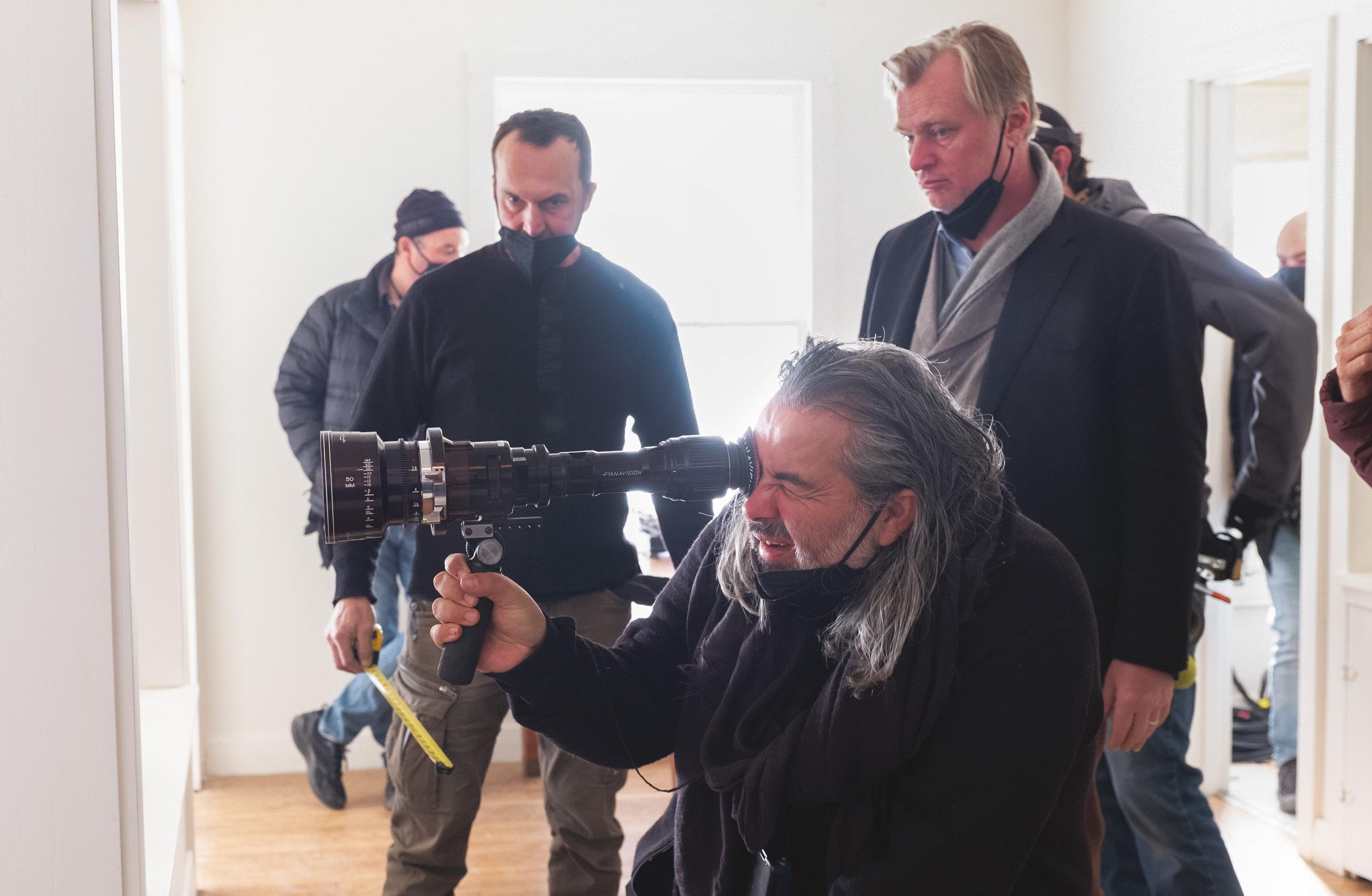



“Shooting on celluloid is way easier than most people think. To me it is intuitive like jamming on a guitar, instantaneously creating a link between the senses and the heart.”



© Universal City Studios LLC. All Rights Reserved. ©Kodak, 2024. KODAK and the KODAK logo are trademarks of Kodak. CONGRATULATIONS TO BEST CINEMATOGRAPHY OSCAR AWARD WINNER HOYTE VAN HOYTEMA NSC FSF ASC FOR OPPENHEIMER. STAND OUT. SHOOT FILM.
Rascals Publishing & Media Ltd
Red Lion Yard, Odd Down, Bath United Kingdom BA2 2PP
Tel: +44 (0) 1428 746 375
Editor-in-Chief RON PRINCE ronny@cinematography.world
Special Consultant ALAN LOWNE alan@cinematography.world
Editorial Assistant KIRSTY HAZLEWOOD kirsty@cinematography.world
Advertising Manager CLAIRE SAUNDERS claire@cinematography.world
Social Media YASEMINE KAZIM yasmine@cinematography.world
Subscriptions CDT ASSOCIATES LTD CWSubsciptions@cdtassociates.co.uk
Web Manager IAIN HAZLEWOOD iain@cinematography.world
Art Direction & Creative Kinda Stuff JAM CREATIVE STUDIOS adam@jamcreativestudios.com tim@jamcreativestudios.com
CONTACT US
News hello@cinematography.world
Ad sales & Subscriptions +44 (0) 1428 746 377
Artwork artwork@cinematography.world +44 (0) 1428 746 375 www.cinematography.world
EDITORIAL TEAM
Ron Prince has over three decades of experience in the film, TV, CGI and VFX industries, and has written about cinematography for 20 years. In 2014, he won the ARRI John Alcott Award from the BSC. He also runs the international content marketing and PR communications company Prince PR. “Count” Iain Blair is a British writer/musician who lives in LA and writes extensively about film/entertainment for outlets including LA Times, Variety and Reuters. He interviews movie stars, as well as Hollywood’s top filmmakers.
Darek Kuźma is a film and TV journalist, translator/interpreter, and a regular collaborator/programmer of the EnergaCamerimage Film Festival. He is an ardent cinephile who has a lifelong romance with the visual language of cinema.
David Wood is a freelance journalist covering film/TV technology and production He was a former technology editor at Televisual, and is a regular contributor to Worldscreen, TVB Europe and Broadcast.
John Keedwell GBCT/UAV Pilot is a documentary and commercials cameraman who has worked on productions worldwide. He has great knowledge of film, tape/file-based formats and lighting, and their uses in production.
Kirsty Hazlewood has over two decades of editorial experience in print/ online publications, and is a regular contributor to folk/roots music website Spiral Earth.
Natasha Block Hicks is an artist/designer/maker, who spent a decade as a freelance film and TV camera assistant, and indulges her love for cinema and cinematography through research and writing.
Tiffany Pritchard has worked in the film industry for over 15 years in LA and London. She creates digital content for StudioCanal in France and the UK, and writes for publications covering film festivals, industry news and interviews. Cover
To all the aspiring filmmakers out-there… please try shooting with that incredible, new, hip-thing called ‘celluloid’. It’s much easier than you think, and it makes things look so much better.
DP Hoyte Van Hoytema NSC FSF ASC, during his Oscar acceptance speech for Oppenheimer
HOBSON’S CHOICE?
Could there be a bigger advertisement, or bolder statement, about shooting on analogue film, than the one that appears above this editorial column?
Just over a dozen years ago, most of us expected film to simply curl-up and die, when Kodak filed for Chapter 11. But far from it, the age-old medium has not just survived the digital deluge, but bounced back in style – thanks to pacts with the studios, its continual championing by leading directors and DPs, investments in photochemical film labs around the world, plus advances in workflows and digital post processes that have helped keep it economically-viable as well as looking good on cinema and home screens alike.
All of this, plus film’s support by other stalwart fans, the uptake by the newly-curious, together with the steadfast dedication of Kodak to keep manufacturing, have all miraculously conspired to maintain film as a versatile visual storytelling medium, for pretty much every genre you can imagine.
Alive and kicking, analogue’s remarkable renaissance saw many films shot-on-film in contention for highprofile awards in 2024. So, hats off to Hoyte on your Oscar, BAFTA and ASC successes, and bravo to you and everyone else for keeping film in the mind’s-eye as a perfectly feasible and important artistic choice.



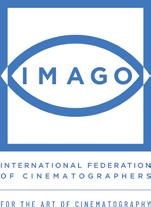




Image: Bob Marley: One Love, shot by DP Robert Elswit ASC. Image copyright © 2023 Paramount Pictures. All Rights Reserved. CINEMATOGRAPHY WORLD MARCH/APRIL 2024 3
Editor
Get your free digital subscription by scanning here NOW! ISSUE 020•CINEMATOGRAPHY WORLD
You can subscribe to the print, digital, or print and digital, versions of Cinematography World. This will cover you for the six issues delivered over a 12-month period. Your email will also be added to our monthly newsletter update, unless you decide to opt out of these news feeds. Cinematography World is part of Rascals Publishing & Media Ltd. The publishers emphasise that opinions expressed within Cinematography World Magazine are not representative of Rascals Publishing & Media Ltd, but are the responsibility of individual contributors. Cinematography World is created using responsibly sourced paper. All inks used during the printing process are vegetable based and virtually free from volatile organic compounds. Waste, paper, ink and consumables are recycled. Where this is not possible waste is sent to specialist centres for safe disposal. Cinematography World is created using responsibly sourced materials RECYCLE
Ron Prince
in Chief
SUBSCRIBE
Ron Prince photo by Joe Short
www.joeshort.com
Official
Media Partners
True Cinema. For All.

ZEISS Nano Prime Lenses
ZEISS Nano Primes are cinema lenses designed for modern full frame mirrorless cameras. The six focal lengths all feature a high speed of T1.5 in a small and robust real cine lens housing. Nano Primes are lenses for all cinematographers, budgets and projects. Lenses that check all the boxes when it comes to look, ergonomics, size and weight or lens data workflow. Lenses that you can afford. Lenses that won‘t let you down. Go-to cinema lenses for every day.
zeiss.com/cine/nanoprime

6
16 LETTER FROM AMERICA•RICHARD CRUDO ASC
18 WHO, WHAT, WHEN & WHERE
26
28
30
32
36
40
42
44
46
58
62

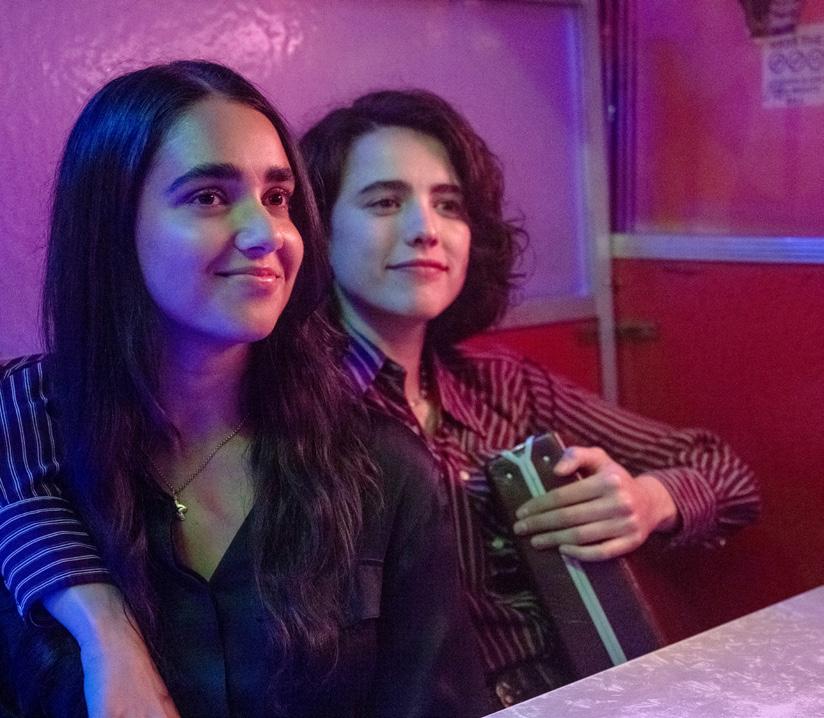
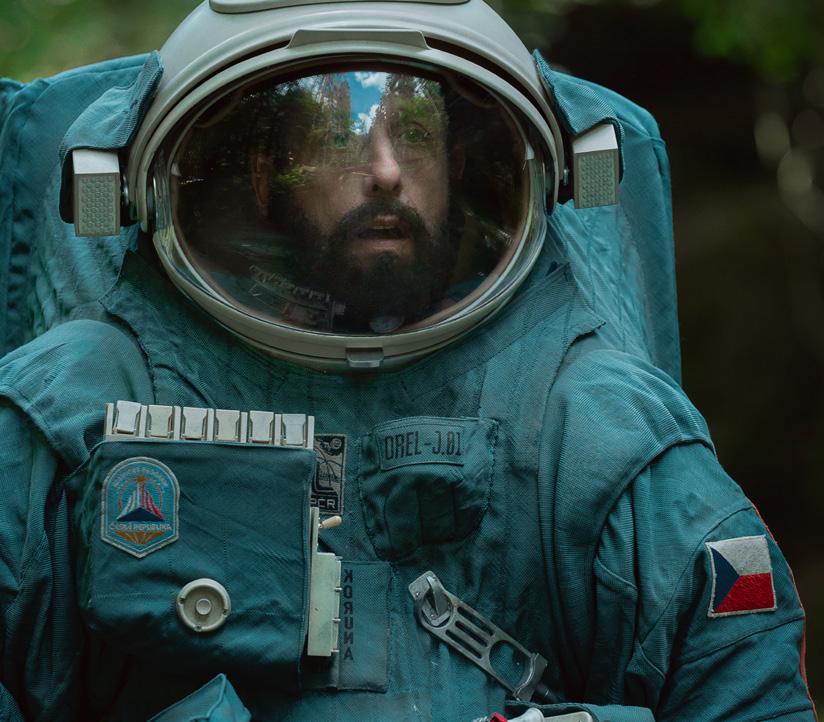

58 DUNE: PART TWO
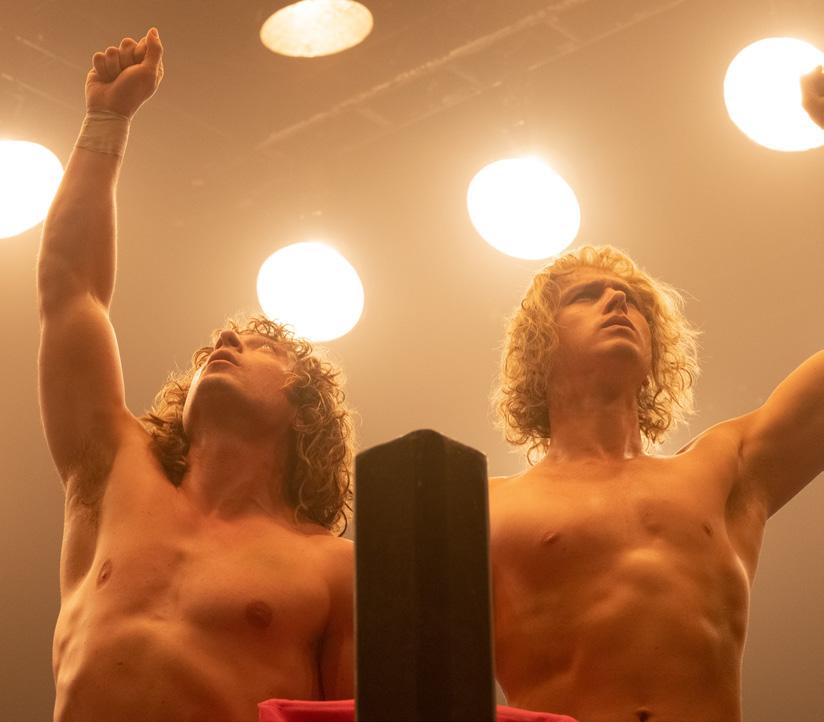
CINEMATOGRAPHY WORLD MARCH/APRIL 2024 5 ISSUE 020•CINEMATOGRAPHY WORLD
44 SPACEMAN
36 DRIVE-AWAY DOLLS
ISSUE 020 MARCH/APRIL 2024
32 THE NEW BOY
INSIDE
PRODUCTION NEWS
SMOOTH OPERATOR•NATASHA MULLAN
LETTER FROM AUSTRALIA•ERIKA ADDIS ACS
STUDENT
•NEO
SCHOOL KERALA
UNION
FILM
WARWICK THORNTON ACS•THE NEW BOY
ARI WEGNER ACS ASC•DRIVE-AWAY DOLLS
SAM LEVY•SHE CAME TO ME
HÉLÈNE LOUVART AFC•LA CHIMERA
JAKOB IHRE FSF•SPACEMAN
EXPO 2024
GREAT GEAR GUIDE•BSC
: ROUND-UP
GREIG FRASER ACS ASC•DUNE: PART TWO
ROBERT ELSWIT ASC•BOB MARLEY: ONE LOVE 66 JOSÉE DESHAIES•LA BÊTE 68 MÁTYÁS ERDÉLY HCA•THE IRON CLAW 72 PAOLO CARNERA CCS•IO CAPITANO
MARCELL RÉV HCA ASC•FINGERNAILS
GAFFER’S CAFÉ•ELENA ARMELLINI – ASSOCIATE ICLS 78 SHOOTING GALLERY•2024 BSC SHOW EXTRAS
THE IRON CLAW
74
76
68
DP HOYTE VAN HOYTEMA NSC FSF ASC WINS OSCAR,
ASC & BAFTA AWARDS FOR OPPENHEIMER
DP Hoyte van Hoytema NSC FSF ASC won the 2024 Best Cinematography Oscar for his work on Christopher Nolan’s Oppenheimer. The win came on the back of BAFTA and ASC Awards for the Dutch DP.
Van Hoytema captured Nolan’s nail-biting, biographical thriller in IMAX (15-perf) format using Kodak 65mm large-format film, including, for the very first time, sections on 65mm B&W, also shot in IMAX. Oppenheimer picked-up seven awards at both the Oscars and BAFTAs, including best film, best director for Christopher Nolan and best male performance for Cillian Murphy. The DP has been nominated for an Oscar once before for Nolan’s Dunkirk (2017)
Hoytema said, “To all the aspiring filmmakers outthere… please try shooting with that incredible, new, hip-thing called ‘celluloid’. It’s much easier than you think, and it makes things look so much better.”
Clutching his Oscar statuette, he also added, “Thank you to the Academy, a big thank you to my whole crew led by Keith Davis (1st AC), Adam Chambers (gaffer) and Kyle Carden (key grip). Thank you Chris Nolan and Emma Thomas, you’re by far the best thing that could have happened to my career, this wouldn’t have existed without you.”
He also paid tribute to his family, “For keeping me sane and anchored through this whacky circus called filmmaking.”
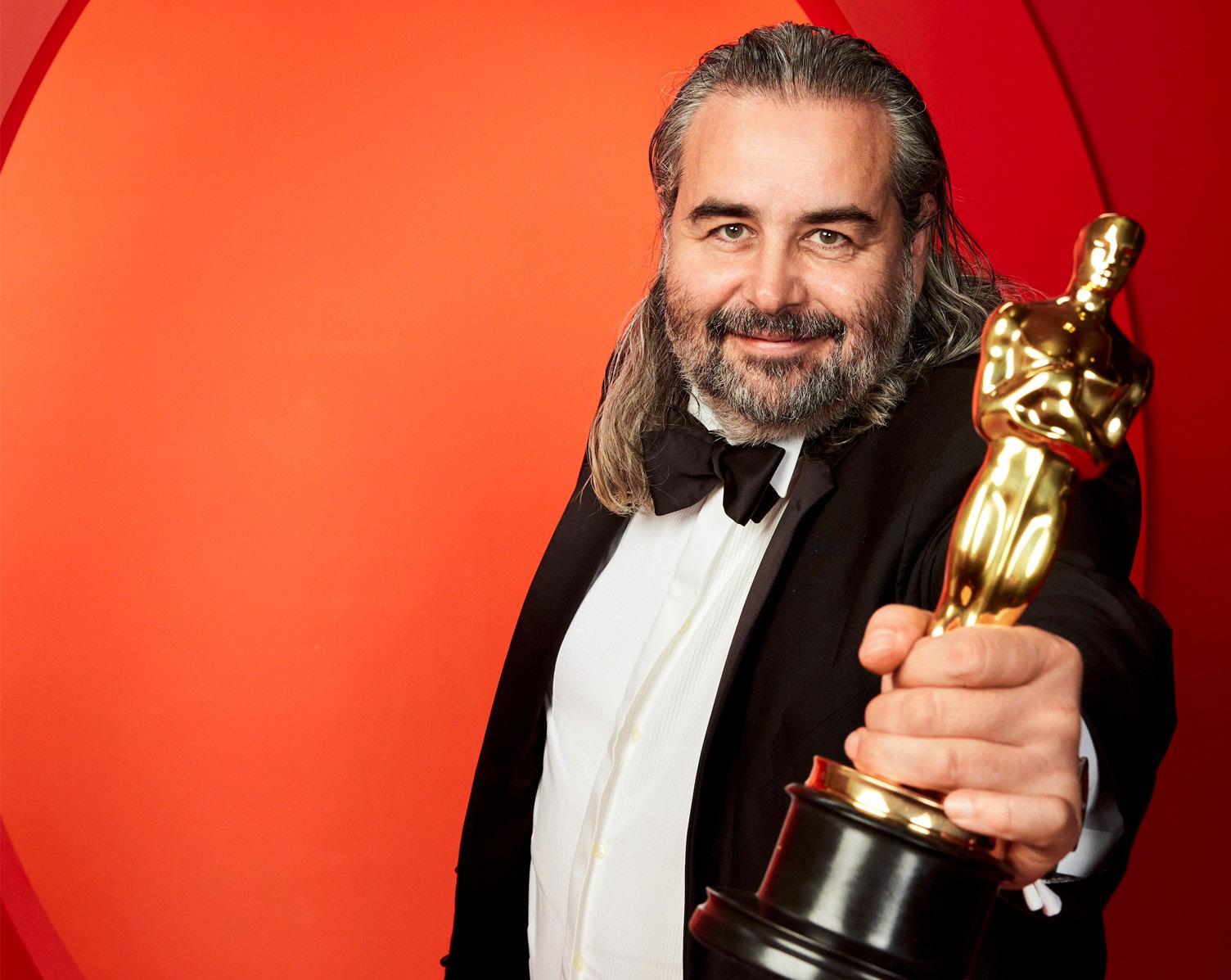
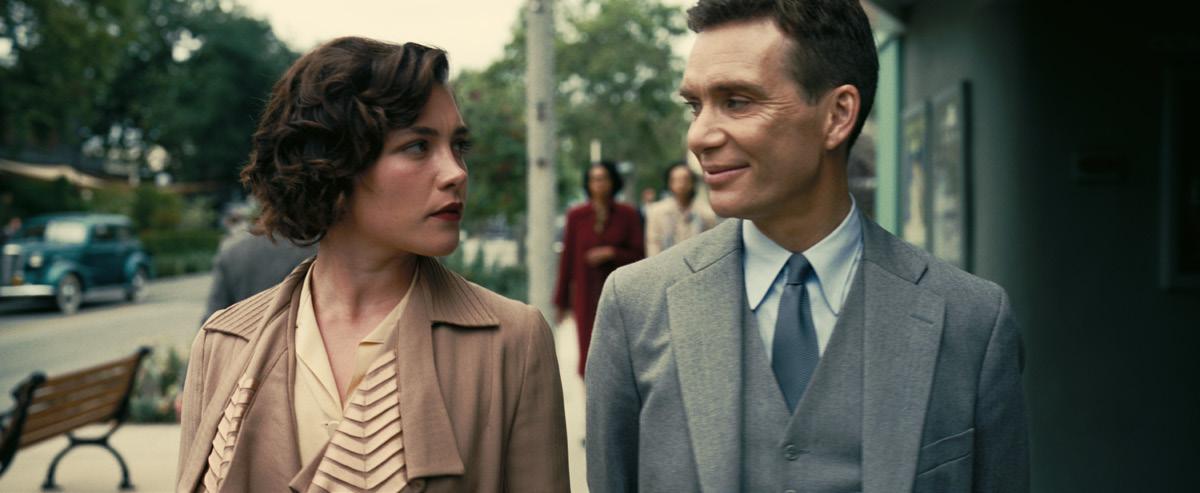
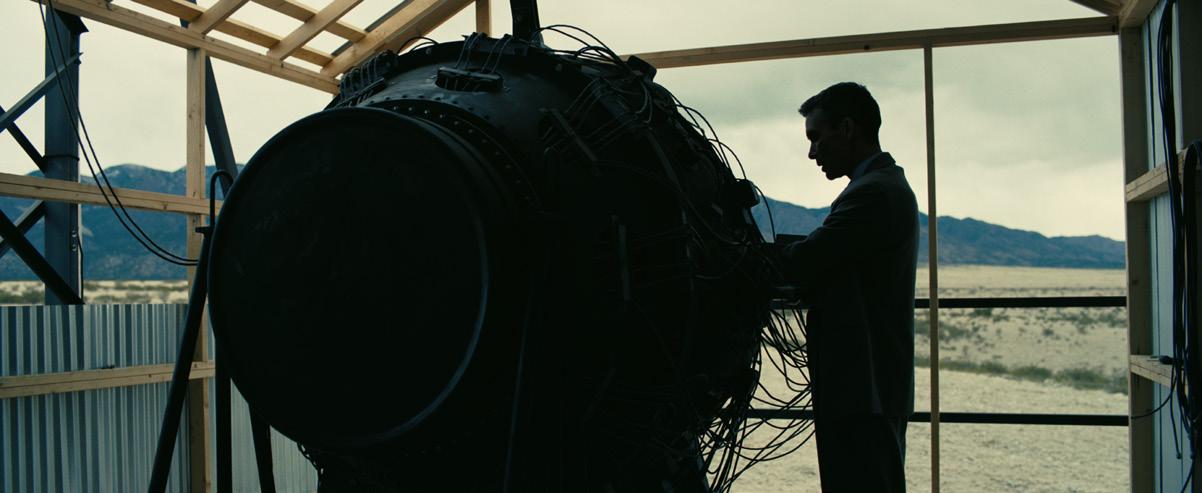
DP ED LACHMAN ASC TO RECEIVE 2024 CAMERIMAGE LIFETIME AWARD
Ed Lachman ASC, the previous recipient of a Golden Frog, plus two Silvers and a Bronze, has been awarded the prestigious 2024 EnergaCAMERIMAGE Lifetime Achievement Award, and will visit the festival, held in Toruń, Poland, in November to accept this honour. His visit will also feature a retrospective of his films and a series of audience meetings.
Lachman’s extensive filmography includes numerous collaborations with directors such as Todd Haynes (Far From Heaven, I’m Not There, Carol and Wonderstruck), Ulrich Seidl (Import/Export and The Paradise Trilogy: Faith, Love, Hope), Steven Soderbergh (The Limey and Erin Brockovich), Gregory
Nava (Selena, Why Do Fools Fall In Love, My Family) and Paul Schrader (Light Sleeper, Touch). He served as the cinematographer on Sofia Coppola’s debut feature, The Virgin Suicides and lensed such films as True Stories (dir. David Byrne), Less Than Zero (dir. Marek Kanievska), Backtrack (dir. Dennis Hopper), Mississippi Masala (dir. Mira Nair), S1m0ne (dir. Andrew Niccol), Prairie Home Companion (Robert Altman’s last film), as well as Desperately Seeking Susan and Making Mr. Right directed by Susan Seidelman, just to name a few.
In addition to his distinguished career as a cinematographer, Lachman has also ventured into directing, making his debut in the feature film realm with Ken Park (2002), a collaborative

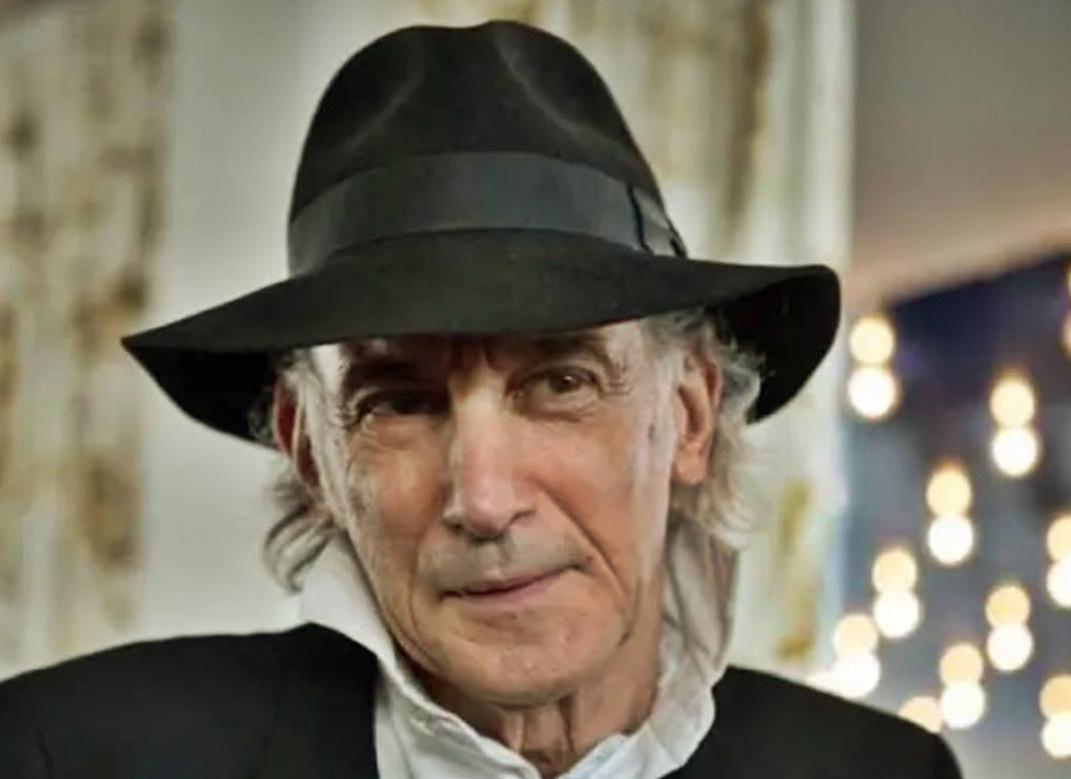
effort with Larry Clark.
Lachman’s approach to visual storytelling is evident in every production he has worked on during his career spanning over five decades, making him an exceptional visual artist. Along with his Camerimage awards, he has received three Academy Award nominations for Far From Heaven, Carol and El Conde, and was the winner of the ASC’s Lifetime Achievement Award in 2017, amongst many other recognitions.

PRODUCTION & POST NEWS 6 MARCH/APRIL 2024 CINEMATOGRAPHY WORLD
El Conde Carol

DP ROBBIE RYAN ISC BSC SCOOPS BSC AWARD FOR POOR THINGS
Robbie Ryan BSC ISC won the 2024 BSC Award for Best Cinematography In A Feature Film for his photography of director Yogos Lanthimos’s Poor Things. Described as “one of the most visually-imaginative and energetic Hollywood comedies in years”, Ryan shot Poor Things using Kodak 35mm B&W, colour negative and Ektachrome Reversal filmstocks, processed at Andec, with 4K film scanning of all the different filmstocks and film print deliverables completed by Cinelab.
Ryan was Oscar-nominated for his 35mm film work on Lanthimos’ bawdy Queen Anne drama, The Favourite, and earned Oscar, BAFTA and ASC nominations for Poor Things. He won the 2024 BSC Award in the face of stiff competition from Rodrigo Prieto AMC ASC for Killers Of The Flower Moon, Matthew Libatique ASC for Maestro, Hoyte van Hoytema NSC FSF ASC for Oppenheimer, and Linus Sandgren FSF ASC for Saltburn, all of whom shot their features on Kodak film too.
On accepting the BSC award, Ryan said, “I want to pay tribute to Yorgos, he is an incredible artist and I learn something from him with each film. I also want to thank Cinelab for their amazing work. All five of the nominees this year
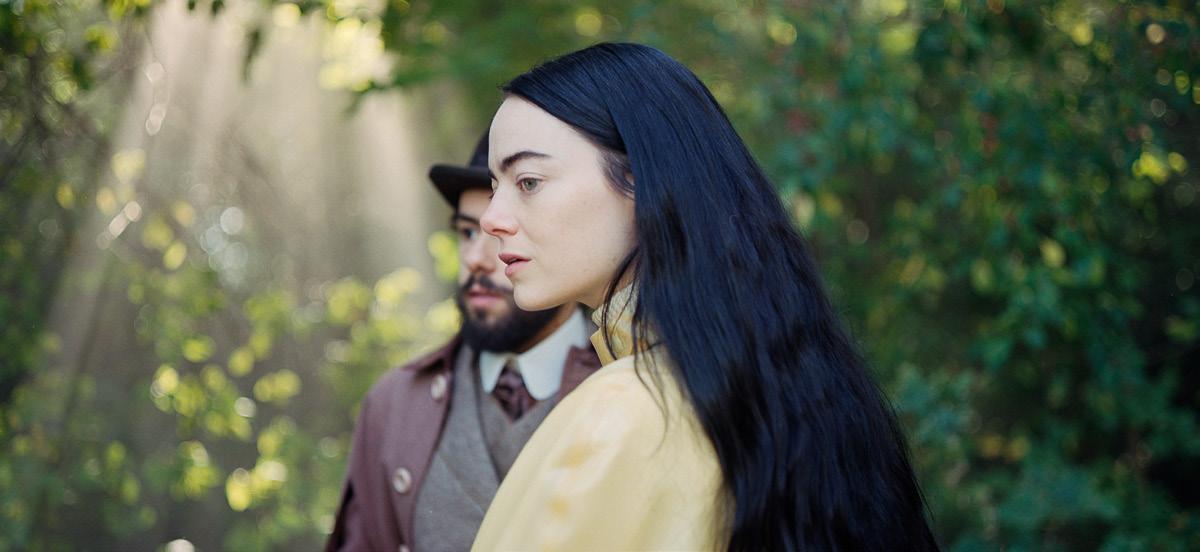
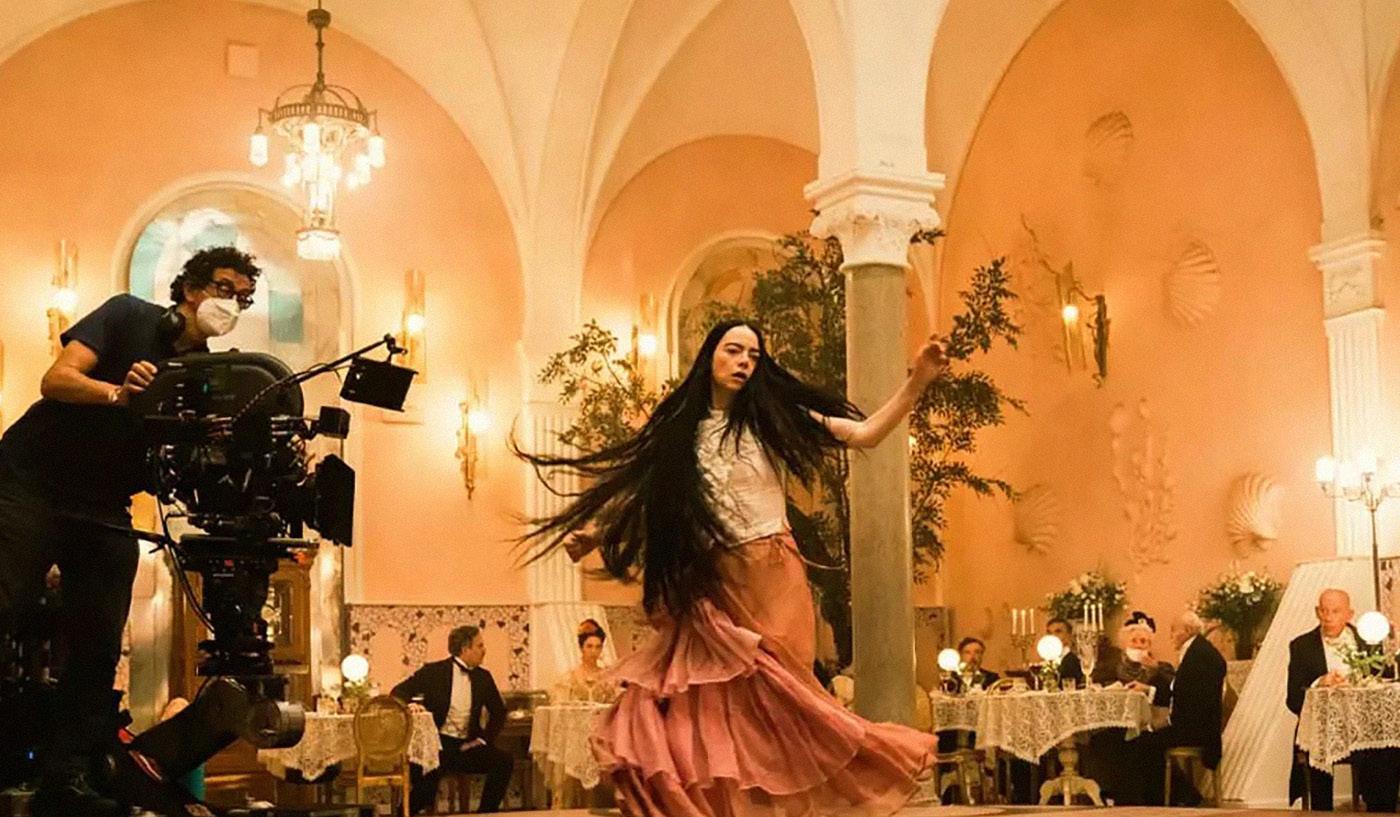
were shot on film, something we should all be celebrating.”
The Operators Award, presented by the BSC, ACO and GBCT, named Ossie McLean ACO SOC the winner for his operating on Saltburn, and in the Television category James Layton ACO and Justin Hawkins were victorious for their work on the Apple TV+ show Silo (Episode 1).
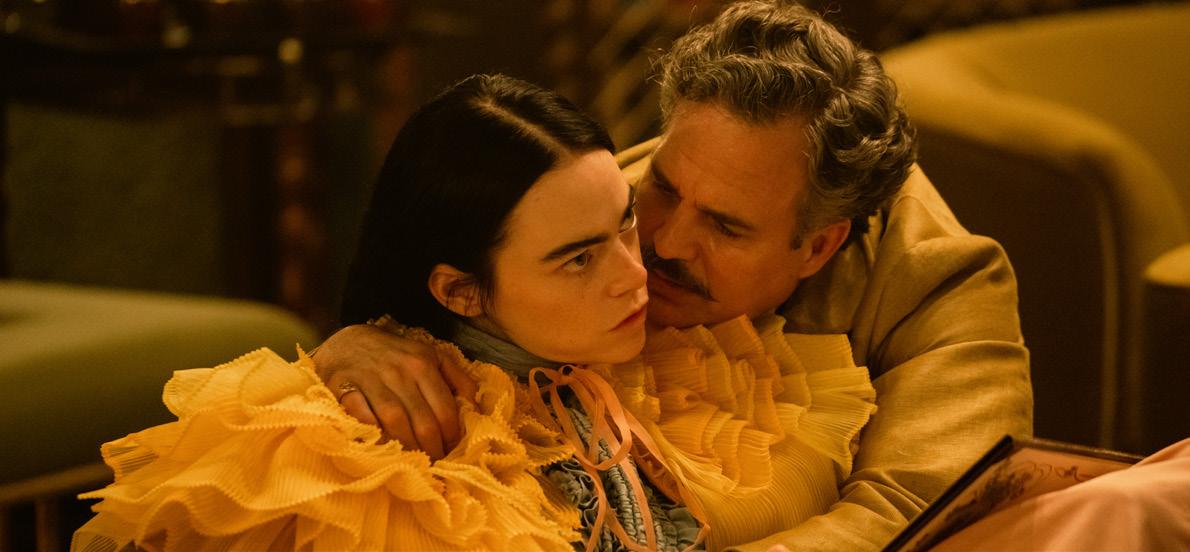
DP EIGIL BRYLD EARNS INDEPENDENT SPIRIT AWARD FOR THE HOLDOVERS
DP Eigil Bryld was awarded Best Cinematography at the 2024 Film Independent Spirit Awards for director Alexander Payne’s The Holdovers, the story of a curmudgeonly instructor at a New England prep school who is forced to babysit the handful of students on campus during Christmas break.
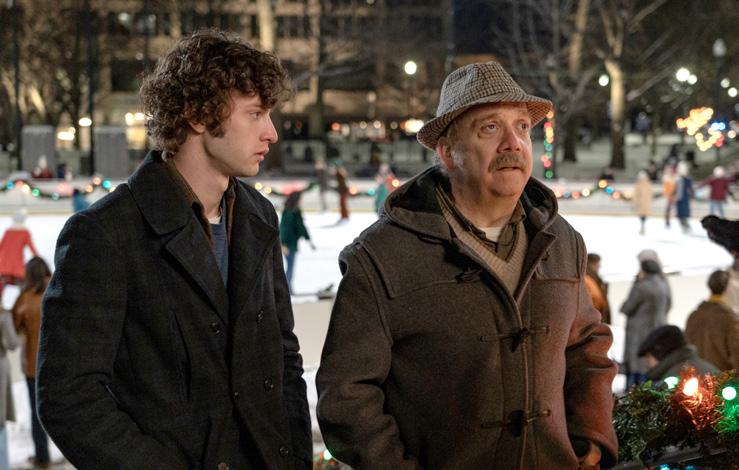
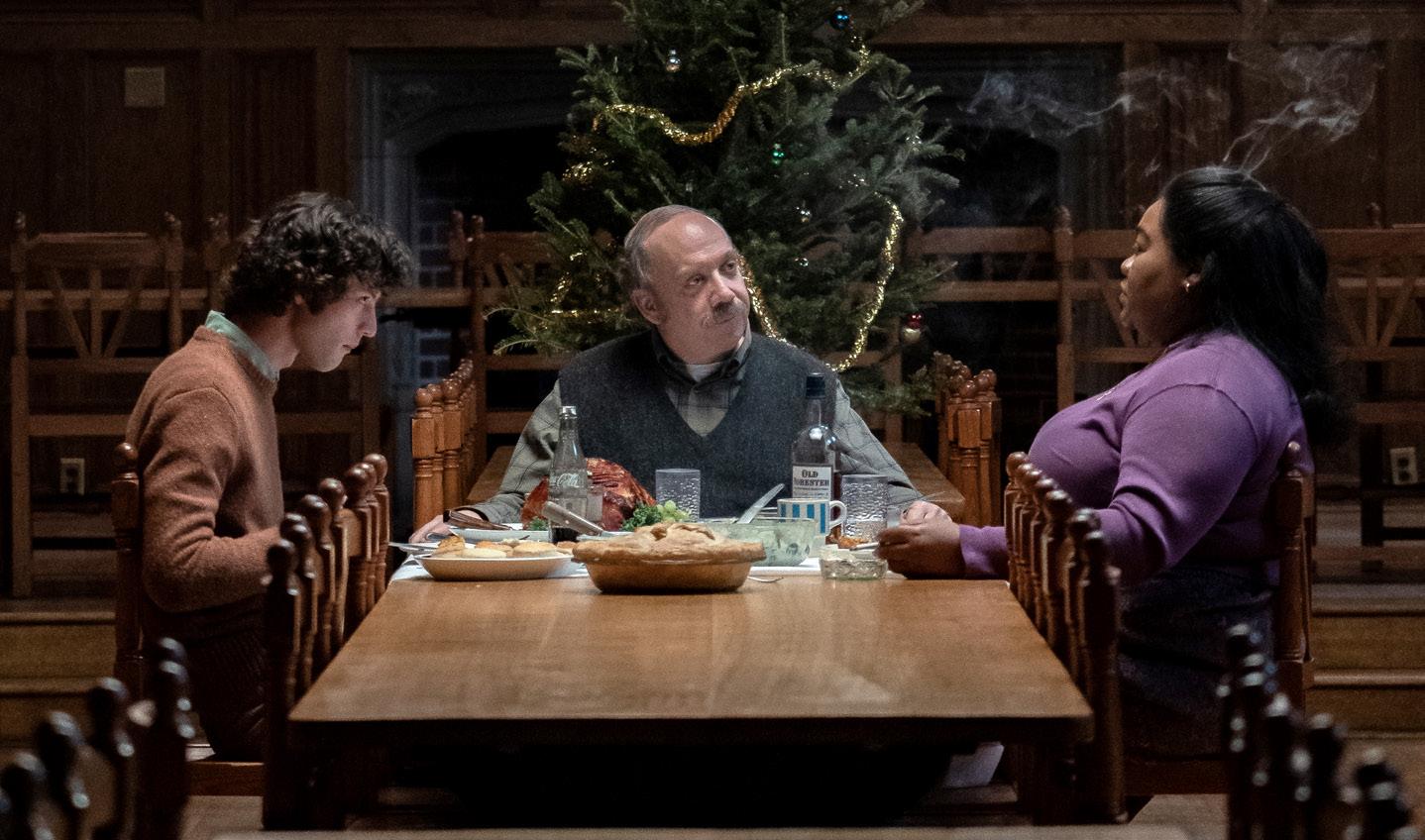

PRODUCTION & POST NEWS 8 MARCH/APRIL 2024 CINEMATOGRAPHY WORLD


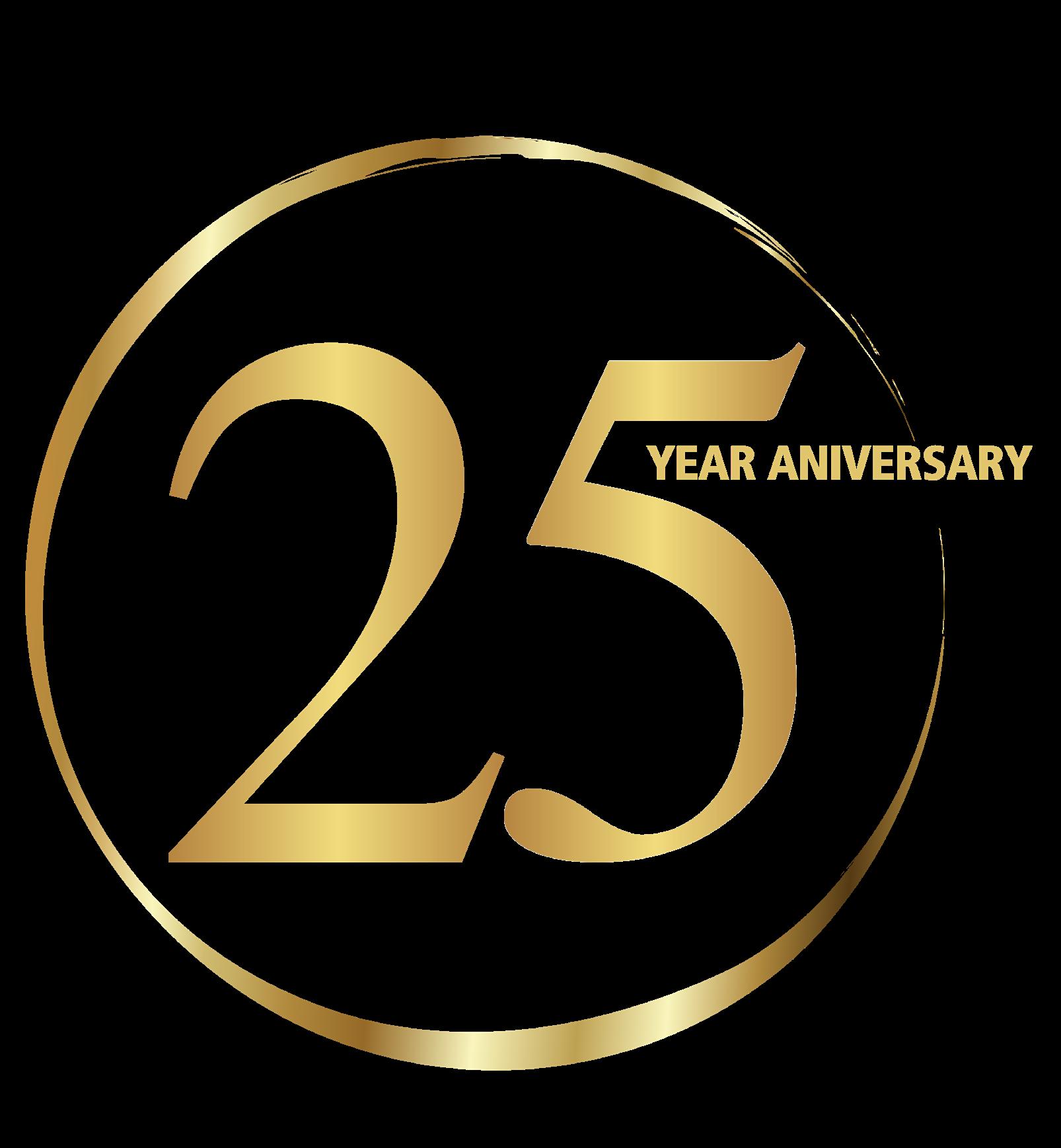

Supplying the film and broadcast industry with the latest innovations in lighting and accessories since 1999 LCA - Lights, Camera, Action Offices in London Paris Berlin LCA France +33 1 49 37 99 12 info@lcafr.com www.lcafr.com LCA UK +44 (0)20 8833 7600 sales@lcauk.com wwwa.lcauk.com LCA Europe +49 (0)30 726 10623 sales@lcaeurope.com www.lcaeurope.com
CINELAB FILM & DIGITAL APPOINTS STEVE MILNE AS VICE-CHAIRMAN
Cinelab Film & Digital has appointed Steve Milne as vice-chairman. An industry heavy-weight with a career spanning over two decades in the post-production industry, Milne brings invaluable expertise and a track record of success to his new role at the company.
He joins Cinelab after two tenures at Molinare, where he served as CEO between 2003 to 2010, prior to returning from 2012 to 2018 as chairman, and played a pivotal role in reshaping the facility delivering top-tier post production services. Milne will work with Cinelab founder and CEO Adrian Bull on corporate strategy and customer relations.
Milne also established the British Film Company, where he has produced over 40 British indie productions including Moon, Journey’s End, Dad’s Army and Absolutely Fabulous: The Movie, plus the feature documentaries Spitfire and Lancaster
Cinelab Film & Digital supported several of the productions nominated during the 2024 awards season. The company did film scanning and film deliverables for Yorgos Lanthimos’ Poor Things , lensed by Robbie Ryan ISC BSC on 35mm film, and the processing/scanning on the UK-based shoots of Bradley Cooper’s Maestro, shot by Matthew Libatique ASC LPS on 35mm film. It also completed the processing/scanning on Wes Anderson’s The Wonderful Story Of Henry Sugar, shot by Robert Yeoman ASC on 16mm film.
Cinelab also recently provided a digital dailies lab service, including dailies colour by colourist Darren Rae, on Wicked Little Letters, lensed by Ben Davis BSC, plus digital dailies lab services on Disney+ series Renegade Nell for DP Oli Russell, and the Amy Winehouse feature Back To Black, shot by DP Polly Morgan BSC
ASC. The Danish TV series Prisoner, shot by DP Adam Wallensten, employed Cinelab’s DFD (DigitalFilm-Digital) process, where digitallycaptured footage was transferred on to Kodak 16mm 250D filmstock and then scanned back to digital for a filmic look.


KOERNER CAMERA HOSTS 2024 LENS SUMMIT
Koerner Camera, a leading provider of high-end cinema camera equipment in the Pacific Northwest, will host the 2024 Pacific Northwest Lens Summit, on May 3rd & 4th, at its Portland, Oregon facility.
Around 40 exhibitors from all over the world will gather on-site to show the very latest in cinema optic technology and accessories. In addition to hands-on experiences, classes and seminars will be held by leading lens manufacturers, master lens technicians and some of the finest minds in cinema optics.

Exhibitors include: Ancient Optics, Angènieux, ARRI, Altas, Cooke, Duclos, Fujinon, Hawk, Laowa, Leitz, Preston Cinema Systems, Schneider, Tiffen, Tribe7, Zeiss and ZeroOptik. For the full list and to register, visit www.lenssummit.com
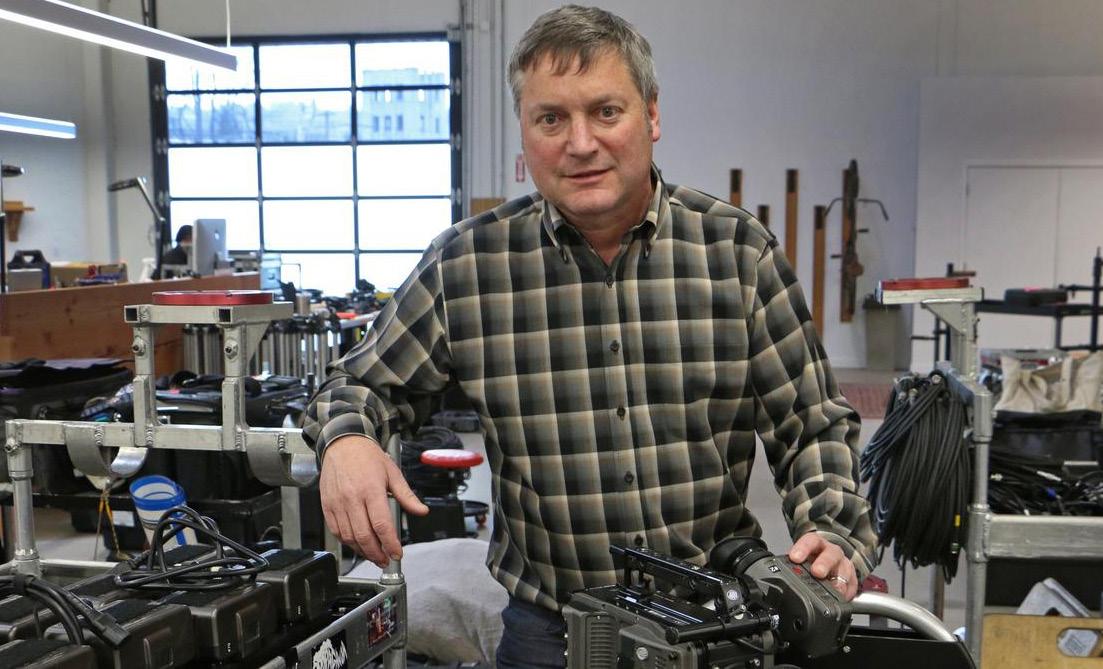
EXCITEMENT MOUNTS FOR EURO CINE EXPO 2024
As the date for the third annual Euro Cine Expo draws closer, the organisers have released a sneak peek of what is on offer at this year’s symposium, which will run alongside the must-attend event for the film and TV production industry.
Taking place at the Motorworld and Zenith Complex, Munich, on 27-29 June, with Cinematography World as the official media partner, Euro Cine Expo will deliver a global exhibitor list showing the latest technologies, products and services, plus a two-day Symposium of technical presentations, seminars and industry panel discussions across three theatres in the Dampfdom at Motorworld.
The first details of the IMAGO Technical Committee (ITC) programme have just been released, covering a wide range of topics hosted by internationally-renowned specialists including ITC co-chairs Philippe Ros

Topics to be discussed will embrace: the creative and the technical aspects of aspect ratio choices; innovative lighting technologies and image-based-lighting (IBL); artificial intelligence; the current status of HDR deployment; plus a range of discussions around virtual production in LED volumes.
Euro Cine Expo is free to attend. Whether you’re an industry veteran or a newcomer, Euro Cine Expo 2024 offers invaluable learning and networking opportunities, the chance to experience the products, and meet the people, at the forefront of film and broadcast technology. For more information and to register visit www.eurocineexpo.com.
PRODUCTION & POST NEWS 10 MARCH/APRIL 2024 CINEMATOGRAPHY WORLD
Adrian Bull and Steve Milne. Photo by Connan Mcstay.
AFC, David Stump ASC MITC and Aleksej Berkovic, gaffers Ville Pentilla ICLS and Uwe Greiner ICLS, workflow/post consultant Miga Bär, and colourist Dirk Meier, amongst many others.
Wicked Little Letters
Company boss Michael Koerner
OUTSTANDING OPTICAL PERFORMANCE
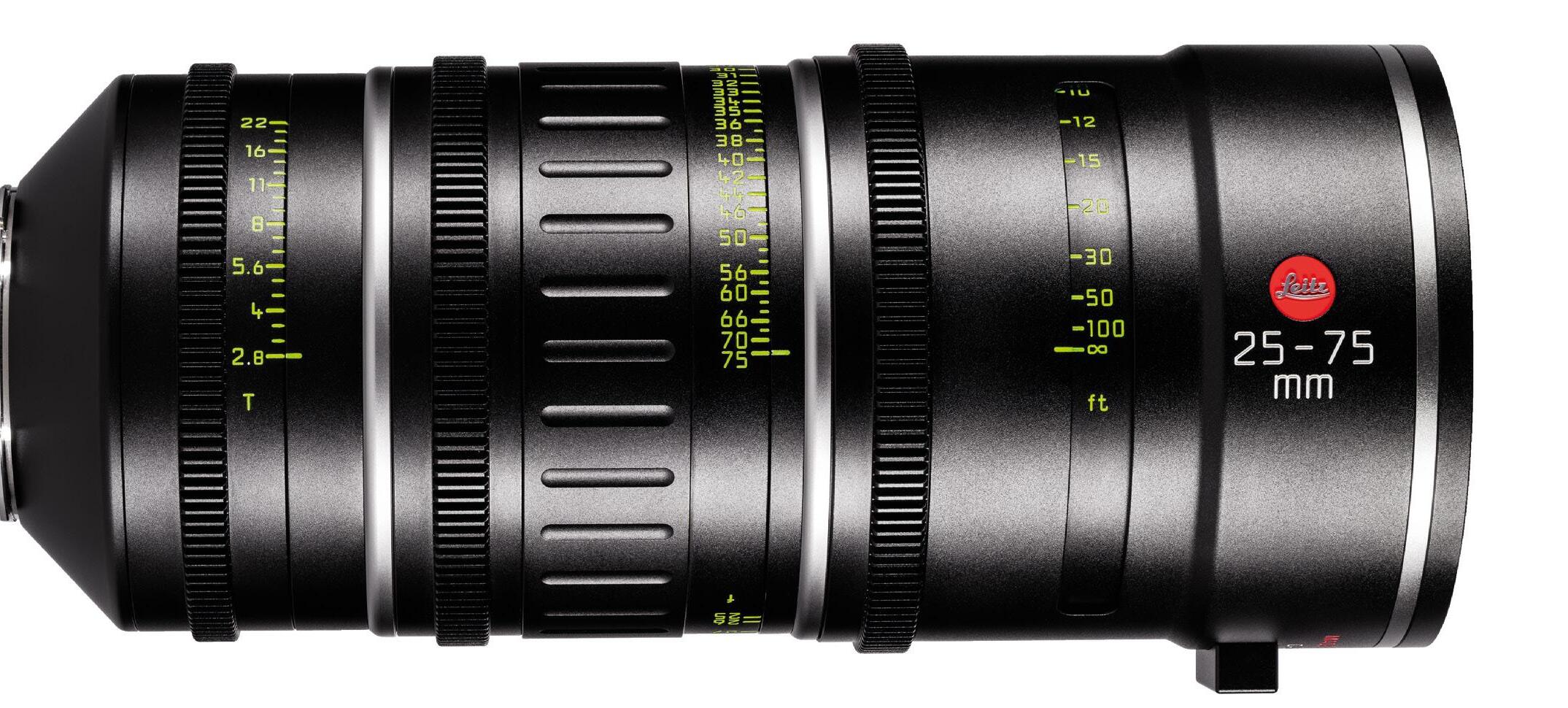
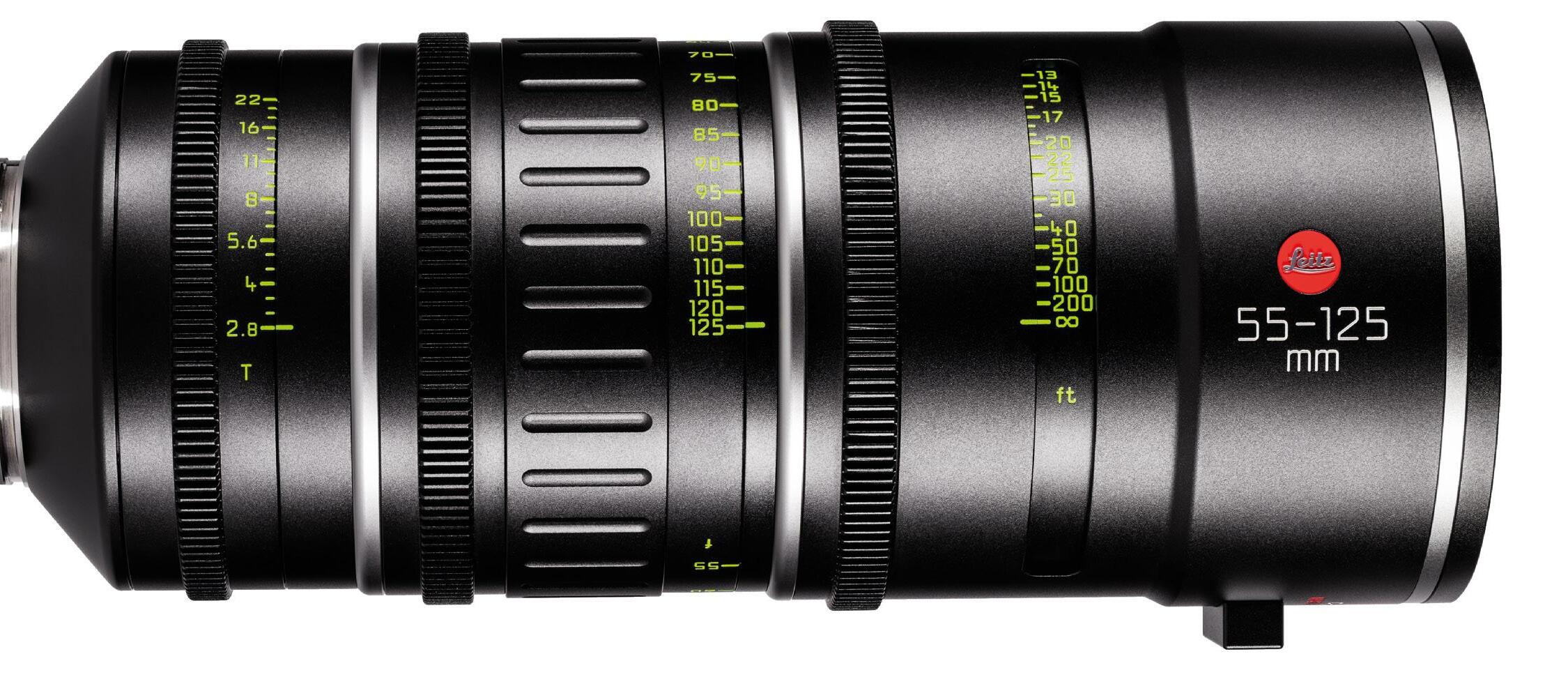
LEITZ ZOOM
WWW.LEITZ-CINE.COM
SHEPPERTON STUDIOS PROVIDES £100,000 FOR UK FILM & TV TRAINING
Shepperton Studios will provide £20,000 per annum for five years to fund short courses for specific training in skills relating to the film and TV industry. The courses will be exclusively accessible by those local to the studios living in the Borough of Spelthorne. The short courses are to be delivered by the National Film & Television School (NFTS), as part of the Metro London BFI Skills Cluster Training partnership, which currently delivers a programme of free ‘taster days’ to address key skills shortage disciplines and ‘set-ready’ boot camps which are designed to lead directly into employment.
Daniel Mouawad, chief executive of Spelthorne Council, commented, “This targeted initiative is a clear demonstration from Shepperton Studios and NFTS to financially support and inspire residents of Spelthorne to find out more about the film and TV industry.”
Andrew M Smith OBE DL, director of Shepperton Studios, added, “With the landmark
expansion at Shepperton Studios, the second largest film studio in the world, we are delighted to collaborate with the NFTS to make these short courses accessible for local residents. Inspiring and nurturing local talent is key to the continued success of our worldleading UK film industry.”

Starting in the summer of 2024, the short courses will meet the needs of Shepperton, covering runners, production coordinators, location managers, art
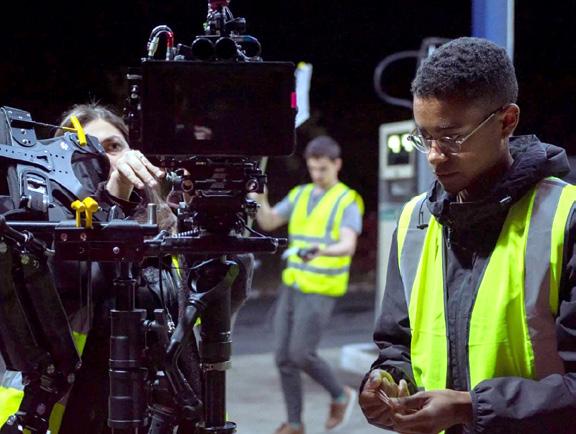
department personnel and DITs, with the taster days providing an overview of the different pathways into the industry.
DEDOLIGHT EFLECT RANGE EXPANDS WITH LARGE-SIZES IN TROPICAL BLUE AND ORANGE
Dedolight Eflect, described as the ultimate background generator, has been expanded with the introduction of new surface patterns in tropical blue and tropical orange.
All surfaces available for Dedolight Eflect can be purchased in sizes up to 80x80cm, which

allow, even with minimal power, the spread of large effect patterns around a large studio, from ceiling to floor. These are made up of different sized mirrors including silver, gold and a zebra-pattern, and now include new surfaces in tropical blue and tropical orange.
Eflect is part of the Dedolight Lightstream system, which is enhanced and supported by Dedolight parallel beam intensifiers, available for 50 focussing Dedolights that can be used in combination with a range of reflectors specific to the Dedolight Lightstream range. To view a movie of
what Dedolight Eflect and Dedolight Lightstream are capable of, visit https://tinyurl.com/t6jnwt5k
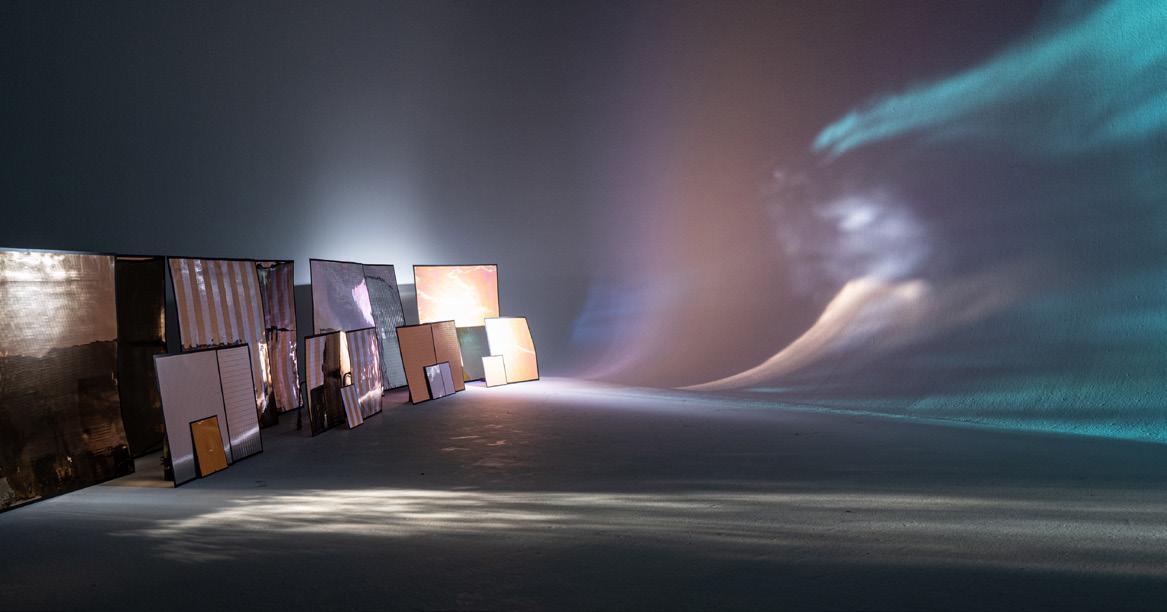
CREAMSOURCE SHOWS LATEST SOFT LEDS AT NAB 2024
Creamsource, is showing its latest innovations, the Vortex Soft series and Vortex24 LEDs, at NAB in Las Vegas, booth C551.
The Vortex8 Soft (V8S) and Vortex4 Soft (V4S) are companions to the company’s Vortex8 and Vortex4 hard panels, engineered with the same RRGBBW colour engine, robust construction and intuitive interface. Designed for efficiency and performance, the new panels deliver full-spectrum soft light with a wide 110° beam angle.

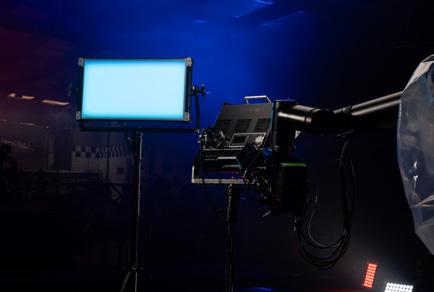
For situations where size is a crucial factor, the company has also launched the Vortex24. This offers a 1950W output with 24-pixel zones, advanced creative controls and a focussed 20° beam angle for crafting intricate lighting effects. Its larger form factor simplifies rigging and minimises the necessity for multiple units, particularly when rigging to an elevated work platform, such as a condor, whilst delivering the precision and power essential for complex imagebased lighting set-ups.

PRODUCTION & POST NEWS 12 MARCH/APRIL 2024 CINEMATOGRAPHY WORLD
Introducing the next generation full frame digital cinema camera!
The new Blackmagic Cinema Camera 6K is an extremely high end digital film camera that produces precise skin tones and rich organic colors. It features a massive full frame 24 x 36mm 6K sensor with wide dynamic range and built in optical low pass filter for better detail handling. You also get a very flexible L-Mount for both new and vintage lenses!
Get the “Hollywood Look” with Digital Film!
Blackmagic Cinema Camera 6K has the professional features you need for high end feature films, television programming and documentaries. Now this same quality can be used for the production of cinematic content for social media platforms!
Imagine shooting with a large format digital film camera on independent films and TV commercials. Or even weddings, training films and corporate video!
Full Frame Flexibility
The large full frame sensor lets you work in a variety of film formats and aspect ratios without sacrificing quality! The full area of the sensor gives you a unique open gate 3:2 image which also lets you reframe your shots in post production. Or work in true 6:5 anamorphic without cropping, making widescreen cinematic images more detailed and in higher resolution than before!
Extremely Lightweight Portable Design
The elegant design packs an incredible number of high end digital film features into a miniaturized, handheld design. Made from lightweight carbon fiber polycarbonate composite, the camera has a multifunction handgrip with all controls for recording, ISO, WB and shutter angle right at your fingertips. Plus the large 5” LCD makes it possible to get perfect focus.
Record to CFexpress Cards or External Disks!
The camera features a built in CFexpress card recorder, and a USB-C expansion port for recording direct to SSDs. CFexpress media are more durable and faster than older media so are perfect for recording full resolution, 12-bit Blackmagic RAW files. The camera records both Blackmagic RAW and H.264 proxies at the same time, perfect for cloud and mobile work!
Blackmagic Cinema Camera 6K
Only £2,089
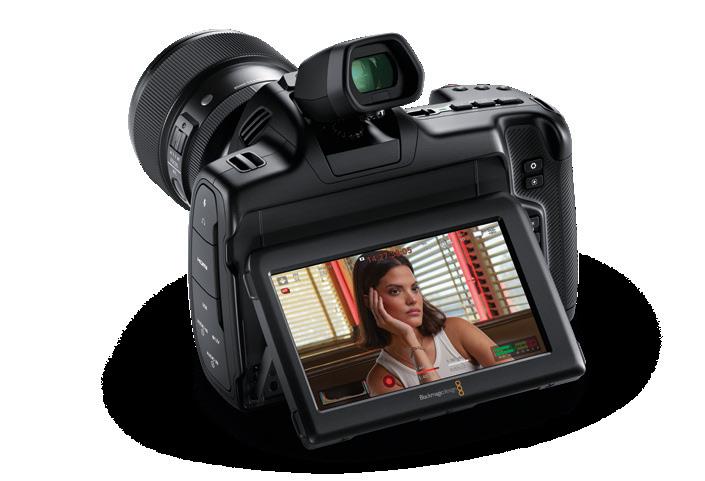
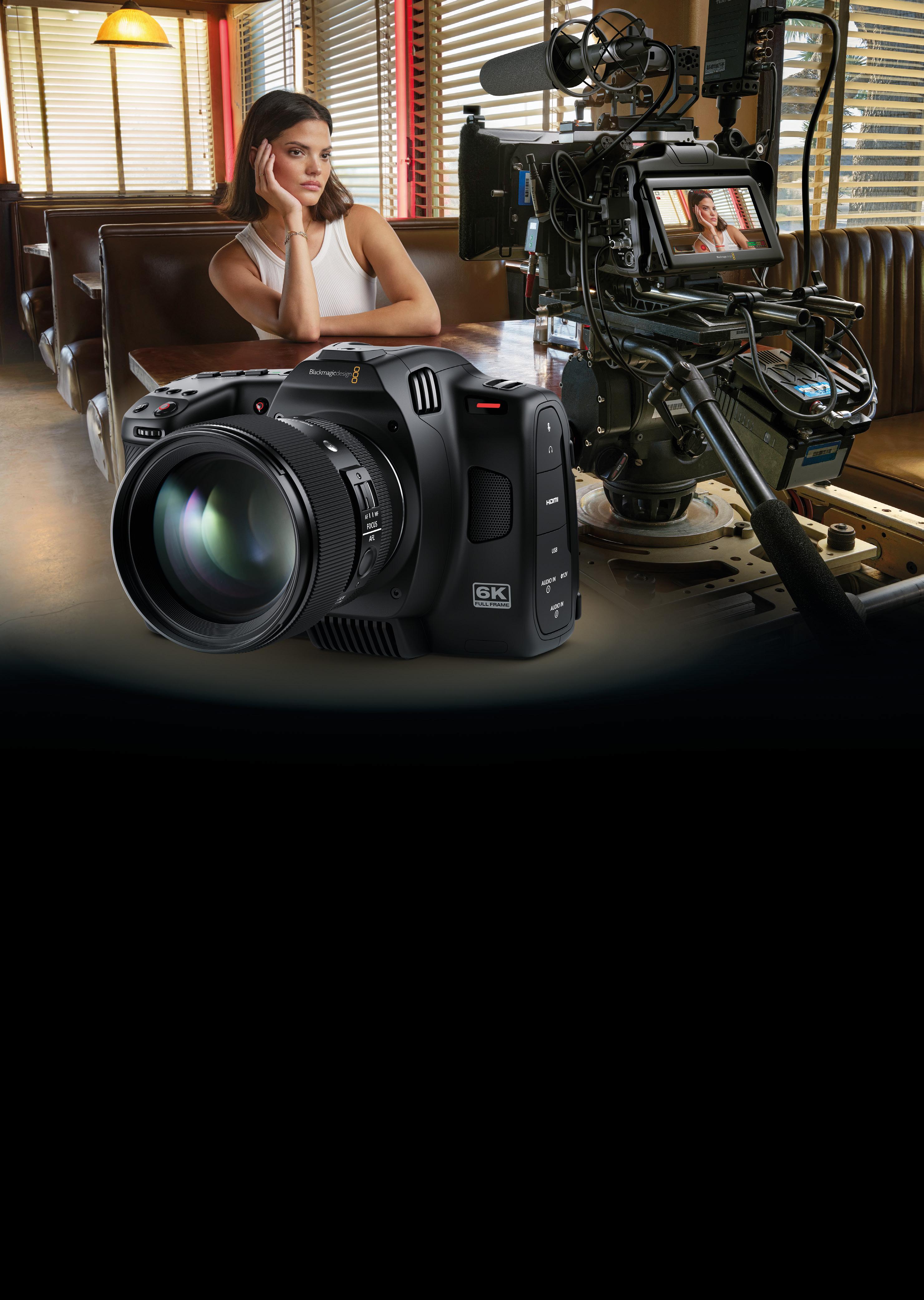
Learn more at www.blackmagicdesign.com/uk
Camera shown with optional accessories and lens. SRP is Exclusive of VAT.
ASTERA LAUNCHES PROJECTION LENS FOR PLUTOFRESNEL
Astera has launched the ProjectionLens for its batterypowered, LED-based PlutoFresnel light, allowing users to quickly convert it into a powerful profile spotlight.
The lightweight, portable PlutoFresnel – which operates on a completely wireless basis with built-in battery pack – can be transformed in less than a minute by slipping on the ProjectionLens, which then allows the light to become a profile spotlight with a range of 16° to 36°. Projection zoom can be controlled manually by twisting the lens barrel or two focus wheels. An E-size gobo holder also enables custom logo projection.
four-leaf shutter design to facilitate trimming of the beam as needed.
The ProjectionLens builds upon the substantial applications of the PlutoFresnel itself, which harnesses the benefits of LED technology to deliver a lighting style that previously could only be achieved with Tungstens. It can achieve the specific aesthetic of a Fresnel, but with lower power draw, higher output strength, precise colour control, lightweight profile, and wireless installation. In its Fresnel set-up, it maintains a beam angle of 15° to 60°, with an equivalent output of 300W using 80W.
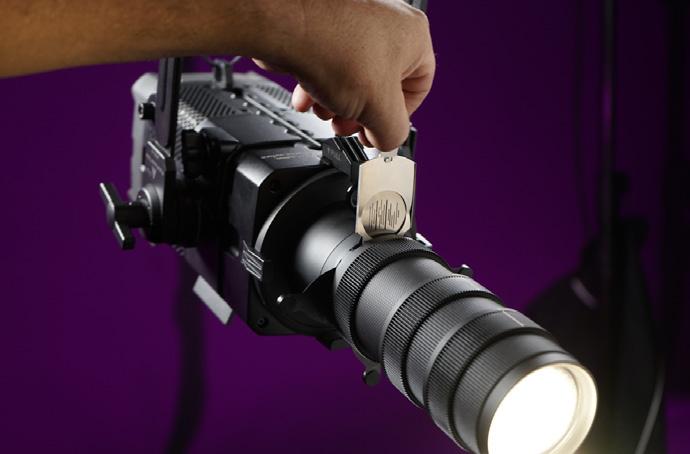
The profile lens allows for close control of the light over any distance, with crystal clear optics and a
All lights in the Astera range are founded upon the Titan LED engine, which powers the lights and ensures colour fidelity and lighting consistency, across
a 1,750 to 20,000 Kelvin range and with full spectrum RGB+Mint+Amber colour.
Astera’s sales and marketing director Sebastian Bückle said, “The new ProjectionLens combined with PlutoFresnel, provides gaffers and event technicians with a two-in-one solution in their kit bag, facilitating two different but highly-specific lighting types at once; Fresnel and projection.”

ARRI INTRODUCES ORBITER BEAM OPTIC FOR LONG-THROW APPLICATIONS
ARRI has launched the Orbiter Beam, which further expands the accessory range for the LED spot light. This is the first beam optic in ARRI’s LED lighting portfolio. A new optical concept was developed especially for this reflector.
The Orbiter Beam’s intensity level has a comparable output to the ARRI Daylight M-Series M18 within a tighter beam angle. For the first time, these high intensity values can be achieved with a high-quality full-colour spectrum LED source making the Orbiter Beam the brightest full-colour LED spot light on the market. This parallel beam light is suited for cinematic applications, either for long-throw distances or indirectly bounced.
The new Orbiter Beam optic provides a defined and strong 4° parallel light beam with homogenous light, helpful in creating an authentic illusion of distant natural lights, such as simulating the natural light of the sun or moon.
The Orbiter Beam features a large aperture in a compact (approx. 573 mm x 548 mm x 548 mm / 22.6 in x 21.6 in x 21.6 in) and lightweight (5,9 kg / 13 lbs.) housing. The reflector’s diameter of 530 mm (20.9 in) is similar in size to ARRI’s M90 luminaire. The two elements of the optic, the reflector and snoot, can be easily separated and stacked for storage and transport. The Orbiter Beam comprises a unique manual hot-spot adjustment allowing variation from hard to soft edge light, and is a great addition to the existing Orbiter Open Face optics 15°, 30°, and 60°. No
additional accessories for the Orbiter Beam optic such as barndoors or snoots are required as the light beam produced is already nicely focused.

QUASAR SCIENCE STEPS-UP WITH OSSIUM LADDER
Quasar Science has announced the release of the Ossium Ladder, a flexible tube light rigging solution. Shown for the first time at the 2024 BSC Expo, the Ossium Ladder, designed in collaboration with G-Force Grips, brings volume lighting to creators working in any space.
“The Ossium Ladder revolutionises rigging solutions for small to mid-sized studios,” said Michael Herbert, Quasar Science’s head of product management. “Its slim profile and flexible design empowers creators to easily rig an array of tube lights whilst optimising space usage to the fullest.”

The Ossium Ladder is designed
to hang from any overhead fixing point. It allows rapid rigging of up to sixteen 2’, 4’, or 8’ Rainbow tube lights into an adjustable volume, via the built-in Nato rail. Users can control up to 768 addressable pixels with connected Rainbow fixtures, achieving powerful creative lighting set-ups even in small spaces. This allows virtual production set-ups to build a dynamic wall of light to complement LED volumes for immersive image-based lighting without additional LED wall investment.
The Ossium Ladder is constructed for highquality materials to ensuring durability on-set. With a maximum weight capacity of 330lbs, it provides stability and safety for lighting set-ups. Optional T12 clamps are available to allow other tube lights, such as Crossfade X to be connected.
PRODUCTION & POST NEWS 14 MARCH/APRIL 2024 CINEMATOGRAPHY WORLD
J.T. ROONEY CHOOSES KINO FLO’S MIMIK 120 FOR VIRTUAL PRODUCTION
Kino Flo Lighting Systems has shared that its Mimik 120 full-spectrum, image-based video lighting tile has been chosen by creative producer J.T. Rooney, a well-known pioneer in immersive technology for entertainment.
Working in conjunction with wild walls — LED side panels used to create effects such as reflections — Rooney and his creative team utilise multiple Mimiks to light talent and foreground subjects with full-spectrum colour.
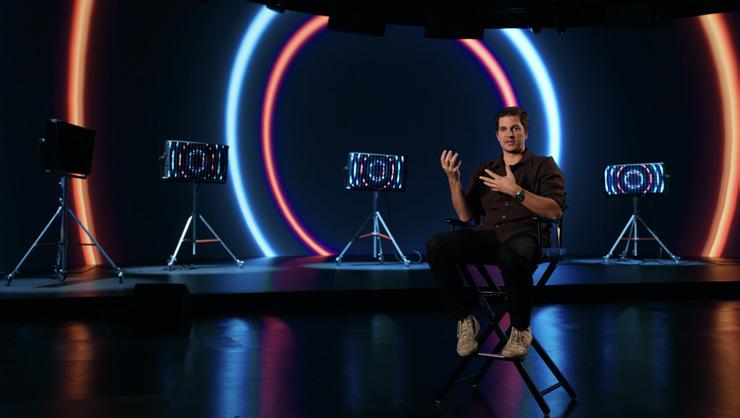
Optimised for virtual production environments, the Mimik 120 mirrors video content, delivering extended spectral bandwidth and cinematic colour fidelity when lighting talent and set elements. The patented Kino Flo matchmaker algorithm converts the incoming RGB video wall signal into four or more individual emitters generating synchronised foreground lighting that delivers the utmost realism on virtual sets.
Controlled by the Megapixel VR Helios LED processor, the Mimik 120 integrates with LED volumes in a Megapixel infrastructure, making it straightforward for gaffers, DPs and lighting directors to use. In addition, the tile offers optional control from a lighting desk, for workflow flexibility. With their lightweight carbon fibre frame, Mimik 120s can be used in several configurations — individually, stacked like a video wall, flown as a ceiling, or put on traditional lighting rigs. With their high brightness
of 10,000 nits, the tiles are also an efficient solution, especially when stacked together — allowing Rooney to do more with fewer units.
“Virtual production stages worldwide are known for embracing the very latest in immersive technology for entertainment,” said Frieder Hochheim, president of Kino Flo. “So, it’s an honour to have our Mimik 120 being utilised by technology professionals like Rooney — who are on the leading edge of virtual production — to create unique and colour-accurate images. This close collaboration is exactly what inspires Kino Flo to continuously innovate.”
Rooney commented, “Mimiks play a key role in helping to deliver the best possible end-product for some of the biggest brands in the world. Since I began using them, there hasn’t been a project where I haven’t utilised them. My clients and crew have been blown away by the realism they deliver, and their ease-of-use, whilst talent reports that they improve their experience when filming takes.”
PIXIPIXEL REVEALS NEW LOAD-CARRYING HYBRID GENERATOR
Pixipixel, the camera and lighting rental house with locations in London and Manchester, recently unveiled a new 160kW, 18-ton load carrying hybrid generator, designed to provide sustainable power on-location at a time when productions are striving to reduce their carbon footprint by transitioning away from traditional diesel generators, which account for around half of production emissions.
The hybridised generator has single-phase power outlets powered by a battery bank located within the load-carrying area, which are supplemented by an HVO-fuelled generator.

This dual-power system allows for flexible usage depending on the needs of the production, with the ability to draw power from the battery alone or to seamlessly switch to the generator when additional power is required. Using the hybrid set means productions can draw power from the 45kWH onboard battery, the 160kW HVO-fuelled generator, or both, for maximum power output of 205kW.
The hybrid generator features an intelligent switching capability, automatically activating the generator to recharge the battery when it is running low. The battery can also be recharged on-set if mains power is available via a 32AMP single phase connector.
Steve Knight, managing director of Pixipixel, shared insights this initiative to kickstart the decarbonisation of Pixipixel’s fleet of generators.
“The idea stemmed from our observations on various TV drama sets where large battery banks were hired in an effort to reduce the production’s carbon footprint. We worked on a solution with Baari Ismail, our technical manager for generators, designed this efficient 3-in-1 solution integrating the battery bank, generator and load-carrying space
for the kit in a single, mobile, sustainable hybrid.
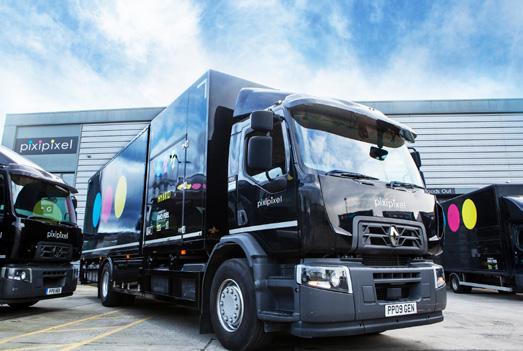
“Our hybrid generator works on a similar principle to hybrid cars, and we hope it will prove to be a sustainability success story for TV and film productions. So far, we’ve received overwhelmingly positive feedback from gaffers, DPs and sustainability coordinators.”
In other news, Pixipixel has appointed Colin Smart as business development manager for lighting. Smart joins Pixipixel’s Manchester division from Panalux Manchester, where he was general manager for over 15 years.
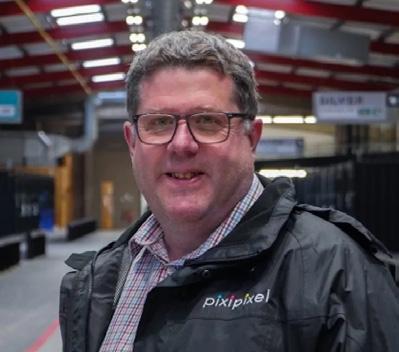
CINEMATOGRAPHY JOURNAL CALLS FOR TECHNICAL & ARTISTIC RESEARCH PAPERS
The Cinematography Journal is calling for submissions of original research papers and visual articles for publication in its upcoming Issue #3: Cinematography History And Archive.
The debate on the role of cinematography/cinematographers and their impact on visual storytelling can range from the perspective of film history, style, aesthetics, film language, colour and perception. Submissions related to innovative cinematographic techniques, case studies, and interdisciplinary approaches are particularly welcome.
Potential topics include, but are not limited to: current trends and important/ historic movements in cinematography; the evolution of technical aspects
of cinematography (e.g. aspect ratio) and their influence on style; and changes of the cinematographer’s role over time.


Other aspects encompass: developments in analogue and digital technologies, and new technologies and cinematographic techniques for storytelling; the transition from B&W to colour production; plus developments in colour correction, such as the switch from colour timing to colour grading.

The Cinematography Journal welcomes short articles (4,000 words), longer articles (8,000 words) and visual articles/video essays (video max.
7 min, accompanied by a short abstract and written references). Authors are invited to submit their papers by 14 July 2024 via www.cinematographyinprogress. com/index.php/cito
CINEMATOGRAPHY WORLD MARCH/APRIL 2024 15 PRODUCTION & POST NEWS
HISTORY LESSONS
While it’s important that we always look forward in life, the pace of modern society conspires to weaken memories of those who have gone before us. Earlier in my career, there existed a much stronger awareness of the previous generation’s contributions than there is today, and that’s not good for any of us. In the interest of countering this trend, and keeping their spirits alive, I offer my reminiscences of two giants whom the ASC lost during 2023.
Owen Roizman ASC was a close friend for nearly 25 years. When we first met, even though I was a bit late to have considered him a mentor, he nevertheless assumed that role with brilliance, humour and class. Geography creates strong ties, and as a fellow Brooklyn native I identified with his view of the world, his Yankee fandom and, not least of all, his accent. I also appreciated his wicked, New Yorker’s sense of humour.
Of course, beneath the armour was a gentle, sensitive temperament, but even in his advanced
Victor Kemper ASC may not have enjoyed the visibility of some of his more celebrated contemporaries, but he was in every way their equal
years you would’ve been mistaken to underestimate him. As immovable as he was in his convictions, they were never intended to offend, so long as you were in agreement. Right up to the end, it was funny how his sense of right and wrong could chafe with certain individuals, but that spoke more to their deficiencies than to his.
Few careers have been better documented, yet some elements bare highlighting. Owen Roizman


claims a special notoriety among that golden group of cinematographers who changed the way movies looked during the 1970s. Many of his innovations in style and technique have become so familiar, we now accept them as convention. Students the world over have benefitted from his generous sharing of knowledge. His leadership at the ASC and the Academy Of Motion Picture Arts & Sciences set the standard for how to conduct oneself at the head of the pack. We also have him to thank for his supervision of the 2009 ASC Clubhouse renovation. Having occupied a ringside seat for that long slog, believe me, it was no simple task. Finally, his love of his family was plain to see; for those of us who knew him, it extended our way as well.
I couldn’t have asked for a better cinematographer to be inspired by, nor could I have wished for a better advisor as my participation at the ASC increased. If I seem to have placed him up too high, I haven’t. As every individual can claim, he was one-of-a-kind, but the old saying reminds us: “When Owen came along, they broke the mould!” His departure was not tragic. But it certainly was sad.
Victor Kemper ASC may not have enjoyed the visibility of some of his more celebrated contemporaries over the course of his long career, but he was in every way their equal. After starting as an assistant cameraman on commercials at EUE Studios in New York City (alongside fellow future superstars Owen Roizman ASC and Gordon Willis ASC), he segued to features in 1970. Through more than 60 films, he established himself as part of that same golden group of geniuses we so admire today.
In keeping with his generally modest temperament, Victor Kemper never let his work call attention to itself. Instead, he found ways to tell his stories in the clearest, most economical manner possible. Witness one of my all-time favourite films, The Friends Of Eddie Coyle (1973, dir. Peter Yates), in which he redefined the term ‘minimalist.’ His images here are so stripped of artifice that they border on the ugly – and they are precisely the correct choice for the noirish narrative. Not many of us would have had the courage to hang it out there in quite the way he did, but Victor had no reservations. He was flattered by my assessment
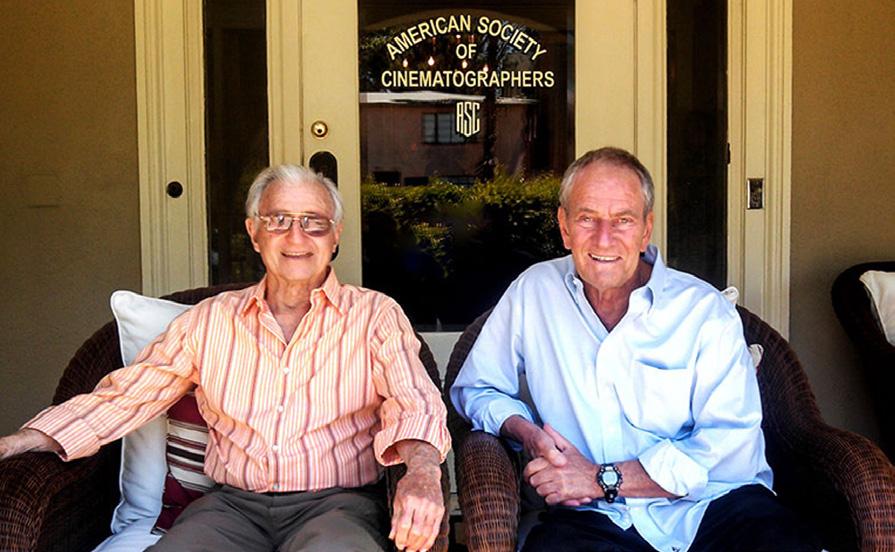
when we deconstructed the movie for an ASC podcast a few years back. I was flattered just to be in his company.
His demise was not only a sad moment, it also had significance for the greater filmmaking community. It represented the end of the line for a category of cinematographers for whom radical innovation was the norm. I knew most of them to one degree or another, and there may be a couple of outliers left, but it must be stated clearly: much of what we put forth in our work today is traceable to what Victor Kemper and his pals were doing in the 1970s.
On the most personal of notes, he was one of the sweetest guys you could meet. You haven’t really lived until you’ve spent a night or two enjoying his war stories and absorbing his counsel over a ration of Glenlivet in Billy’s Bar at the ASC
Owen Roizman ASC claims a special notoriety among cinematographers who changed the way movies looked during the 1970s
Clubhouse. Always with a smile, he was a great mentor to many, not least of which myself, especially during my early years with the organisation. I will always be grateful for his guidance. And now, along with the other legends I’ve been privileged to hang with there, I’ll always miss him, too.
Richard Crudo ASC Former ASC President
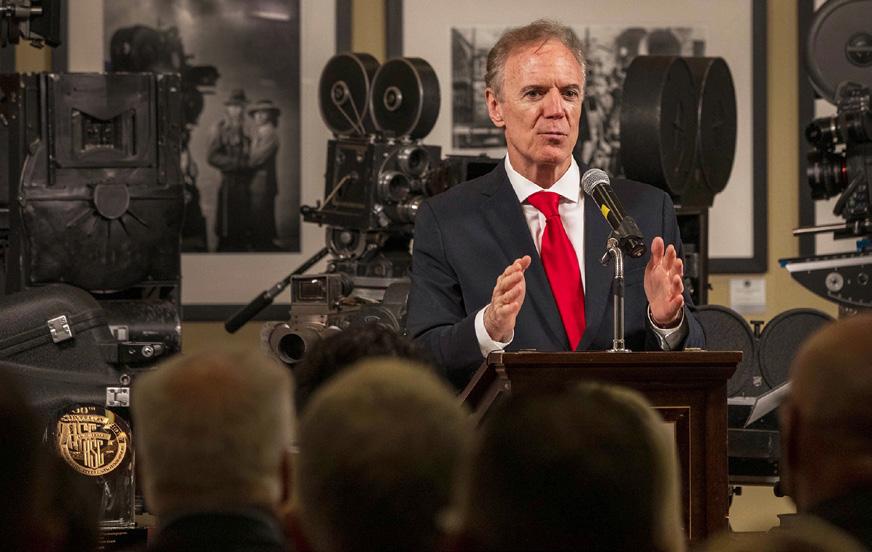
16 MARCH/APRIL 2024 CINEMATOGRAPHY WORLD
RICHARD CRUDO ASC•LETTER FROM AMERICA
The DSMC3 generation of cameras offer the most powerful and advanced cinema camera performance on the market. The V-RAPTOR and V-RAPTOR XL systems are both now available with either the “8K VV + 6k S35 Multi-Format” sensor or the all-new “8K S35” version.
CVP is Red’s only UK Premium Reseller, and is proud to be the only RED Certified Service Centre in the UK, offering first line local support, repairs and service for RED’s full range of cameras and accessories.



Available
RED V-RAPTOR
Now
Book
Get in touch +44 (0) 208 380 7400
a demo demo@cvp.com
LIGHTS… CAMERA… ACTION!

Our regular round up of who is shooting what and
Over in LA, Eli Mayer is an avid reader of Cinematography World and a budding DP. He takes film production classes at high school, and is a videographer for the school’s Varsity Men’s Basketball Team. He works at weekends to save money to buy film equipment and loves the production side. Eli currently shoots using a Canon R8 and Sigma 24-70 T2.8 zoom, with accessories from SmallRig, but says he will be switching to Sony soon. “I do all kinds of work with my gear –sports video, narrative filmmaking, documentary filmmaking, and hopefully much more in the future,” he says.
BERLIN ASSOCIATES:
Edward Ames and Nick Cox are shooting on Waterloo Road S12 for Wall to Wall/Warner Bros. TV/BBC. Will Baldy is lighting The Sandman S2, for Warner Bros./ Netflix. Claudio Cadman has graded BBC’s Phoenix Rise Frank
where
Madone shot the second block of The Wives for Gaumon/Channel 5 with director Claire Tailyour. Nick Martin shot the second block of Ludwig with Big Talk Productions for the BBC. Tom Pridham recently finished Jesus Crown Of Thorns for Nutopia, and shot the third block of Ellis for Company Pictures with Director Ryan Tohill. Pete Rowe lit a pilot for Expectation Entertainment called Brown Sugar Alistair Upcraft has been shooting on Whitstable Pearl S3 for Buccaneer.
WORLDWIDE PRODUCTION AGENCY:
Kaname Onoyama AFC was in Seoul for the new Amazon series Butterfly with director Kitao Sakurai. Pedro Cardillo ABC has been filming on BBC’s Strike S6 episode ‘The Ink Black Heart’, with director Sue Tully. Arthur Mulhern ISC was in Dublin and then New Zealand for The Gone S2 with director Dathaí Keane. Ed Moore BSC continues principal photography
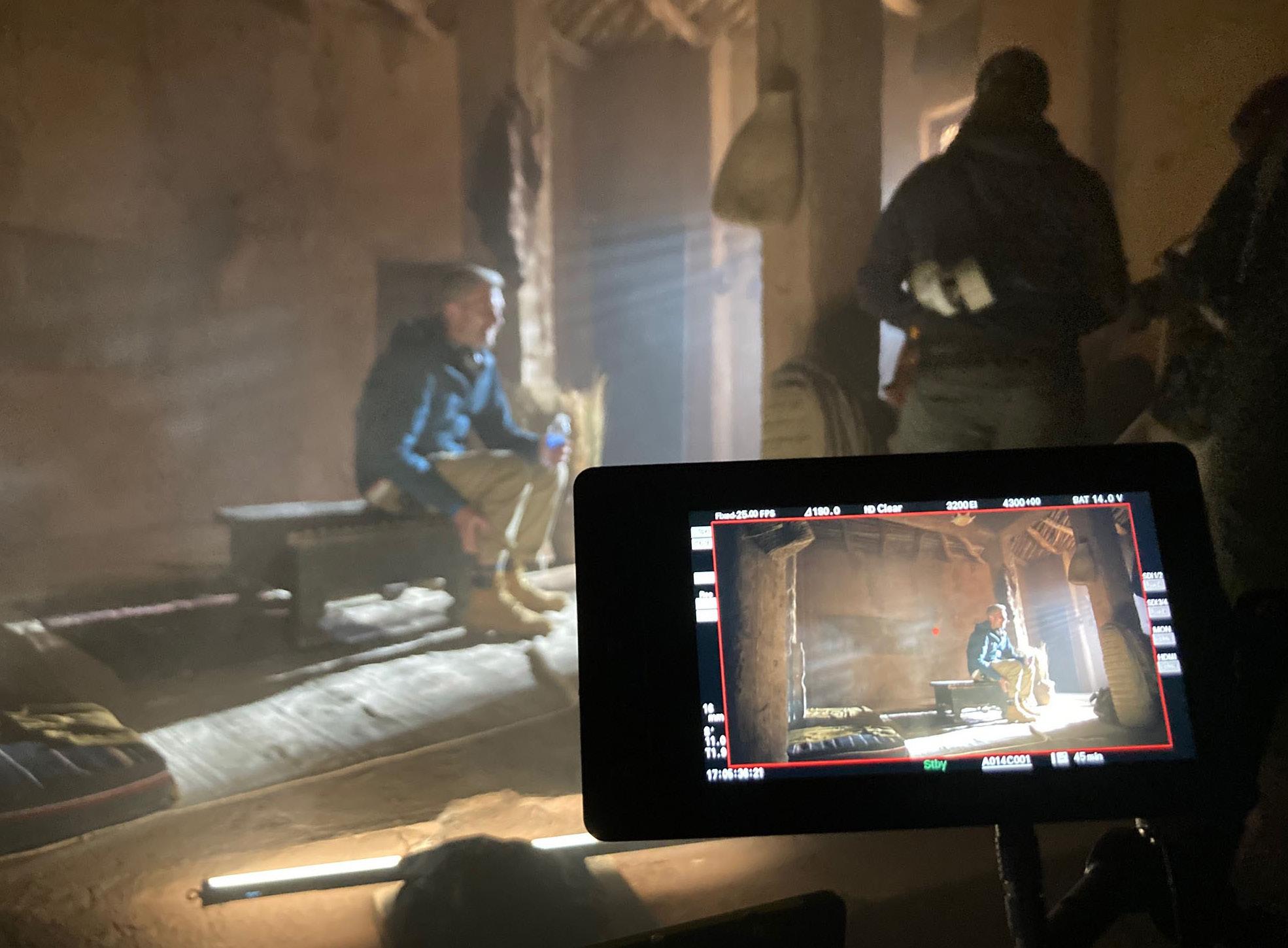
on the Amazon film My Fault with director duo Similar But Different for 42. PJ Dillon ISC ASC shot pick-ups on HBO’s House Of The Dragon S2. Baz Irvine ISC BSC is shooting on Silo S2 with director Michael Dinner for Apple TV+. Scott Winig is on Netflix’s The Witcher S4. Jamie Cairney BSC has graded his feature film Joy, directed by Ben Taylor, for Wildgaze Films/ Pathé UK, and did final colour on his episodes of Doctor Who with director Ben Chessell. Fabian Wagner BSC ASC continues shooting main unit on Venom 3, with Lorenzo Senatore ASC shooting 2nd unit for director Kelly Marcel and Marvel Entertainment. Catherine Derry is shooting the new Paramount+ series The Road Trip with director Stella Corradi. Callan Green ACS NZCS is lighting on Sky’s Gangs Of London S3 with director Kim Hong Sun. Paul Morris has graded BBC’s Blue Lights S2 with directors Adam Patterson and Declan Lawn. Amandine Klee SBC has concluded on Pandore S2 with director Savina Dellicour for ViaPlay. Kolja Brandt recently wrapped principal photography Netflix’s The Empress S2. Ruairí O’Brien ISC BSC lit pick-ups on the new series Small Town, Big Story with writer/director Chris O’Dowd for Playground Entertainment/Sky. Mattias Nyberg BSC did pick-ups on the upcoming Netflix series The Decameron with director Michael Uppendahl in Rome. Anna Patarakina FSF has wrapped on the upcoming feature Dreamers with director Joy Gharoro-Akpojotor, for Quiddity Films/BBC Films. Joel Devlin BSC shot on Showtrial S2 with director Julia Ford, and has graded his upcoming feature My Sister’s Bones with director Heidi Greensmith. Mattias Troelstrup DFF has graded Playdate with director Eva Husson for Quay Street Productions, Star and Disney+. Nathalie Pitters shot on Sky’s Funny Woman S2 with director Oliver Parker. Bryan Gavigan has done the DI on ITVx’s up-coming drama A Cruel Love: The Ruth Ellis Story with director Lee Haven Jones. Jake Gabbay wrapped in New York City with regular collaborator and director Gabriel Moses for a Sirius FM spot. Thomas Tyson-Hole shot on multiple jobs including a Just Eat ad with Emma
18 MARCH/APRIL 2024 CINEMATOGRAPHY WORLD
W HO, WHAT, WHEN & WHERE
Photos: (top) Eli Mayer; (below) Tom Pridham on the shoot for Crown Of Thorns in Morocco for Fox.
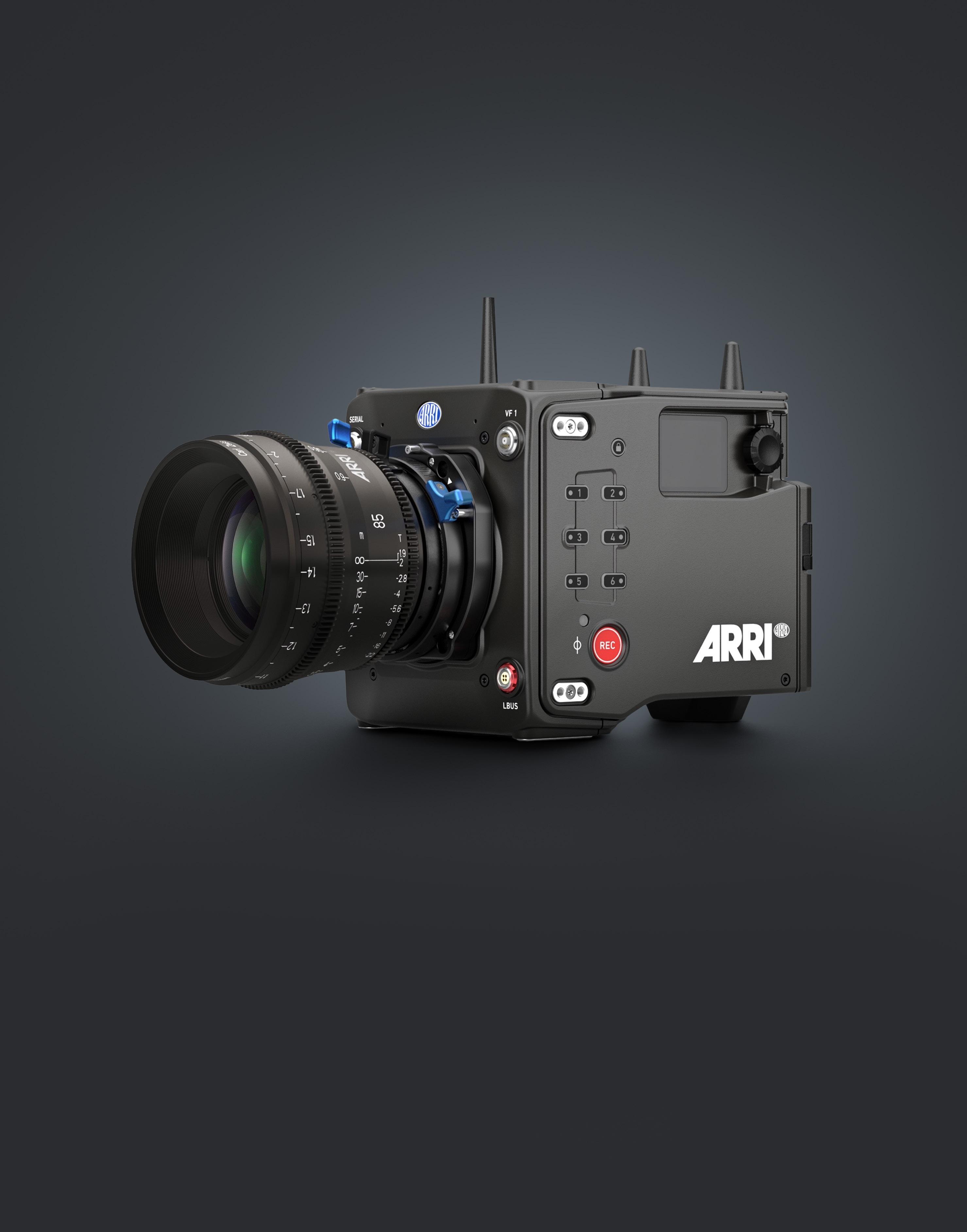


With our Interest Free Financing, you can access the latest in camera technology without the burden of upfront costs. Talk to an Account Manager on +44 (0) 208 380 7400 or email sales@cvp.com to learn more. Leasing and Interest Free Finance is available for a limited period. ARRI ALEXA 35 Interest Free Finance and Leasing Learn more cvp.com/arri Book a demo demo@cvp.com Get in touch +44 (0) 208 380 7400
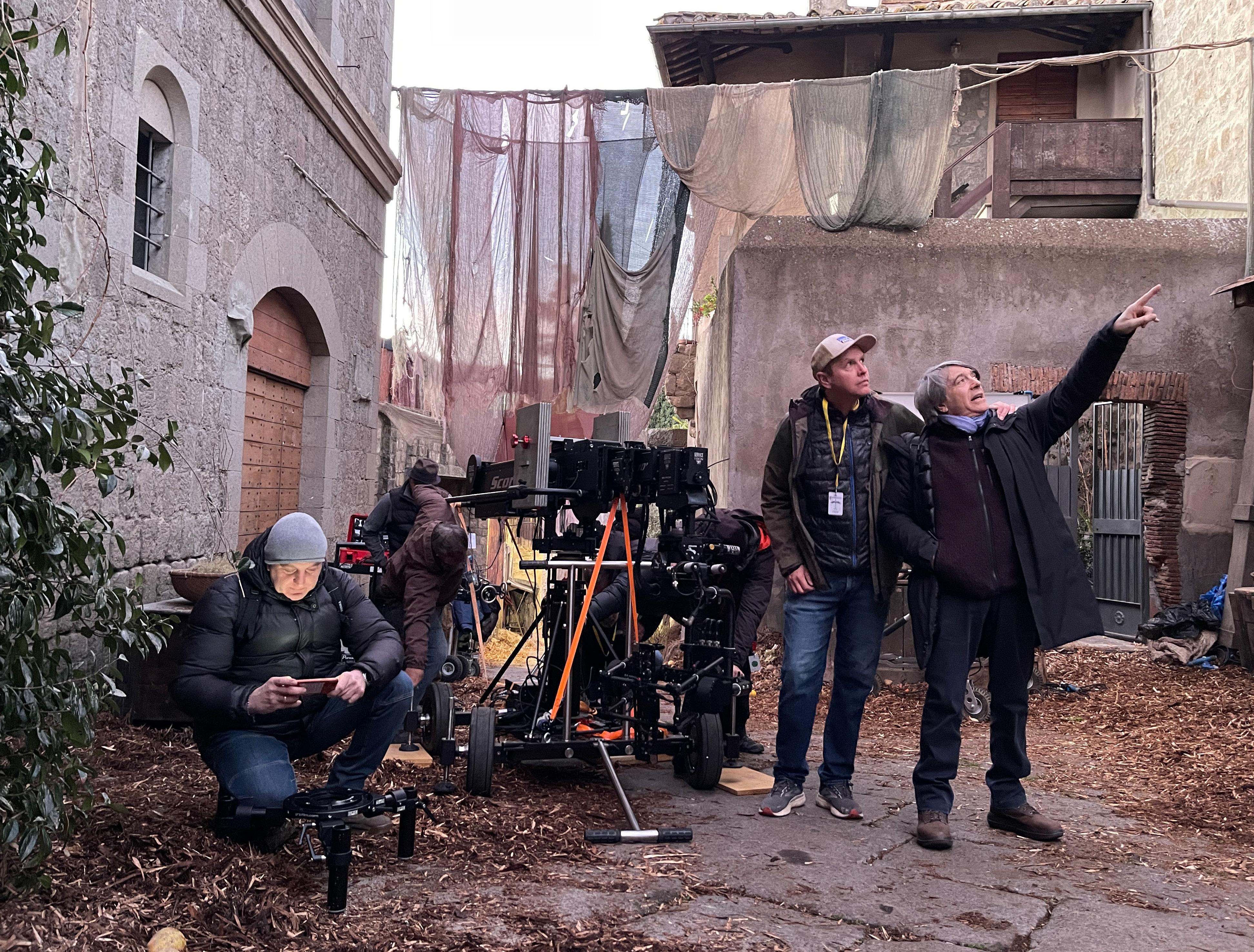
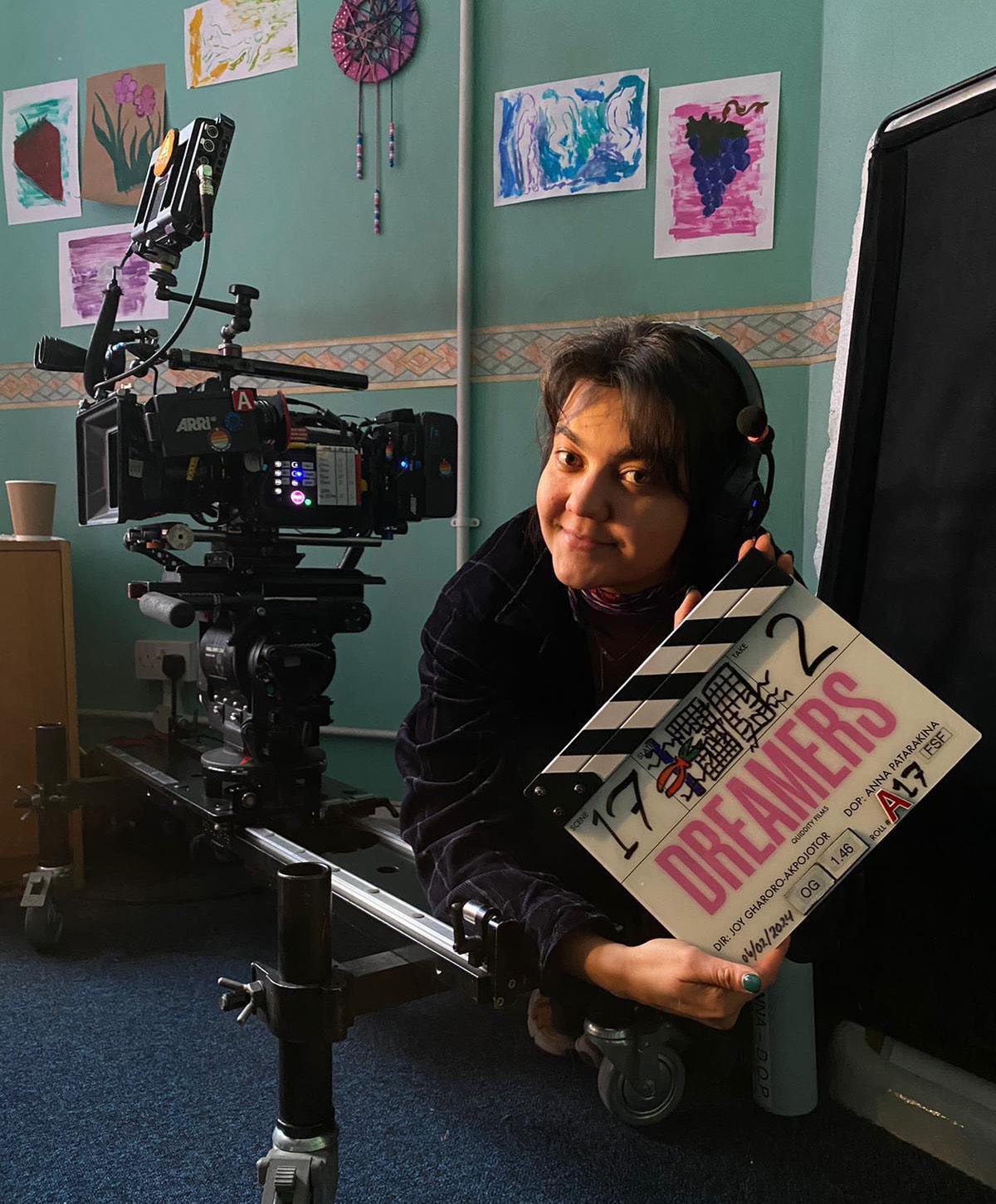
Williams, a continued campaign for Samsung with Iris, a spot for Kellogg’s with Kode Media director Pete Banks, and a Dove Men campaign with Irresistible Studios’ helmer Chris Ranson. Pieter Snyman shot for director Sye Allen in Toronto on
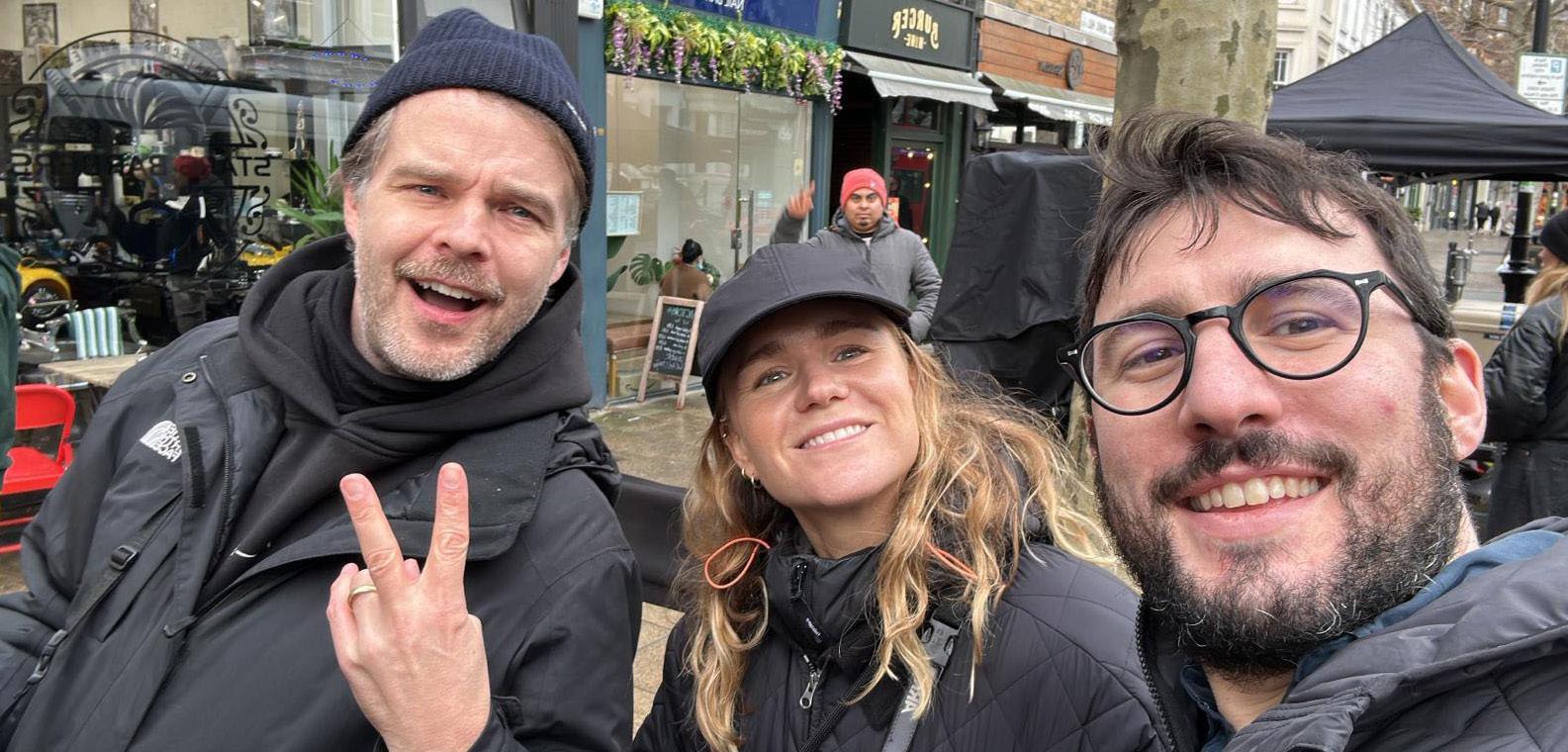
a project with Alfredo films, and lit an Asos spot with Tinderflint and directing duo Bedroom. Amelia Hazlerigg shot for Hilton x Lancashire Thunder with Phase Films and Raja Virdi, and continued to shoot for Boots with Dog Eat Dog and Claas Ortmann. Dan Holland travelled to Casablanca for a Ledda spot with Valkyries Production and director Paul Butterworth. Peter Hadfield shot an ad for Appy Fizz with John Poloquin and Ransom Films. Matthew Fox wrapped with MJZ and Joy Kilpatrick for McDonalds, and shot a spot for Lu Biscuits with Paul Butterworth. Matthew Emvin Taylor was
in Cape Town with Kinetic Popcorn and director Bethan Seller for Lego. Jaime Ackroyd shot with director Ciesay and Racket Productions for Maison Kitsune. Sy Turnbull lit an Aramco spot with Toby Dye and RSA Films. Matthew J. Smith shot with director Chloe Victoria Hughes and Radical Media for Andrex. Alexandre Jamin worked in multiple countries on a campaign for Diriyah with Deja Vu and director James Coton.
INDEPENDENT TALENT GROUP:
Billy Kendall has joined the agency as a new client. Dan Atherton recently received an ASC nomination for his excellent work on Great Expectations Chas Bain has graded Dr Who S14. Ole Birkeland BSC is working with Philippa Lowthorpe on an undisclosed project. Eben Bolter BSC has graded for The Life Of Chuck Caroline Bridges is confirmed on block three of Outlander S8, which will shoot in June. Jordan Buck has been shooting stills with
20 MARCH/APRIL 2024 CINEMATOGRAPHY WORLD WHO, WHAT, WHEN & WHERE
Photos: (top) Mattias Nyberg (middle) and 1st AD Sergio Ercolessi (r) on-set of The Decameron, photo by camera operator Rob Flood; Anna Patarakina with the clapperboard on Dreamers; and Amelia Hazlerigg and lively crew during a Boots commercial.
ELECTRO STORM


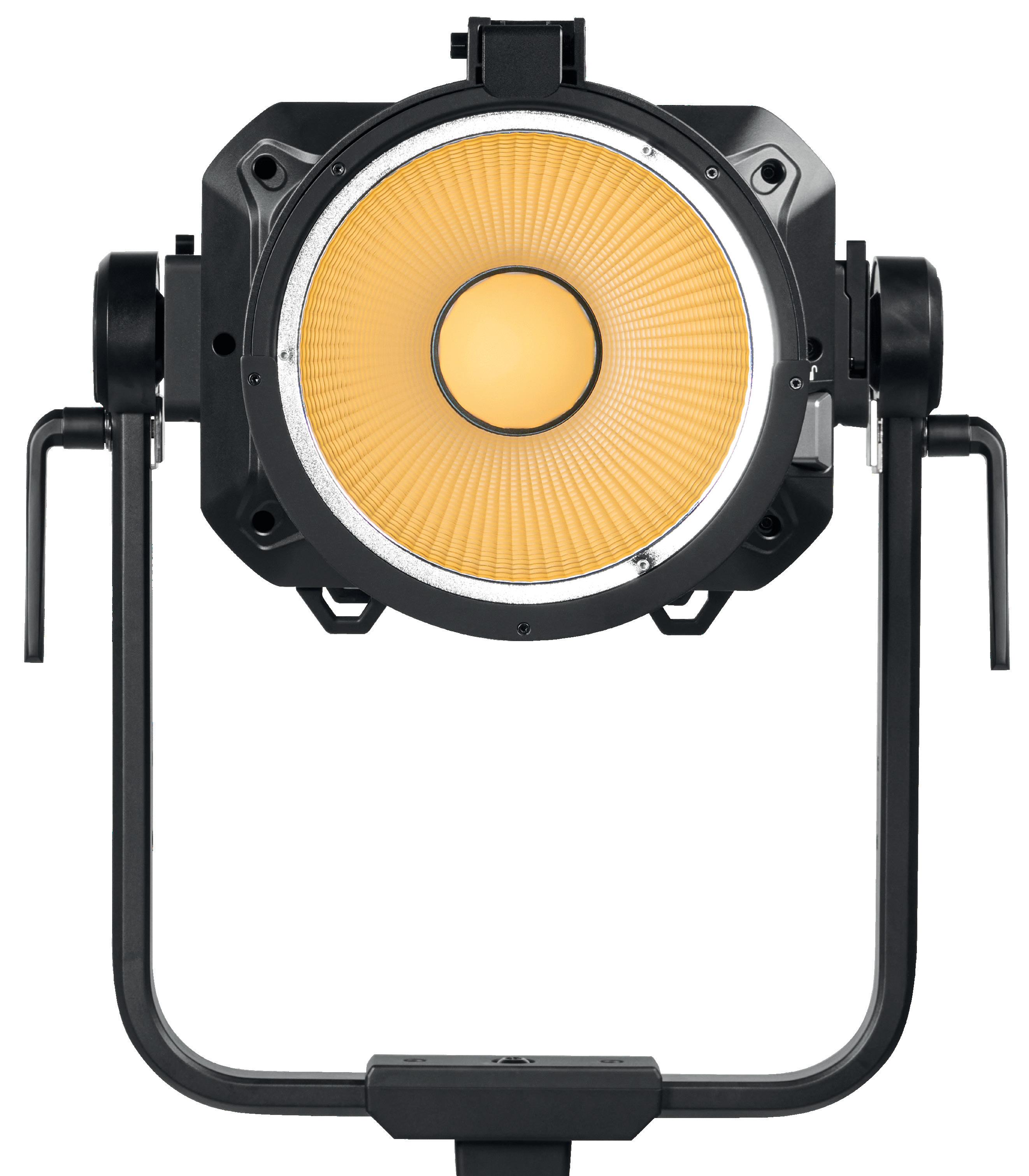
1500W | RGBWW 2600W | BI-COLOR APUTURE.COM IP65 DUST & WATER-RESISTANT DUAL ACCESSORY MOUNT OPTIONAL: F14 FRESNEL & MOTORIZED YOKE
photographer Ben Rayner for Primark, lit a shoot for Rayban with Roman Rutten, and filmed a short with Femke Huurdeman. Miguel Carmenes shot EE and Nike Air spots with director Silence, and an ambitious sci-fi short using virtual production. Chris Clarke lit for Legoland and shot a short written/directed by Pip (Ben Seed). Oliver Curtis BSC has been shooting The Road Trip with China Moo Young. Ben Davis BSC as finished on Ilya Naishuller’s Heads Of State. Anthony Dod Mantle DFF BSC ASC has started to prep Danny Boyle’s 28 Years Later Michael Filocamo is shooting on Tom Vaughan’s I, Jack Wright whilst grading for A Good Girl’s Guide To Murder. Sam Goldie is in prep for On The Sea, a feature written and directed by Helen Walsh. Kit Fraser is shooting The Scurry with regularly collaborator Craig Roberts. Cinders Forshaw BSC is confirmed on Vera S14, shooting in April. Katie Goldschmidt BSC is in Canada shooting the new series of The Last Of Us Rick Joaquim SASC shot the short film Yam And Egg, directed by Emily Nkanga. Suzie Lavelle IS BSC is prepping for an Untitled Feature Seamus McGarvey BSC ASC is in US shooting The Accountant 2 with Gavin O’Connor. Bani Mendy is in full time prep on Crongton, with director Ethosheia Hylton. Aadel Nodeh Farahani has graded the short film Dream Carwash, directed by Edorado Brighenti. Mark Patten BSC has wrapped on Black Doves starring Keira Knightley and Ben Whishaw. Stephan Pehrsson BSC is on Haven Green with Toby Haynes. James Rhodes is shooting Malice with Leonora Londsale. Chris Ross BSC is shooting The Fisherwoman Martin Ruhe ASC shot with Iconoclast’s Matt Lambert on Finn Rinsdorf’s latest music video titled “Let’s Say Goodbye”. David Ungaro AFC is with Scott Frank shooting Department Q Mark Waters has finished shooting on block 2 & 3 of Grantchester S9 directed by Katherine Churcher, and is prepping for All Creatures Great And Small S5. Erik Wilson BSC has been shooting commercials with Randy Krallman and Sharon Maguire. Maja Zamojda BSC is shooting block 2 of The Franchise
LOOP TALENT:
Cinematographer Iikka Salminen joins the roster, fresh from his success with the feature Sebastian, directed by Mikko Mäkelä, which had its world premiere at Sundance in the World Cinema Dramatic Competition. Loop Talent also welcomes Cardiff-based DP Ryan Eddleston to its roster, whose latest feature Timestalker, directed by Alice Lowe, premiered at SXSW this year. Ali Asad shot the UK leg of feature Runt Martyna Knitter and Lorenzo Levrini have both wrapped on the feature Bad Day At The Office Denson Baker ACS NZCS is shooting the feature Permitted Target Matt North is lighting a drama for the
BBC. Watch out for Jon Muschamp’s work on Spud Tom Watts and Natalja Safronova are shooting exciting documentaries. Nicholas Bennett, Bertrand Rocourt, Jerry Amadi-Pradon, Kyle Macfadzean, Emma Dalesman, Chris Fergusson, Chris O’Driscoll, Tom Turley, Olly Wiggins, Dave Miller and Paul Mackay have been shooting commercials in the UK, Europe and the US. A huge congratulations to Steadicam/camera operator Grant SandyPhillips ACO who has been accepted by The ACO as a full member. Camera operators, James Anderson ACO, Jack Smith and Alice Sephton have been operating on short form projects, whilst Ben Eeley ACO, Michael Eshun-Mensah ACO, Sebastien Joly ACO, Gary Kent, Laura Seears and Michael Vega have been operating Steadicam on commercials.
UNITED AGENTS:
Remi Adefarasin OBE BSC is grading Mr. Loverman for BBC Studios/Fable Pictures, directed by Hong Khaou. Søren Bay DFF has graded The Rig S2 for Wild Mercury Productions/Amazon Prime. Mark Nutkins is shooting Curfew with Vertigo for Paramount+ with director Joasia Goldyn. Philippe Kress DFF is shooting The Summerdahl Murders S6 for Sequoia Global Alliance with director Kenneth Kainz. Danny
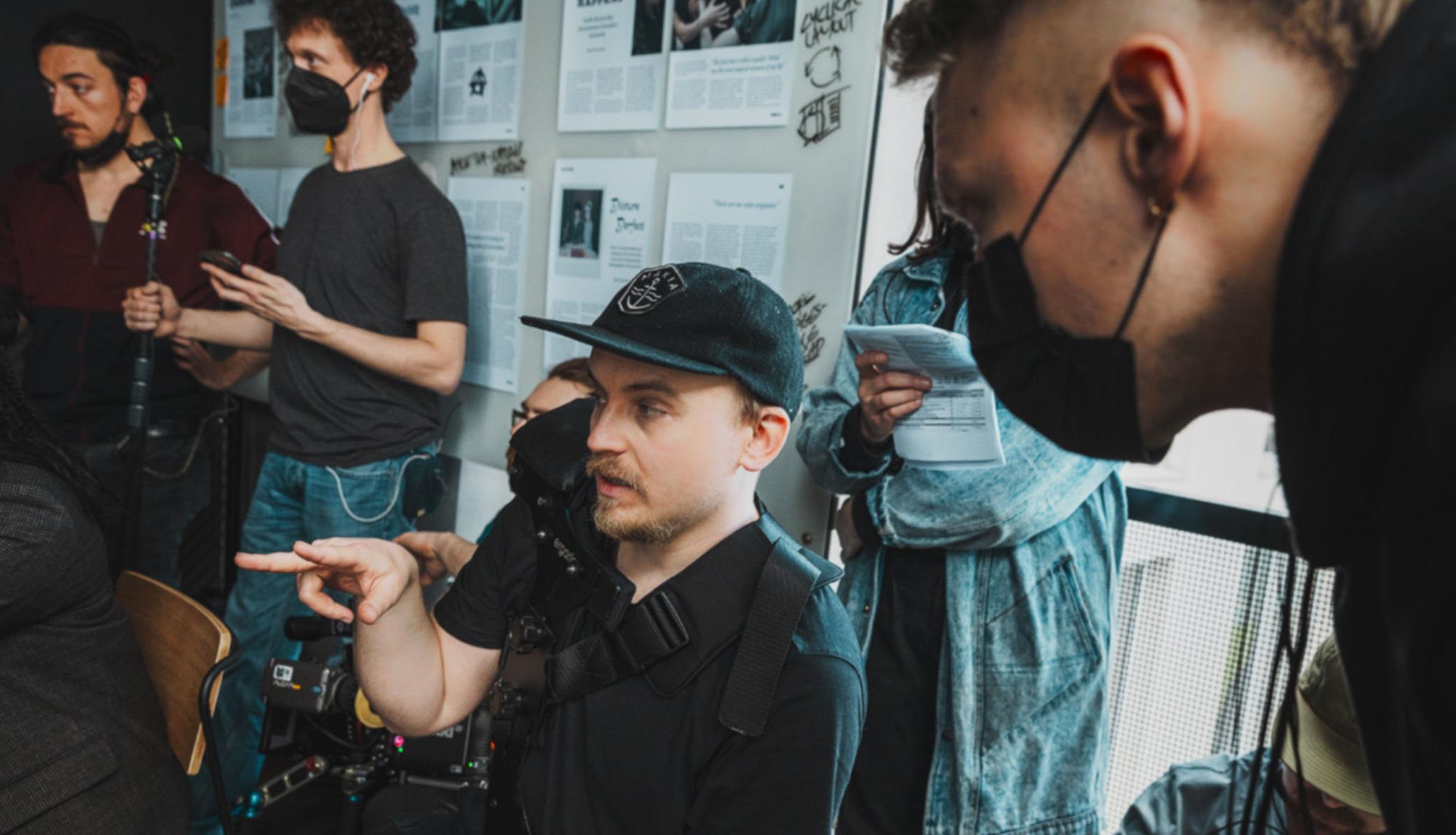
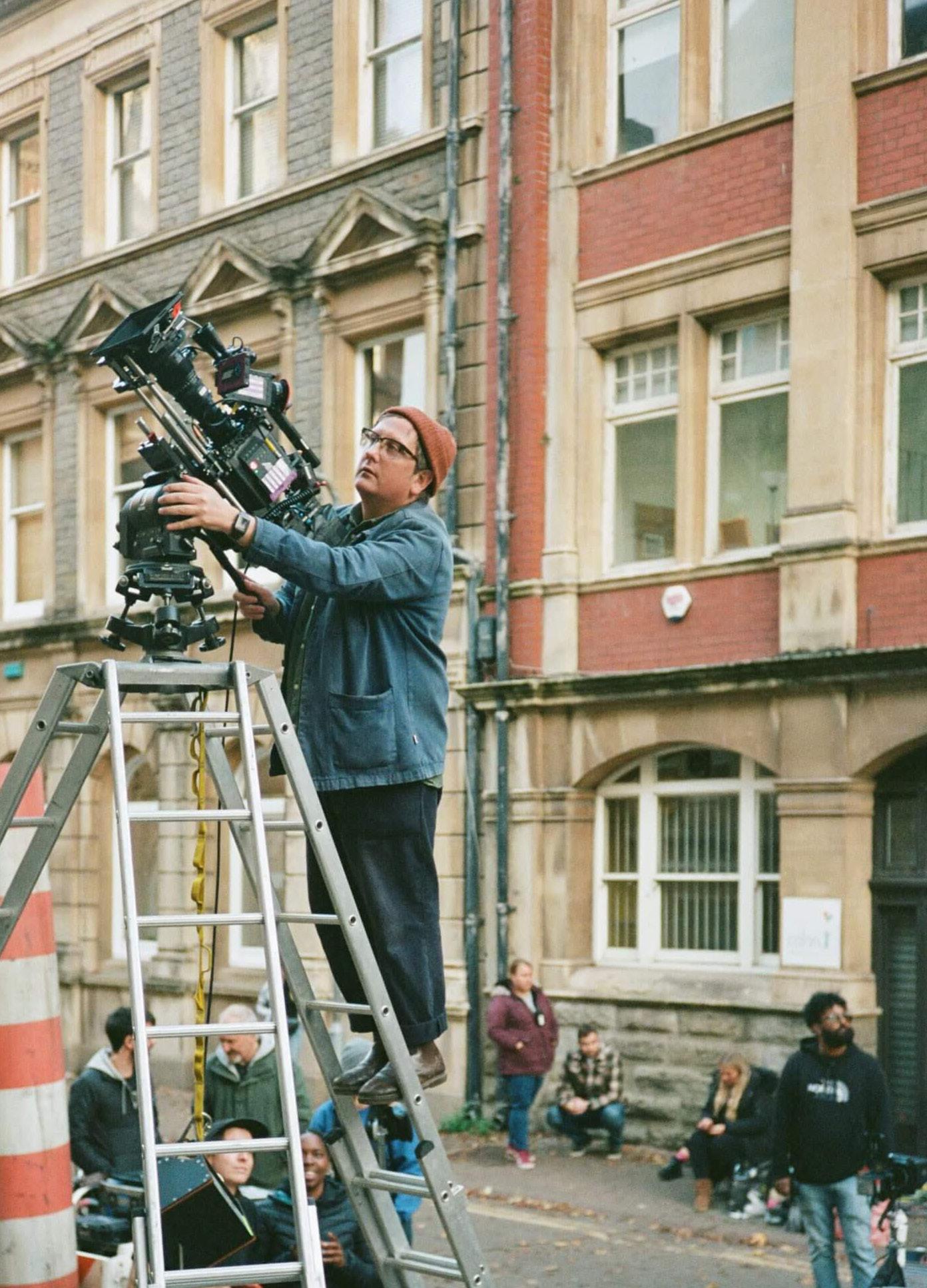
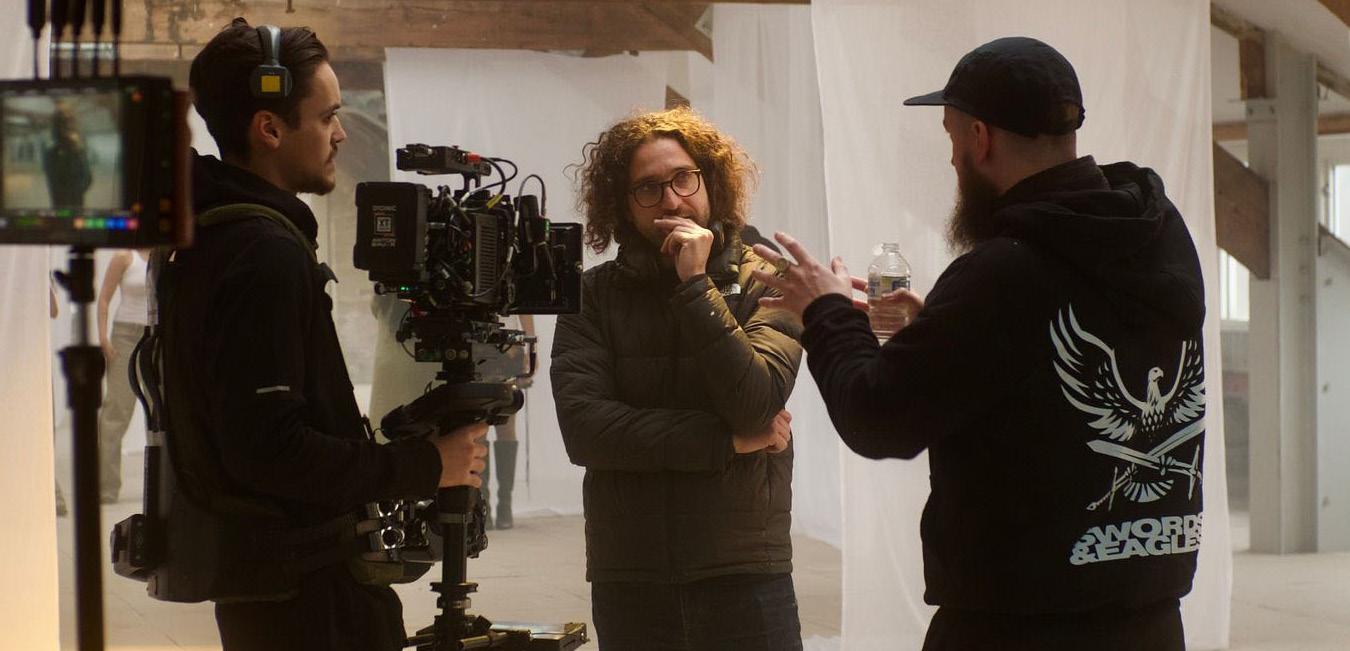

various projects. Laurie Rose BSC is on Midwinter Break. Bet Rourich AEC recently attended the Spanish Goya Awards, where she was nominated for her work on Un Amor, and now prepping
22 MARCH/APRIL 2024 CINEMATOGRAPHY WORLD WHO, WHAT, WHEN & WHERE
Cohen BSC is shooting Slow Horses S4. Damian Paul Daniel’s documentary Fearless is doing the rounds on the festival circuit. Martin Fuhrer BSC, Juan Sarmiento G. and Niels Reedtz Johansen are reading and meeting. David Higgs BSC has begun prep in Edinburgh on Department Q Matt Lewis begins work shortly on Jack Thorne’s Adolescence, directed by Philip Barantini. Kieran McGuigan BSC is meeting for
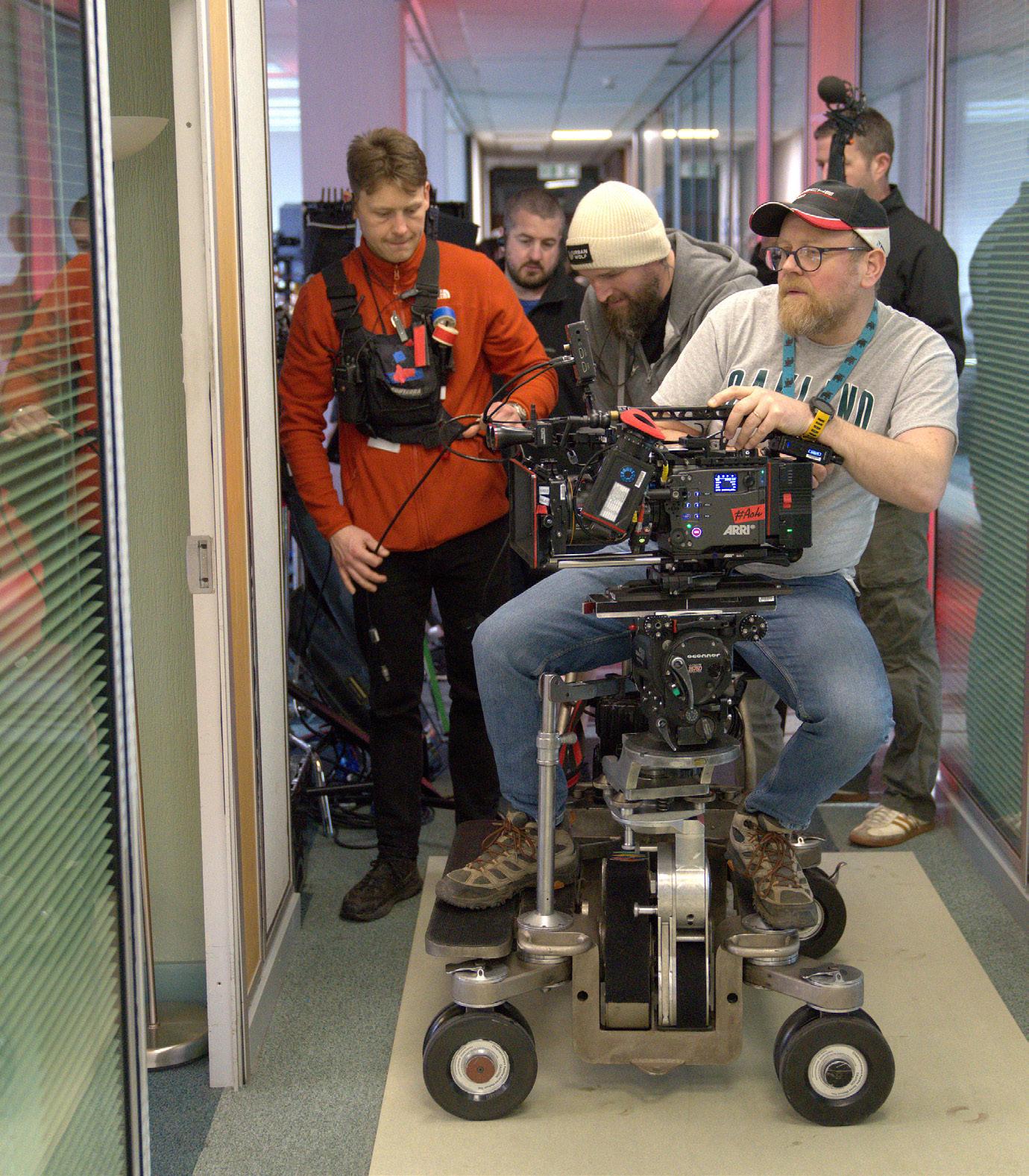
on her next Spanish feature. John Sorapure did pick-ups on PaddingtonS3. Simon Tindall has graded the opening block of Sherwood S3 Ollie Downey BSC is shooting two episodes of Wool for Apple TV+/AMC. Laurens De Geyter SBC is lensing the Flemish fiction series, Dead End directed by Jakob Verbruggen and Maarten Moerkerke David Rom is prepping for The Devil’s Hour S3 Álvaro Gutiérrez AEC is prepping for a Spanish series with Netflix. Sam Heasman is shooting on Lazarus with director Nicole Volavka. Si Bell BSC is lighting What It Feels Like For A Girl, a series by Hera Pictures with director Brian Welsh. Sam Chiplin lit Justin Kurzel’s next series The Narrow Road To The Deep North in Australia. Charlotte Bruus Christensen ASC is shooting commercials whilst reading and meeting. James Friend BSC ASC is shooting commercials and prepping Edward Berger’s next feature. Anton Mertens SBC is lighting the series Bookish, written by and starring Mark Gatiss. Milos Moore has graded A Thousand Blows for Disney+ with directors Ashley Walters and Dionne Edwards. David Raedeker BSC is shooting Butterfly, a feature produced by Quiddity Films with director Itonje Guttormsen Kate Reid BSC is on Silo S2. Ed Rutherford is mid-shoot on Mandrake with director Lewis Arnold for ITV. Anna Valdez Hanks is lighting Missing You with director Sean Spencer for Quay Street Productions. Ben Wheeler BSC is prepping with
WHO, WHAT, WHEN & WHERE
director Jeremy Lovering on The Undertow, a series by Complete Fiction for Netflix. Barry Ackroyd BSC recently shot an NHS project for director Andrew Gaynord, in London for MindsEye. Alex Barber lit a Cadburys commercial with director Terri Timely via Park Pictures. Alfie Biddle is working on Shetland S9 with director Andrew Cummings in Scotland. Philipp Blaubach is shooting The Diplomats for Netflix. Sam Care lensed a Viatlin commercial with director Katie Bell for Studio Yes. Simon Chaudoir has been working on a fashion campaign in Paris with director Helmi for Mirror Miror. Sara Deane is currently shooting TV series The Wives in Malta. Lasse Frank shot in Slovenia with Andreas Nilsson on an Andrex ad for Biscuit, and in Brazil with MJZ on a Coca-cola TVC with director Nicoli Fugslig. Stephen Keith Roach lit a McDonalds commercial in London with director Tim Godsall for Anonymous Content. Alwin Kuchler BSC has been shooting with director Nick Ball in Cape Town, for MJZ, US. Ali Little has been busy on a Parkinson’s project with director Artur Zaremba and a Dove spot with Rattling Stuff for director Michael J Ferns. Tim Maurice Jones BSC shot a Sky Mobile ad in the Dominican Republic with directors Traktor via Stink. Alex Melman shot in Bulgaria with directors Big Red Button on an Orange campaign with Degaulle, Paris. Ben Moulden lit a pilot for Objective Fiction with director Luke Snellin. Tristan Oliver BSC lensed a Kiels commercial with director Mark Waring for Passion Pictures London. Neus Ollé AEC BSC shot a spot in Barcelona for directors Traktor. Sebastian Pfaffenbichler AAC filmed a Gatorade ad in Madrid and London for director Michael Dowing via The Sweetshop and a McDonalds TVC with director Christopher Schier in Vienna with PPMNEXT. Simon Richards framed an M&S ad with director Gus Filgate for Bite. Corey Robson is shooting The
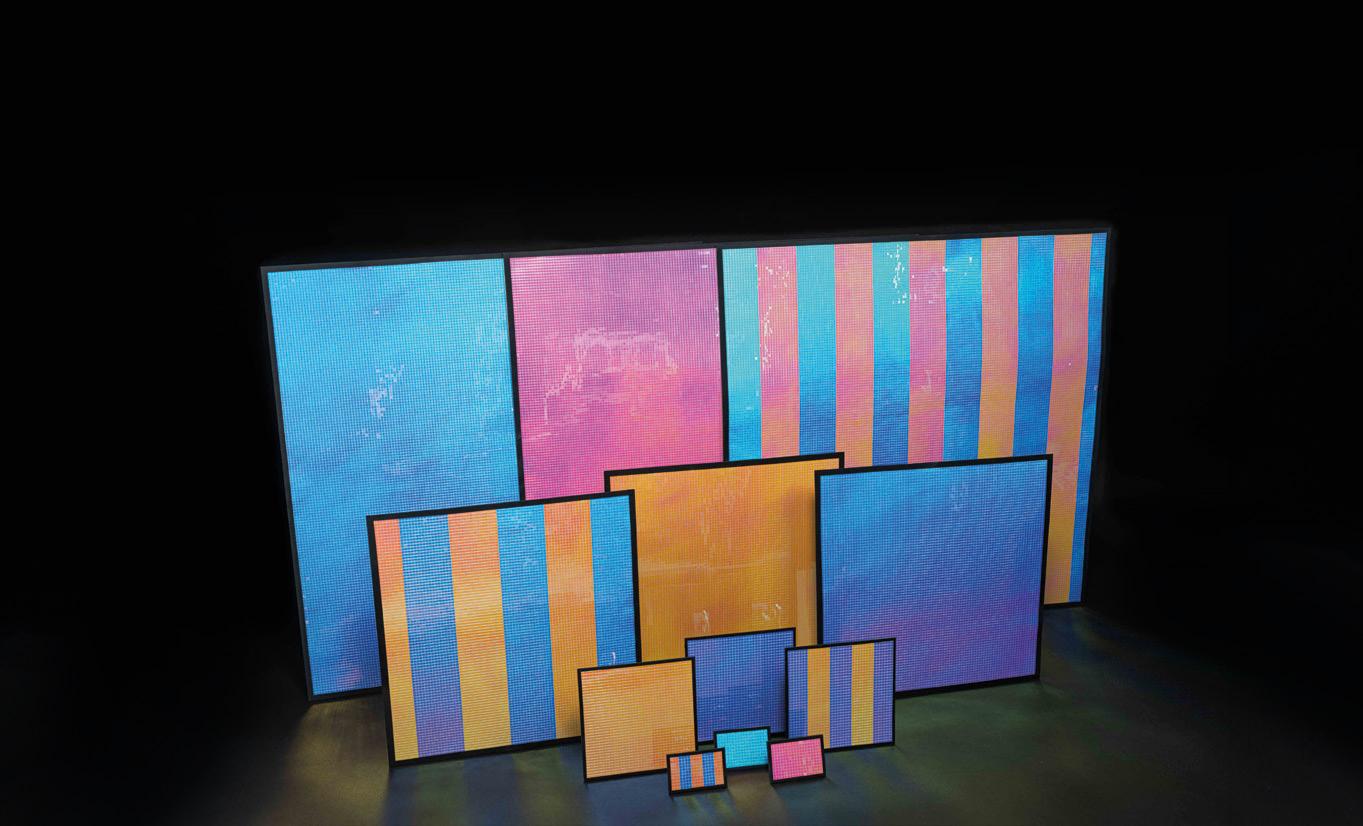
Recruit S2 in Canada. Chris Sabogal has been busy with commercials, including a Coral spot for director Keith McCarthy through Object & Animal, and an Alzheimer’s project for director Charlotte Reagan via Knucklehead, London. Simon Tindall recently lit a commercial for Longchamp in Paris for director Elaine Constantine via Industry Art.
MCKINNEY MACARTNEY MANAGEMENT:
Ben Butler, Denis Crossan BSC and Alessandra Scherillo have been shooting commercials. Sergio Delgado continues to shoot Surface S2 for Apple TV+. Gavin Finney BSC is filming Wolf Hall S2 for BBC2, with Peter Kosminsky directing. Jean Philippe Gossart AFC is prepping Wheel Of Time for Amazon Studios. Dale Elena McCready BSC NZCS has finished shooting Day Of The Jackal for Sky Studios and is prepping Doctor Who for Bad Wolf in Wales with Ben Williams directing. Andy McDonnell is shooting on The Forsyte Saga for Mammoth Screen in Bristol. John Pardue BSC has begun prep on Malice for Expectation TV, shooting in London and Greece. Sam McCurdy ASC BSC is lighting Firebug for Apple TV+. Richard Stoddard has been lensing Lazarus for Quay Street Productions/ Amazon Prime.
WIZZO & CO:
Congratulations to Ryan Kernaghan ISC, whose latest feature Kneecap, directed by Rich Peppiatt, won the Next Audience Award at Sundance. Ashley Barron ACS is shooting Dr Who alongside director Makalla McPherson. Susanne Salavati is lensing The Crow Girl directed by Charles Martin. Aaron Reid has completed the grade on Supacell Jan RichterFriis DFF recently wrapped on Netflix Original La Palma Karl Oskarsson IKS is shooting Cheaters S2 directed by Elliot Hegarty. Adam Gillham graded A Gentleman In Moscow and is now prepping on an Amazon Original. Fede Alfonzo has completed the grade on Jamie Rafn’s feature, Near Miss Matthias Pilz is shooting an embargoed documentary. Sverre Sørdal FNF has completed the colouring on Sister Midnight Scott Coulter is prepping an embargoed drama. Gary Shaw continues to shoot Coolie in Panama. Nicola Daley BSC ACS is shooting on Gangs Of London S3. Nick Dance BSC has wrapped and will shortly grade Dr Who Charlie Goodger is prepping an embargoed drama. Simon Stolland has done the DI on Nick Love’s feature Marching

CINEMATOGRAPHY WORLD MARCH/APRIL 2024 23 www.dedoweigertfilm.de UK and Ireland Rental and Sales Distribution: www.cirrolite.com eflect Magic effects beyond belief Added new versions Look at the video and descriptions
Photos: (opposite) – DP Ryan Eddleston up the ladder; DP Lorenzo Levrini on a music video with director KC Locke; DP Kyle Macfadzean at the camera lensing a commercial; and Iikka Salminen on-set working out a two-shot.
This page: DP Richard Stoddard on the dolly shooting Lazarus, with grip Phil Lake, 2nd AC James Johnson, 1st AC Rob Shaw and boom op Dave Lynch.


Powder, and Christophe Nuyens SBC has graded Disney+’s Andor S2. Oli Russell continues to shoot The Gold S2, alongside director Patrick Harkins. Steven Ferguson is prepping an embargoed drama. Tim Sidell BSC has wrapped on Apple’s Surface S2, and Franklin Dow is shooting a documentary directed by Orland von Einsiedel. Chas Appeti has graded the feature Heavyweight Luke Bryant is prepping an embargoed feature. Hamish Anderson shot with director J Marlow, Will Bex with Scott Lyon, and Carmen Pellon Brussosa with Callum Lloyd-James. Joe Douglas lit for That Jam, Theo Garland for Fatal Fam and Henry Gill for Jack Foreman. Arran Green, Dumi Siwo and Ben Magahy shot with director Finn McGough. Molly Manning Walker continues on the festival circuit. Dmytro Nedria lensed for Hauke Hilberg., Antonio Paladino shot with Tim Bullock, and David Procter BSC shot with Joe Connor. Darius Shu has graded his latest short film. Murren Tullett shot with Harry Cauty.
PRINCESTONE:
Of the agency’s DPs… Thomas English has been shooting commercials, including Nissan for director Nathan Tettey with Knucklehead, and McCain for Common People. He also did dailies as 2nd unit DP on the feature Joy, and shot the BBC music performance documentary Living Lyrics. Diego Rodriguez is currently shooting two documentaries – Galacticos with Fulwell, shooting in Madrid and Brazil, and Reloaded for Lorton Ent., following Jurgen Klopp and Liverpool FC during the current season. Of the agency’s camera/Steadicam operators… Michael Carstensen ACO is shooting on Gangs Of London S3, with DP Callun Green ACS NZCS and director Hong Sun Kim,and is set to work on The Witcher S4 with DP Scott Winig and director Sergio Gezzan. Matt Fisher ACO shot dailies for Dalgleish And Sapphire, before heading to Budapest to shoot on Ballerina with DP Chung- Hoon Chung ASC. Tony Kay ACO
is framing on the new series of Strike with director Sue Tully and DP Pedro Cardillo ABC, starring Tom Burke. James Layton Associate BSC ACO is shooting on Sister Pictures/Netflix’s contemporary drama Black Doves with Mark Patten BSC and director Alex Gabassi, starring Keira Knightly. Nic Milner Associate BSCACO has joined director Guy Ritchie on Bimini shooting in Egypt, with DP Ed Wild BSC. Dan Nightingale ACO has been shooting in Belfast on the live action feature of How To Train Your Dragon with DP Bill Pope ASC and director Dean DeBlois, with cast including Gerard Butler. Joe Russell ACO recently finished shooting on Silo S2 with DPs Baz Irwin BSC, Ollie Downie BSC and Kate Reid BSC, and is in prep on Sky Studios’ Haven Xandy Sahla will be working as 2nd unit DP on the next series of Unforgotten with director Andy Wilson. Sean Savage Associate BSC ACO is shooting House Of The Dragon with DP PJ Dillon.
ECHO ARTISTS:
Andrew Commis ACS recently wrapped on Charles Williams’ feature Inside Carlos Catalan has been shooting Shannon Murphy’s series, Dope Girls, for the BBC. Nadim Carlsen, DFF has begun prep on Clerkenwell Films’ new six part series, The Death Of Bunny Munro starring Matt Smith, based on the novel by Nick Cave. Fredrico Cesca ASK has graded the latest series of Industry David Gallego ADFC is grading on director Rungano Nyoni’s feature, On Becoming A Guinea Fowl Nick Cooke is prepping for Paul White’s feature Mission, shooting in Glasgow. Rachel Clark’s last feature The Edge Of Summer from director Lucy Cohen, premiered at Glasgow Film Festival. Will Pugh lensed on the 4th block of Pete Townsend’s feature documentary Lighthouse with Pulse Films. Korsshan Schlauer is working on the upcoming feature film Odyssey Sean Price William’s directorial debut feature, The Sweet East, had its UK Premiere at the ICA in London. Stuart Bentley, Jo Jo Lam and Patrick Meller have all been shooting commercials.
SARA PUTT ASSOCIATES:
Giulio Biccari is lighting block 2 of Black Doves for Sister Pictures/Netflix, working with director Lisa Gunning. Duncan Telford is working for Story Films on the Sky documentary Still Proud Aga Szeliga ACO is back on Venom 3, working with DP Fabian Wagner BSC ASC in Spain. Al Rae ACO worked on the forthcoming HBO series The
Regime, which stars Kate Winslet, and is available to view on Sky Atlantic and Now TV. Andrei Austin ACO is working on Lena Dunham’s project, Too Much, for Working Title, ten-part series set in London, that will air on Netflix later this year. Andrew Bainbridge ACO shot on One Day, which aired on Netflix in February, and The Completely Made-Up Adventures Of Dick Turpin, available to watch on Apple TV+. Chris Maxwell Assoc ACO shot a music video for Travis, and you can watch his work on A Scottish Love Scheme on Apple TV+ and Nightsleeper BBC One. Dan Evans ACO has been working on his project Kit Starter to secure work experience for young people living in low-income areas of the UK. Dan has also worked on various short films, most recently Solers United with director Sara Harrak. Danny Bishop ACO teamed-up with DP James Friend BSC ASC to work on Above The Below, starring Idris Elba. Ed Clark ACO was nominated for this years’ BSC Operator’s Award for his work on Black Mirror “Demon 79” episode, and is prepping for a new Black Mirror, whilst also doing dailies on A Quiet Place: Day One. George Amos has finished shooting in the Canaries on Guy Ritchie’s feature and he’s now back in his native South Africa prepping on a new project that will shoot soon. Ilana Garrard ACO was in Finland operating Steadicam on a feature called The Fisherwoman, starring Emma Thompson. James Frater ACO is working on the much-anticipated Frankenstein project, and shot on Ballerina, starring Keanu Reeves, showing in cinemas this June. James Leigh ACO is working for Buccaneer Media on psychological crime thriller, The Crow Girl, for Paramount+. Julian Morson ACO wrapped on Heads Of State and is working Guy Ritchie’s Bimini. Rick Woollard ACO operated Steadicam/ AR on commercials and music videos including Charlotte Tilbury with DP Andre Chemétoff, Puma’ with DP Joao de Botelho, and Hublot with DP Jeremy Valender. Tom Walden ACO shot on The Tattooist Of Auschwitz, and recently wrapped on The Gold S2. Vince McGahon ACO received a nomination for the BSC Operators Award for his work on Slow Horses S3, and now working on S4 of the series. Will Lyte ACO has been working on Big Talk’s new comedy for BBC One, Ludwig, starring David Mitchell. Zoe Goodwin-Stuart ACO was nominated twice this year for the BSC Operator’s Award for her work on The Witcher and Wonka, and is shooting on The Franchise for HBO.



WHO, WHAT, WHEN & W HERE 24 MARCH/APRIL 2024 CINEMATOGRAPHY WORLD
Photos: (top two) – DP Murren Tullett on short film Calico, and in the water with director Jake Mavity, grip Emmet Cahill and 1st AD Sam Powell; Ashley Barron ACS shooting Dr Who for Bad Wolf/Disney+ with director Makalla McPherson.


THE WOW FACTOR
By Natasha Block Hicks
When Natasha Mullan swapped the UK for the USA at the start of her career, it echoed the move her family made from Belfast to London during her primary school years, following her father’s science work.

Movies were rarely on the agenda during Mullan’s childhood, so her knowledge of the industry behind them was non-existent. However, even then, she started to show the instincts that would eventually lead her to the bright lights of LA.
“I was intrigued by how light hits people’s faces from a very young age,” recalls Mullan, about a fascination she first explored through drawing and painting, before transitioning to photography in her teenage years.
“Then, I became obsessed with different compositions and how shade and light could have an emotional effect.”
When she learned of cinematography as a potential career path, she pushed away from academia to study filmmaking at the University Of Westminster.
“We learned how to light on analogue film and cut with Steinbecks,” Mullan relates, “there was no digital until the third year. It was a total immersion in the craft, and I loved that.”
Finding the UK industry a tough nut to crack post-graduation, Mullan took a gamble on the aforementioned move to LA to find work.
“It was naïve,” she admits, “but luckily moving abroad opened-up a world I could not have foreseen.”
A friend put her in touch with Simon England – regular 1st AC for Dan Mindel BSC ASC SASC – who invited Mullan to meet him for a coffee at Panavision. When England showed up late, Mullan
We work long hours, away from our families, and it’s so important that time is spent with good human beings
had already got stuck-in helping Mindel’s camera team ship out the gear they were prepping, and she ended-up staying for the week. To her surprise, her renumeration was a ticket to the Local 600 union, and a place in Mindel’s ‘family’ of assistants. Her first movie with England involved scaling
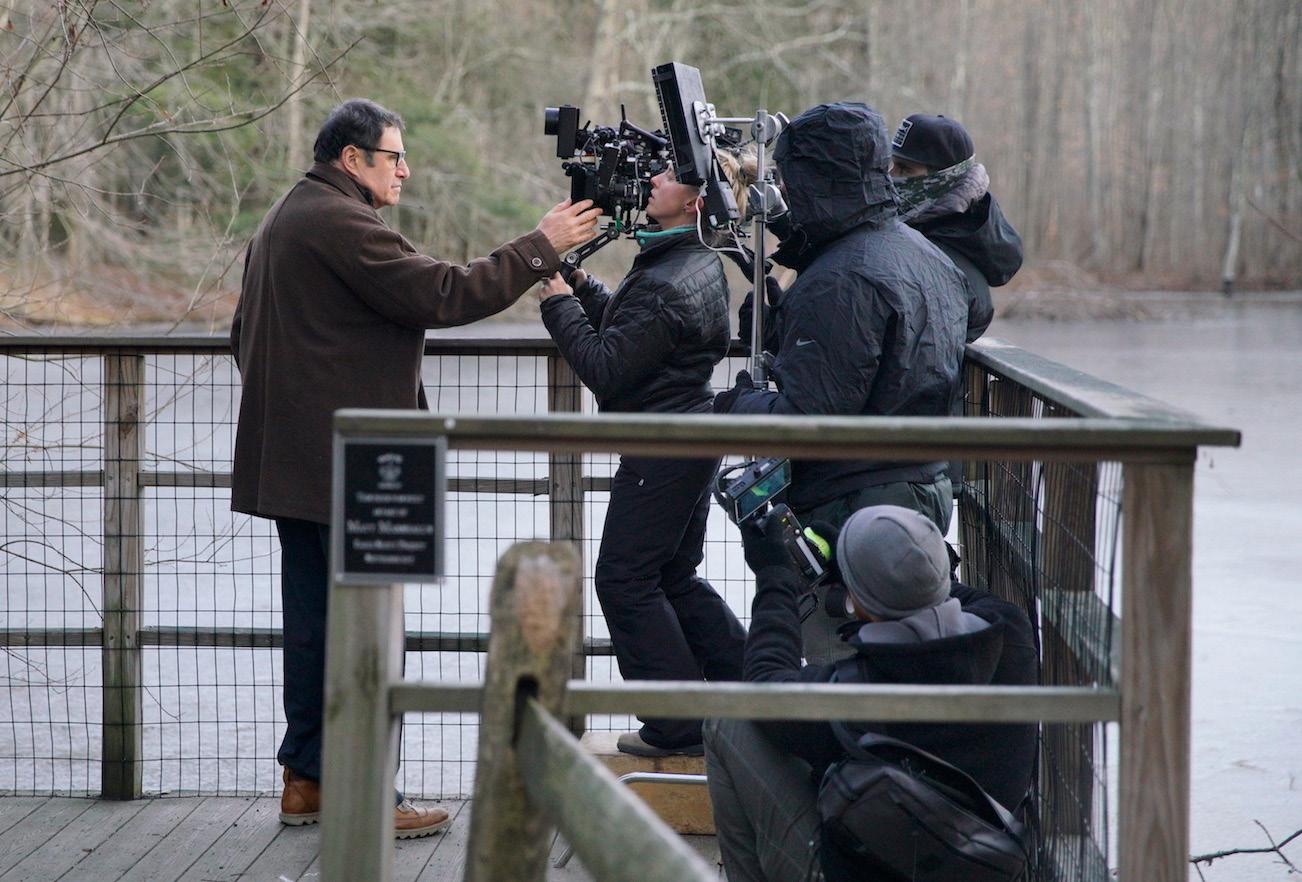
the mountains of Patagonia, shooting The Revenant (2015, dir. Alejandro G. Iñárritu, DP Emmanuel ‘Chivo’ Lubezki AMC ASC).
“It was incredibly difficult, but Chivo was very good at saying, ‘stop and look where you are’”, relates Mullan. “I relive that advice so often, with the incredible places you visit in this job. I constantly have waves of ‘wow’.”
With England, Mullan transitioned from working as a loader to A-camera 2nd AC, and caught the attention of 1st AC Trevor Loomis, with whom she worked on several projects, including Hotel Artemis (2018, dir. Drew Pearce, DP Chung-hoon Chung ASC).
“I was brought under their wing, and I owe Simon and Trevor a lot.” Mullan notes fondly.
In 2019, England and Mullan assisted the then pregnant Rachel Morrison ASC for an eight-month on Seberg (2019, dir. Benedict Andrews), the biopic of political New Wave actress Jean Seberg.
“A constant message you get is that it’s not possible to be a mum and have success in the industry,” stresses Mullan, “so it was refreshing to see a pregnant woman, operating handheld with a 1,000ft mag, saying, ‘I’m not fragile, I’m in my superpower phase’. It really rang true for me.”
Between assistant jobs, Mullan has never
SMOOTH OPERATOR•NATASHA MULLAN 26 MARCH/APRIL 2024 CINEMATOGRAPHY WORLD


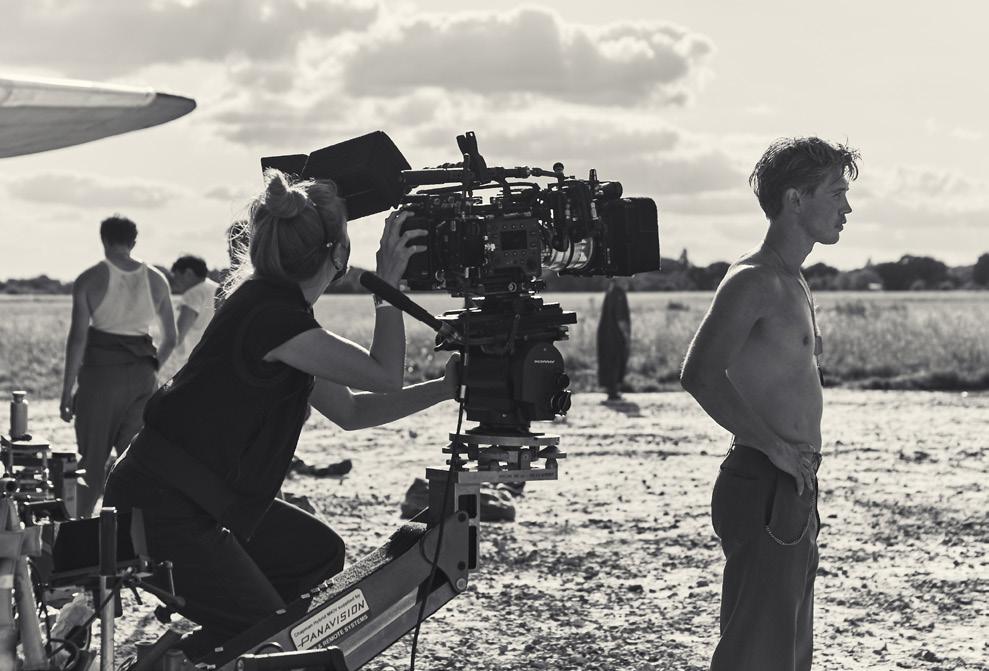
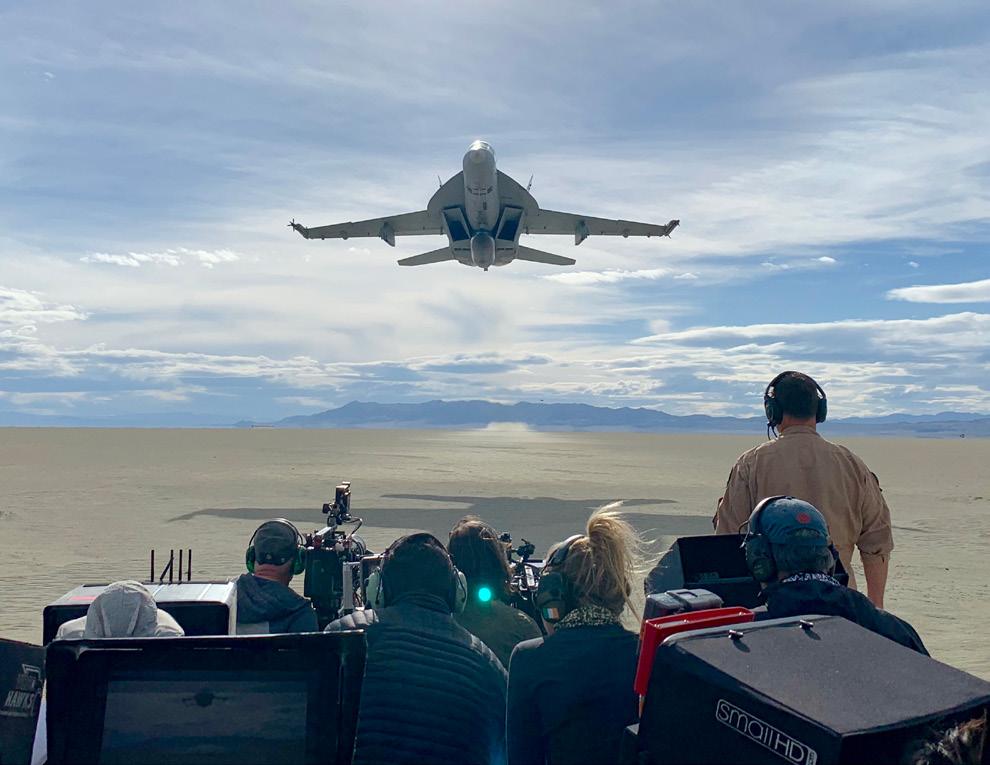
NATASHA MULLAN•SMOOTH OPERATOR
deviated from shooting her own projects, mainly short films such as Duck: A Film By Kevin Bacon (2018, dir. Kevin Bacon). Then, in 2017, admitting that she “didn’t necessarily feel ready”, Mullan took on her first feature, sci-fi drama Auggie (2017, dir. Matt Kane). Mullan theorises that it was Auggie’s thematic similitude to Her (2013, dir. Spike Jonze) that bought her work in front of the latter’s DP, Hoyte Van Hoytema NSC FSF ASC, who subsequently invited Mullan to operate for him on multiple commercials over the next 18 months.
“I was astounded by the trust Hoyte placed in me,” marvels Mullan. “He really endorsed my transition from 2nd AC to operator within the community.”
learn the language of the choreographer. Operating on Snow White felt rhythmic and methodical and that was a completely different muscle. Precision was a huge thing, as we’d have to repeat all these beautiful big dance sequences without the cast for the VFX. But I would come home singing from Pinewood each day.”
I was intrigued by how light hits people’s faces from a very young age
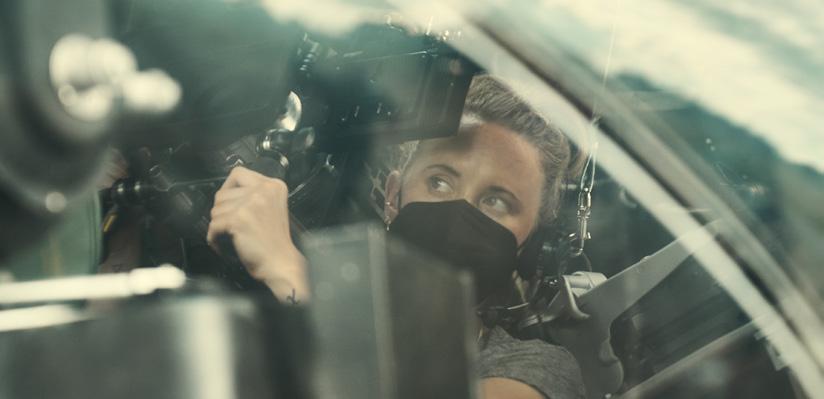
In 2020, isolated in LA by the Covid pandemic, Mullan was asked to operate on her first TV series, Hacks (2021, DP Adam Bricker), in what she describes as “a safe environment of good humans, and that was really important to me.”
However, the pandemic experience had permanently shifted Mullan’s perspective, so, after a decade in LA, she returned to the UK. Even if she was taking on unchartered territory professionally by this switch, it had distinct personal advantages.
“I like the Women’s Football League, and Chelsea FC Women to be precise,” Mullan reveals, “I used to play when I was younger. It’s been so wonderful to see it thrive lately. Now, I get to go to football games on a weeknight with my family.”
Mullan’s first home operator role was working C-camera on the WW2 biopic Masters Of The Air (2024, DPs Adam Arkapaw ACS, Jac Fitzgerald, Richard Rutkowski ASC, David Franco).
“Jac is everything I’ve been told can’t work together – she is kind, cool and patient, whilst also being incredibly talented,” comments Mullan. “Adam’s got such an incredible eye and leans into shadow, which I’ve been drawn to since I was a child.”
When Mullan wasn’t up to her eyeballs in rain and mud during the shoot, she was being hurled around, operating handheld, inside a replica B-17 cockpit on a gimbal in The Volume, the VFX soundstage in which ILM’s StageCraft video wall was implemented.
“I love a challenge. I had a scrum hat on as I was constantly being knocked,” reveals Mullen. “It was very disorientating but really fun.”
Following a recommendation from Arkapaw, Mullan joined Snow White (2025, dir. Marc Webb, DP Mandy Walker AM ACS ASC) on B-camera, working alongside Jason Ewart ACO, who’d also operated A-camera on Masters Of The Air
“Mandy is my ultimate inspiration,” says Mullan enthusiastically. “She’s smashing ceilings in the industry and doing it with kindness, grace and strength. And Jason was such a supportive mentor and collaborator, although he, like Mandy, expected the highest level.”
The musical aspect of Snow White brought new experiences and interesting collaborations for Mullan, as she explains.
“I’d have lyrics next to my wheels and had to
Despite Mullan’s relatively quick rise from a 2nd AC to a Disney-level operator, she remains pragmatic about her role in the process.
“I was always taught to treat every job the same, whether it’s a tiny indie short or a large motion picture,” she explains.
“At the heart of every project is the drive to tell the story and fulfil the director and the DP’s vision. So, I zone out the noise, and concentrate on each shot in the moment.”
Mullan doesn’t fly Steadicam, and markets herself as a B-camera operator who can shoot 2nd Unit if required, and it was in this capacity that Alwin Küchler BSC hired her for the political satire The Regime (2024, dirs. Stephen Frears and Jessica Hobbs).
“I find DPs will come and ask my opinion, which I love because it shows that we’re all collaborators and it’s art and subjective,” remarks Mullan. Her current project, an Untitled Formula One Racing Movie, is the first time she has been hired to operate by a DP she used to assist, namely Claudio Miranda ASC, with whom she last worked as 2nd AC on Top Gun: Maverick (2022, dir. Joseph Kosinski). One of the movie’s race sequences too Mullan, albeit briefly, back to LA.
“This movie has been an entirely different experience as an operator to most other productions, because of its incredibly highperformance pressures,” explains Mullan. “We got one chance, one shot, similar to what we had on Top Gun: Maverick”
Mullan says she handles the heat, “by turning nerves into excitement, and I always go with my gut, because I find with scary things the discomfort often leads to reward.
“Claudio has been so supportive of my jump and I’m really grateful for that,” she adds. “In this industry we work long hours, away from our families, and it’s so important to me that that time is spent with good human beings on-set.”
Mullan offsets the chaos of moviemaking with calm, natural activities during downtime.
“I love running in Richmond Park, it’s so grounding” she reflects, “and also getting back to basics with things like cooking and reading.”
The instincts for light and composition that led Mullan into filmmaking in the first place still speak to her.
“I’m enjoying the role of working as an operator currently, and learning so much,” she explains, “but my long-term goal is definitely to become a DP.”
Photos: Natasha Mullan pictured variously shooting The Regime, Auggie as DP, Masters Of The Air and Top Gun: Maverick.
CINEMATOGRAPHY WORLD MARCH/APRIL 2024 27
HOW THE ACS AWARDS WORK
When last I wrote, in edition #015 of Cinematography World, I suggested next time that I would talk about the ACS awards system in Australia. So here we go.
Awards are a vital part of the fabric of any cinematographic society. They give members a goal to work towards, and a chance to benchmark their achievements against their peers. And, in our very mobile, peripatetic lives, they provide a special occasion to catch-up with friends and colleagues. The opportunity to come together is hugelyvalued and enjoyed at the ACS Awards, when it’s always difficult to get people to leave the venue afterwards! What is also truly gratifying is seeing the camaraderie in the room with cinematographers from all disciplines talking and exchanging stories. This has particularly been the case with the return to live, in-person events after the hard times of virtual awards events during the Covid-19 pandemic.
As you may recall, we have a collegiate and egalitarian structure in the Australian Cinematographers’ Society.
The ACS has eight branches across the states and territories, which function semiautonomously under the powers vested in them by the national ACS. The ACS is different to a lot
Awards are a vital part of the fabric of any cinematographic society
of cinematographic societies in that it welcomes students and those who are very early in their careers, and who, in due course, once they have built a sufficient body of work of an exemplary standard, can apply for accreditation. All our members belong to a branch of the ACS, so for example, I am a member of ACS NSW, Greig Fraser ACS ASC and Ari Wegner ACS ASC are members in ACS VIC, and Warwick Thornton ASC is a member in the Northern Territory.
Because of the branch structure, the ACS has a two-tiered annual awards system. Judging


panels are comprised of accredited members both from their branch plus other branches, to bring a potentially more dispassionate eye into the process. Once the panels have viewed the entries together, and awarded the Bronze, Silver and Gold winners, branch awards events are held around the country. In 2023, a total of 883 entries were submitted across all branches in 22 categories. Last year at the four branch awards events (some branches combine their awards nights together) 146 works won gold at this level.
Those 146 gold winners will then judged in the national awards in May, where a maximum of 22 Gold Awards may be presented. As you can appreciate, although Australia’s population may be small, the competition is high.
The categories in the ACS awards include the usual feature film, television drama, documentary and student categories, but also some less common ones – such as wildlife and nature, second unit cinematography, art, innovation and specialised cinematography, news and, previously, virtual cinematography. The ACS assesses and awards the work of news and current affairs cinematographers with the same care and respect as is paid to members working in high-end commercials and drama.
This virtual cinematography category was instigated because cinematographers of the standard of Sir Roger Deakins CBE BSC ASC were being employed to be ‘directors of photography’ on 3D-animated productions, and ‘the camera department’ on these productions talked in terms that traditional DPs do, but their work could not be entered to existing categories because they had advantages, such as camera moves and lights placed in shot that simply cannot be done in real life.
Ultimately the virtual cinematography category was withdrawn due to insufficient entries, and possibly it was ahead of its time – about 14 years ago – before the virtual cinematography of Life Of Pi (2012, dir. Ang Lee, DP Claudio Miranda ASC), which drew so much controversy then.
After each year’s awards presentations the committee reviews the awards categories and continues to suggest and recommend relevant revisions in order to streamline the process, and remove any perceived anomalies. The categories and guidelines continue to be monitored and
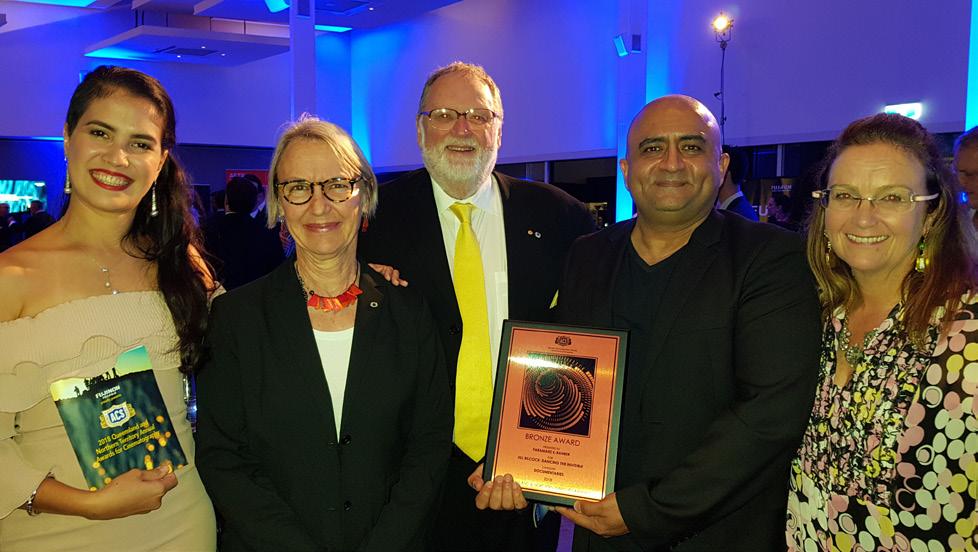
change as new technologies are adopted. We continue to refine our awards to ensure they remain the fairest and the best.
So the ACS awards calendar is undeniably a busy one, with five or six presentations events every year. This puts an enormous load onto our members who volunteer and stage the events, with technical support from specialist events teams. But it means we have a close connection with every aspect of the awards and absolutely own the events. This is an expression of the fundamental hands-on spirit that is at the heart of the ACS and we can be rightly proud of the work we do.
Erika Addis ACS ACS National President
We continue to refine our awards to ensure they remain the fairest and the best
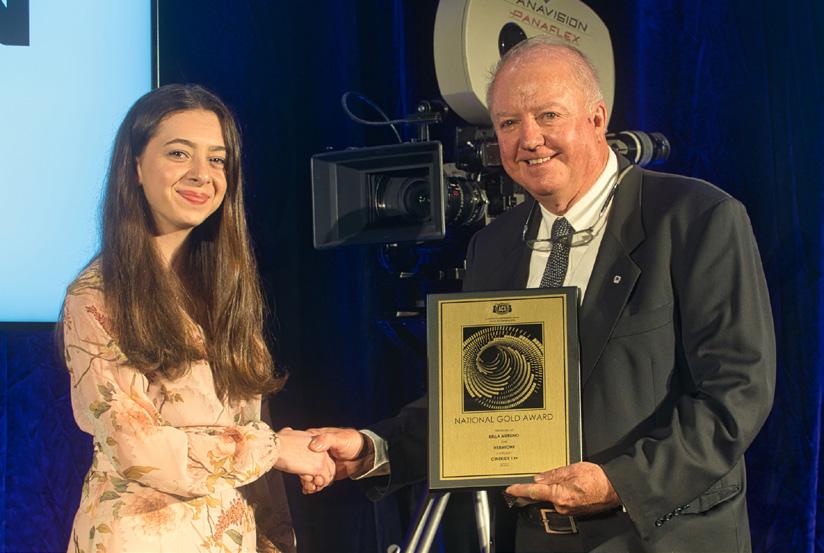
28 MARCH/APRIL 2024 CINEMATOGRAPHY WORLD
ERIKA ADDIS ACS•LETTER FROM AUSTRALIA
Photos: (below) – Russell Boyd AO ACS ASC & Mandy Walker AM ACS ASC at 2023 ACS National Awards in Sydney; Arun Ketsirat, Erika Addis ACS Ron Johanson ACS, Faramarz Keshawarz-Rahber and Pip Courtney at the 2018 ACS Queensland Awards in Brisbane; and Bella Merlino, winner of Cinekids Gold Award, with Peter James ACS ASC at 2021 ACS National Awards Canberra.
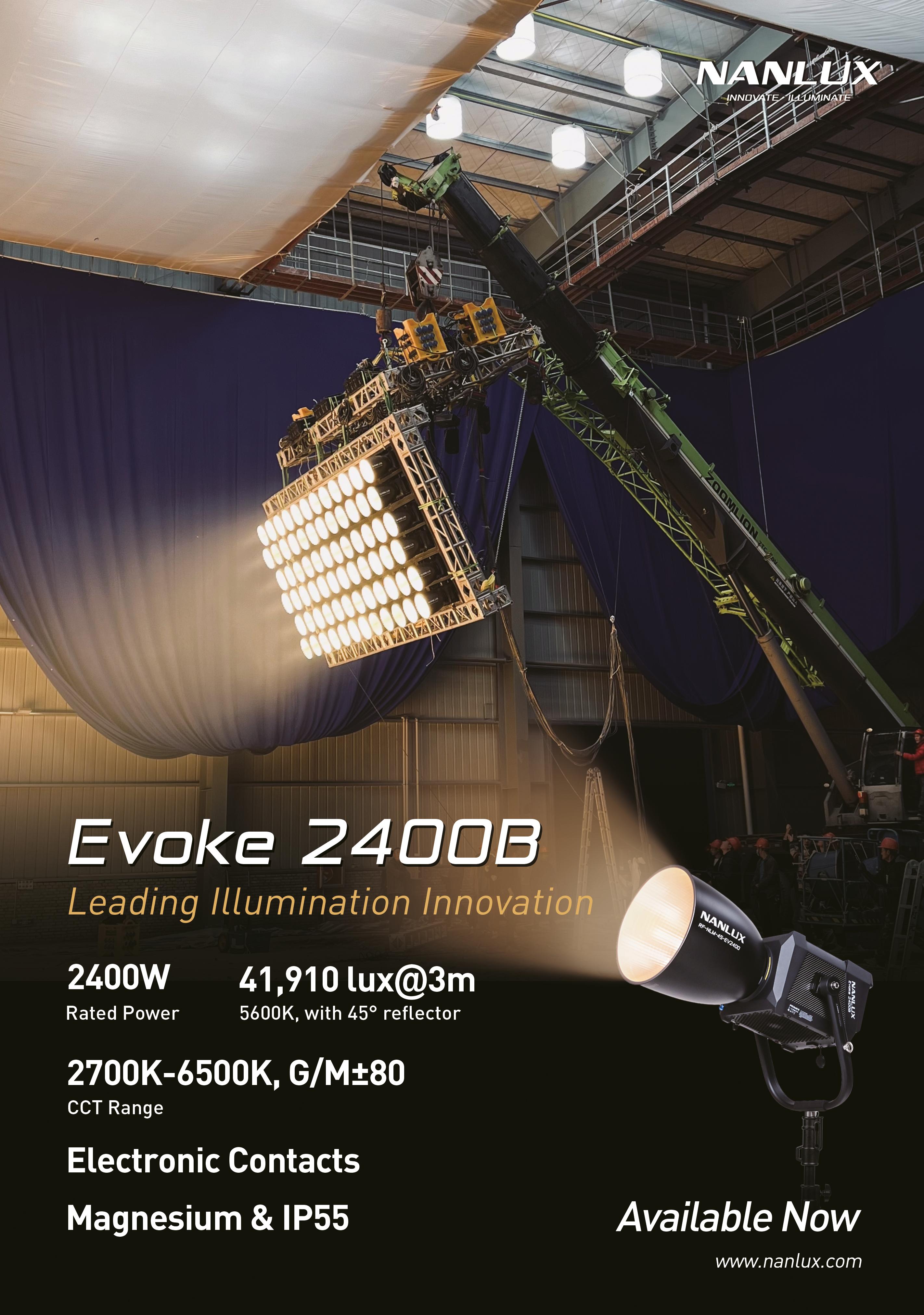
NEO WAVE
By Natasha Block Hicks

The Neo Film School in Kochi, Kerala has a concise yet comprehensive motto: ‘Confidence To Create’. This is expounded in its mission statement as ‘instilling the confidence to engage in creativity of the highest order through a professional and unique Neo culture’. Illuminating the school’s literature still further is the declaration that Neo is ‘The first integrated film school in India’.
“Neo’s uniqueness is in its integration of management towards art, aesthetics and entrepreneurship,” explains founder, chairman and course designer Dr. Jain Joseph, who is himself an alumnus of both the Film & Television Institute of India (FTII), Pune, and the Indian Institute Of Management (IIM), Ahmedabad.
“Film is a collaborative art,” he elaborates. “Our student – ‘Neos’ – learn to manage their creativity,

and the creativity of others, and how to deliver on time, which will make them successful in the industry.”
The school has a policy of appointing only industry
professionals as permanent and visiting tutors. Jain Joseph upholds this principal as an audio-visual designer and DP, who’s first film Neythukaran/The Weaver (2002, dir. Priyanandanan) was recognised at the National Film Awards. He was previously a consultant on the formation of several media schools in the state, before establishing Neo Film School in 2010.
The president of Neo’s governing council is Sibi Malayil – also the president of the Film Employees’ Federation Of Kerala (FEFKA) – a veteran filmmaker of some 40 titles and three National Film Awards, notably the 2003 Best Director Award for Veedu Appuvinteyum (2003, DP Venu ISC). Respected writer/director Leo Thaddeus, known for Panthrand (2022, DP Swaroop Shoba Shankar), is the school’s director.
Neo teaches filmmaking across 12 specialisations: film direction, cinematography, film editing, audio design/sound engineering, VFX/animation, stills photography, screen acting, dubbing (voice acting), colour grading/ correction, screenwriting, film production management, and branding/advertising production.
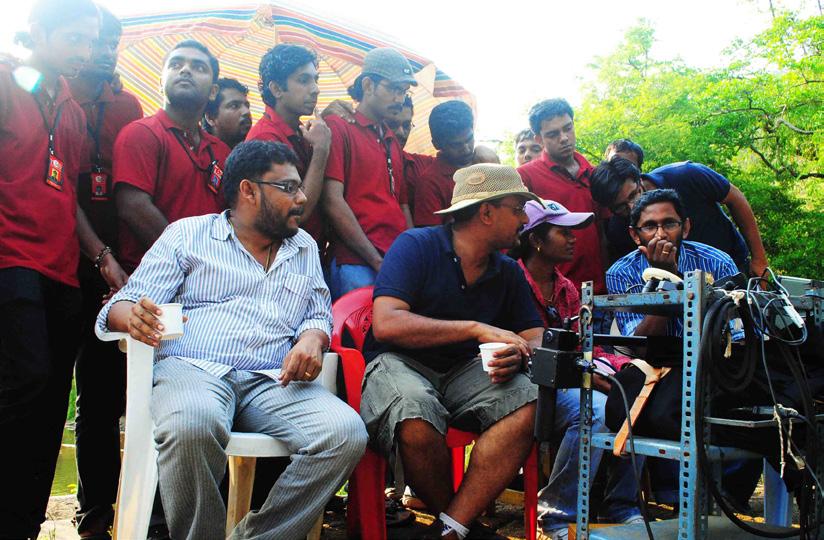

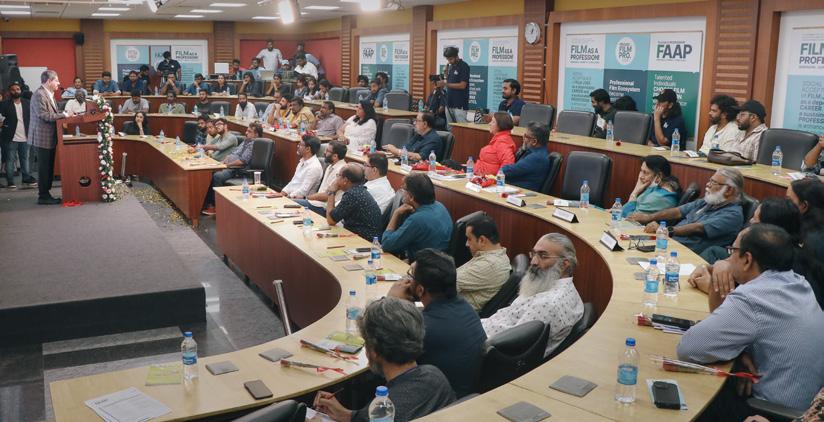
the finest talents of the world and contribute to global art’. Prospective students are not required to have a degree to apply to study at Neo, but as Jain Joseph explains, “we have a filtering programme”.
Our cinematography students are well-versed in production and direction
After an initial enquiry registration, applicants will have a telephone career counselling session and then opt for one of the school’s admission gateways: one or two-day orientation sessions and workshops, in-person, at the school. The final stage is a written examination and panel interview.
“We assess two major areas: the intellectual capacity and the conceptual aptitude of the student,” explains Jain Joseph.

Successful Neos will not only learn their craft, but also develop the wrap-around skills required to translate it into a career, thanks to the school’s ‘7-Dimensional Training Programme’, which adds cultivating aesthetical sense, the sharpening of managerial skills, discovering one’s individuality, increasing industry awareness, honing the capability to perform under pressure, and nurturing a passionate drive with devotion, to the core training in technical knowledge and skill.
“This is what makes our Neos sustainably successful in the film industry,” stresses Jain Joseph.
The school’s stated vision is to ‘discover and nurture
The cinematography department – which accepts 12 students in each of the bi-annual in-takes in January and July – offers two diplomas, starting with a 12-month Advanced Diploma, which culminates in a web series pilot. Students can then convert this into the
STUDENT UNION•NEO FILM SCHOOL, KERALA
30 MARCH/APRIL 2024 CINEMATOGRAPHY WORLD
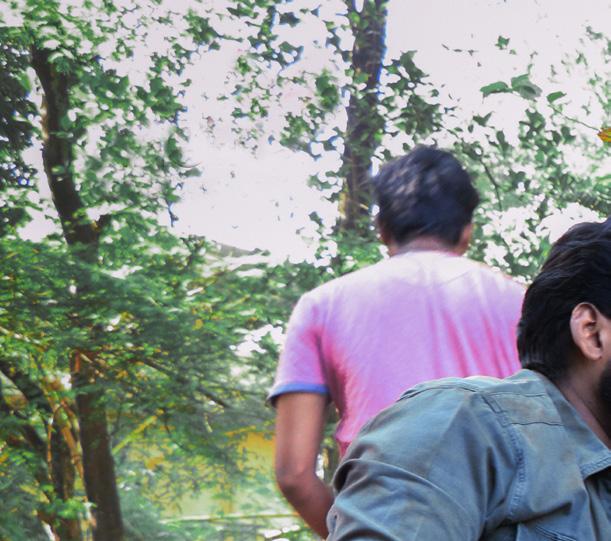

18-month Professional Diploma if they wish to continue for the additional semester, which qualifies them for a MESC (Media & Entertainment Skill Council) diploma certificate on top of the Neo Film School diploma certificate awarded to all courses.
Fees for the diplomas amount to roughly £2,150 per semester and around 80% of cinematography students decide to continue to the Professional Diploma, completing their studies with a commercial and a short film, screened at mainstream multiplexes as part of the passing-out graduation ceremony.
Teaching throughout is split between 30% theoretical studies and 70% practical exercises, with each module of learning accompanied by a filming project. For instance, the Non-Fiction module is naturally paired with a documentary exercise and the Advertising module with a commercial. The course commences with the Audio-Visual Design module, shooting a character portrait and music video.
“The major classification we give to our students is that you can look at film as an art and you can also look at film as a design,” details Jain Joseph, to explain the thinking behind the choice of the first module.
“We promote design thinking. It’s not just selfexpression, it’s also expressing for others: the target audience.”
To support Neos in their studies, the film school
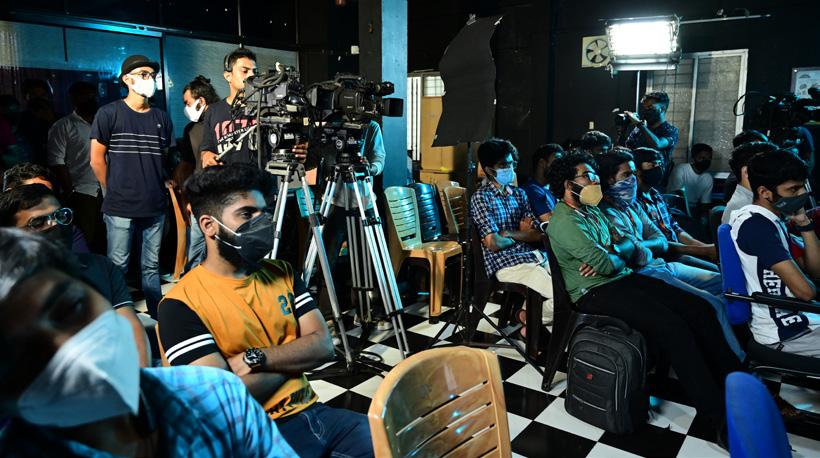
offers access to industry-standard cameras such as Red Helium, Sony FX6 and ARRI Alexa Mini as well as Steadicam, dolly, tracks and cranes. The school has partnerships with Sony and the Canon Imaging Academy, who loan the latest equipment for Professional Diploma thesis projects.
There are four production stages at Neo, the biggest of which is known as the Sky Studio, boasting the capability for students to utilise both natural and artificial light for their projects. A second studio is equipped with chromakey capability and a lighting grid, a third is dedicated to interior sets, and the smallest is reserved for stills photography.
Facilities include a multi-station editing suite with Final Cut Pro 10, a DI suite running DaVinci Resolve, a 24-station VFX lab running Adobe After Effects, Nuke and Maya, a 100-seat amphitheatre-style lecture hall and an 80-seater hybrid auditorium/preview theatre with a 4K projector and 5.1 Dolby Surround Sound.
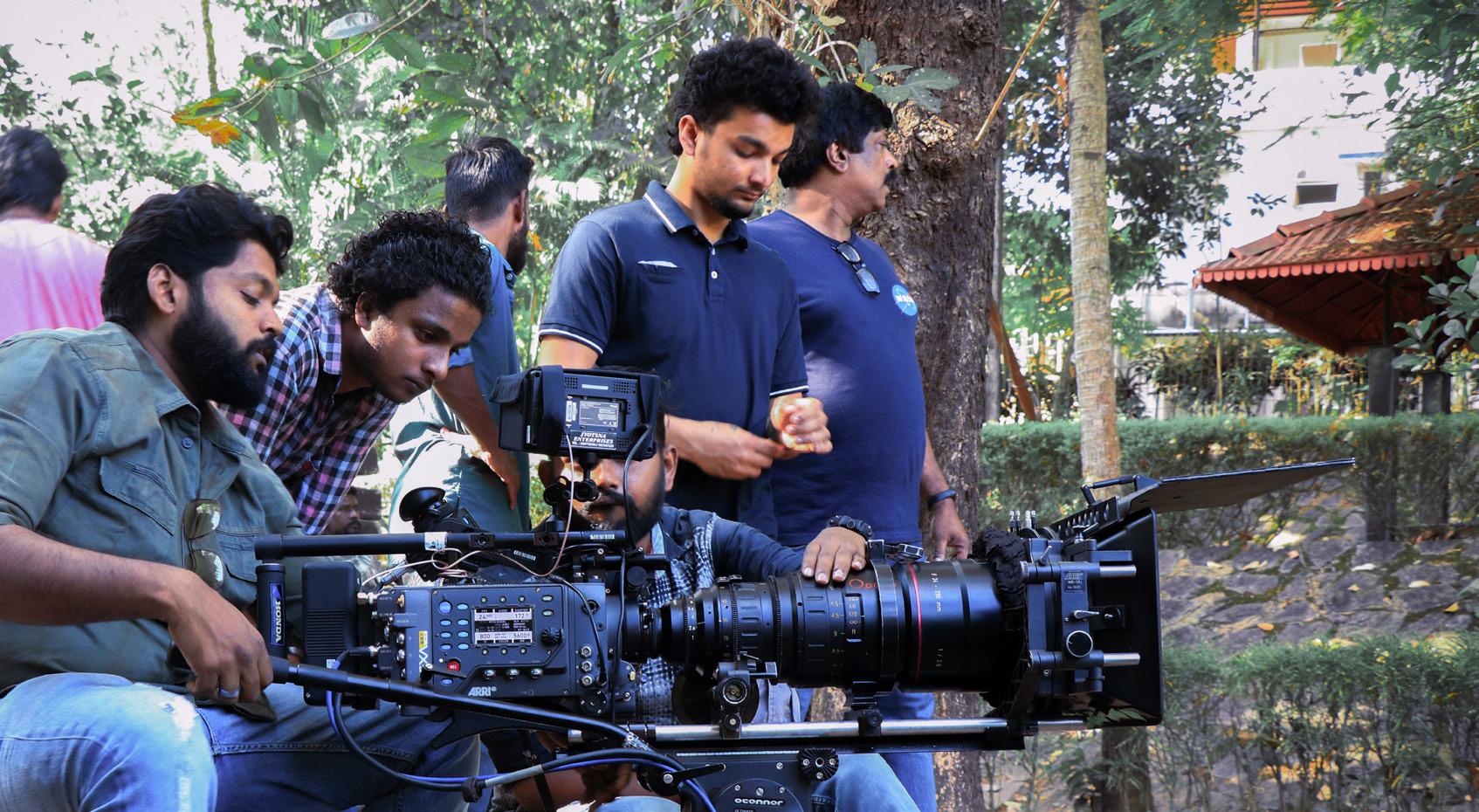
Film is a collaborative art
There is also a 15-seat screening room-cum-minitheatre, alomg with various sound recording studios and audio labs, plus a print and digital library with study space.
The cinematography department is headed up by Neo’s Dean, Professor Soman K G, a former HoD at FTII (1989-2014). Also making up the lead faculty staff are Cannes-nominated writer/director and DP Sajan Kalathil, recognised at the prestigious festival for Balloons (2023), and Prakash Velayudhan, a working DP whose recent projects include Vivekanandan Viralaanu (2024).
Visiting tutors include Neo alumni Amith Raj K B, second unit DP on Kannur Squad (2023, DP Muhammed Rahil) and Prayag Mukundan, who lensed Emergency Exit/Thurthu Nirgamana (2022). Writer/director and DP Sabu James, the auteur behind Oruvattam Koodi/Once Again (2023) also attends Neo as a visiting cinematography tutor.
Students across all specialisations are invited to

attend Neo’s various events and seminars, like ‘Coffee With A Passionate Pro’, when they get the chance to pick the brains of an industry professional, such as Neil D Cunha, cinematographer on 2023 National Film Award-winning movie #Home (2021), and ‘Crew Stories’, where crew members share their experiences of working in professional productions.
Many eminent filmmakers impart their wisdom at Neo as guest speakers, including writer, director, editor and DP Mahesh Narayanan, a recipient of three Kerala State Film Awards including the 2023 Best Director Award for Ariyippu/Declaration (2022, DP Sanu John Varughese ISC). Of particular interest to the cinematography cohort has been the attendance of Santosh Thundiyil, DP of Kuch Kuch Hota Hai (1998), ranked recently by IndieWire’s as the world’s mostpopular rom-com on Netflix.
By networking with the flow of professionals, including alumni, that pass through the school, and by

accessing on-the-job training opportunities, plus Neo Incube, the in-house production company which acts as an incubator, Neos are able to develop industry connections while still students at the school.
Graduates DPs like Anurudh Aneesh, who lensed Aattam/The Play (2023), winner of the Grand Jury Award at the 2023 Indian Film Festival Of Los Angeles, along with Aswaghoshan, Stigin Starview, Vidyasagar, Mathew Prasad, Gikku Peter, PM Unnikrishanan and Jayarami Reddi, are a few of the Neo camera operators and cinematographers who are currently busy in the Malayalam and Telegu film industry.
At the time of writing, Jain Joseph was celebrating the news that Riyas Shereef, a former cinematography student, had just released the mainstream movie Thundu (2024, DP Jimshi Khalid) as a debut director, with another Neo, Nabu Usman, editing.
“Our cinematography students are well-versed in production and direction,” he extols.
Neo Film School itself has been celebrated with a Kerala State Consumer Award, and has also won a Primetime Global Educational Award for the Most Promising Film School in South India, plus an Indywood Educational Award for Best Film School in Kerala.
As of January 2024, the school completed a year of hosting the Film As A Profession (FAAP) project, which, through seminars, committees, conferences and training programmes aims to raise the profile of cinema as a viable and respectable career option in Indian society, along with promoting equal opportunities and fostering talent and innovation within the sector.
“Cinema is moving to a global perspective,” commented Sibi Malayil to the New Indian Express at its launch. ‘We at FAAP aim to raise Malayalam cinema to the global level.”
Jain Joseph’s outlook for the school is also widereaching, with plans to reinstate the two-year diploma that existed pre-Covid – with a focus on the AVGC sector – and European exchanges in discussion.
“Neo has a 15-year evolved curriculum,” he explains, “we are sturdy now, and confident.”
CINEMATOGRAPHY WORLD MARCH/APRIL 2024 31 NEO FILM SCHOOL, KERALA•STUDENT UNION
WONDERSTUFF
By Tiffany Pritchard

WThe gifted writer/director, and uniquely also a cinematographer, relied on his own personal experience as a mischievous youth who was sent to a remote boarding school run by Spanish monks to bring the film’s nuances to life. The immense, quiet landscapes of Western Australia’s Alice Springs are one part of this, as are the understated performances of the largely unknown Aboriginal cast, in particular firsttime actor and lead, Aswan Reid, whose wonder and instincts go head-to-head with the worldview of Sister Eileen, a renegade nun, played by Cate Blanchett.
The writer and director in me are both there to serve the cinematographer
Following-on from the film’s Un Certain Regard premiere at the 2023 Cannes Film Festival, Thornton’s majestic picture was awarded with the 2023 Camerimage prestigious Golden Frog and the ASC’s 2024 Spotlight Award. His distinctive storytelling, as both director and cinematographer, was first noted with his debut narrative feature Samson & Delilah (2009), which won the 2009 Golden Camera award
in Cannes. Acclaim continued with his 2017 drama Sweet Country, which he also directed and shot, starring Hamilton Morris, Bryan Brown and Sam Neill, that was awarded Venice’s Special Jury Prize and Toronto Film Festival’s Platform Prize.
Most recently, the Australian filmmaker’s six-part docu-series The Beach (2020, DP Dylan River), launched with A24 and starring Thornton himself on an existential journey in an isolated beach shack, has further cemented his status as one of the most inimitable directors working today.
Thornton is humble about his many accolades, claiming he’s not a complex visual artist. He cites an early version of the American Cinematographer - Hand Book & Reference Guide, “when they still contained ads for Bolex and Mitchell cameras” as his creative foundation. “That book has got all you need to know to make movies. Whether you are using this size sensor or that size sensor is not fundamental. The most important thing to me is to be free and wild with technology,” he says.
Television & Radio School in Sydney. On The New Boy, he worked closely with long-term collaborators producer Kath Shelper and camera operator Jules Wurm, who started working with Thornton as a 1st AC, to maintain the film’s striking –almost epic, yet “de-cluttered approach”.
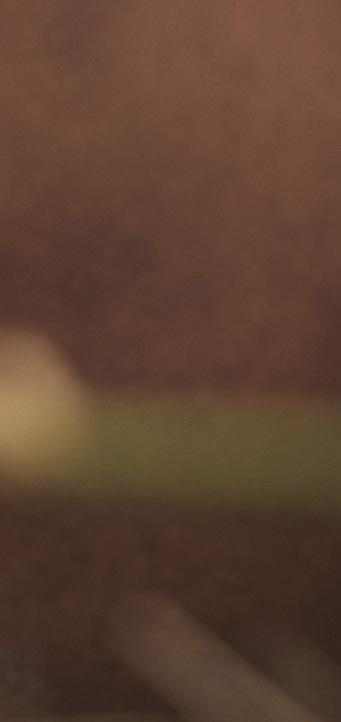
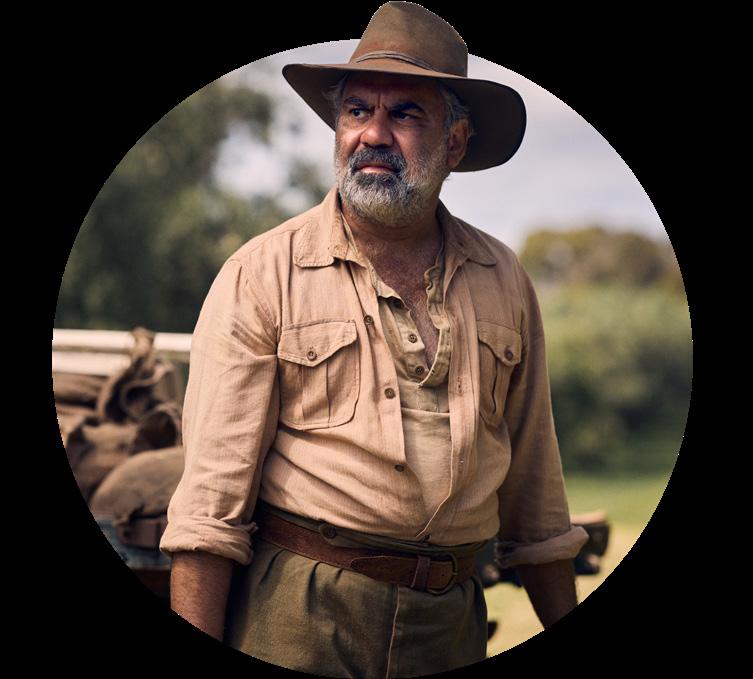
This free and wild approach actually lends itself to a scaled-back style, with the aim of giving his crew opportunities to learn and grow, just as he was given while studying cinematography at the Australian Film,
Thornton says the look of The New Boy was first envisioned whilst writing the script 18 years ago, explaining that he sees the writer and director in himself as being slaves to his cinematographer side.
“I write films I want to make and I write films I want to watch. I direct films that I want to direct and I direct films that I want to watch, but both of those humans in me are there to serve the cinematographer.”
Unlike in most directorcinematographer relationships, Thornton the director doesn’t have to hand the script to Thornton the cinematographer, who’s then tasked with translating the script into images. By the time his script is complete, he has a good idea how he would like to shoot it, making for a looser, less-controlled environment on-set.
“I am not dictating to the focus puller I want shallow focus here or there. That already happened when I wrote the script,” says Thornton, who makes pre-production planning as a cinematographer the priority, rather than storyboards and shot lists, adding
THE NEW BOY•WARWICK THORNTON ACS
32 MARCH/APRIL 2024 CINEMATOGRAPHY WORLD
arwick Thornton ACS’s arresting and multi-award-winning story, The New Boy, about a nine-year-old Aboriginal boy who is sent off to a Christian orphanage, is a visual spectacle, playing on spirituality and life’s delicate dance of survival.

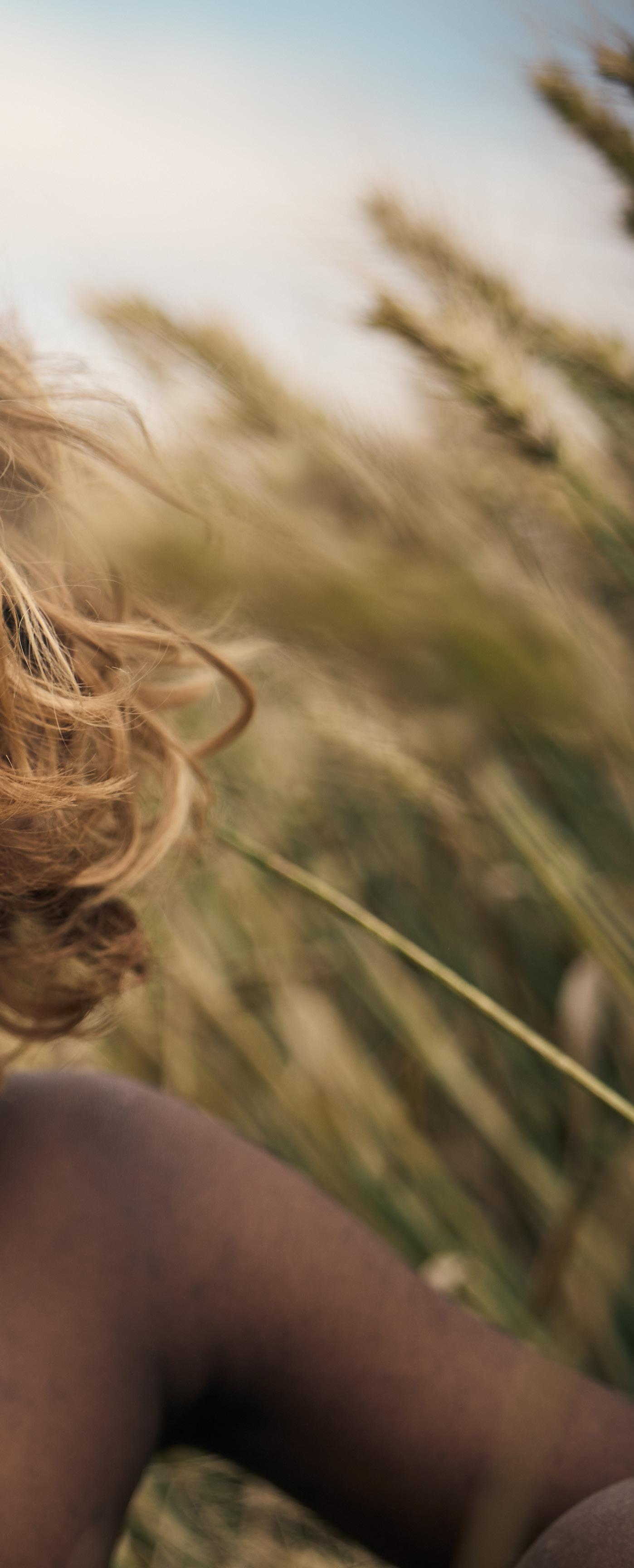

that flexibility on-set allows for spontaneity such as actor’s inputs or unpredictable weather.
To capture the immeasurable landscapes of South Australia, outside the hillside town of Burra, along with the delicate emotions of the characters, Thornton decided on one camera, one ISO shooting stop and one LUT.
“Every time I walk away from a scene that I’ve done with two to three cameras, I walk away thinking, ‘There must be something I can use’, which is the wrong way to make cinema. You don’t focus properly.”
His camera of choice for The New Boy was the Panavision Millennium DXL2, with its 8K Red Monstro sensor, and he maintained the camera’s native ISO of 1600 throughout production. As for the LUT, Thornton used one created by his son, Dylan River, also a DP, who most recently filmed The Beach for Thornton. River developed a LUT for the film he shot, A Sunburnt Christmas (2020, dir. Christiaan Van Vuuren), that is based around an outback farm ravaged by drought.
WARWICK THORNTON ACS•THE NEW BOY

His father has been using that same LUT ever since, stating it’s his digital Kodak 5245 50D stock, and that is all he needs.
When it came to optics, Thornton originally wanted to shoot with only one lens – either of his go-to 80mm or 100mm focal lengths, which he ascertains he is not picky about, and which more-easily allow for camera movement and composition adjustment. However, he quickly realised this would not be feasible, particularly for capturing the close-ups of actors such as Cate Blanchett and shots of the boy’s miraculous healing
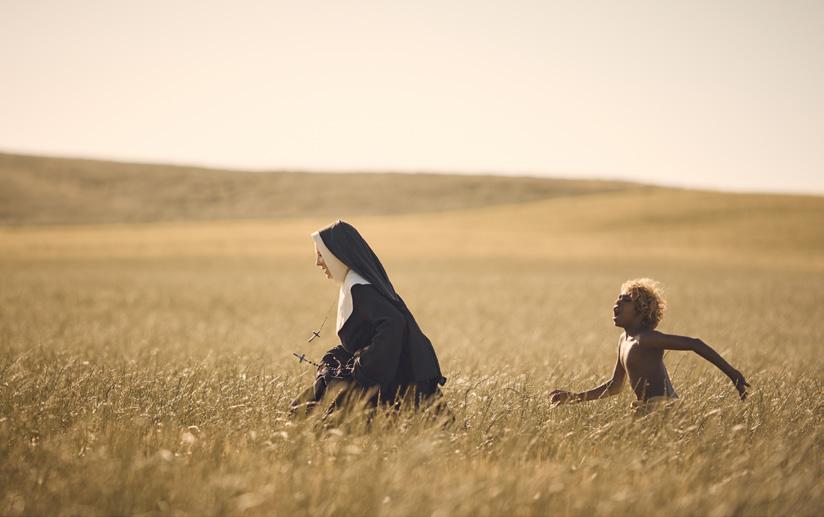
powers, which are manifested by a glowing orb of light transmitted from his fingers, created using a handoperated peanut bulb on a rod, enhanced by lens flares.
So, when he couldn’t source an 80mm Macro, Thornton instead opted for a rarely-used 200mm Macro Anamorphic Prime from Panavision, and supplemented his lenses choices with glass from Panavision’s E-series and C-series Anamorphic primes.
Thornton compares the “beauty and kooky personalities” of the Anamorphics to people who, at certain iris stops, get really angry or really happy. “You have to work out when they get pissed-off and comes through a lot of testing,” adds Thornton, who relied on the assistance of the team at Panavision Sydney.
Often likened to Terrence Malick for the gentle yet lush visuals that imbue his work, Thornton, who refers to himself as a “tree hugger”, placed a focus on his own
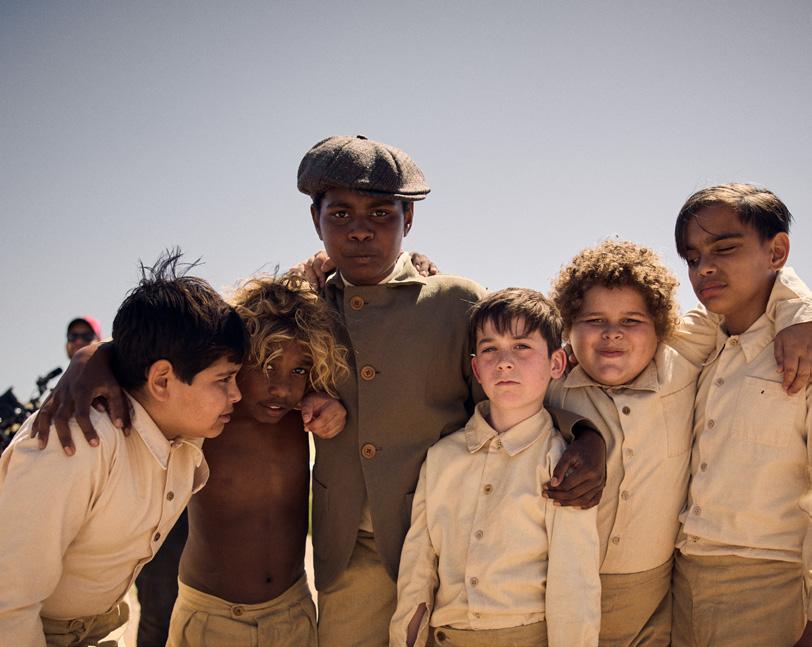
Aboriginal background and relationship with nature to carefully craft the film’s many understated moments that often have little dialogue. As an example, Reid’s character is depicted slowly walking amid swaying wheat fields, indicating his changing character and the conflict between his soul and the strange environment. Being a fan of landscapes and depth-of-field to evoke emotion, Thornton explains that he utilised the widescreen 2.35:1 ratio along with longer lenses and ND filters to capture the actor’s contemplation and to “keep the landscape with him.”
To create the orphanage scenes, Thornton gives praise to the producers who gave him everything he wanted, including a 1940s-era mission, complete with living quarters and a church, all built from scratch by production designer Amy Baker.
“Amy did an amazing job,” says Thornton. “It looked so good that I started to feel like, ‘There’s a better shot over here. Wait, there’s a better shot over there!’”
He adds they typically shot exterior scenes in the mornings and interiors at lunch-time, a decision that was beneficial for the less-experienced Reid.
“The ability to do film the exteriors and the straightaway shoot the interior scenes with the same emotion and energy was important,” says Thornton, who adds the shooting schedule was close to the chronological
The most important thing to me is to be free and wild with technology
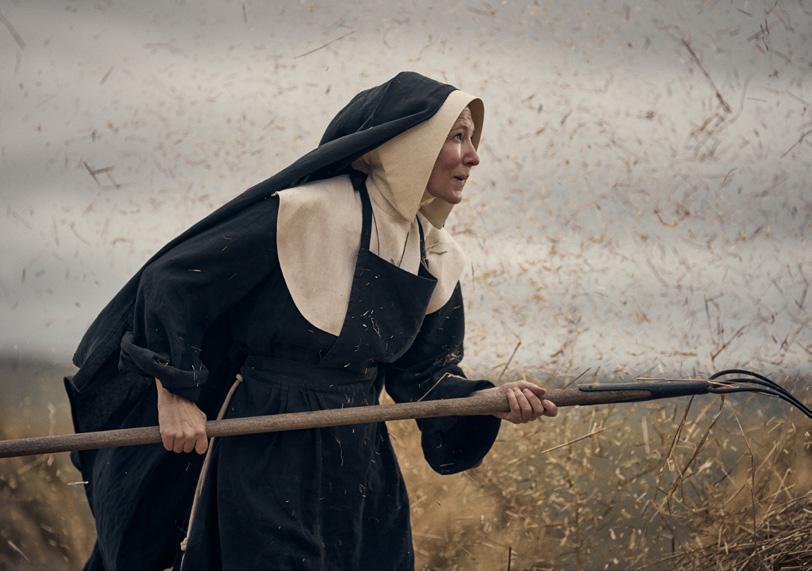
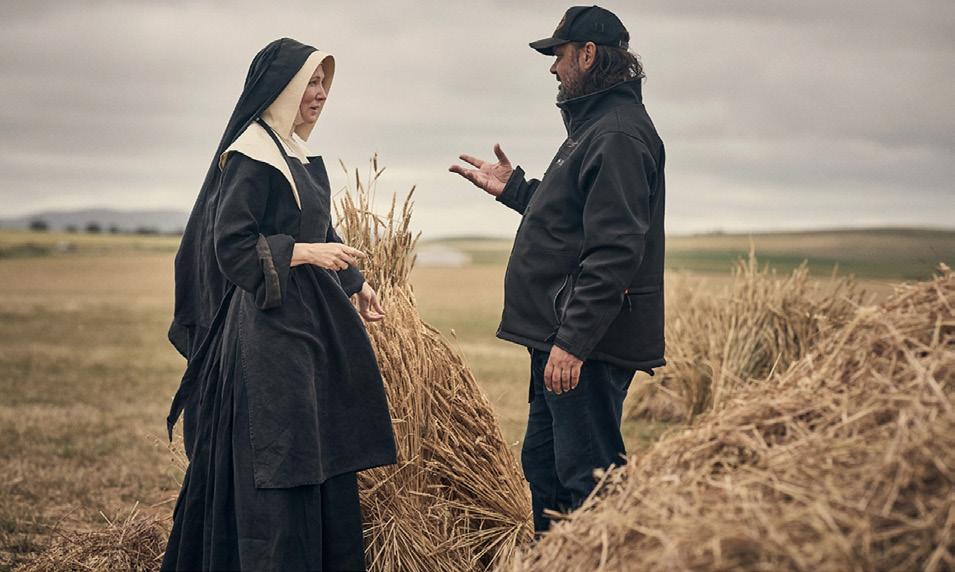 Photos: Warwick Thornton ACS sporting a straw kat.
All photos © Ben King.
Photos: Warwick Thornton ACS sporting a straw kat.
All photos © Ben King.
CINEMATOGRAPHY WORLD MARCH/APRIL 2024 33
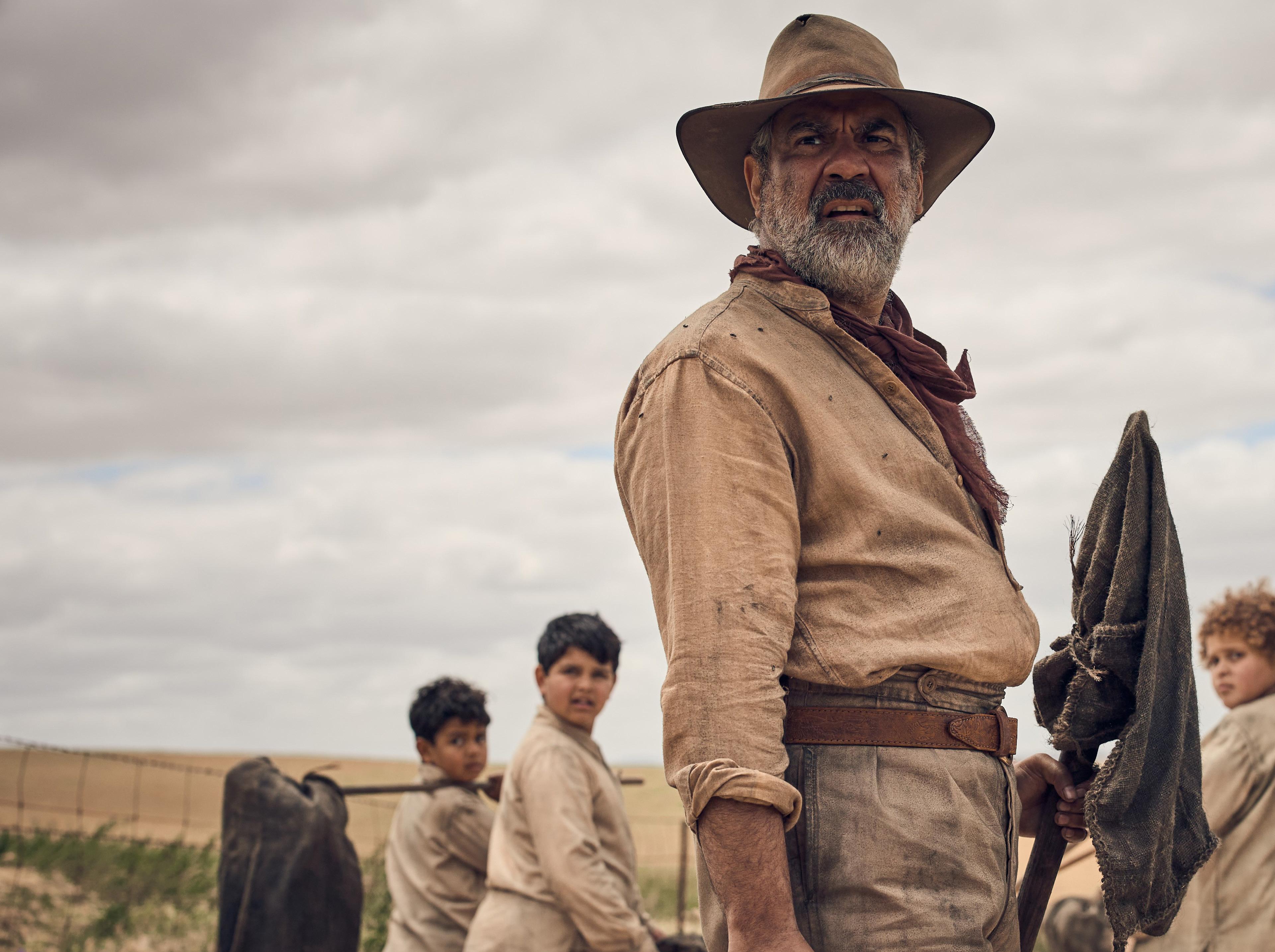
arc of the script so that production could move forward methodically.
For the day interiors, filming often took place around noon with an 18K outside the mission’s large windows to help rebalance the interior and exterior light. For night interiors, Thornton strove for stark naturalism, in line with a 1940s noir setting, with scenes often illuminated by an on-screen bare bulb. Placing the actors in the right spot was crucial, as was rigging the light so that it could be easily lifted and lowered for frame adjustments. Thornton inserts that was aim is to find the look where manufactured light was not easily detected.
The director/DP is also specific about camera movement, adding in his view it’s generally only necessary when following an actor from A-to-B. However, in the film’s powerful opening scene in a stark desert landscape, showing Reid battling a police officer and getting choked to near unconsciousness, Thornton decided to include a slider. While sliders are not something he likes using, as the camera operator is often responsible for both the tracking and operating, he admits their use adds energy. Citing that “I thankfully had my shit together”, the crew pulledoff this intricate scene, involving slow motion and meticulous stunts, in less than three hours.
first frame, the audience are asking, ‘Where are we? Who are we? What era is this?’ You can use that to your advantage as a storyteller.”
Casting was essential to the film’s story, where
sitting inside some hall, somewhere, reviewing the script line-by-line. And whilst he says the boys were like a “pack of puppies running amok”, he also noted the rawness they brought to the set.

Christianity goes head-to-head with questioning of religion. Together with casting director Anousha Zarkesh, Thornton looked over hundreds of tapes and auditions to find actors to play the monastery’s young students. Reid was discovered at the start of the process. The remainder of the cast were found across parts of South Australia, all mostly fresh faces who had not previously acted.
As a filmmaker, he adds it’s important to establish the sense of place at the opening of the film. “From the
Thornton adheres to a no-rehearsal policy, believing in discussions about the character rather than
“They scared the shit out of me every day, yet they empowered me and made this beautiful story come alive,” he recalls.
When it came to working with Cate Blanchett, he says he was awe-inspired, and learnt from her different approach to the filmmaking process. Whilst Thornton prefers to rely on his instincts instead of a monitor, he says Blanchett preferred to look at her performance on playback.
“She would say something like, ‘I can see there is something there. Can we do another take?’. I gave her more control of the shoot than I necessarily would,” says Thornton, who adds he is normally a three-take director. “If we’re not getting it after several takes, I’ll try and move the camera before I talk to the actor.”
Overall, the production shot for 32 days across five-day weeks, allowing the crew to have Saturdays and Sundays off, something that is important to Thornton.
When asked about the film’s success, he attributes part of that to Blanchett, as a working partner/ producer, and her husband and producer Andrew Upton, who were instrumental in getting the film offthe-ground. After a chance meeting at the Berlin
THE NEW BOY•WARWICK THORNTON ACS 34 MARCH/APRIL 2024 CINEMATOGRAPHY WORLD


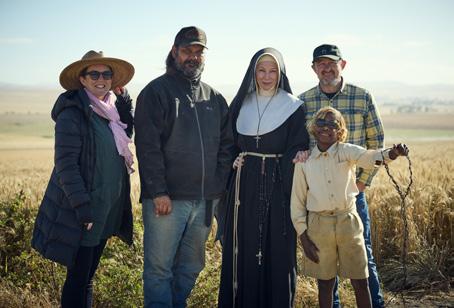

International Film Festival in 2020, Blanchett and Thornton started Zoom conversations with lockdown then in full swing. Although the 18-year-old script had several funding knockbacks, Blanchett’s decision to take the key role as the monastery’s head nun – a part that was initially written as a Benedictine monk – proved fundamental in the films funding, as did the involvement
I am a tree-hugger
of Blanchett and Upton’s production company Dirty Films, and partner Scarlett Pictures. Together they were able to secure financing with Screen Australia, First Nations Department and the South Australian Film Commission, with post-production taking place in New South Wales.
Whilst The New Boy continues its European roll-out, Thornton is currently working on three scripts ranging from $50M to $1M.
“It’s all about opportunity, so when the right door opens you’re ready,” he says. When it comes to technology, he is eagerly awaiting a sensor that can shoot in different spectrums. Rather than rotoscoping a film, which costs a lot of money, a rotoscoping facility would be built into the sensor allowing for different stocks – from ultraviolet to B&W.
“Working in different colour spectrums is beyond what we can do today,” he explains, adding that you could also change grain structures for different parts of the image, such as the sky, in real-time. “Now that would be rock-and-roll!”

CINEMATOGRAPHY WORLD MARCH/APRIL 2024 35 WARWICK THORNTON ACS•THE NEW BOY
RIDE ON WILD SIDE
By Ian Blair

Australian cinematographer Ari Wegner ACS ACS earned an Academy Award nomination for her powerful and lyrical work on Jane Campion’s intense psychological drama, The Power Of The Dog (2021), becoming only the second woman to do so in the award’s 94-year history.
Her latest film, Drive-Away Dolls, couldn’t be more different. Directed by Oscar-winner Ethan Coen – whose credits with brother Joel include such classics as No Country For Old Men, The Big Lebowski and Fargo – and co-written with his wife, Tricia Cooke ( Jerry Lee Lewis: Trouble in Mind), Drive-Away Dolls is an outrageous no-holdsbarred, black comedy, whose original title, DriveAway Dykes, sums it all up perfectly.
It tells the story of Jamie (Margaret Qualley), an uninhibited free spirit bemoaning yet another break-up with a girlfriend, and her uptight demure friend Marian (Geraldine Viswanathan), who embark on an impromptu road trip from Pittsburgh, Pennsylvania, to Tallahassee, Florida. Also along for the ride, as the pair hit lesbian bars, favorite BBQ joints and weird roadside attractions, is the film’s uber-Coen-esque MacGuffin. Unbeknownst to them, hidden in their rental car, is a silver suitcase containing a severed head and a collection of dildos. Hot on their trail are a pair of vicious but inept criminals tasked by a family-values Senator to recover those dubious items, which could reveal a scandalous secret and derail his political career.
In terms of prepping the film, Wegner, whose credits also include Lady Macbeth (2016) and Zola (2020), reports that when she arrived in Pittsburgh where the whole film was shot, “Ethan and The Coen Brother’s longtime storyboard artist, J. Todd Anderson, had already storyboarded every shot of the film back when the script was first written, so all that was really locked-in.
“For me, that was fantastic as it gave me real insight into exactly how Ethan already pictured the movie. So, when we began scouting, having the boards was a huge benefit in mapping-out all the shots and how we’d do them. Also, Ethan, Tricia and I shared an office during prep, so we were all together for all the discussions with the production designer, costume designer and so on.”
It was a bit surreal to work with someone whose work you’re such a fan of
Finding the right look for what Wegner describes as “a very colourful film” was another key element of prep.
“It’s set around the 1999/2000 turnover, when pop culture was very garishly colourful, so we leaned pretty heavily into that, particularly in the lighting, clothes and overall production design. We definitely weren’t afraid of using bold colours.”
To capture all of that, Wegner decided to shoot with the then-new ARRI Alexa 35 with ARRI Zeiss Ultra Primes.
DRIVE-AWAY DOLLS•ARI WEGNER ACS ASC
36 MARCH/APRIL 2024 CINEMATOGRAPHY WORLD
We weren’t afraid of using bold colours

“I tested a beta version of the camera and was really impressed with its low-light capabilities,” she explains. “Having the chance to shoot 4K without having to go to large format lenses to do it was great. And, one of the in-built textures I particularly liked was the dark one called ‘Shadows’, as it allows the noise to be less colourful. So all that made the Alexa 35 perfect for this project.”
When it came to the choice of lenses, Wegner stresses that, “Ethan was far more concerned about lens length, size and proximity to the actors, than going with a particular manufacturer, and he’s definitely a wide-angle, close-up leaning director. That’s his style and natural taste, and he wanted to go as far as we could in that direction, to really amp-up the comedy.
“So I was looking for a set of lenses that gave me a lot of options in the wide end. We tested quite a few before I decided to go with the ARRI Zeiss Ultra Primes as they had a wide range of wides, in good increments between lenses, and the least amount of wacky distortion.”
To further enhance the comedy, the filmmakers also used zooms and crash zooms, including an Angénieux Optimo Ultra 12x 24-290mm and a Fujifilm/Fujinon Premiere Cabrio 19-90mm.
“We also used the Innovision Probe II Plus, a special probe lens for when we needed to get a wide-angle lens in a very low, awkward position, shooting almost on the floor,” she explains.
Wegner worked closely on the look with colourist Peter Doyle, a regular Coen Brothers
collaborator.
“Peter knows their taste, I knew his work, and had wanted to work with him for quite a while,” she notes. “Although I didn’t know it when we began, Peter was one of the few people who’d already had quite a bit of experience with the Alexa 35, helping out with ARRI’s development and testing process, and all that made him the perfect person for this film.
“We started on a LUT for the film during prep. I wouldn’t call it a strong look, it was actually pretty subtle. The Alexa 35 was perfect for the production, as its strength lies in improved colour, so there was high saturation with the wardrobe and all the vegetation.
“It was great to work with Peter, who’s a real expert on this new technology. Later, during the final grade, we worked on the texture of the image, doing softening and sharpening, and also adding a tiny bit of grain – but so little that it’s not really noticeable.”
Drive-Away Dolls was filmed in Pittsburgh and surrounding Pennsylvania townships for approximately 35 days in late 2022.
“We used some very creative location scouting to create the road trip and places that would double as Tallahassee,” says Wegner. “The only scenes not shot on-location were all the car interiors which we did on stage in Pittsburgh at 3 Rivers Studios.”
Because of the shoot’s timing, some sequences that needed winter backdrops were ultimately shot
Images: Ethan Coen’s Drive-Away Dolls , a Focus Features release. Credit – Wilson Webb / Working Title / Focus Features. ARI WEGNER ACS ASC•DRIVE-AWAY DOLLS
CINEMATOGRAPHY WORLD MARCH/APRIL 2024 37
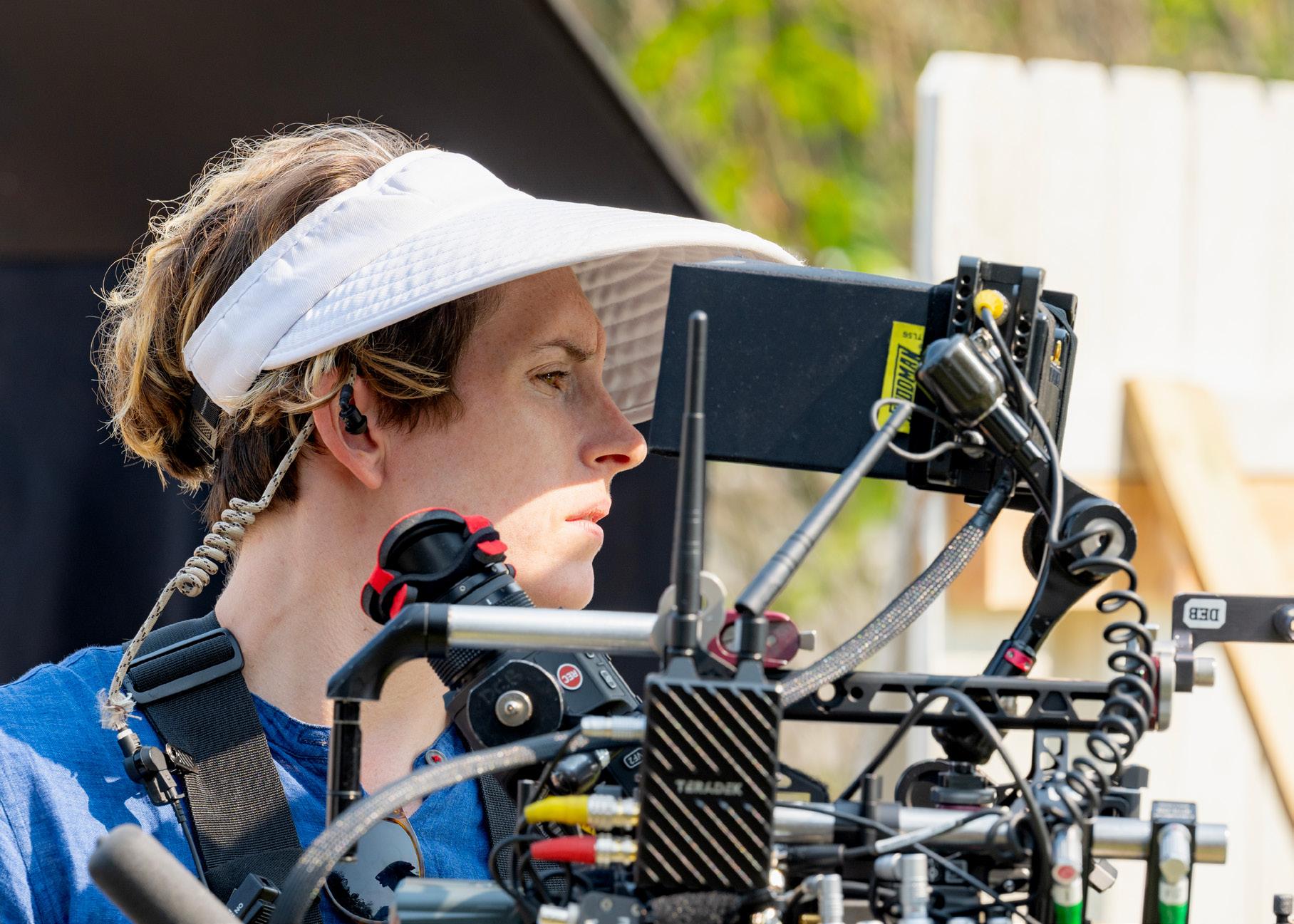
by a second unit early in 2023 when there was enough snow on the ground.
“We actually did the car work without knowing exactly what the backgrounds would look like, which was a bit nerve-wracking,” she admits. “But we had a great VFX supervisor, Michael Huber, who’s worked a lot with Ethan and is very collaborative. Another key team member was our gaffer Bill O’Leary, who’s also worked a lot with The Coens, so it was great to have such an experienced team for the car scenes, and I was really happy with the results.”
Despite dozens of locations and a tight schedule, Wegner says the shoot was “a lot of fun and it went very smoothly. Ethan and Tricia like ten-hour days, which is great for the crew – which included our key grip Keith Seymour and my 1st AC Deb Peterson. The plan was always to work as fast as possible with lighting set-ups and so on, and allow Ethan and Tricia enough time to really work with the actors and focus on their performances, which was always the priority.”
Wegner’s lighting package consisted of ARRIMAX HMIs (M90s, M40s, M18s), Astera Tubes, ARRI SkyPanels (S60s, S30s), JoLeko and Source Four LEDs, and Creamsource Vortex8s.
“For the She Shed club scenes at the end of the film, where Matt Damon’s character comes to collect his goods, we wanted to have this explosion of rainbow colours,” Wegner reports. “So Bill, my gaffer, and I came up with the idea of actually making a custom ‘rainbow light’ which was very mobile and useful in giving us this rainbow effect, as it gave us all the colours in just one unit.”
Wegner and DIT Curtis Abbott worked closely
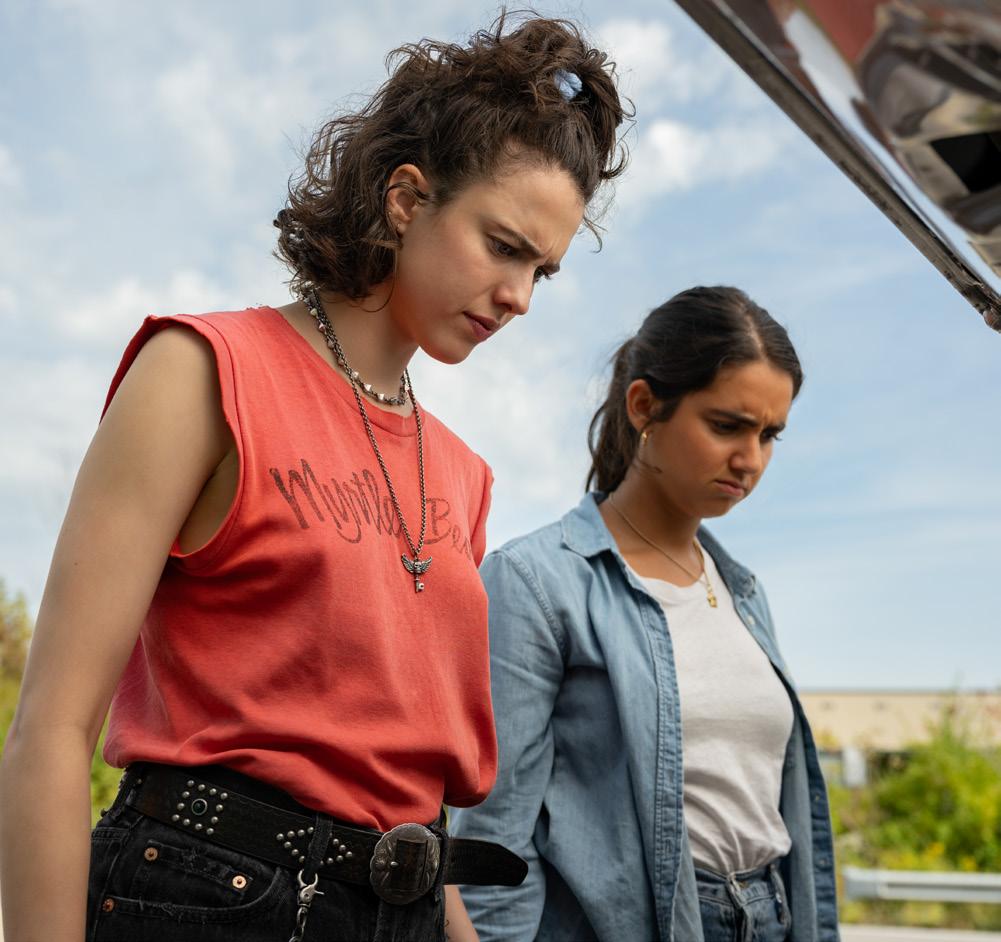
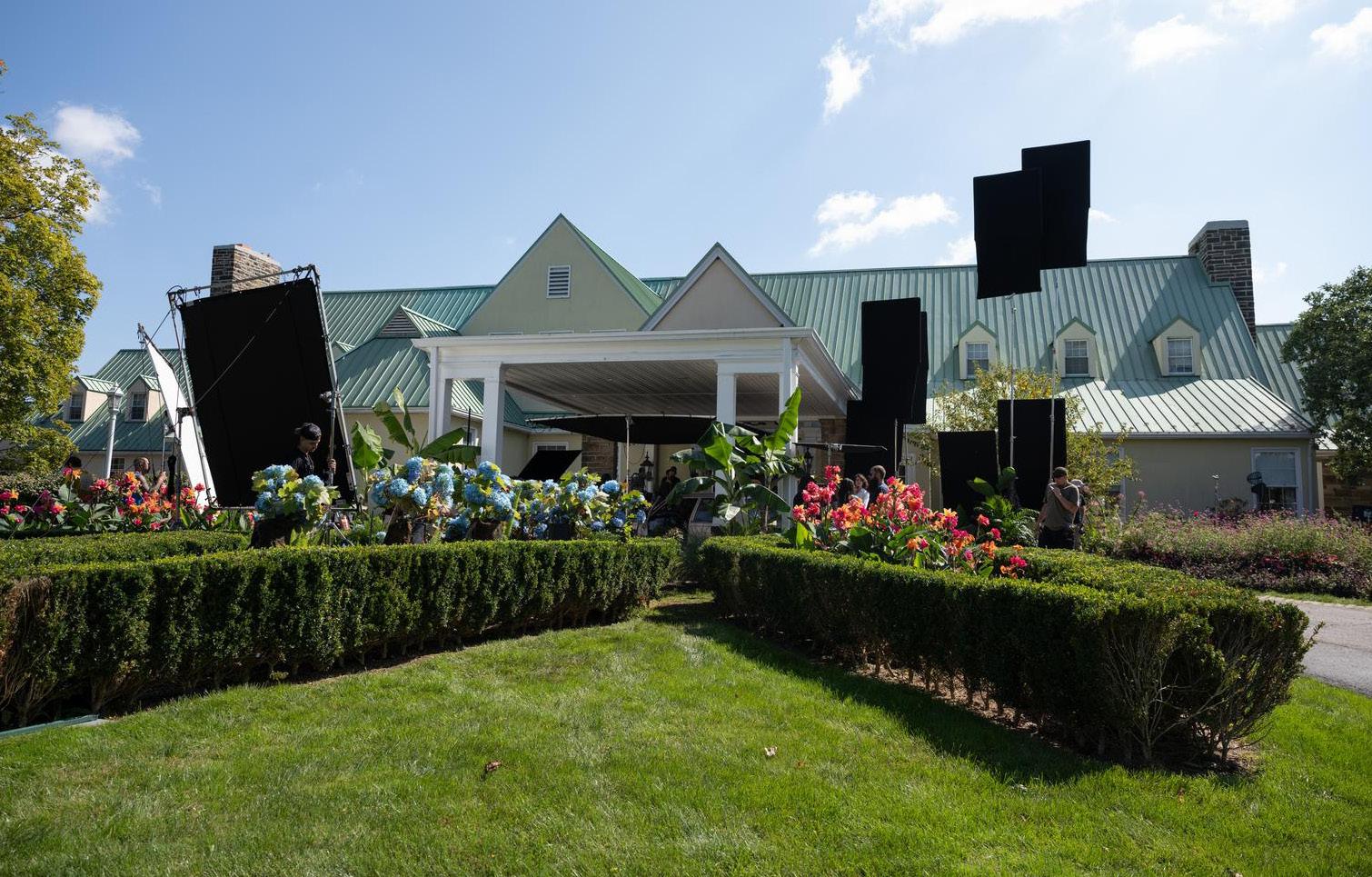




together on-set, “as dealing with the new sensor on the Alexa 35 camera was a bit nerve-wracking and everything I’d shot digitally for the past 15 years before this had been with the old sensor,” she reports.
“I know that older sensor so well and could rely on it as being a constant and a very reliable workhorse. The new sensor is really quite different in terms of the colour science and the curve, so I relied heavily on Curtis to help recalibrate my instincts, which had been quite ingrained after all those years with the old sensor, and for his help in matching shots and angles.”
The grade was done at PostWorks, New York. “I flew there so Peter Doyle and I could be in the same room, which is always a big advantage,” Wegner notes. “We spent about two weeks grading, which sounds like a lot of time, but it does take you a few days to experiment and figure-out
the exact look. We then we presented it to Ethan and Tricia and got their feedback.
“Peter works in a unique way in terms of dealing with texture, and as the new camera sensor is sharper than the old one, we worked on finding something that was closer to the old sensor in its sharpness, and worked a lot on the vibrant, saturated colour palette, especially for the club scenes.”
How would Wegner sum up the whole experience? “I remember discovering the Coens’ films as a teenager, so it was a bit surreal to have the chance to work with someone whose work you’re such a fan of,” she says. “So doing this project was a bit of a dream come true for me. The script was such a joyful, fun read, and very Coen-esque in its themes, scenes and dialogue. It was all very appealing. The shoot was super-fun. I can’t wait to work with them again.”
DRIVE-AWAY DOLLS•ARI WEGNER ACS ASC 38 MARCH/APRIL 2024 CINEMATOGRAPHY WORLD


BROOKLYN RHAPSODY
By Darek Kuźma
Cinematographer Sam Levy infused Rebecca Miller’s off-beat dramedy She Came To Me with soulful visuals and a deep understanding of classical music.
Set in New York, the film is an amalgam of interweaving stories about the trials and tribulations of several out-of-the-ordinary characters from different social standings. Steven (Peter Dinklage) is an eminent opera composer debilitated by a creative blockage. His wife Patricia (Anne Hathaway) is a psychiatrist who yearns for a more robust spiritual life. She regularly sends the vulnerable Steven on dog-walking rambles to clear his mind. This pushes him into the arms of Katrina (Marisa Tomei), a tugboat captain addicted to romance and arrested for stalking.
Elsewhere, Steven’s teenage stepson, Julian, is in love with Teresa, the daughter of Magdalena, a Polish immigrant who works as a cleaning lady in Patricia and Steven’s house. Concurrently, Teresa’s stepfather, Trey, a law-obsessed court reporter, battles the girl’s relationship with Julian, whilst the reawakened Steven fends off Katrina’s attempts to be his muse. Safe to say, no one is safe.
She Came To Me marks the second collaboration between Miller and Levy after 2015’s Maggie’s Plan, yet this time it felt more personal for the cinematographer.
“I was thrilled to collaborate with Rebecca again, this time on a film which portrays the opera world,” reports Levy. “My father was a professional violinist, and I grew-up around the world of classical music. So I was excited to contribute my experiences to this story.”
had to get this right!”
Narratively and musically, the goal was to craft the complicated story as dynamically as possible without losing emotional depth.
“During prep, we meticulously photo-boarded the script using the Artemis Pro app, mapping-out camera positions during our location scouts.” Levy recalls. “I composed a shot list with these photo-boards, combined with detailed descriptions of each set-up. I also added frame grabs from films that inspired us, such as Black Narcissus (1947, dirs. Michael Powell & Emeric Pressburger, DP Jack Cardiff OBE BSC) and L’Àtalante (1934, dir. Jean Vigo, DP Boris Kaufman ASC), as well as Rebecca’s own watercolour storyboards.”
Once this template was created, it was time to choose a bespoke set of tools for the shoot.
“Cinematography is a collaborative pursuit, and I rely on the opinions of trusted friends to move forward on the journey,” Levy explains. “Oliver and Erik Schietinger from the camera house TCS Technological Cinevideo Services) in New York have always given me tremendous support, and on this project they went above and beyond. My 1st AC Chris Eng and DIT Loic de Lame were also instrumental in choosing our tools.

“I tested many cameras and lenses, but settled on the ARRI Alexa Mini LF equipped with S-tuned Tribe 7 Blackwing Primes. I was confident in the Alexa Mini LF, as I had used it to great result on my previous film and knew its characteristics and scope.
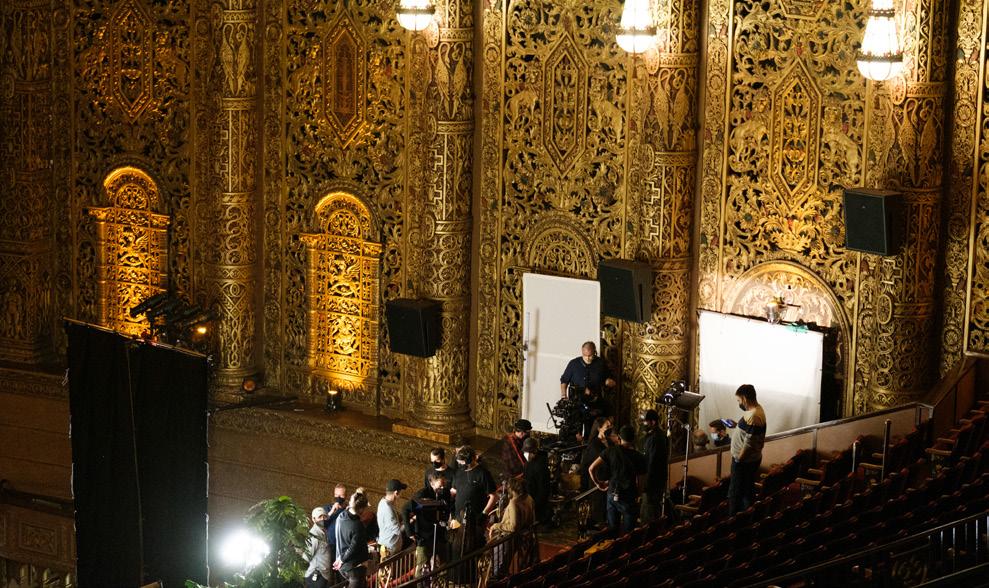
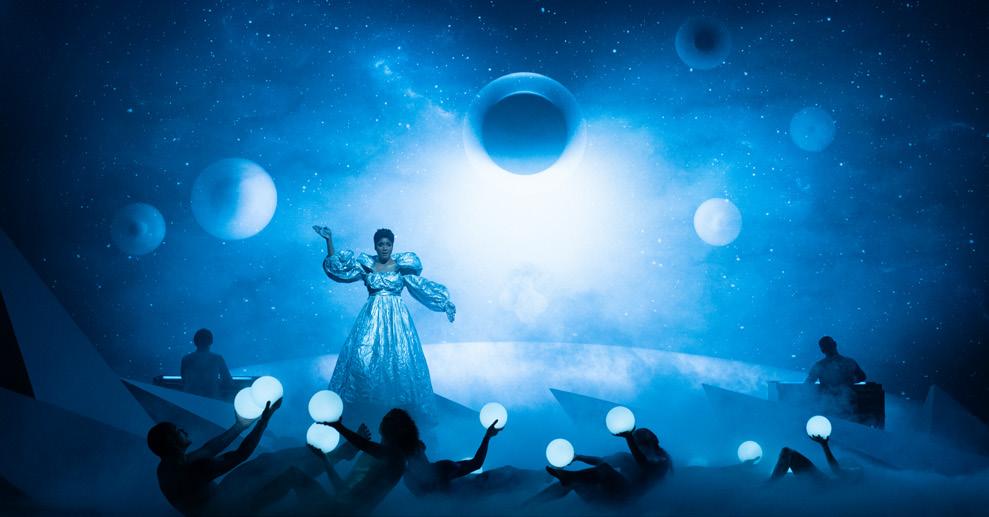
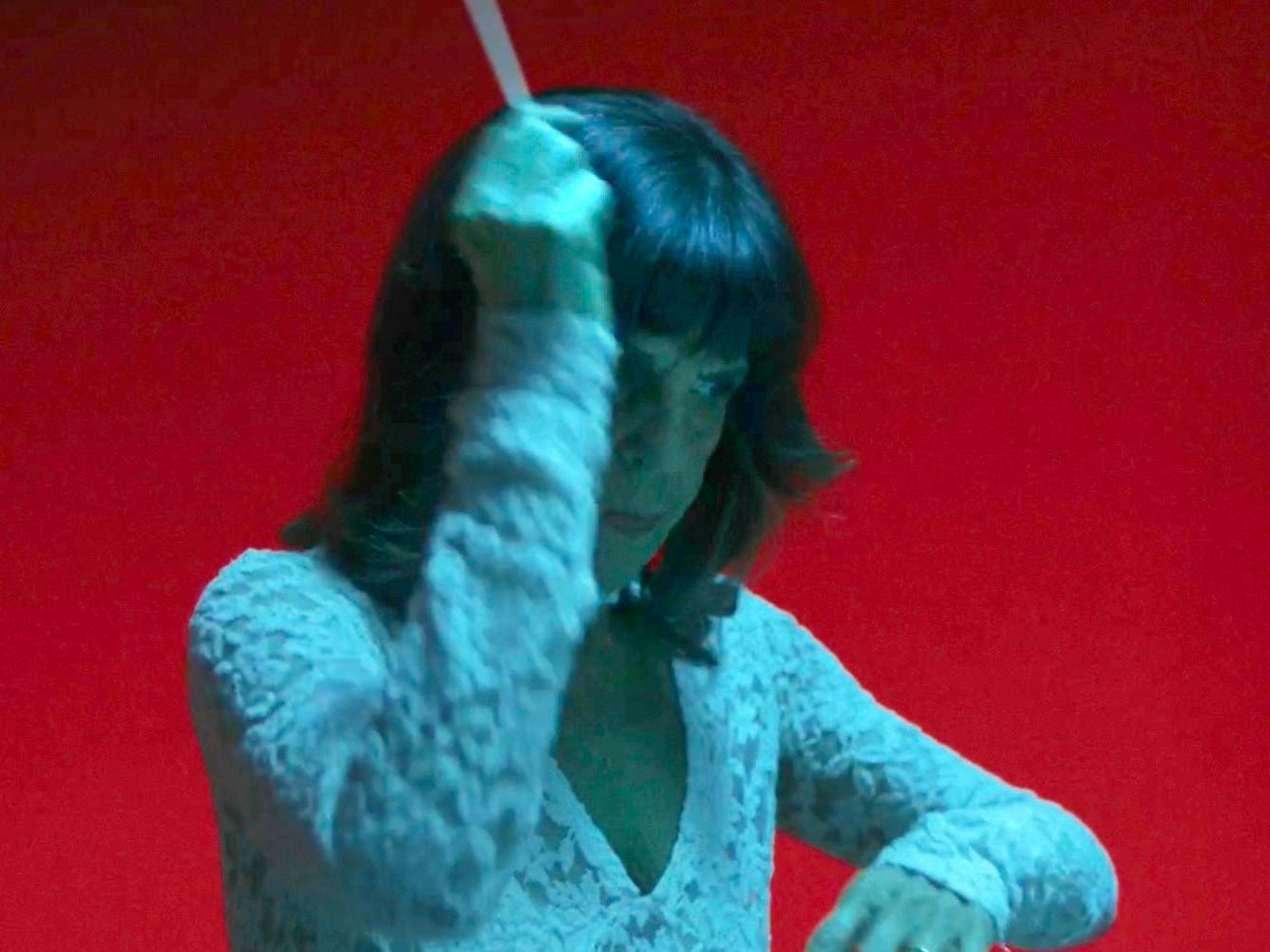
The film’s score, composed by Grammy winner Bryce Dessner, influences the pacing and mood of the film, as Miller’s script depicts fragments from Steven’s operas and his creative process. Levy says he worked tirelessly to make the musical compositions reverberate throughout the story.
“We began prep in March 2022, but I started meeting with Rebecca a year in advance to design a shot list. I couldn’t wait to jump into the opera scenes and the story which unfolds around them. My father played with the Boston Symphony Orchestra, and he worked with the greatest conductors in the world. He was also a cinephile. We would often watch films portraying musicians and composers, but he was always disappointed by their depictions. So, with that in mind, I
“When I was a camera assistant, I worked for the great cinematographer Harris Savides ASC. He always told me that if you prepare diligently and thoughtfully, the right lenses present themselves to you. This was my maiden voyage on a feature film with the Tribe7 lenses, and I had a wonderful dialogue with company founders Bradford Young ASC and Neil Fanthom. The Tribe7 lenses clicked during tests and fitted the emotional nature of our story.”
The Mini LF and Tribe7 lenses also turned out to be perfect for one of the most important decisions Levy and Miller made during prep.
“This script’s structure was more like a five-act opera than the traditional three-act narrative,” he says. “To make all the concurrent stories balance together, we decided to combine aspect ratios. We used 2.39:1 widescreen for the opera scenes and traditional 1.37:1 Academy ratio for scenes on the tugboat and scenes
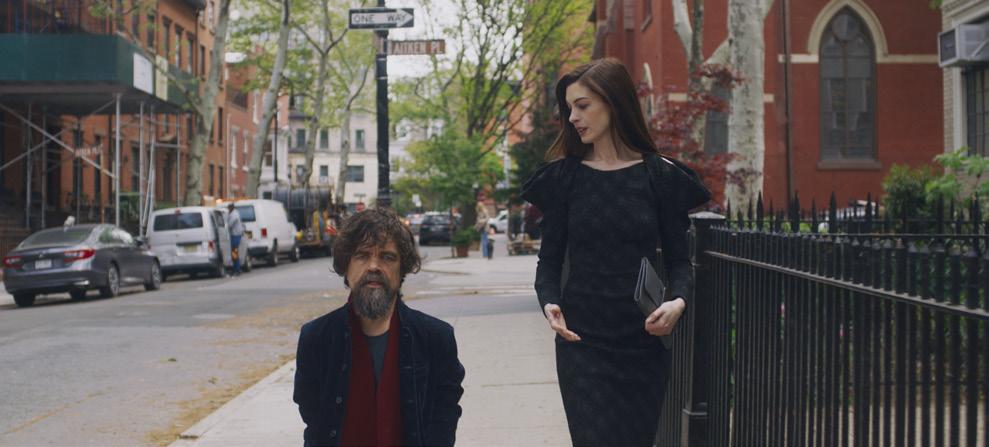
depicting Patricia’s spiritual awakening. The square 1.37:1 format was practical for filming in the cramped cabins of our real tugboat. Widescreen 2.39:1 gave the operas a lyrical expressiveness.
“We shot most of the film with two Tribe7 focal lengths, the 57mm for close-ups and 27mm for wides. Here and there we used the 77mm to punctuate an emotional arc, but sparingly. Inside the tugboat I shot everything handheld. For our exterior shots of the tugboat sailing on the Hudson River, we
SHE CAME TO ME•SAM LEVY
40 MARCH/APRIL 2024 CINEMATOGRAPHY WORLD
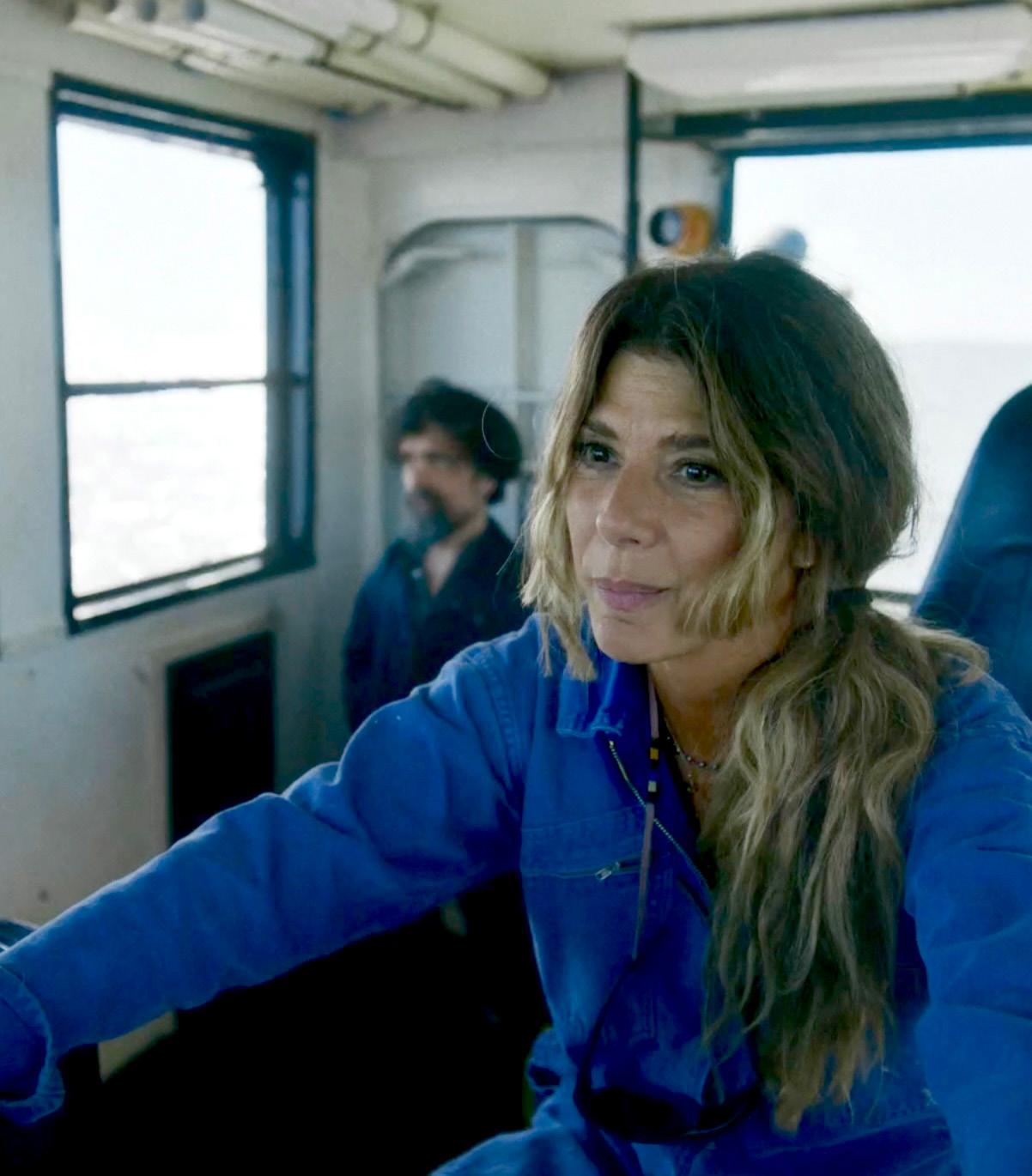

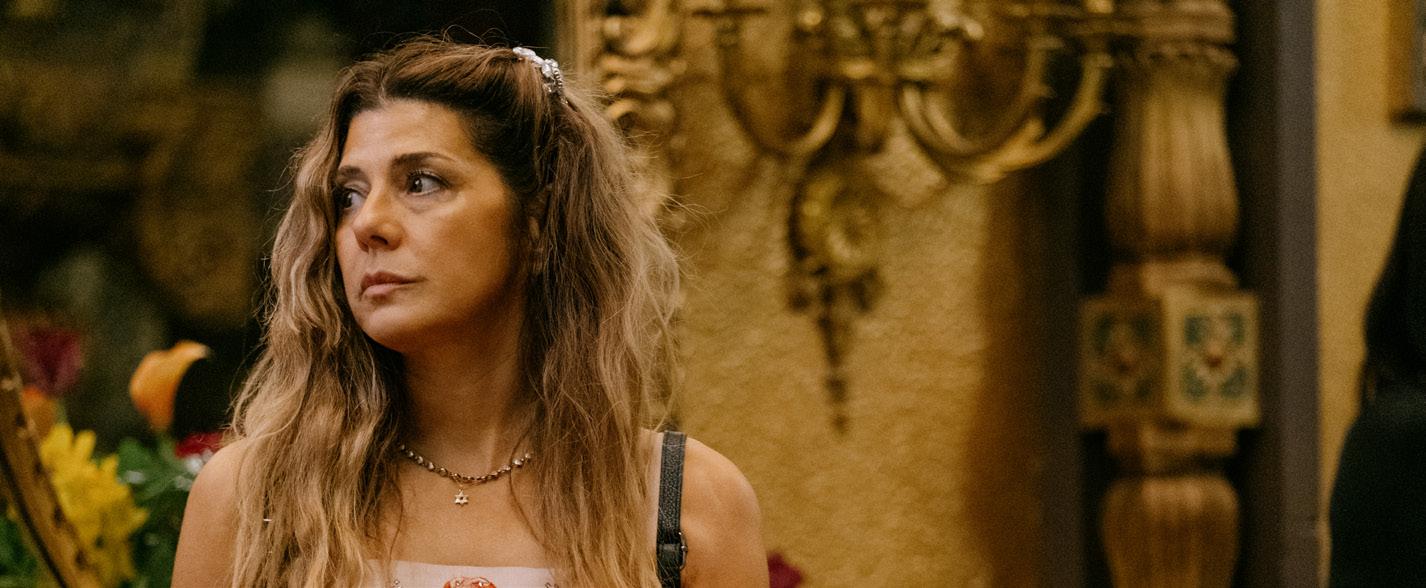
used an Angénieux Ultra Optimo 36-435mm zoom hard-mounted to the boat.”
Needless to say, this visual mosaic proved perfect for the rhapsodical storytelling. Levy focussed his creative energies towards the significant challenges of shooting two operas, written by Miller, in an enormous theatre.
“During prep Rebecca and I went to see operas at The Met. We also met on weekends to rehearse with our opera performers. I would record the rehearsals, then give clips to my team. The conversations which flowed from these videos informed our camera positions and lighting design. There would be no room for error, because we had to shoot all of our opera sequences in two days, and it was a matter of not letting logistics dominate the artistic approach.”
“Rebecca wrote two wonderful operas which are the core of our story. It was exciting to design a fully-mounted opera, but the prep time was very tight. I called on my friends Luke Halls, the illustrious projection designer, and Lap Chi Chu, an accomplished theatrical lighting designer. Together with them, Rebecca, plus our production designer Kim Jennings and my gaffer John Raugalis, I created an agile multi-dimensional design for our operas.
“It was essential to our schedule that the operas were rigged whilst we were shooting scenes in the theatre’s lobby. I gave Lap and Luke my directions, then I’d pop-in to supervise the opera lighting design in between set-ups,” Levy continues. “We lit our opera scenes entirely with theatrical lighting instruments – Ayrton Huracan LT Profile LEDs, Ayrton Perseo Beam LEDs, Mac Quantum LED washes, MAC Viper Profiles, and Tungsten Source 4 Pars.” 4Wall Entertainment provided the lighting package for opera scenes.
“The other parts of our story took place on-location. Many of the day interior scenes between Anne Hathway and Peter Dinklage were shot at night because it offered greater lighting control. Eastern Effects provided our location lighting and grip packages. We leaned heavily on ARRI 1.8K/4K Pars and ARRI 18K/12K Fresnels. For sculpting close-ups John and I employed ARRI SkyPanels S60s and S30s as well as
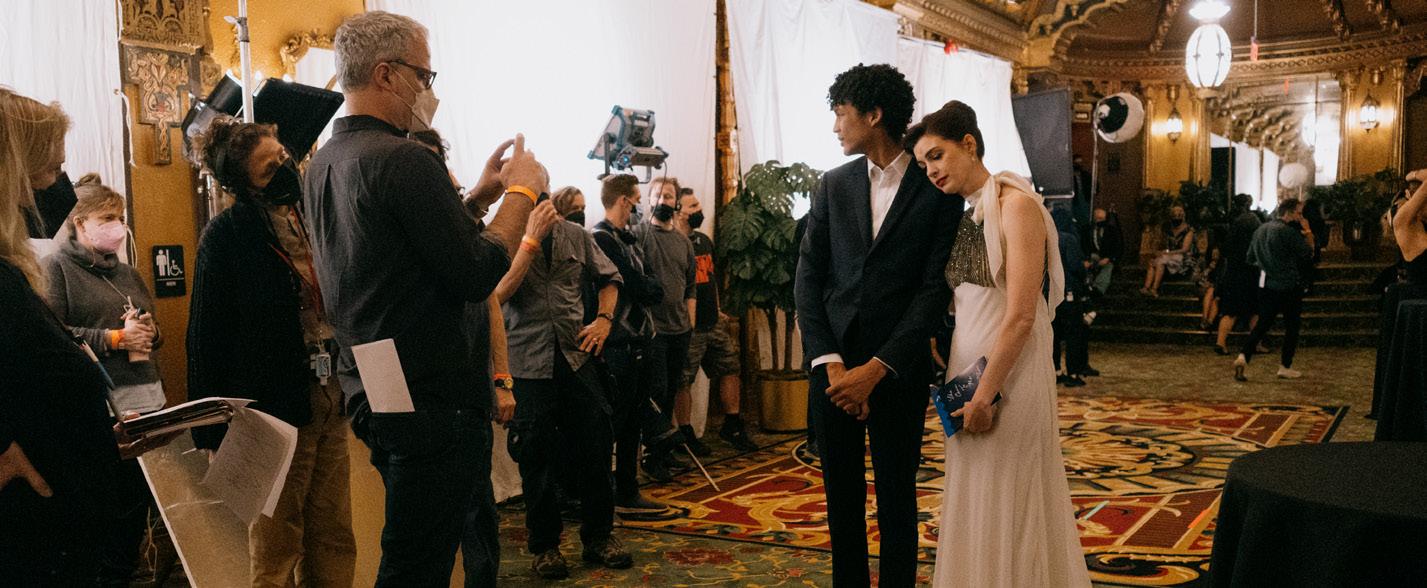
Astera Titan tubes.”
Aside from the purposefully staged opera scenes, the camera movement was dictated by the emotional arc of each character – whether that involved operating handheld on a tugboat, shooting Patricia’s spiritual awakening in a church from a dolly, or filming long
To properly design a feature film, DPs must develop a strong editorial sensibility
tracking shots with Steadicam in the brilliantly quirky sequence in a Civil War re-enactment camp.
“Except for the tugboat scenes, our camera movement was always motivated by character movement. Filmmaking is an art that employs geometry, and Rebecca and I have always been interested in triangulation of movement. Three characters in a room form a triangle. When one character moves, the narrative shifts. My job is to find the perfect intersection of geometry, story and emotion. I always keep in mind how each scene balances with the entire film – it’s imperative to consider transitions between scenes. To properly design a feature film, cinematographers must develop a strong editorial sensibility.”

She Came To Me was shot over 30 days during April and May 2022, in and around Brooklyn, with a group of Levy’s trusted collaborators, including: A-camera 1st AC Chris Eng, B-camera operator and 2nd unit DP Connie Huang, B-camera 1st AC Troy Sola, DIT Loic de Lame, gaffer John Raugalis, key grip Chris Keenan, as well as Steadicam operators Michael Fuchs, Julian Delacruz and Bradley Grant.
One of Levy’s favourite moments in the film happens when Patricia sneaks into a convent and takes shelter in a nun’s bedroom. There she has a spiritual epiphany
when she sees afternoon light glowing on a wall.
“We filmed this sequence on a sound stage – the glowing light-effect required a controlled environment. Upon seeing this light on the wall, Anne Hathaway’s character suddenly understands that she must completely change her path in life,” Levy explains. “I prepped obsessively for this scene, trying to figure-out how to get the light on the wall to feel like a higher power speaking directly to her. I decided to use a Big Eye 10K Fresnel – my favourite light - with the lens removed. We pushed the light through several layers of branches from the art department. The branches were placed on moving tracks and could slide back-and-forth in order to emulate tree branches blowing in the wind. We’ve all seen late afternoon light dancing on a wall, and I spent months working to get that effect exactly right and to connect this moment visually to our opera scenes.”
In post-production, Levy did the DI with colourist Peter Doyle at New York’s PostWorks facility, but the collaboration started in the project’s early stages.
“Peter is a true artist. He and I worked closely during prep to test different looks and build a show-LUT to correspond with the story’s emotional core. In prep, I’m always anticipating the final step of colour grading the film. Every minute in the colour suite is sacred, so I never want to waste even a second.”
She Came To Me caused quite a stir when it was chosen as the closing film of the 31st EnergaCAMERIMAGE Film Festival, and did so again when it opened the 73rd Berlin International Film Festival in February 2023. It’s an intimate, relatable, funny and poignant piece about men and women looking for connection in a world brimming with people settling complacently for enticing illusions.
“Shooting a movie is a complex endeavour, even when making a beautiful and elegant story. This project was no different, and it was one of the most rewarding experiences of my career,” Levy concludes.

CINEMATOGRAPHY WORLD MARCH/APRIL 2024 41
LEVY•SHE CAME TO ME
SAM
SPIRITED AWAY
By Ron Prince
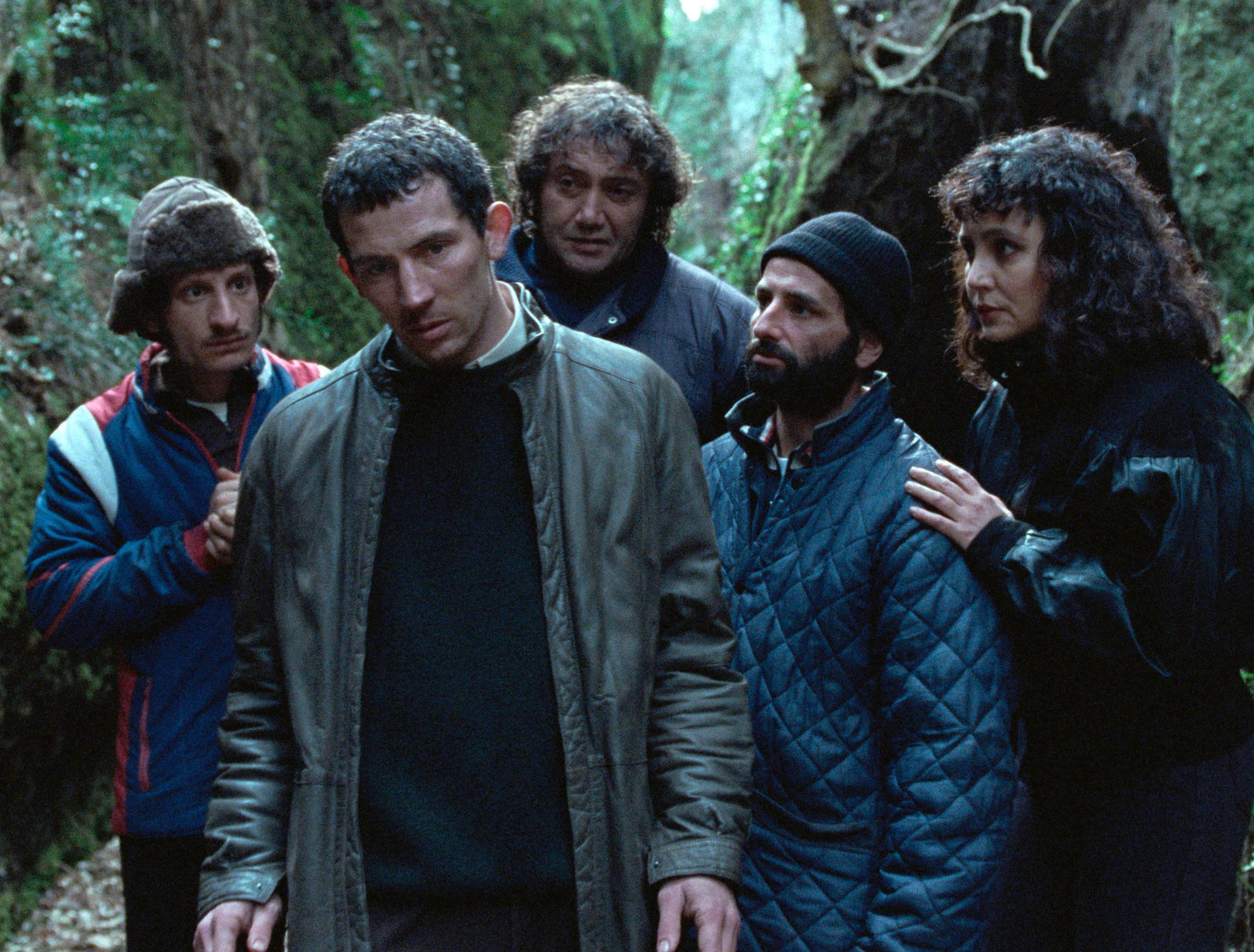
SSet in Tuscany during the 1980s, the film follows Arthur, a dishevelled, chain-smoking and once-respectable English archaeologist. He is freshly-released from prison and returning by train to the rural town where he and his motley band of ‘tombaroli’ (tomb raiders) earn a meagre living trafficking ancient Etruscan artefacts they loot from dark, subterranean catacombs.
Arthur dreams of Beniamina, the woman he loved, now presumed dead, and visits Beniamina’s ailing, elderly mother Flora who lives in a decrepit villa, where she is surrounded by predatory daughters and supported by Italia, a young housemaid who is keeping two children secretly in the house. Arthur yearns to be reunited with Beniamina in the spirit world, and legend has it that a buried door joins this world to the next. Yet despite the allure of dreams and visions of beyond, his nascent connection with Italia hints at the treasures real life can hold.
La Chimera was selected to compete for the Palme d’Or at the 2023 Cannes Film Festival. It earned critical acclaim worldwide for Rohrwacher’s portrayal of Italy as a treasure trove of past and present glories, and kudos for the exhilarating fusion of realism and magical realism in Louvart’s shapeshifting cinematographic style.
Filming took place across two separate fiveweek stints, during the winter and summer months of 2022, at locations around what was ancient Etruscan Etruria. These included: the hill town of Montalcino and the Asciano-Monte Antico railway in southern Tuscany; the communes of Tarquinia, Blera, San Lorenzo Nuovo and Civitavecchia in northern Lazio; and Castel Giorgio in Umbria. Although there is an abundance of human-made subterranean passageways, catacombs and

burial chambers in these areas, access limitations meant that some of the underground sets had to be specially-constructed. Filming also took place on Frasca beach and the nearby Torre Valdaliga Nord coal-fired power station.
La Chimera marks Louvart’s continuing collaboration with Rohrwacher. The pair previously worked together on the coming-of-age drama Corpo Celeste (2011), shot on 16mm, The Wonders (2014), which won the Grand Jury Prize at the 2014 Cannes Film Festival and was framed again by Louvart using 16mm, Rohrwacher’s 2015 short De Djess, which harnessed 35mm film, and the muchacclaimed Lazzaro Felice (Happy As Lazzaro) (2018), which was captured in Super16mm format.
“Alice’s scripts are always interesting, and this story about the real world, the under-world and the space in-between, was really intriguing to me,” says Louvart about her initial discussions with Rohrwacher about La Chimera. “On each production we evolve our visual storytelling style. Corpo Celeste was completely handheld. The Wonders had a more controlled handheld style, and I framed Lazzaro Felice largely from an objective perspective, to see things through Lazzaro’s eyes.
“We wanted to try something different for this production, to mix different ways of shooting –handheld, easy-rig, tripod and dolly, using prime and zoom lenses – so as to have a more-lively and
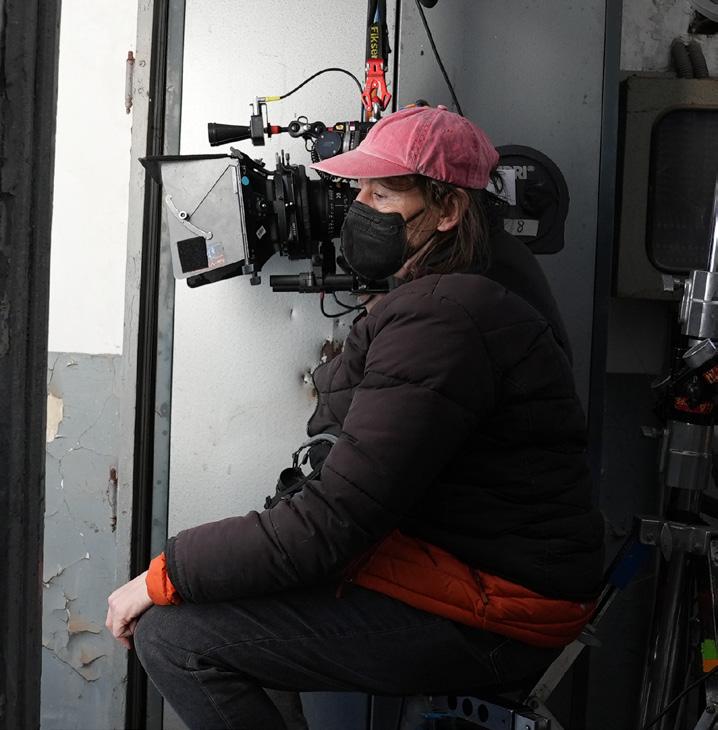
fluid camera than we’d ever had before.
“We also wanted to find ways to subtly separate the depiction of Arthur’s daily life against what’s happening beneath his feet and his melancholic reveries. After some discussion we came-up with the idea of mixing between camera formats to do this. We decided to shoot in Super16mm in 1.66:1 aspect ratio for daily life, on 35mm in 1.85:1 for anything Etruscan or anything linked with the Etruscan spirits or souls underground, and to harness regular 16mm film in 1.33:1 for Arthur’s daydreams, flashbacks of Beniamina, and other memories.”
The DP reports that there were precious few visual references for the film, other than observing Federico Fellini’s Roma (1972, DP Giuseppe Rotunno AIC) for the scene in which the frescos in an ancient catacomb are ruined by fresh air when it is opened by excavators. Louvart says her, and Rohrwacher’s, main research involved investigating Etruscan civilisation, scrutinising historic objects and sculptures in museums in Rome and Tarquinia, so as to gain deeper understandings into the distant past and the motives and mentalities of grave-diggers in the present.
Louvart, who operated during production, went with ARRIFLEX 416 16mm and ARRICAM LT 35mm cameras for the mainstay of the shoot, harnessing a Bolex Paillard H16 REX3 Reflex 16mm camera to film Arthur’s reveries. Lenses used on the 16mm
LA CHIMERA•HÉLÈNE LOUVART AFC
42 MARCH/APRIL 2024 CINEMATOGRAPHY WORLD
hooting on Kodak, French DP Hélène Louvart AFC blended 35mm, Super16mm and 16mm camera formats to fuse reality with fantasy for Alice Rohrwacher’s acclaimed La Chimera.

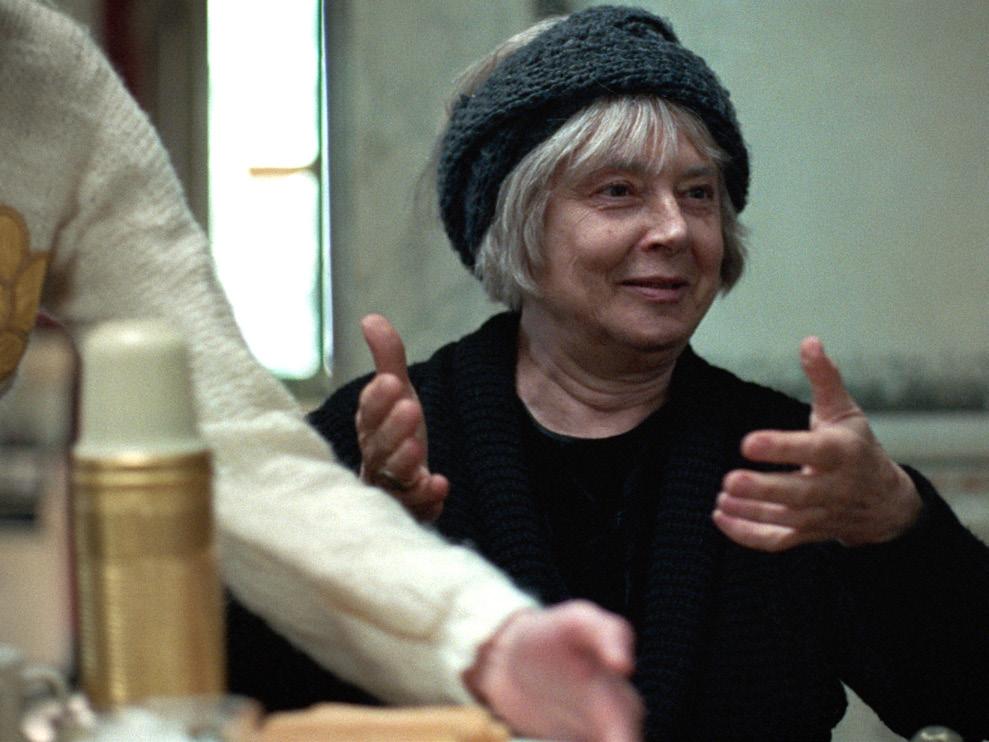
cameras were Zeiss Ultra Primes. Lightweight ARRI Alura T2.8 15.5-45mm and Alura Studio T2.6 1880mm and T2.6 45-250mm zooms were added to the optical choice when shooting on 35mm. The camera package was supplied by D-Vision in Rome.
“La Chimera was mainly a single camera shoot, with me operating,” says Louvart. “The combination of the ARRIFLEX 416 camera and Ultra Prime lenses gave me excellent image quality, and formed an agile camera package that allowed me to move with freedom for scenes of everyday life, such as on the train and also during the town carnival, when we also had a second 16mm film camera to capture faces in the crowd. Of course, we easily adopted a far more sedate and staged approach when filming scenes inside Flora’s house using that same camera and lens combination.
“However, for scenes involving Arthur’s hunt for ancient artifacts or dialogue about the Etruscan world, we changed to shooting with the ARRICAM LT 3-perf 35mm, to create a subtle visual distinction between everyday life, although the way of framing and moving the camera was not radically different. We shot all of the night scenes on 35mm as I knew it would render these moments best, especially the countryside exteriors that didn’t have any street lighting, which we would have to illuminate those ourselves.”
All of the day/night, interior/exterior scenes shot during the winter leg of production were captured on KODAK VISION3 500T 35mm 5219 or 16mm 7219. The shoot in the summer months added KODAK VISION3 250D 35mm 5207 and 16mm 7207 into the mix. Film processing and 4K scanning was done at Augustus Color in Rome, where colourist Thomas Bouffioulx later supervised the final colour grade.

Explaining her choice of filmstocks, Louvart says, “I went with just the 500T during our winter shoot because it involved a lot of dark/low-light exterior and night interior scenes, and I knew it would offer enough exposure along with our various forms of HMI, LED, candle and fire lighting sources. I sometimes did a little pull-processing at the lab, such as the day-interior scenes at Flora’s villa to balance the details of the dark interior with the sky outside the window. Shooting with 500T, I dealt with day exteriors using NDs, and it was also much easier and faster to deal with just one stock.
We wanted a morelively and fluid camera than we’d ever had before
“During the summer shoot we filmed outside in broad daylight much more, so it was great to rely the 250D for those scenes. The 500T and 250D both absorb the natural colour of locations and skin tones nicely, and they match really well together too, in 35mm and 16mm formats. Also, Alice and I really liked the organic, textural and emotional feeling of 16mm for Arthur’s dreams and flashbacks.”
Louvart’s crew included 1st AC Helene Degrandcourt, with Ilya Sapeha and Tiziana Poli brought-in as additional camera operators when required. The key grips were Carlo Postiglione and Daniele Postiglione. For the winter shoots Louvart’s

gaffer was Marianne Lamour, and with Ernst Bruner taking on that role during the summer leg of production.
In keeping with Rohrwacher’s preference, Louvart maintained a mainly naturalistic approach to the lighting, but sometimes heightened the look to evoke a sense of the ethereal.
“We shot the exteriors in available light, and were lucky to have real sunshine flickering magically along the train carriage during Arthur’s journey home,” Louvart explains. “On day interiors, such as the dark rooms in Flora’s villa, we bathed the scene with direct or diffused light from 9K or 18K HMIs outside, depending on the scene’s time-of-day. We then shaped the light with softer illumination from a variety of LEDs, such as a Rosco Dash on the camera, plus carpet lights and Astera tubes around the room, which could all be easily-controlled from an iPad.
“When Arthur and the tombaroli are exploring the darkened caves, the actors carried small LED torches and real candles, and we encouraged them to keep these close to their faces. However, to avoid the backgrounds being completely dark, we carefully introduced a touch of additional light from ARRI L5 and L7 Fresnels. We lit the night scenes of the dances after the carnival with real fire as our main source, but shot the reverses with some additional light to compensate for the contrast.”
Reflecting on her involvement on La Chimera, Louvart concludes, “Alice and I are very good friends and I had yet another great experience working with her. I also loved shooting on film once again. I always felt comfortable that the dailies would be a pleasant surprise, and think the result shows how incredible film is for storytelling.”
Images: La Chimera images © Tempesta SRL.
BTS photo of DP Hélène Louvart AFC by Simona Pampallona.
Images: Copyright © 2023 Netflix, Inc.
CINEMATOGRAPHY WORLD MARCH/APRIL 2024 43
HÉLÈNE LOUVART AFC•LA CHIMERA
GALAXY QUEST
By Ron Prince

The K35s have a soft and dreamy appeal
Six months into a solitary research mission to investigate the Chopra Nebula on the edge of the solar system, Czech astronaut, Jakub, realises the marriage he left behind might not be waiting for him when he returns home.
Lonely, stressed and struggling to communicate with his wife Lenka back on Earth, he receives unexpected counsel from Hanuš, a mysterious extra-terrestrial creature from the beginning of time hiding inside his spaceship, who helps Jakub make sense of what went wrong before it’s too late.
Spaceman, available now on Netflix, was directed by Johan Renck and written by Colby Day, based on the 2017 novel Spaceman Of Bohemia by CzechAmerican writer Jaroslav Kalfař. It stars Adam Sandler, Carey Mulligan and Isabella Rossellini, with the giant, spider-like Hanuš voiced by Paul Dano. Max Richter composed the soundtrack.
Spaceman had its world premiere at the 2024 Berlin Film Festival, earning praise as a well-crafted, ruminative sci-fi drama about tenderness and caring for one another, whilst also earning plaudits for its central performances and Swedish DP Jakob Ihre FSF’s stellar efforts to create an atmospheric mix of darkness, light and claustrophobia in zero gravity.
Principal photography of the spacecraft scenes began on April 19, 2021, on a huge stage at Grumman Studios, Long Island, NY, the former assembly plant for NASA’s Apollo Lunar Modules, and lasted for 35 shooting days. The Earth-bound scenes were shot in the Czech Republic over the course of 17 days, around Prague and surrounding areas of the country’s Central Bohemian Region, before production wrapped on July 1, 2021.
Renck is a successful Swedish director of music videos, TV and film productions, including the HBO drama Chernobyl. He teamed-up with Ihre to shoot that mini-series, and Spaceman represents their second collaboration. Along with Chernobyl, Ihre is noted for his work on Joachim Trier’s Oslo, August 31st (2011), Louder Than Bombs (2015) and Thelma (2017).
Elaborating on his initial discussions with Renck about
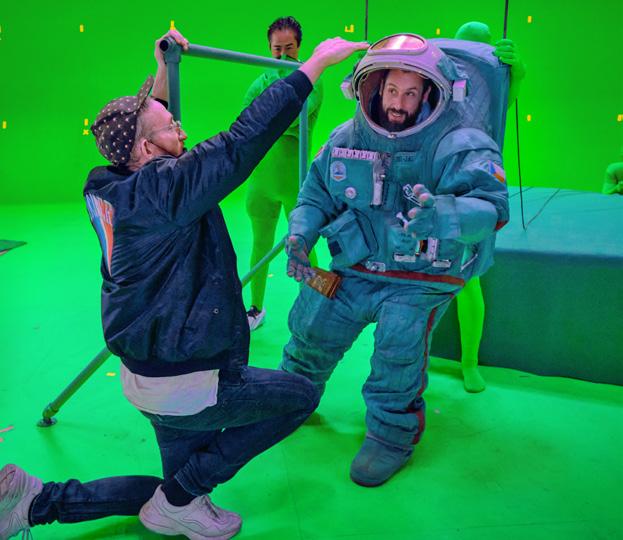

the treatment for Spaceman, Ihre remarks, “We talked a lot about solitude – about being alone, away from home and family, whilst undertaking an important quest that involves sacrifice. That’s a subject that is very familiar to filmmakers. Johan wanted to amplify this feeling of isolation far far away, by the spaceship having hardly any windows, just a few small portholes, and no sunlight – the opposite of most sci-fi movies, where starscapes and the sun are strong presences.
“To make a counterpoint to the Earth-bound sequences which are planted firmly on the ground,
I’m glad I got to shoot a poignant story about tenderness, love and connection
we also made the decision to shoot the action on the spaceship in what looks like zero gravity, which led to many creative and technical challenges around the placement and movement of the camera, as well as the lighting, to keep things believable and visually-interesting.”
Whilst there’s a huge number of movies set in outer space, Ihre says neither he nor Renck investigated direct references for the production. “Obviously there are fantastic films like Solaris (1972, dir. Andrei Tarkovsky,
DP Vadim Yusov) and Sunshine (2007, dir. Danny Boyle, DP Alwin Küchler BSC) that are imprinted in the mind, but we really wanted to create our own universe,” he explains.


During prep, Ihre worked with final colourist Jean Clement Soret, with whom he had previously worked on Chernobyl, to develop looks for the production, and the pair spent time together examining LUTs for application across different interior/ exterior, day/night scenes. After much deliberation it turned-out that the preferred looks emanated from one standard LUT in ARRI’s Look Library, adjusted slightly by Soret, which Ihre then used throughout production. Soret later completed the DI grade at Company3, with Ihre remarking, “he did a masterful job.”
With a 4K deliverable in mind, Ihre opted to shoot Spaceman using ARRI Alexa LF cameras, along with Canon K35 lenses plus a Cinefade system, supplied by TCS – Technological Cinevideo Services, Brooklyn, New York.
“We didn’t want to shoot wide-open and for the spaceship interiors to appear as a blur in the background,” Ihre explains. “I recognised early on that one of the challenges when shooting those scenes in low levels of light, would be achieving a T-stop ranging between T5.6 and T8, so that there was always a connection between Adam in the foreground and the
SPACEMAN•JAKOB IHRE FSF 44 MARCH/APRIL 2024 CINEMATOGRAPHY WORLD
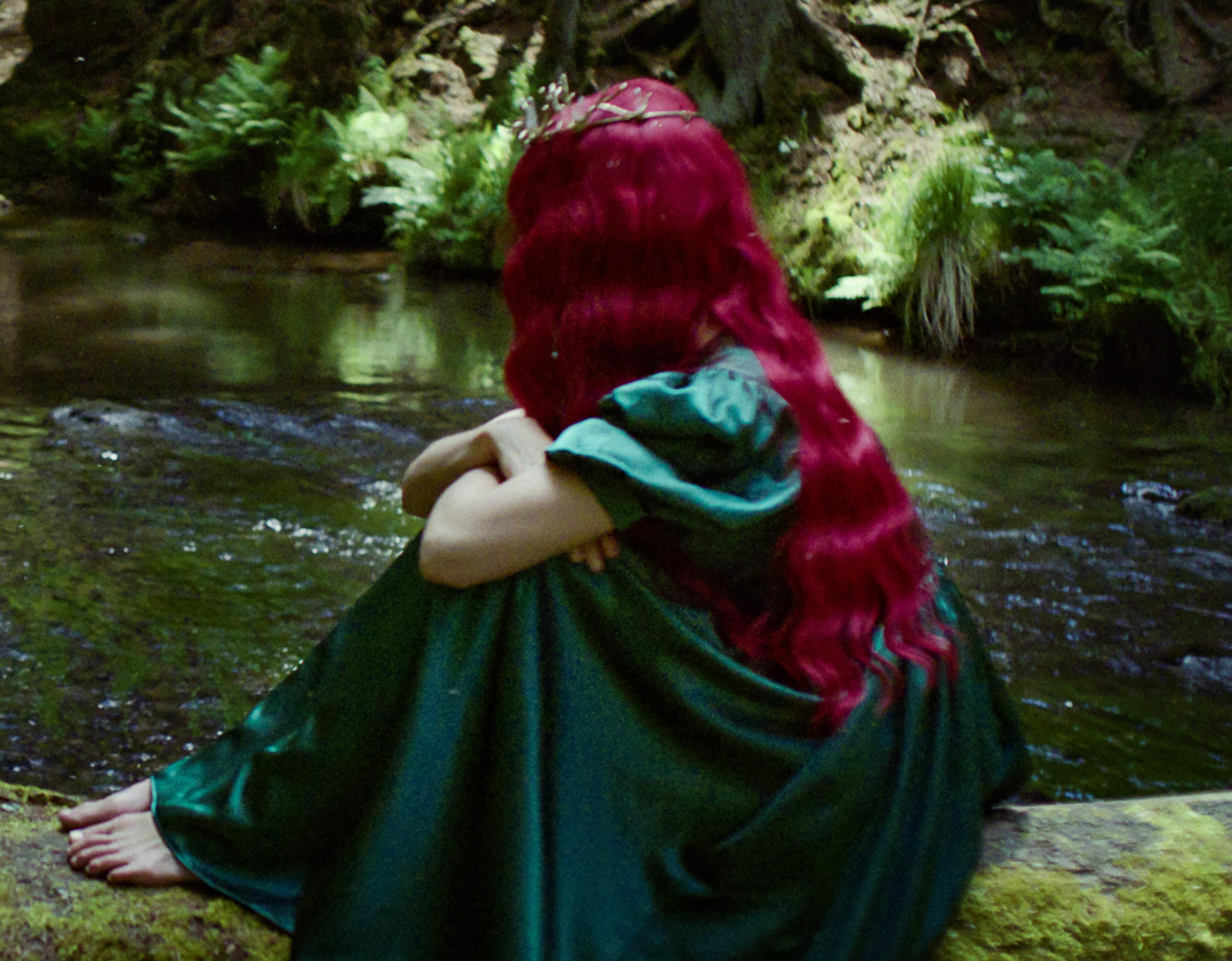

spaceship itself. I was able to achieve the T- stops I wanted by shooting at 2250 ISO, and although that added a level of texture to the image, I really liked that look.
“We mainly framed using 20mm, 25mm, 28mm and 35mm focal lengths. The K35s have a soft and dreamy appeal, and are really interesting when you shoot at deeper stops in the way they flare, you get little round planets, and we laughed about the way they did that. I sometimes used the Cinefade system to make gradual transitions with constant exposure between shallow and a deep depths-of-field in single shots as Adam travels from a wide shot to a close-up.”
Shooting zero gravity is a tricky task. In order to simulate the physics of floating around the environment of Jakub’s spacecraft – a retro-futuristic design created by production designer Jan Houllevigue – Sandler spent much of his time on-set dangling from wires, or perched on various types of camera-moving equipment, whilst Ihre employed dual SuperTechnocranes, fitted with 3-axis Libra and 4-axis Matrix remote stabilised heads, supplied by Monster Remotes, inside the tunnel-like set where it was impossible to place a camera on any surface.
Ihre normally likes to operate the camera, but the practicalities of shooting zero gravity using two constantly drifting cameras, saw this being delegated to Matthew Pebler and Peter Agliata, who operated A- and B-camera respectively, in tandem with crane operators Craig Striano and Brady Weston, plus Sean Folkl on the Libra head and Lance Mayer on the Matrix head.
“Creating the effect of Adam floating around meant the camera having to be constantly moving around him in a kind of dance, subtly drifting up, down, sideways and turning upside-down – not following the common rules and aesthetics of camera language” explains Ihre. “The

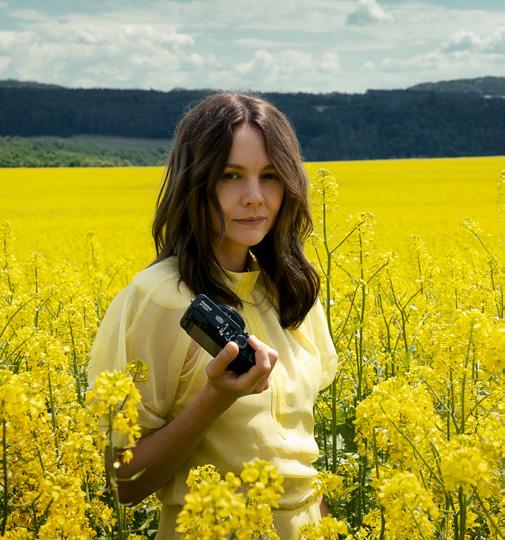
corridors and modules of the set were small confined spaces, and it was quite something for Adam to perform remotely with these monstrous cranes and camera heads circling around him, sometimes moving-in for an extreme close-up on his eye.
“It was also quite unique for me to watch the otherworldly zero-gravity framings on two monitors, and to simultaneously guide the conversation between the two sets of operators on the wheels and crane operators on-set as they co-ordinated the moves and created the sensation of floating. They did a superb job.”
Lighting the spacecraft was a further challenge for Ihre. “Working with my US gaffer, Nina Kuhn, and Jan Houllevigue, we integrated a huge number of practicals around the set – such as lighting strips and buttons on computer consoles – which we could control individually from the dimmer-board, operated by lighting programmer Ray Roy. These in-built lights were pretty much the only sources of light I used to illuminate Adam, although we did have some Astera tubes concealed out-of-shot to help lift the light levels on certain occasions.
He adds, “The process of lighting the set reminded me of the grading process in post. With so many practicals often hidden and not seen in the frame I had tremendous control of the light. I didn’t have to adjust the rushes or spend time grading on-set, it was all captured in-camera.
“The lighting and mood inside the spacecraft was motivated by us embracing the idea that the vessel is lit through motion-sensors. When Adam entered an area, the light came on, only to turn-off again when he moves to a different area, which added a dynamic to the
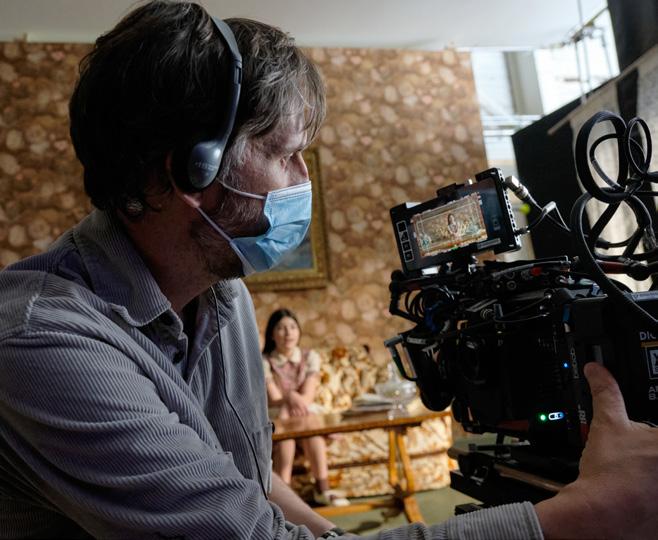
visual language.
“When Jakub reaches the Chopra Nebula, we employed bigger sources like ARRI SkyPanel 360s to create the violet pink of the light emitting from the dust cloud, combined with harder light of the same hues using Rosco X-Effects LED projectors, along with gobos to provide a subtle rippling effect. To bring-in even more dynamism to the spacecraft scenes, we also bought cheap off-the-shelf projectors from an electronics store in New York, to display the video calls Jakub makes back to Earth, rather than resorting to regular screens.”
During production in the Czech Repulic, Alexander Surkala operated A-camera, with Mark Rimmer working as the B-cam/Steadicam operator. If you are wondering about how the movie’s swirling and sometimes hallucinatory flashbacks – Jakub’s romantic memories of Lenka and other dream-like imaginings – were created, the answer is it wasn’t in-camera with whacky lenses. Ihre says these scenes were preplanned as straight live-action, with manipulation in post production by the VFX team.
Reflecting on his experience, Ihre remarks, “I really enjoyed working with Johan again and taking some fresh approaches to the sci-fi genre. During production, it was tremendously uncomfortable for Adam hanging around on the harnesses, but he was incredible and his performance is so watchable and relatable. I’m glad I got the opportunity to shoot a poignant story about tenderness, love and connection, which is what we all want really, isn’t it?”
JAKOB IHRE FSF•SPACEMAN
CINEMATOGRAPHY WORLD MARCH/APRIL 2024 45
SHOWSTOPPERS…
An A-to-Z of super-cool cinematography kit and services as shown at the 2024 BSC Expo.
Reporting and photos by John Keedwell GBCT, Michael Burns, Kirsty Hazlewood, Iain Hazlewood, David Wood and Ron Prince. Seminar photos by Theo Spearman.
AC ENTERTAINMENT
At the forefront of the stand was the EclFresnel CT+ range of lights, offering the proper characteristic of a Fresnel – quite a hot centre, but falling-off really smoothly. Features include, a six-colour LED engine, functional barn doors, plus they’re IP-rated so they can be used outside. Also on show, the Chroma-Q 2inspire range of three compact, silent, bright fixtures run off a single ethernet cable and offer a constant light level from 3,200 to 6,500 kelvin.
While on the the booth, we were shown the Avenger Buccaneer stand which boasts a lower
ACO - ASSOCIATION OF CAMERA OPERATORS
The expectation from the ACO was that 2023 would be a busy year after the strikes, but it reports seeing no real sign of that to date. Possibly the US studios got into a sort of famine mode, in not spending money all the time, and they are taking some time to get back up to speed.
We caught up with ACO member Rory Moles, who said, “We’ve gained about 400 new members over the past 12 months and we’ve expanded our Steadicam training and handheld workshops. We’re trying to engage with everyone and help in up-skilling all of the membership by getting experts in, and that’s opening-up experience opportunities that young operators might never have dreamed
APUTURE
High-power LED lighting fixtures are now a reality with the Aputure Electro Storm XT26, a 2,600W high-output pointsource LED fixture with white CCT and tint control. The fixture’s output is similar to the brightness of many industry-standard 12kW Tungsten Fresnels and 4kW HMIs, making it one of the most powerful point-source LEDs around so far. It is liquid-cooled, and the dynamic White chipset features green/magenta colour correction between 3,000K to 6,000K, while producing accurate colour
ASTERA
Well-known for their Titan and Helios LED tubes, the Pluto Fresnel and Leo Fresnel heads are a new development. Prototypes were quietly shown in the back room at the 2023 show, and are now fully-functioning units.
loading height of 94cm, so if you’ve got a heavy fixture - rather than having to lift it up - you can go for a much lower loading level and then the whole fixture lifts to take the unit up.
The Prolights EclPanel range now goes up to a 48-pixel model, yet it still remains portable and easy to rig. From Luminex there was the Araneo network management tool that provides a complete live view of any network to aid planning and troubleshooting.
of by meeting the other people in the ranks.”
He added, “Diversity is very important. We’re getting more female operators joining-up and getting trained, plus we’re championing the female operators we have already.”

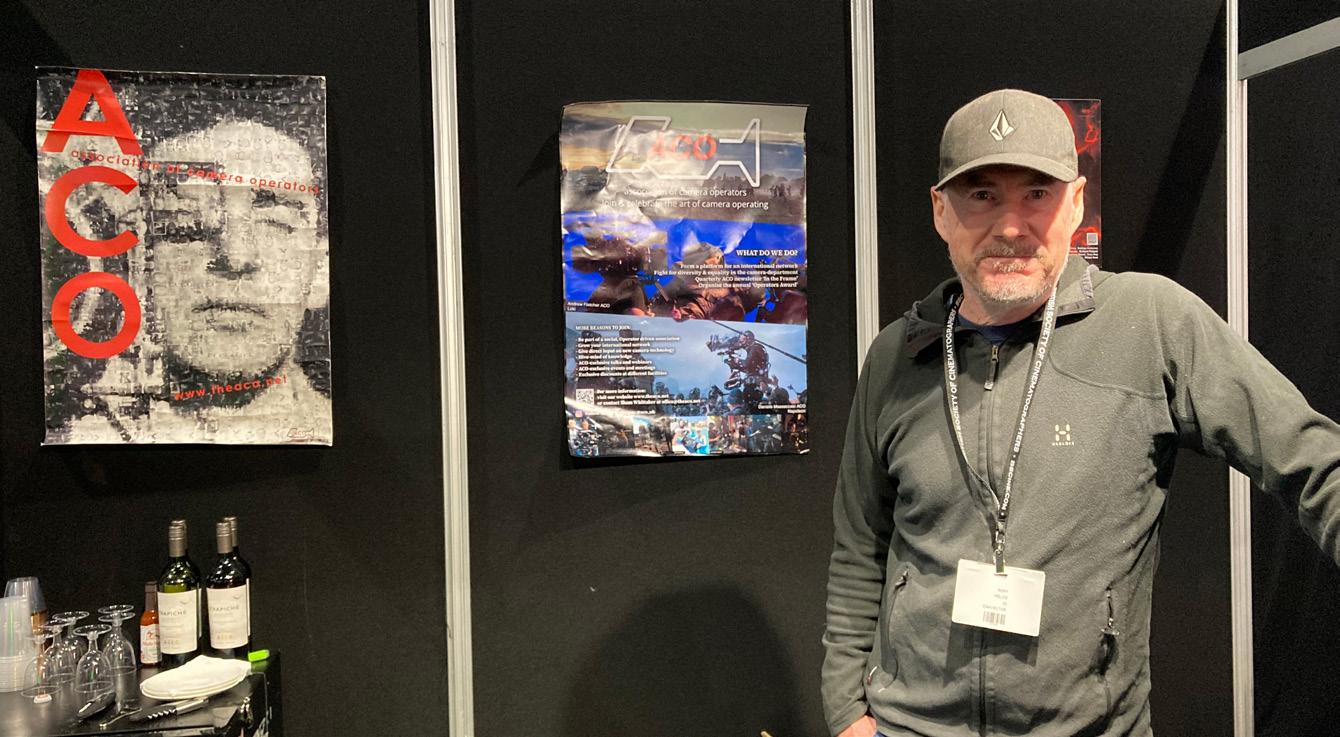

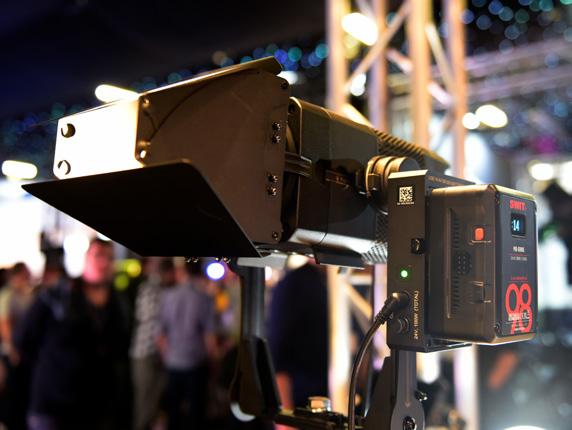
The 80W PlutoFresnel is equivalent to a 300W Tungsten Fresnel, its built-in battery has a three-hour runtime, or 24V DC battery power can be added via a runtime extender connected to the yoke. The zoomable lens ranges from 15° to 60° and works with a built-in light pipe creating no chromatic aberration or colour fringing. The Fresnel lens can be removed to create an
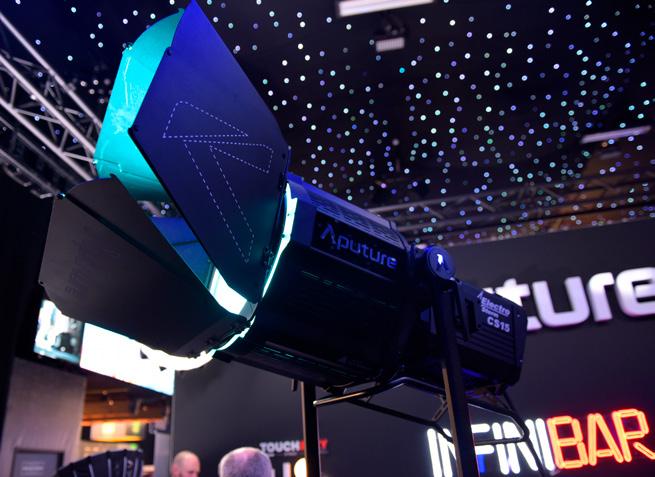
The Electro Storm CS15 is a smaller 1,585W version and compares to industry-standard 1.8kW HMI daylight output, like the ARRI M18. It has a dualblue LED chipset with SSI (Tungsten) of 89+ and SSI (D56) of 86+, across a 2,000K to 10,000K CCT range.
Both the XT26 and CS15 heads feature IP65 dust/water-resistant construction, and both are controlled via LumenRadio CRMX, Sidus Link app control, Art-net & sACN via etherCON and 16-bit DMX512.

open face with a much wider beam.
A custom-built ProjectionLens can also be inserted to create a battery-powered profile fixture with a 16° to 36° beam angle, with two rings for projection and focus, four shutters, and the facility for
E-sized glass or metal gobos.
The LeoFresnel, a larger version of the PlutoFresnel, has similar qualities. It also has a built-in battery that lasts two hours, or a single 26V battery or two 14.4V batteries can be added for full output. Operations up to 20 hours can be set. Connection to AC power is via Powercon in+out sockets. It has an output comparable to a traditional 1kW Tungsten Fresnel, but consumes only 250W. It can be converted with the DoPchoice Rabbit Rounder to different soft lights such as a lantern, 3ft Octa or Snapbag.
ROUND-UP•BSC EXPO 2024 46 MARCH/APRIL 2024 CINEMATOGRAPHY WORLD
throughout the 2,700K to 6,500K CCT range. The allnew F14 Fresnel lens can be added for control.




Sunbelt Rentals are specialist suppliers of professional end-to-end solutions for content creators in the Film and TV production industry. With a comprehensive and technologically advanced rental inventory of lighting, camera, access, grip, power and infrastructure, we offer a full production solution from prep to wrap. EVERYTHING YOU NEED IN ONE TAKE Now part of Sunbelt Rentals Belfast 02890 240 97 Cardiff 02921 304 120 Manchester 0161 511 8131 London 0300 373 1200
ARRI
The SkyPanel S60 has been around for seven years and became a go-to fixture for motion pictures. But when competitors launched products with high IP-ratings, more powerful output and quality of colours, SkyPanel needed an update.
Enter SkyPanel X, an all-weather lighting solution, IP66-certified for resilience against rain, storms and pressure washers. It offers eight individually-controllable pixel zones for diverse effects, and is configurable into different multi-unit array sizes of X21, X22, X23 with suitable ARRI yokes. Existing SkyPanel S60-C accessories, like honeycombs, can be used with an optional adapter.
The new interface is taken from the ARRI Orbiter. Key features include: output of 4,800 lux at 10 m /
BLACKMAGIC
Blackmagic has two core sides of its business – cameras and post – successfully encompassing the chain from acquisition to delivery. Attracting attention, Blackmagic Camera is the company’s free app, which adds digital film camera controls to the Apple iPhone. Based on the same operating system as Blackmagic Design’s award-winning digital film cameras, these professional features give iPhone content creators the same tools used in feature films, television and documentaries.
CAMERIMAGE
The annual EnergaCAMERIMAGE festival in Toruń, Poland, is a mainstay in the social and networking calendar, and continued to rebound from the Covid pandemic with another record year of attendance in 2023. No business is immune from global economic factors at play and Dariusz Wyczółkowski, international marketing coordinator for the festival, stressed how important brand sponsors are to helping them carry-on with the event.
CINELAB FILM & DIGITAL
Unlike previous years, when the company hauled large and impressive machines on to the showfloor, the show was all about the Cinelab team spending quality-time face-to-face, sometimes with beer in hand.
Gracing the stand with his presence was new vice-chairman Steve Milne, an industry heavyweight with an illustrious career spanning over two decades in post-production, including two separate tenures at Molinare. Milne is working with Cinelab founder and CEO Adrian Bull on strategy,
CINEO & NBC/UNIVERSAL
The Cineo Reflex R10 is a leap towards redefining how hard light is used photographically. Cineo has a patented and combined liquid-cooling LED technology into the compact Reflex R10, which offers a replacement to HMIs and large Tungstens in one package.
32.8 ft; an RGBACL full-spectrum colour engine; dynamic CCT range of 1,500K20,000K; CRMX control; integrated power supply; and advanced networking possibilities.
As for the ARRI Orbiter, the Quick Lighting Mount (QLM) allows Orbiter optics with different properties to be connected to the fixture, and a variety of changeable optics, such as Fresnel, 25° and 35° projection, domes and soft boxes can transform it into different types of lamphead. The Orbiter Beam attachment has a reflector focus

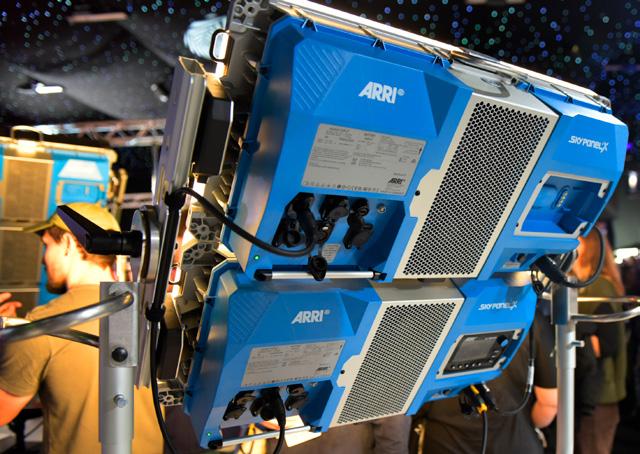
system with a 4° shaft of parallel and homogenous light, and is comparable to the Daylight M-Series M18.
ARRI was also showing 360 Evo, a three-axis stabilised remote head, as well as a prototype that adds a panning axis to the Trinity 2, turning it into a three-axis remote head.
Enabling low-stress collaboration is key to Blackmagic’s offerings. Whilst still supporting Google Drive and Dropbox, it now offers cloudbased storage, has further-refined some of its camera workflow and is teasing some of what its camera-to-Blackmagic-cloud workflow will look like in the future. The company is also seeing evercloser integration within its DaVinci Resolve 18 pipelines, whilst continuing to support third-party ecosystems.
“We’re happy that more and more people are coming to the festival, but, of course, we still need to finance it and although inflation is an issue, we are doing well,” he said.
A new festival venue is in the pipeline, and construction continues apace. The 2025 edition will offer additional space, with the promise of multiple screening rooms and break-out areas. The 2024 edition takes place from 16-23 November.
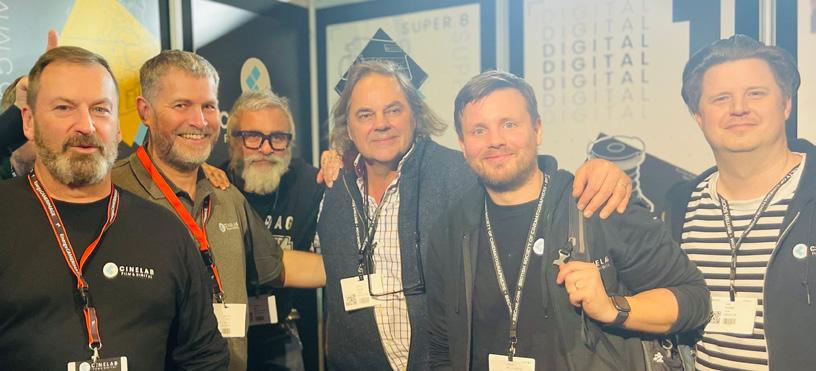
customer relations and spreading the word about the company’s comprehensive film and digital post production services – including film lab/scanning for S8mm, 16mm, 35mm and 65mm, film/digital

Featuring an impressive IP-X5 rated body, the R10 provides many possibilities. The design priority was a quality White with a high lumens output, and the result is a RGBWW bi-colour head capable of

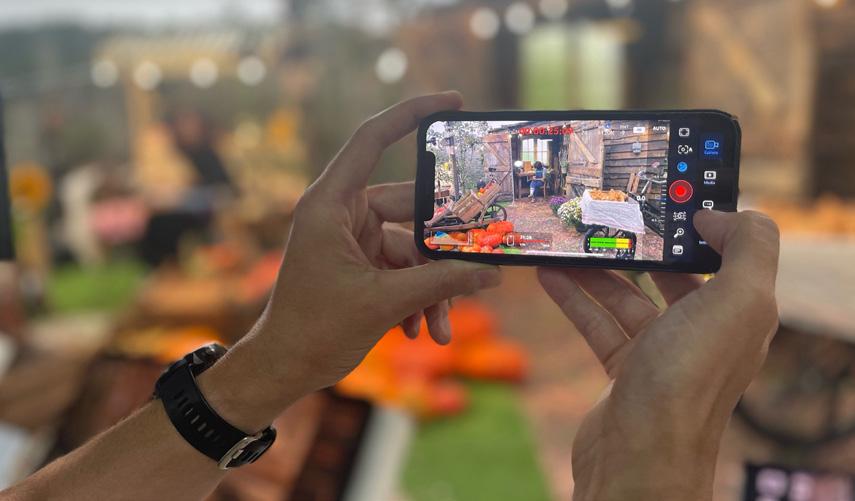
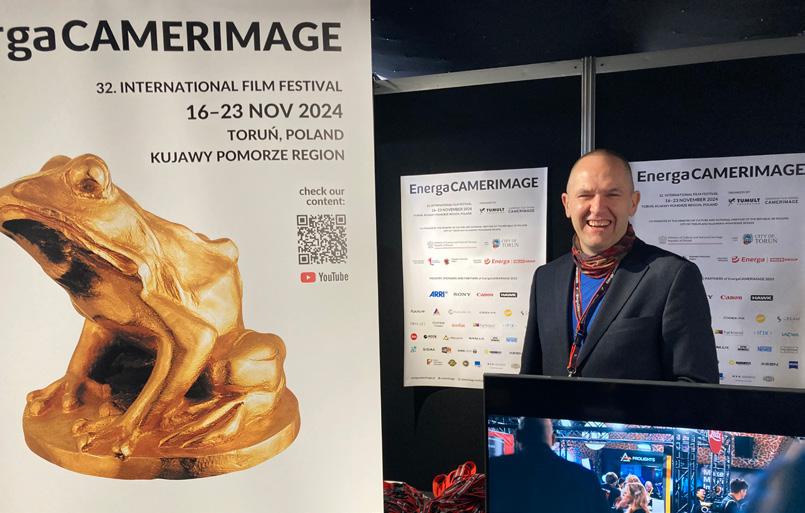
dailies, DI/colour grading, and DFD (digital-filmdigital) services.
Recent projects include 4K scanning and film deliverables for Poor Things (DP Robbie Ryan ISC BSC) and film deliverables for All Of Us Strangers (DP Jamie Ramsay SASC). Society Of The Snow (DP Pedro Luque) harnessed Cinelab’s DFD analogue intermediate process. Cinelab also provided digital dailies/dailies colour services on Argylle (DP George Richmond BSC), The Beekeeper (DP Gabriel Beristain AMC ASC) and One Life (DP Zac Nicholson BSC).
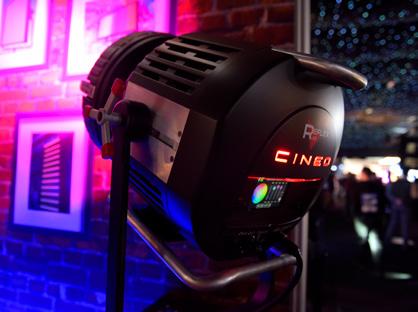
2,700K-10,000K. The interchangeable bi-colour LED Tower allows for customisation with quick release optics and easily-added accessories. The reflector makes it possible to create sharper and brighter beams with an adjustable focus from 15°50°.
The Reflex R15 provides 90,000 lumens of colour-accurate lighting, Also replacing traditional fixtures, this hard light has a spot-to0flood adjustment from 15°-75° providing beam control like no other light. It creates a single high-quality shadow at any beam angle, with a flat exposure level across the beam, and can be run on a 20amp circuit, with flicker free 10,000fps. The touchscreen interface allows users to create looks and effects that would otherwise involve a lighting console, plus hours of programming.
ROUND-UP•BSC EXPO 2024 48 MARCH/APRIL 2024 CINEMATOGRAPHY WORLD
INNOVATE ENGAGE CONNECT

18TH JUNE 2024
GLASGOW SEC
WHERE PRO-VIDEO, AV, CORPORATE & BROADCAST MEDIA TECHNOLOGY CONVERGE


EXHIBITION WAY, GLASGOW G3
REGISTER NOW FREE ENTRY KITPLUSSHOW.CO.UK

MANCHESTER MEDIACITY 24TH OCTOER 2024
8YW GLASGOW | MANCHESTER | LONDON
LONDON OVAL 27TH NOVEMBER 2024
ROUND-UP•BSC EXPO 2024
CIRROLITE - KINO FLO
Kino Flo’s Mimik 120 is impressive, designed to create full-spectrum, colour-correct lighting environments on virtual sets, perfectly mirroring an LED wall via the video signal, with the idea of helping realism in-camera.
Frieder Hochheim, Kino Flo founder, said the 7,200-pixel Mimik 120 mirrors video content, via a patented algorithm converting the incoming RGB video wall signal into four or more individual emitters – RGB-WW-CW – on the Mimik 120, generating synchronised foreground lighting that delivers utmost
LCA - CREAMSOURCE
There were many new and exciting products from Creamsource, well-known for their sturdy build quality and IP65-ratings. New additions were the 650W Vortex8 Soft and 325W Vortex4 Soft. When the fixture was switched-on, any questions about the need for soft lights were appropriately and beautifully illustrated. Also shown were yoke frames for combining two or three Vortex8 fixtures together.
Also, new, the larger 1,950W Vortex 24 was born from customer insights, and was designed for projects requiring three times the punch of the Vortex8. Equipped with dual 1Gb Ethernet ports
CVP
CVP’s stand had a more boutique feel this year, with a small seminar theatre, comfortable seating, and a very busy bar.
“A lot of people come to the BSC show to network and see what’s happening in the industry,” said Jon Fry, CVP group sales director. “So along with our stand, we’ve also got all our kit and all our tech consultants in our phenomenal facility in Great Titchfield Street. We’ve been ferrying people from there to the show, where we have all the non-gear stuff that CVP does.”
DEDOLIGHT
realism on virtual sets. With a lightweight carbon fibre frame, the Mimik 120 can be stacked like a video wall, flown as a ceiling, or put on traditional lighting rigs. It is controlled by the Megapixel VR Helios LED processor. The
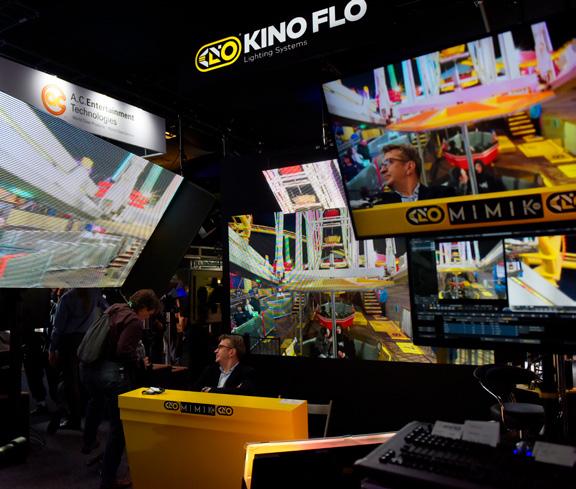
lamp delivers a huge 10,000 nits of brightness, plus the ability to shoot as high as 900fps. One processor controls up to 2,100 panels, that’s over 15-million pixels with zero latency, and the Mimik 120 can be synchronised up to 30 kHz to eliminate flickering and support VR technologies.
Hochheim said, “We believe Mimik’s capabilities are a game-changer for virtual production, and it’s great to have our efforts acknowledged with three prestigious awards from HPA, NAB and Euro Cine Expo.”

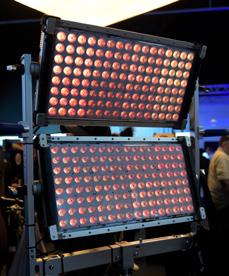
with a builtin Gigabit switch, enables singlecable runs and daisychaining of units for efficient light array management and control with protocols like sACN. The Vortex24 allows for easy swaps of diffusers and accessories with dual front-mount rails for simple modifier adjustments. A medium flat diffuser is included for immediate light softening. There are 24 directional pixel zones for lighting effects, allowing previously
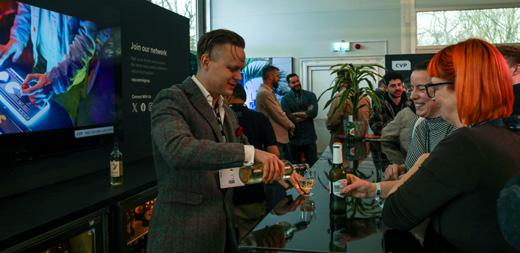
That ‘stuff’ is approved warranty repairs on behalf of 14 manufacturers, used equipment sales/ purchasing, consignment sales and financing, plus seminars and workshops.
complex simulations like fire and motion, with smooth dimming across all intensities.
The RRGBBW (red+deep red, green, blue+royal blue, white) LED configuration outperforms many traditional RGBW set-ups, and enriches red saturation, enhances warm whites, allows for deeper and brighter blues, and improves the quality of cool whites.
The Creamsource Colour Management System (CCMS) unifies Vortex and Micro fixtures with a unique LED mix, ensures consistent light output across devices, maintains colour accuracy at all dimming levels, and compensates for colour temperature changes.
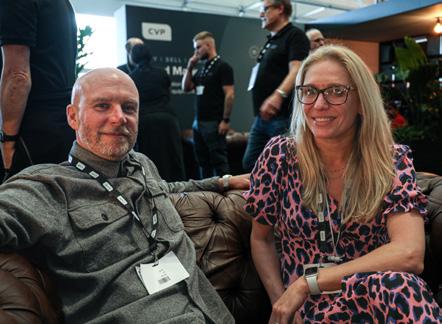
Fry expressed optimism about the industry,
Dedo Weigert, founder of Dedolight, was on the Cirrolite stand surrounded by many of his unique and classic inventions which became ‘must-haves’ in the business. These concepts have been awarded twice with technical Oscars and an Emmy, amongst many others.
DE SISTI LIGHTING
DP Vittorio Storaro AIC ASC, along with his daughter Francesca, conceived a series of LEDs, called ‘The Muses Of Light’, based on the functionality of the lighting in modern figurative arts and realised by De Sisti. Space doesn’t permit a full discussion here, but hard lighting fixtures are named Aurea, Calliope,
DOPCHOICE
Headquartered in Munich, Germany, DoPchoice has provided a fresh take on light-shaping accessories since its founding in 2008 by DP/inventor Stefan Karle. Creating a stir at the show on LCA’s stand, was the brand-new inflatable Snapbag Airglow, designed for popular 1x2 LED panels, inspired by gaffers and cinematographers.
Airglow produces super-soft, indirect lighting, and is well-suited for fixtures, like Creamsource Vortex8 and Vortex8 Soft, ARRI SkyPanel X21 and S60 Classic, and most
Many people came to have a talk and literally everyone there said they had a kit of at least three original 12V or 24V Classic Aspheric Dedolights. The Dedolight Neo Color is the result of technological cooperation between Dedo Weigert Film and Prolycht. It features the superior six-colour management technology, engineered

Clio, Melpene, Terscore, and soft lights are named Talia, Euterpe, Erato, Polymnia and Urania.
As an example, Polymnia is a 210W

citing increased quoting and potential for diversification, but also observed that talent shortages and skill gaps are a recurring knockon effect of downturns in high-end TV and film.
CVP’s workshops and showroom could provide opportunities for existing professionals to upskill and network, he stressed, and for new talent to enter the industry. “That’s also why we’ve got the bar at BSC Expo,” he added. “If you want to bring a lot of people together all in one place and create a networking opportunity, you just pay for the bill.”
by Dr. Anqing Liu in his Hyperlight Engine. The red, green, blue, amber, cyan and lime engine gives the widest possible colour gamut available today.

50x50cm head in the shape of a Pentagon, with a CT between 2,700K and 6500K and a beam angle of 28°. The Tersicore is 960W 100x100cm square light classed as a spot with a 16° beam.
Many other fixtures were on show, but the Twister two-ended head, with an 82° beam flood at one end and a 480W Fresnel on the other, was interesting!
similar-sized fixtures. As with all DoPchoice gear, it is lightweight and quick to set-up – as simple as looping the anti-spill cover over the fixture and snapping the buckles closed on two adjustable straps.
Airglow creates a 45° triangular bounce, with the back wall forming the hypotenuse angle to push light out the perpendicular side. The back wall can be swapped from Ultra Bounce to Hard Silver Diffusion for punchier illumination and also bleached and unbleached muslin. You can also add the Snapgrid LCD 40°, Quarter, Half or Magic Cloth diffusion to further increase softness.
50 MARCH/APRIL 2024 CINEMATOGRAPHY WORLD
EMMYLAND
The independent, female-founded, boutique rental house created a special interactive installation experience, with a bright pink stand, lit with rainbow and neon signs, juxtaposed with a video wall of 20 CRT Seleco monitors. The monitors
FIILEX
Fiilex has introduced the new G3 Color, a 90W LED Fresnel ellipsoidal to add to its collection of other fixtures, like the 175Watt Q5, the 320Watt Q8, and the 990Watt Q10 and more.
At the core of the G3 is the latest generation of Fiilex’s patented Dense Matrix LED that adheres to the highest standards of dimming and colour calibration. The G3 Color is a cinemagrade 90W full-colour ellipsoidal with
GBCT - GUILD OF BRITISH CAMERA TECHNICIANS
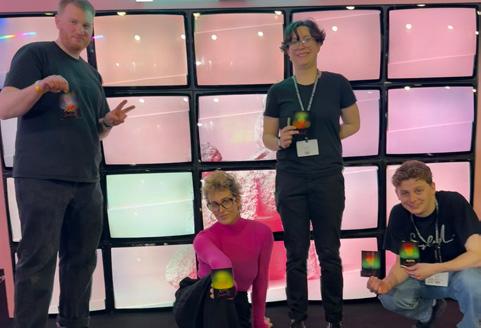
showcased imagery from the company’s extensive equipment inventory, as well as live feeds from cameras being exhibited.
A showstopper was a photo booth, which allowed visitors to have their aura photographed

The GBCT is a non-profit organisation of toptier film and TV professionals. It noted another challenging year, with the strikes hitting an industry already battered in 2022 by retrenching streamers. However, positive signs are on the horizon and things are expected to pick-up soon.
Running its own training schemes, the GBCT is still seeing a healthy number of new people
GODOX
The MG1200Bi KNOWLED is a 1,200W bi-colour IP54 LED head with a range of colour between 2,800K to 6500K and some interesting features. There is a 0.1% cinematic level adjustment for the head – the power source can be adjusted by the finest gradations, allowing for smooth dimming from 0.1% to 100% with increments of less than two watts.
using AI technology, based on the history of aura photography throughout the 20th century. Visitors were able to take their aura photos home and place a second copy on a photo wall celebrating their visit. All was captured live on-camera and sent to the CRT screens, creating a unique, interactive video art installation soon as you entered the show.
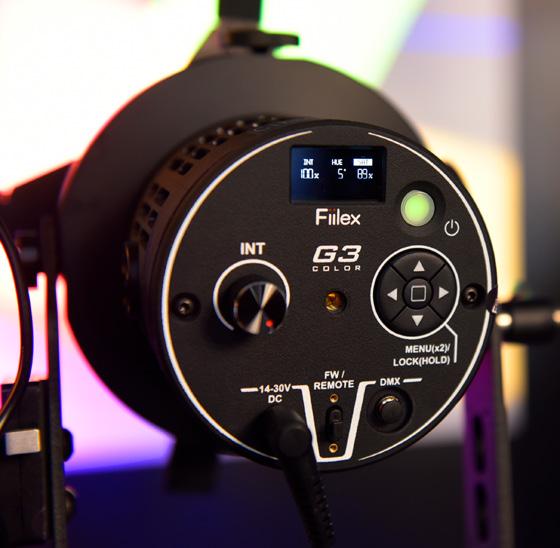
coming into the industry, but has seen a downturn in demand for technicians and trainees, due to the general downturn in the industry.
With a history of courses going back 30 years, the GBCT has had a big push over the last year to rewrite and update all of its curricula, reflecting an industry that is constantly changing. Its membership now represents a wide range of skills within the camera department, and its crew directory gives rapid access to this pool of talent.
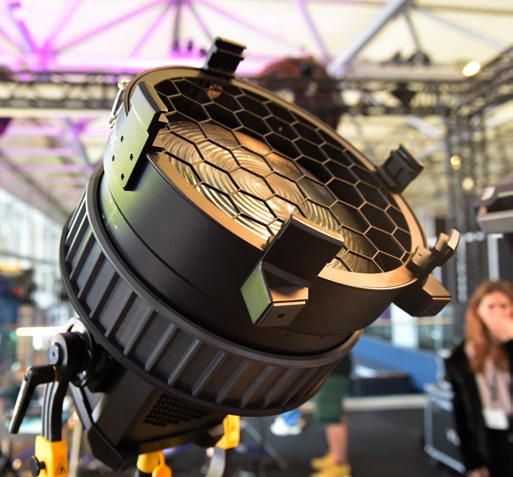
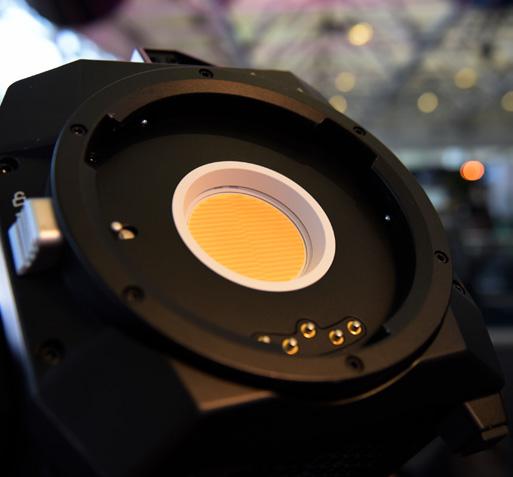
Also, the G-mount introduces a safety feature that turns-off the head when changing, and is compatible with the MG2400Bi head below. There are brand-new reflectors in angles of 15°,
GREEN VOLTAGE
Green Voltage showcased its green mobile power solutions, including its new 11K Voltstack. Having gained success with its 5K Voltstack, the 11K Voltstack battery product is robust-enough to be either strapped to a forklift or on the back of a low-loader, dragged across a field or placed in the middle of a splash zone.
The product bridges the gap between the 5K
GRIP FACTORY MUNICH
GFM showcased its GF-Primo Ultra Dolly and GF Mod Jib that have been well-received at previous shows. The GF-Primo Dolly now offers crab and conventional steering, making it one of the most versatile pieces of kit around, especially with GFM’s attention to detail and engineering. Reflecting on the slowdown of the industry due to the strikes, CEO Sean Magee said it had
razor-sharp cuts. Both the G3 19° and the G3 36° lens tubes are lightweight and use precision glass optics to give the sharpest cuts, with light that is uniform and bright without any noticeable colour-fringing. The head has a rotating barrel, so the shape can be rotated 360°.

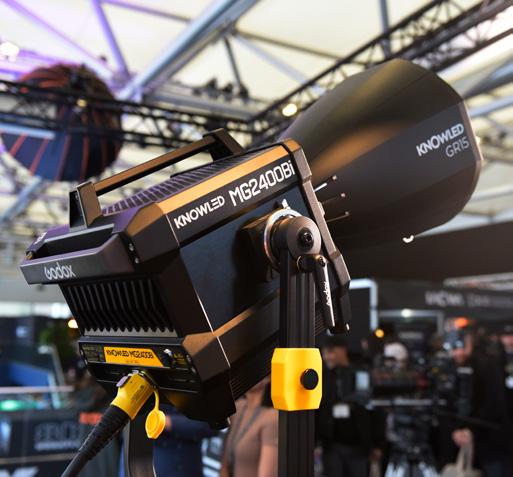
30°, 45°, and 60°, along with a 14° Fresnel lens, a projection attachment, lantern, with parabolic, strip and octa softboxes in various sizes.
The MG2400Bi matches the output of traditional 4K Par and 6K Fresnel lights with a 2900W input and cutting-edge COB technology, giving 4,400Lux at 10m @6500K with 45°
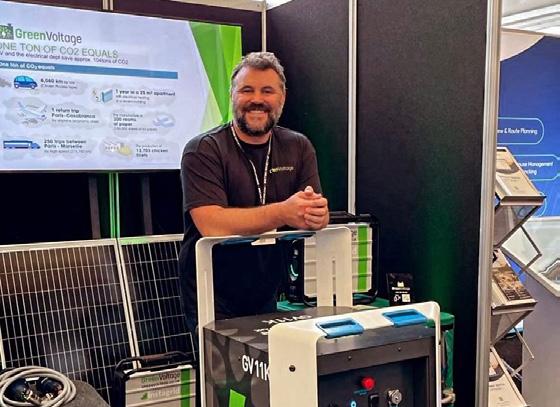
and Green Voltages’s hundred kilowatt units, offering a sustainable power option for filmmakers.
fortuitously given GFM breathing space to tackle back-orders and to reduce lead times. The level of attendance at the show was really heartening and Magee reported how valuable it was to meet existing and customers at the show.
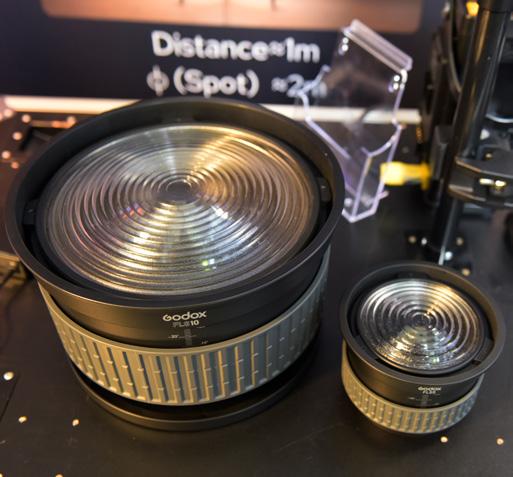
reflector.
Both the MG1200Bi and MG2400Bi include CRMX, DMX, Ethernet, Bluetooth, on-board, and removable panel control. Additionally, MG2400Bi can be controlled through the all-new KNOWLED App.
Founder Adam Baker said, “Gaffer and cofounder David Sinfield and I work in the film industry. We’re on the floor, we see what people want and what they need to use. Obviously, it’s important that the product works, but we also want it to be something people want, not something they’ve been told to use because simply because it’s sustainable.”
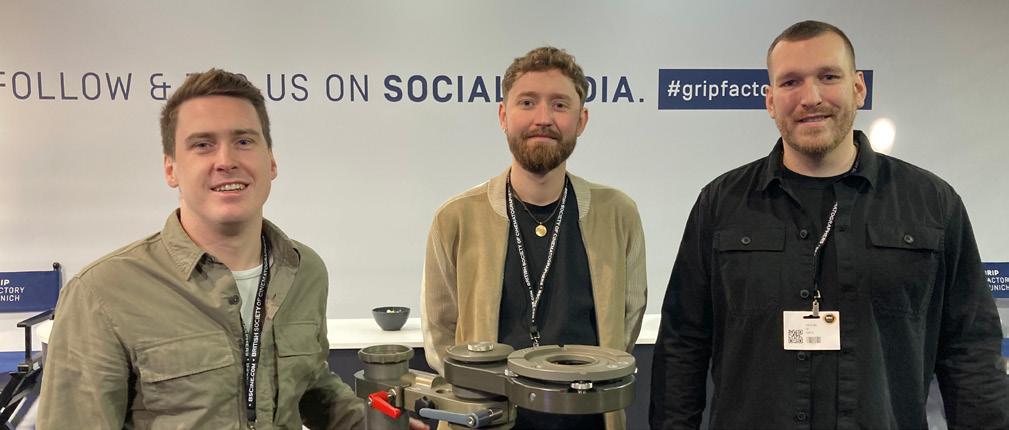
CINEMATOGRAPHY WORLD MARCH/APRIL 2024 51 BSC EXPO 2024•ROUND-UP
K5600 (ONE STOP)
The Alpha 300 is based on Alpha 800 HMI, and provides shadow/Fresnel shade quality comparable to traditional Tungsten or HMI lamps. The beam is adjustable from 5° to 55°, and there is a removable 175mm diameter lens for even brighter light. It is constructed from exclusive 14mm LES (Light Emitting Surface) allowing for the perfect light to lens ratio, and designed with the PlanoConvex optic which directs more light forwards for a brighter, more even light, with a unique 600W dual-colour matrix chip, 300W max output, from 2700 to 6500 Kelvin. Wired and wireless DMX compatibility uses Lumen Radio protocol.
The 300W single ballast has all components and controls contained in a compact housing. The
KODAK
The lure of analogue film for visual storytelling saw a constant stream of visitors to Kodak’s stand. It’s been a bumper time for films shot on Kodak, highlighted by the predominance of film-originated productions earning Oscar, BAFTA, ASC and BSC nominations for best cinematography during the 2024 awards season.
These include: Rodrigo Prieto AMC ASC for Killers Of The Flower Moon; Matthew Libatique ASC for Maestro; Hoyte van Hoytema NSC FSF ASC for Oppenheimer ; Robbie Ryan ISC BSC for Poor Things ; and Linus Sandgren FSF ASC
LCA - ROSCO/DMG LUMIERE
LCA is celebrating its 25th year. One of the most interesting fixtures on show was the Rosco DMG Lion, a powerful, flexible, 13-inch, all-weather Fresnel, utilising cutting-edge technology to replicate the look and feel of a classic Tungsten Fresnel, but with the versatility that LED technology provides.
A unique feature is two easy-toswap LED engines. One utilises Rosco’s patented Mix LED Engine for full spectrum output
LEITZ
LCD screen displays the functions of colour temperature control from 2700 to 6500 K, dimming from 1 to 100%, DMX selection / termination and automatic detection.
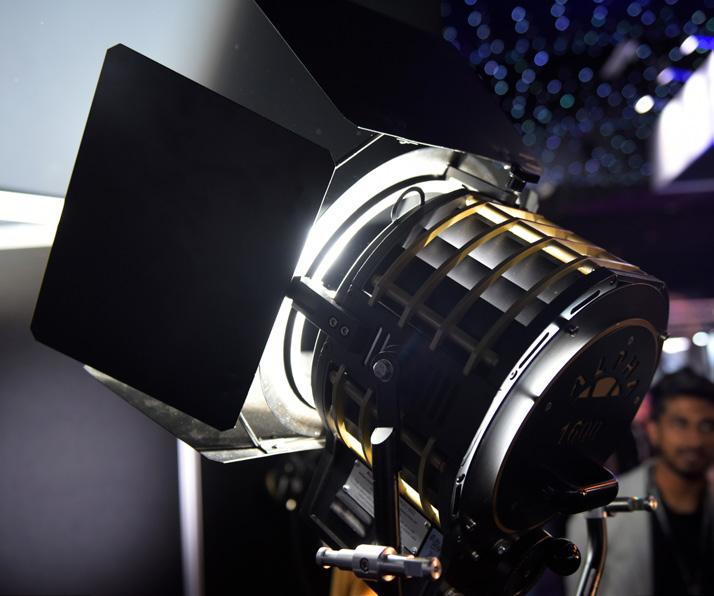
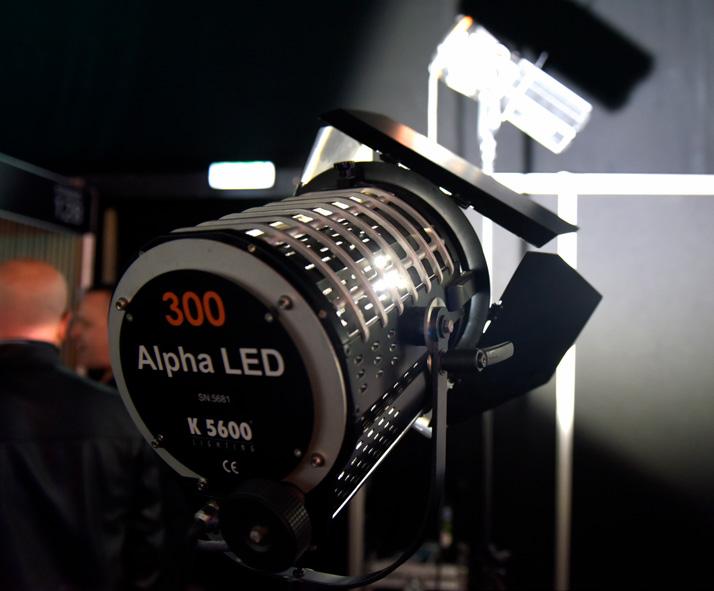
for Saltburn. And there are plenty more films shot on film coming to screen near you, including The Bikeriders (DP Adam Stone), Challengers (DP Sayombhu Mukdeeprom), La Chimera (DP Hélène Louvart AFC) and Twisters (DP Dan Mindel BSC ASC SASC).
Kodak also displayed its Super 8 movie camera, featuring a 6mm F1.2mm C-mount lens, extended gate 1.5:1 aspect ratio (or 3:2) capture at 18, 24, 25, or 36fps, plus a 4” LCD that can display aspect ratio overlays and audio meters. Priced at $5,495 USD, it’s currently only available in the US, but will become available in other

1700K-10,000K.
The other unit is the Punch LED Engine, a bi-colour LED engine that produces maximum intensity between 2700K-6500K. This LED engine uses the same patented, six-chip Mix
countries, and you can reserve one by visiting Kodak’s website.
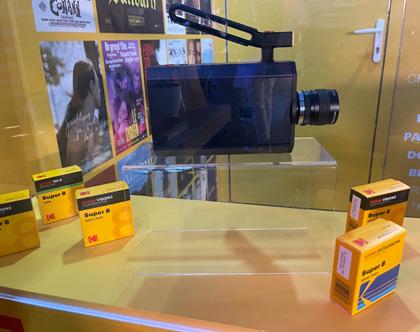
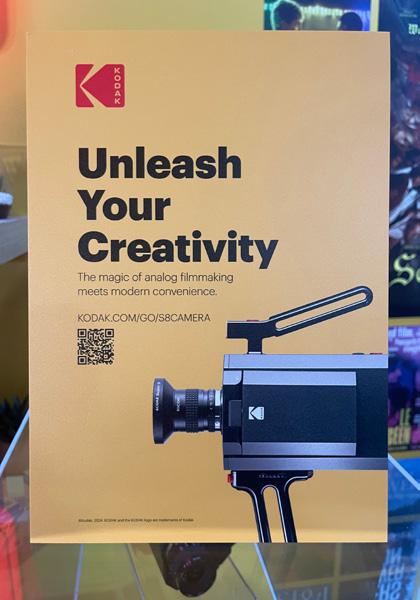
Technology (red, green, blue, lime, amber, 4K white) used in the existing DMG Lighting soft lights. So the Mix LED Engine renders superior skin tones in White Light Mode with a colour temperature range of 1700K - 10,000K. The Punch LED engine has twice as much output as the Mix engine. When set to 3200K, this produces as much output as a traditional 5K tungsten - but only uses 1,000W of power. This means it can be plugged into a standard wall outlet. This LED engine also features red and lime Mix LEDs for plus/minus green corrections.
The latest from Leitz is the Hugo range of lenses, designed to be fast, lightweight and small, derived from M-series photographic glass and the M 0.8 range that are so adept at capturing character and personality in an image. The original set of seven lenses, which range from 21mm to 90mm, have been augmented with a new 18mm and a 135mm, both with small footprints.
The difference to the M0.8 is that they have an extended focus roll, traditionally this was only 90°, but now it is extended to 270°. They all run at T1.5, except for the 135mm, which is a T1.9. They fulfil demand for lenses with closer focus, whilst being small, lightweight, compact and fast. A new iris has been added in the back of the lens housing to give a more circular iris movement.

LIGHTBRIDGE
Founder Jakob Ballinger has a laser-like focus on the Lightbridge range of cine reflectors being streamlined towards a perfect workflow “because only when that’s optimised do we actually have a chance to do great lighting,” he says.
“The past year has been interesting for all of us, and I thought we have to do something else. The photography industry was already interested in us, so we thought, OK, let’s pivot a little bit and see
what we can do for them. So we started to develop a product for beauty light, and when we had our first prototype, it was like, ‘Wow, this is going to be so perfect for the film industry too.’”
“The gear has to be perfect, the kit has to work and it has to be intuitive. It has to be silent too, so that nobody’s disturbed by making changes. Twenty years of mind-set as a gaffer has gone into what I want to achieve with Lightbridge as a company.”
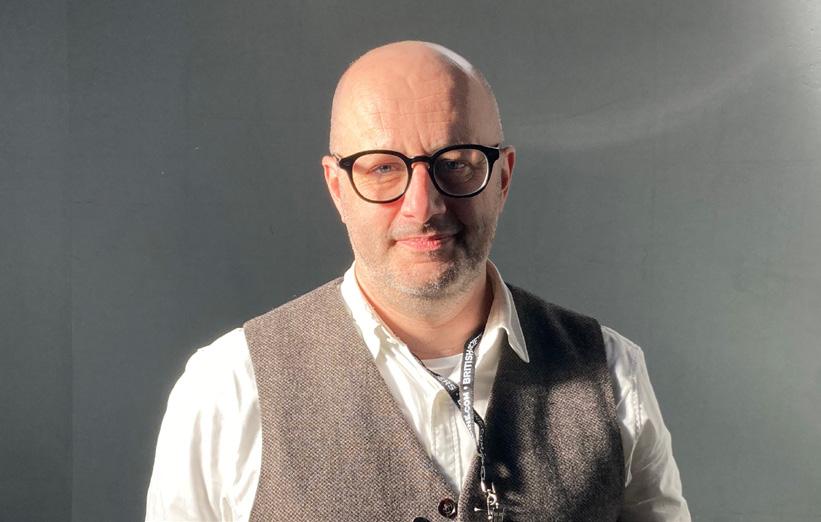
ROUND-UP•BSC EXPO 2024 52 MARCH/APRIL 2024 CINEMATOGRAPHY WORLD
LITEGEAR
LiteMat Spectrum panels have been designed to be lightweight, rigid, ultra-thin and easy-to-rig. The evolution of the LiteMat Spectrum now includes a more robust design in a fixture that will meet many lighting needs now and into the future. The range is available in different sizes: 50W 11.6 x 21.1-inch; 100W 21 x 21-inch and 100W 11.6 x 40-inch; 150W 21.1 x 30-inch; 200W 21.1 x 40-inch; and new LiteMat Spectrum 8 400W is the largest at 40 x 40-inch.
MATTHEWS STUDIO EQUIPMENT
MSE has been innovating and developing grip equipment for over 50 years and continues to innovate. Company president, Tyler Phillips, was at the show to launch the Grip Rail, a multi-purpose, multi-functional, telescoping, pipe grid, grid pipe, scaff pipe and speed rail.
“Everybody’s got a different word for it,” said Phillips, “but it’s a telescoping pipe with different
MOTION IMPOSSIBLE
On show was the Gen 2 version of the Agito robotic camera platform, which CEO/co-founder Rob Drewett said the company has been working for at least three years.
“It’s got silent steering, much stronger power distribution, and more intelligence inside it. It is also now watertight, rated at IP54. Our redesigned controller has haptic feedback, a bigger screen, many more buttons, and has given us the ability to integrate lots of third-party heads into our ecosystem.”
NANLUX
The Evoke 1200B bi-colour uses 2 x 1200W LED chips in dot matrix form. This achieves a high light efficiency, with an output of 18,570 Lux @3m and 5600K with a 45° reflector. This beats the 1.8K HMI Par or a 2.5K Fresnel. The impressive frequency means shooting is possible at 5,000fps with no flicker.
The specially-designed Fresnel FL-35YK with NL Mount, is compatible with the Evoke 1200 series. With a new centre-mounted yoke it offers a more balanced orientation, and a non-rosette locking hinge allows for a smooth tilt movement.
Lighting control is 0-100% in 0.1% increments for precise fine-tuning. 26°, 45° and 60° reflectors, along with parabolic, octo and square
LiteMat Spectrum 8 features include: smoother low-end dimming between 0 to 100% continuous when paired with a compatible LiteGear dimmer; eight mappable large format pixels; precision-calibrated electronics; updateable pixel-driver firmware; and a colour temperature range of 2,000 to 11,000 Kelvin. At IP20 they are only safely-used for interiors, but with suitable power and weather they can be used anywhere.



diameters based on which part of the world you are in. We’re showing the 48mm spec version, which we call inch-and-a-half in the US. Its use is anything you can dream-up that requires the use of a pipe. It allows you to leave the saw in the truck when you need to cut the pipe down just a little bit shorter, or you can pull it just a little bit longer if your just slightly too short.” And that really does sum up this ingenious time-saving device, plus it’s totally sustainable.
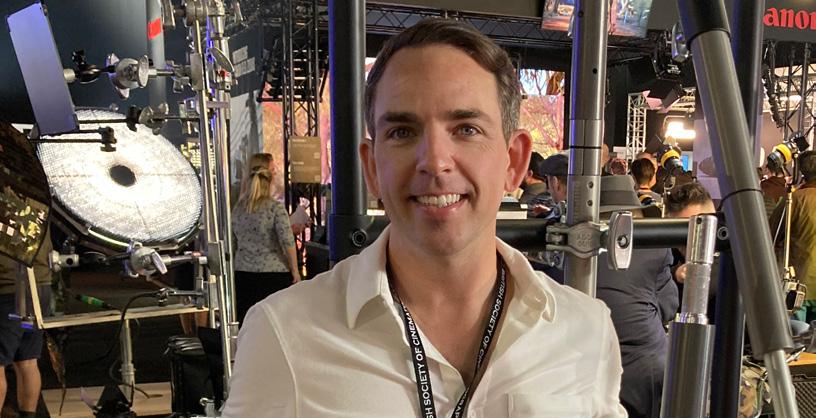
The show also saw the UK debut of Agito Cine, a heavier-duty dolly system with a larger core, expanded wheelbase, and increased ground clearance. It’s available only as a rental option, provided by Camera Revolution in the UK, and the model on display carried a full-size Shotover M1 on a low-level stabiliser.
“You can put up to 150kg on the Agito Cine, whereas the Agito can take 70kg,” said Drewett. “But it’s still got that finessed feeling, but with much bigger payloads.”
softboxes and lanterns, are available. An hermeticallysealed unit gives an IP54 rating.

OCTICA
The Velvet Kosmos 400 Studio and Location fixtures have been workhorses for many since their launch, now the Kosmos 1000 joins the range with a 5K Tungsten-equivalent fixture and some impressive features.
The optical system utilises a motorised zoom, a borosilicate 350mm/ 14-inch glass Fresnel
OPTICAL SUPPORT
Camera stabiliser specialists Optical Support remarked on a really good level of foot traffic during the show. Sales manager Ross Johnstone remarked, “As a London-based Steadicam specialist, BSC Expo is our flagship show. We catch-up with a lot of people that we have been friends with for 20 years and we’ve had a great

lens with a beam angle of 13° to 56°. The light intensity is smooth between
response on the showfloor.”
Though the last year has been tough, the company admit to have been fairly lucky. “We rent stabilising equipment, service lenses and Steadicam gear. We also sell equipment as well as Preston accessories. So we have a lot to offer and luckily we were able to still keep functioning. I imagine the pressures have been bigger for people who only
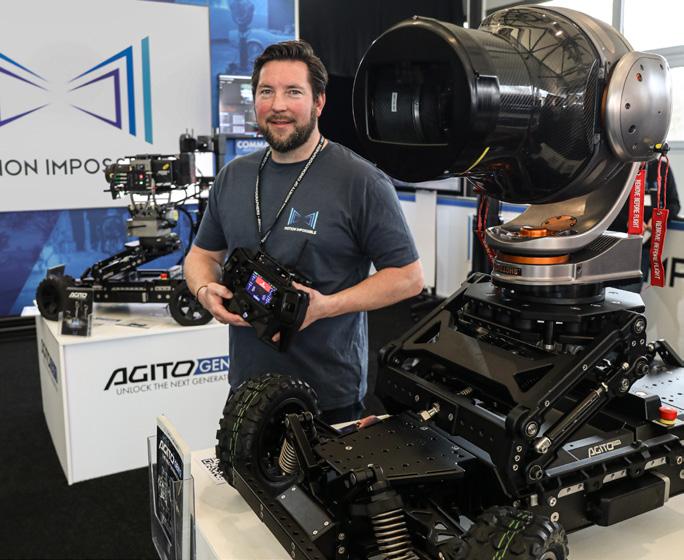

0-100% with four selectable dimming curves, with the potential to shoot up to 12,000fps flicker-free. The light engine is a 35mm full colour spectrum R+G+B+W+CW Velvet ceramic LED and is continuously adjustable (full plus green to full minus green). Cooling is achieved with a passive liquid cooling system into a sealed 3D chamber with silent fan, and the unit weighs-in at 25kg.
rent equipment. It’s also given us time to really sit down and work on the projects that were important to us.”

CINEMATOGRAPHY WORLD MARCH/APRIL 2024 53 BSC EXPO 2024•ROUND-UP
PANALUX
Panalux showed the growing family of Sonara and versatile Allegra softlights, lighting a small film set complete with talent, allowing visitors to see the effect of the lights and experiment with a range of different lenses from Panavision.
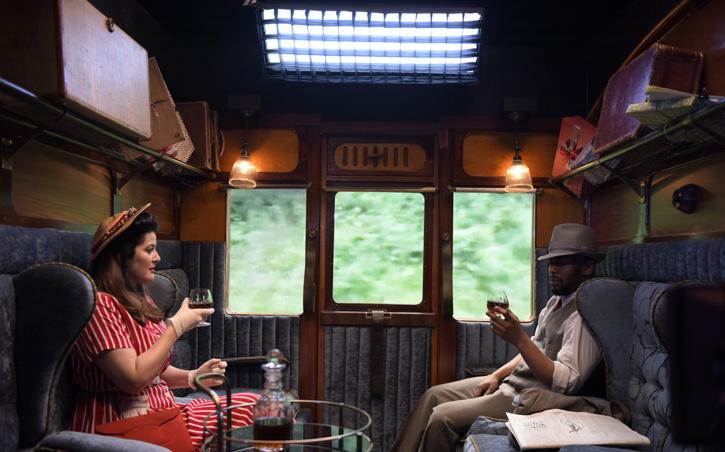
Also on display, and lighting the stand, were products from the Rodlight Spectron range including the impressive 10m units and the Kosmos 400 focusable Fresnel from Velvet.
PANAVISION
Panavision’s stand drew a lot of interest, decked-out as a camera/lens test area and film set, lit by Panalux.
“We’ve got a carriage set with actors, an
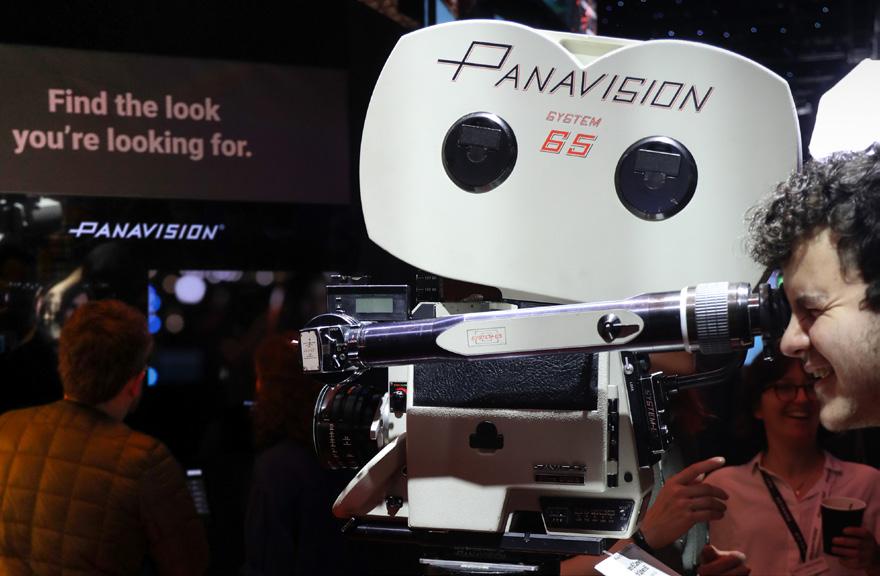
POWER GEMS
A modest pink table lamp, seemingly outof-place on the Power Gems booth, attracted attention throughout the show. Patrick McGuane, owner of Power Gems, explained, “We hid the completely-wireless GEMboost and GEMmicro inside an ugly-chintz lamp to demonstrate how easily they fit inside props for set and stage.”
The GEMmicro is a four-channel LED drive
RED DIGITAL CAMERA
Red showed brand-new ‘X’ versions of its Raptor and Raptor XL cameras, featuring global shutters. One particular benefit is ‘extended highlights’. Supported by RedCine-X Pro for RAW footage, an algorithm combines a lower exposure shot with the main exposure to preserve colour data in high-contrast scenes.
“We still have the same amount of dynamic range as before, but extended highlights are like the cream on the top,” said Marc Cattrall, EMEA
SONY
Sony’s new Burano camera was a big draw. “It shares a lot of the user-experience of how people work with a FX6 or a FX9, but with the image quality you’d expect from a Venice,” said Daniel Listh, cinema business development manager, Sony Europe. “It has tools for solo cinematographers shooting in unpredictable environments, such as autofocus, an electronic variable ND filter that will do an auto exposure for you, and on-board audio.”
Solo shooters at the Expo took advantage of a demo backpack set-up supporting a Sony Venice 2 8K with Rialto extension system. Also on show

“It is fun to be able to use the lights in a real-life environment and show how the quality of the spectral output and excellent colour rendering play on a range of materials, fabrics and skin tones,” said technical director and long-time LED fixture
ARRI Alexa 35 and Sony Venice 2 with Panavision lenses and accessories, plus Panalux lighting and a virtual screen going behind,” said Terra Bliss, MD of Panavision camera/optics for UK & Ireland. “We’re
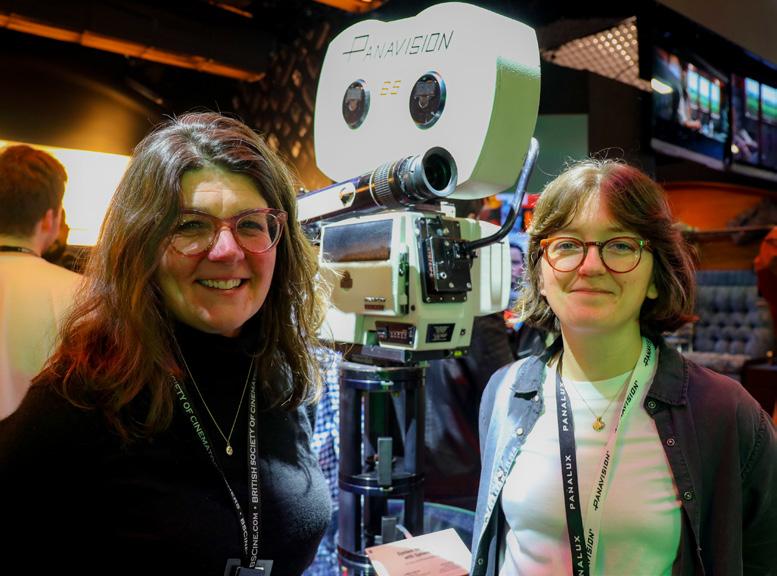
with wireless DMX control and over-current protection to drive off-the-shelf LED Ribbons and COBs. The GEMboost does what it says on the tin; it will boost 2.5-6V from a Li-ion cell or USB power bank to a fixed 12V supply, up to 15W of compact built-in power. Some of the biggest names in the UK rental market have placed orders, impressed by the possibility of embedding GEMmicro and GEMboost as bare PCBs in their
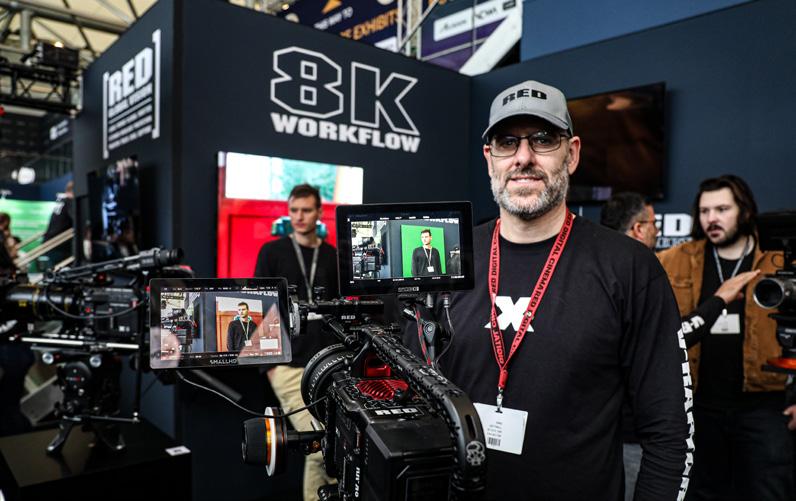
from Sony was the newly-launched Verona Crystal LED, suited to in-camera VFX.
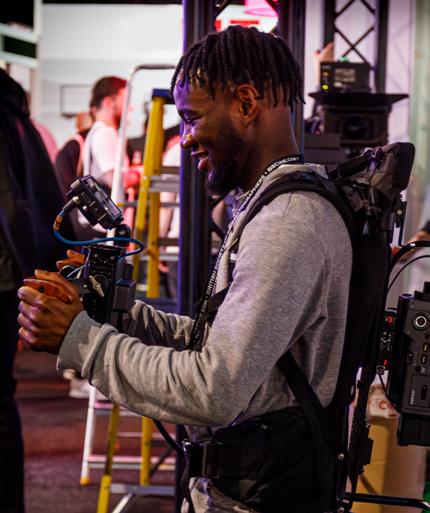

designer Dave Amphlett.
Outside the venue, Panalux showed off a cranemounted, custom-made soft cube designed and manufactured by its in-house textile department, illuminated by nine Creamsource Vortex 8s.
trying to give everyone a simulation of what it would be like on set, with monitors for people to compare the looks.”
A Panavision System 65 camera with Sphero 65 lens as used on Oppenheimer, and the Panavision Millennium XL2 and Primo Prime used on Saltburn were both popular on the stand.
A further pull was a Lens Comparison system. “Our team has gone through and shot all of the different lenses we have, so you can do left and right comparisons against each other on two screens,” said Kate Priestman, technical marketing, Panavision. “You can choose a vintage optic like a C-series Anamorphic versus a more modern T-series Anamorphic, and sync them up to show their different attributes, such as bokeh, flaring, how each deals with skin, halation, and so on.”
configurations for on-set practicals.

marketing manager. As the technology is still in beta there’s some chance of ghosting, but Cattrall says work is on-going to eliminate such artefacts.
“We’re not just blending two frames and hoping for the best - there’s a lot of work going on to track movement through the frame. We’ve also given the SDK to the other NLEs.”
Another global shutter-based innovation, Phantom Track, records two separate frames simultaneously, making available a ‘clean’ greenscreen backup shot for virtual production.
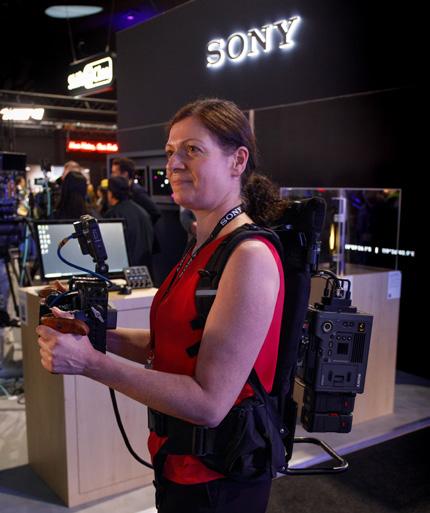

“We’ve had a lot of engagement with clients interested in the Verona panel,” said Listh. “They can see the image quality has increased, the black levels are darker, and that the mechanical design benefits for building LED walls/volumes for a project without much hassle.”
ROUND-UP•BSC EXPO 2024 54 MARCH/APRIL 2024 CINEMATOGRAPHY WORLD
SUMOLIGHT
The Sumomax full-spectrum (RGBWW), 1,80010,000K, 500W high-output product is designed to be used in virtual production as an interactive lighting tool. Modular and versatile, it can punchout 107,000 lux at three metres, and can perform as a keylight, hardlight, punchlight, spacelight or softlight. Cooling is fanless.
The hexagonal SumoSpace+ 16,000 Lux, 400W fixture, has ultra-high colour rendition, with a TLCI of 99 and CRI 95, and can be used as a space light, a reflector or a softlight. It is silent and passively-cooled with no fans or moving parts.
SUNBELT RENTALS
Still on green filmmaking, the film and TV arm of Sunbelt Rentals hosted a keynote seminar on sustainability.
“We’ve built sustainability technology into construction and events, and we’re now able to put that into practice in the film and TV industry,” said Sunbelt’s Jenny Clark who looks after film & TV client services, events, partnerships and sponsorship.
“Sunbelt Rentals is a patron of the BSC and for the last six months, I’ve been working with the BSC Sustainability Committee. They’ve got a real opportunity to influence cinematographers and gaffers.
“In terms of investment,
TIFFEN
With an internal power supply, plus the shape of the units, means they can be attached together seamlessly, and stacked efficiently when in storage.
The company’s Skybars were devised during Covid for image-based lighting. The Skybars can be hung overhead due to their very lightweight, and the colours are produced by a Class 2 Blue laser beam, which is an interesting trend developing. Each has a 175W 2° angle
Sumobeam is a new venture, with seven individual LEDs in a head that is extremely bright,
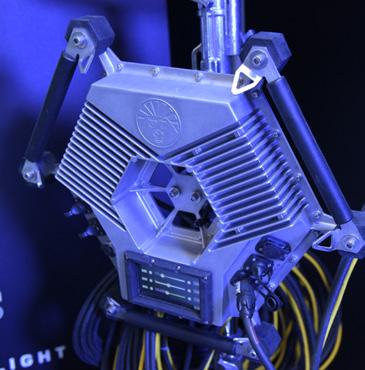

and has an extremely narrow beam with no falloff. The Scubamax is a cable-fed separate head designed to be used underwater. With an IP69 rating it can be used up to 15m underwater.

As well as ARRI rear-mount filters, such as Night Fog, Black Fog and Blue Streak, the company was exhibiting the Steadicam Zephyr Volt, “a lightweight rig that has control over the pan, as well as the roll and tilt,” according to Robin Thwaites, international director of sales, Tiffen International.
“It’s got electronic inertia, and it feels very
VIVENDUM
Videndum showed ranges of Sachtler tripods and fluid heads, OConnor fluid heads, lighting from Quasar Science and Litepanels, and Avenger arms and clamps. The company was also showing Anton/ Bauer’s Salt-E Dog, an IP55-rated 9kWh sodium-based mobile power solution, now started shipping in Europe.
“It replaces a diesel generator, but it’s
ZEISS
we’ve got a new depot coming in London. We’re going to start moving-in there during the spring, but won’t officially launch it until September. We acquired Acorn Film & TV in November last year, joining previous acquisitions Movietech, PKE Lighting, Alpha Grip and Media Access Solutions. Some of the projects we’ve recently been involved with are Masters Of The Air, Sexy Beast, and Mr. Bates vs The Post Office.”
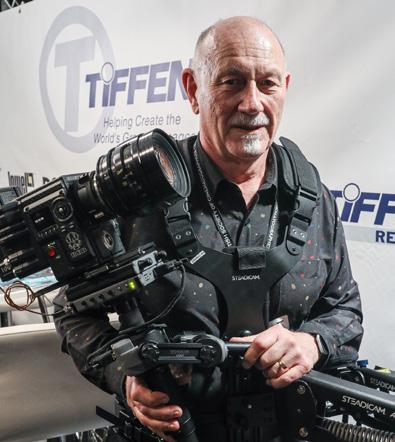
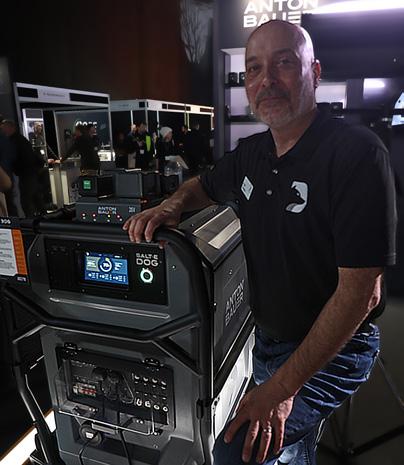
Zeiss showed its brand-new, high-speed, compact Nano Primes, a set of six focal lengths –18, 24, 35, 50, 75 and 100mm – all at T1.5.
“The whole concept of the lens has been designed around the short-flange focal distance of the mirrorless cameras,” said Benjamin Hagen, cinema products of marketing manager, at Carl Zeiss. “Initially they’re available in Sony E-mounts, and now with the availability of the Sony Burano this could be a very good match, but we’ll most likely have more mounts for other cameras soon.”
Hagen said Zeiss started developing a lens set specifically for mirrorless systems four years ago. “To keep them at T1.5, but also compact, we had to go
natural in terms of using it,” he continued, “It’s a great way of being able to control the camera. You’re not constantly concentrating on holding level or holding a frame. It adds to the precision of the work and frees-up the parts of the brain that allow you to focus on framing.”
Thwaites also demonstrated
a sodium-nickel battery,” said Paul Dudek, VP of sales, the Americas. “There’s no lithium, so it can’t catch fire, there’s no shipping restrictions and it’s got a longer lifespan.”
The battery can be powered by AC, an EV charger or solar PV panels. “We’re seeing a lot of interest at the
to that short-flange focal distance. They all have a 95mm front diameter, and an 86mm screw-in filter thread, and iris rings and focus rings are situated together. They have a very pleasant look, with a nice fall-off that for some is reminiscent of Supreme Primes.”
Steadicam’s new G-70x2 arm, which is completely different from the older G-70x arm “apart from the springs. The profile is lower, we’ve changed the adjustments, and the lift control for the weight. There’s a bearing in the spinning post to give you the choice of either a bit of friction or completely free, and there’s a new connector block. The whole structure is more rigid, and it has all new bearings and trunnions, so it’s super smooth to use.”
show because of sustainability,” said Dudek. “You can gang two together if you’re running out of power. The display shows your connections and tells you how much power you’re drawing. If you put your start/end dates it tells you how much power you’ve used on-set for each day, so you can generate reports about wattage and carbon emissions.”

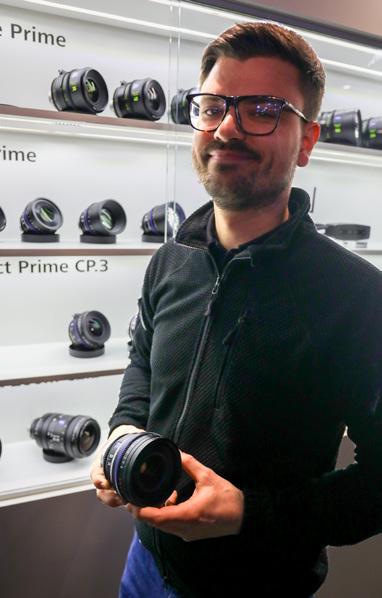
CINEMATOGRAPHY WORLD MARCH/APRIL 2024 55 BSC EXPO 2024•ROUND-UP

TALKING SHOP
By David Wood
Saturday of BSC Expo 2024 was busy, with thousands of filmmakers gathering to see the latest kit and to take part in a seminar programme debating the hot topics of the day. It was no surprise that top of the list was one of the biggest current innovations in filmmaking –virtual production.
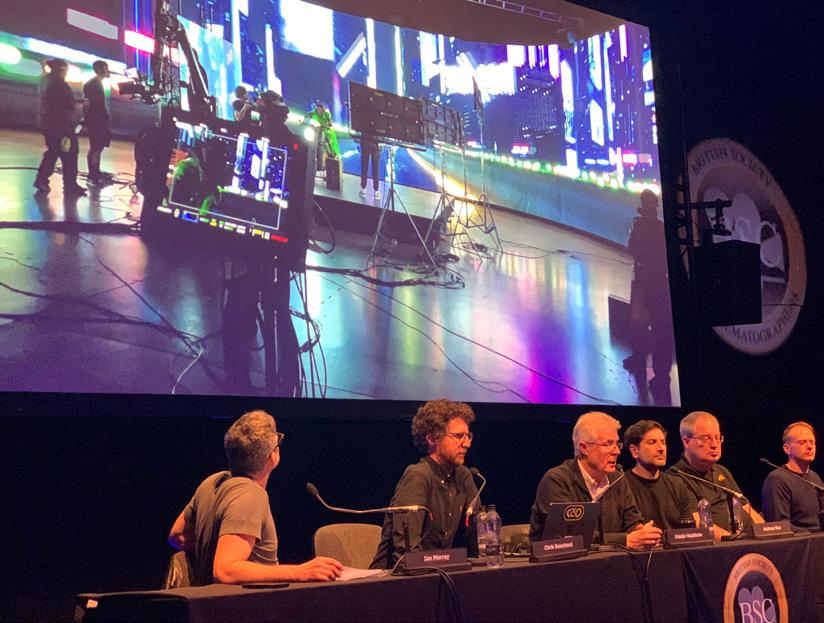
The first seminar focussed on advances in image-based lighting (IBL) for virtual production with a panel packed with some of the biggest names in virtual production – DP Ian Murray, Final Pixel’s Chris Bouchard, Frieder Hochheim from KinoFlo, DP Andreas Neo, Mark Primrose from KinoFlo and Megapixel’s Daniel Warner.
Murray and virtual production supervisor Bouchard led the discussion by describing some of the huge advances that have been made in
naturalistic lighting using LED volume sets. The results can be seen in TV and film work such as The Mandalorian (2019) (Bouchard worked on S3), The Batman (2022), Barbie (2023), Hijack (2023) and The Creator (2023).
“The use of realistic light reflections is a huge benefit, something that can be seen on The
The director/ cinematographer collaboration is still the closest on-set relationship
Mandalorian which benefitted from an LED volume set with a ceiling,” said Bouchard. Reflections on wet surfaces also produced beautiful effects, seen in recent shows such as Apple TV’s Masters Of The Air (2024), with natural lighting on faces of the combatants from VP sets, according to Bouchard.
The discussion then turned to the problem of magenta skin tone reflections created by some RGB lighting panels with limited colour spectrum. According to DP Andreas Neo, “Innovations such as
Kino Flo’s Mimik system, which have better colour outputs, much more like a video display, have been a big improvement. What we found was that skin tones on VP sets with RGB lighting were not quite
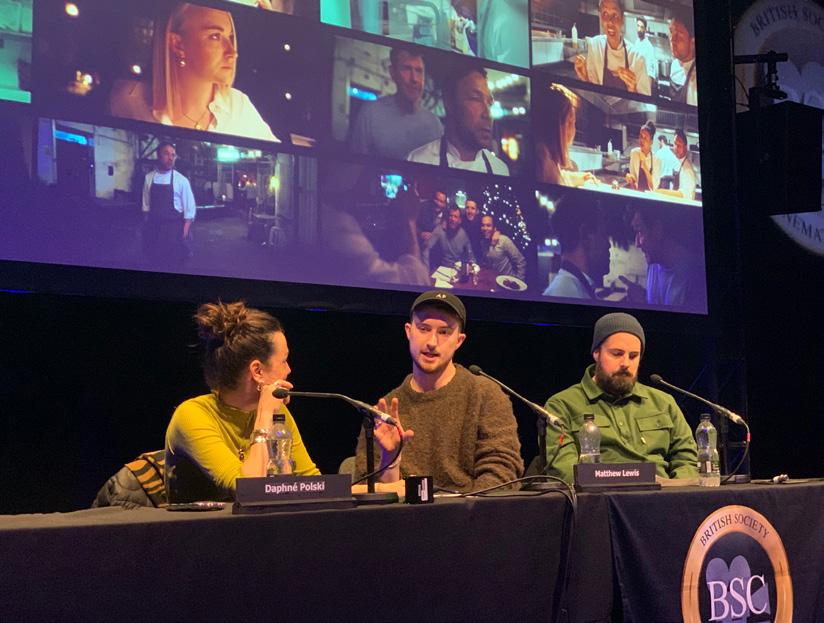
right. So we used Kino Flo Mimiks, which can produce 10,000 nits with a very simply workflow.
“Now we can shoot music videos at sunset where virtual production gives more flexibility in terms of time, and allows us to take advantage of the soft light wrapping around faces.”
The reality for filmmaking is that VP technology has reached a point at which it’s much more capable of creating great results with huge cost savings in production. But according to Kino Flo’s
56 MARCH/APRIL 2024 CINEMATOGRAPHY WORLD
ROUND-UP•BSC EXPO 2024
Frieder Hochheim, inventor of the Mimik panel, “Producers really need to understand what they’re getting involved with. You cannot apply the traditional production model to VP workflows, with little investment in pre-production and a big postproduction spend. This no longer works – you have to flip it.
“It also means that the DP has to come in at the start of the process and talk to the electricians. But show me one producer who’s prepared to bring a DP on one year before principal photography?”
Neo added that cinematographers were now needed at the start for ‘virtual scouting’. “DPs really need to be on board to pre-light the virtual environment. You have to visualise the actual shots and how you are going to move the camera.”
Bouchard added, “It’s all great, so long as you’ve done enough pre-production planning. It’s essential that the VFX supervisor needs to be there from the start to ensure the correct processes are adhered to.”
Later in the day Lux Machina’s Lauren Paul discussed how to make the most of VP with Markus Förderer ASC, lighting programmer Julie Förderer and production designer Jo Riddell.
Förderer revealed how on feature Red Notice the VP team was able to swap quickly between a helicopter set to a train set to a boat and then to a car. “All of the props were built on wheels and could be wheeled in, so we had a very productive two-week long shoot.”
One important part of the process with VP is the use of physical effects, added Förderer.
“You can add smoke, dust, lens flares – physical effects that typically have to be avoided on a greenscreen shoot. Playing with the physical elements helps blend the different layers and sell the illusion. So on car driving shots we added smoke machines that looked like dust being kicked off, and fans to give the illusion of wind and speed.”
More traditional aspects of cinematography were examined during sessions on the award-winning film and TV hit Boiling Point (2021 & 2023) about life behind-the-scenes in a pressurised London
restaurant, both directed by Phil Barantini, and then a retrospective look at the work of DPs including Billy Williams BSC (On Golden Pond, 1981; Billion Dollar Brain, 1967; and Gandhi, 1982) and Phil Méheux BSC (The Long Good Friday, 1980; and Casino Royale, 2006).
In the Boiling Point session, FilmLight’s Daphné Polski talked to cinematographer Matthew Lewis, who shot both the film and the TV series, and senior colourist, Dan Moran, who graded the TV series at Harbor.
DPs really need to be on board to pre-light virtual environments
They discussed developing the look of the TV series, based on the film that was famously captured by Lewis in one take, by contrasting two differentlooking worlds.
“There was the orange ‘fake heaven’ of the front of the restaurant, and the emotionally-charged blue ‘hell’ of the kitchen,” said Lewis, who added that Succession was an important reference for the series. “During post, we added lots of grain and other elements to give you that unconscious feeling of a film grade.”
Earlier in the day, BSC Expo delegates were treated to a detailed session focussing on developments in cinematography over the last 60 years, with big names such as Billy Williams BSC and Phil Méheux BSC showing clips from their films and describing how they matched film lighting with camera and lens technology.
Williams recalled, “In those days we struggled to find soft lights until Bill Chitty invented The Wendy at Shepperton in the 1980s.”

Williams described how he lit the famous naked wrestling scene between Oliver Reed and Alan Bates in Women in Love (1969). “When it came to the wrestling scene at Elvaston Castle in Derbyshire, we had a beautiful room with a large, log fire.
“We shot them with two handheld cameras and next day we recorded the dialogue as we had to contend with camera noise and a cracking fire during the shoot. I lit the scene as if the light was coming from the fire with a couple of 5K Fresnels each side of the fireplace with orange filters to bring down the colour temperature and an electrician waving branches in front of the lights for movement. It was important for the floor to be clear of lighting so we could do handheld shooting.”
“Camera chips back then weren’t that sensitive,” added Méheux, who detailed how he shot the final scene of The Long Good Friday in the back of a car along The Strand in London using ambient lighting and a lightbulb plugged into the car’s cigarette lighter.
The increased sensitivity of camera sensors has had a big impact on lighting, allowing the use of more softer lighting, agreed the panel, which also included Kate Reid BSC and Cineo Lighting’s Chuck Edwards.
Williams added that, “whilst lighting and camera technology has changed a lot over the years, the director/cinematographer collaboration is still the closest on-set relationship. They don’t have to be best friends, but they always have to work as a team to make a successful film. Some directors know where the cameras go and how to shoot scenes, some ask the cinematographer how they you want to do it.
“There no single way of doing things, but I’ve aways found that the directors I’ve had the best relationships with are always former actors – they understand the importance of performance.”
Kate Reid BSC, DP on Great Expectations, added: “DPs should be open-minded and flexible, creating a space for everyone, director and cast, to do great work. Don’t go in with a big ego but find out how the director works and try to adapt to support them,” she advised.
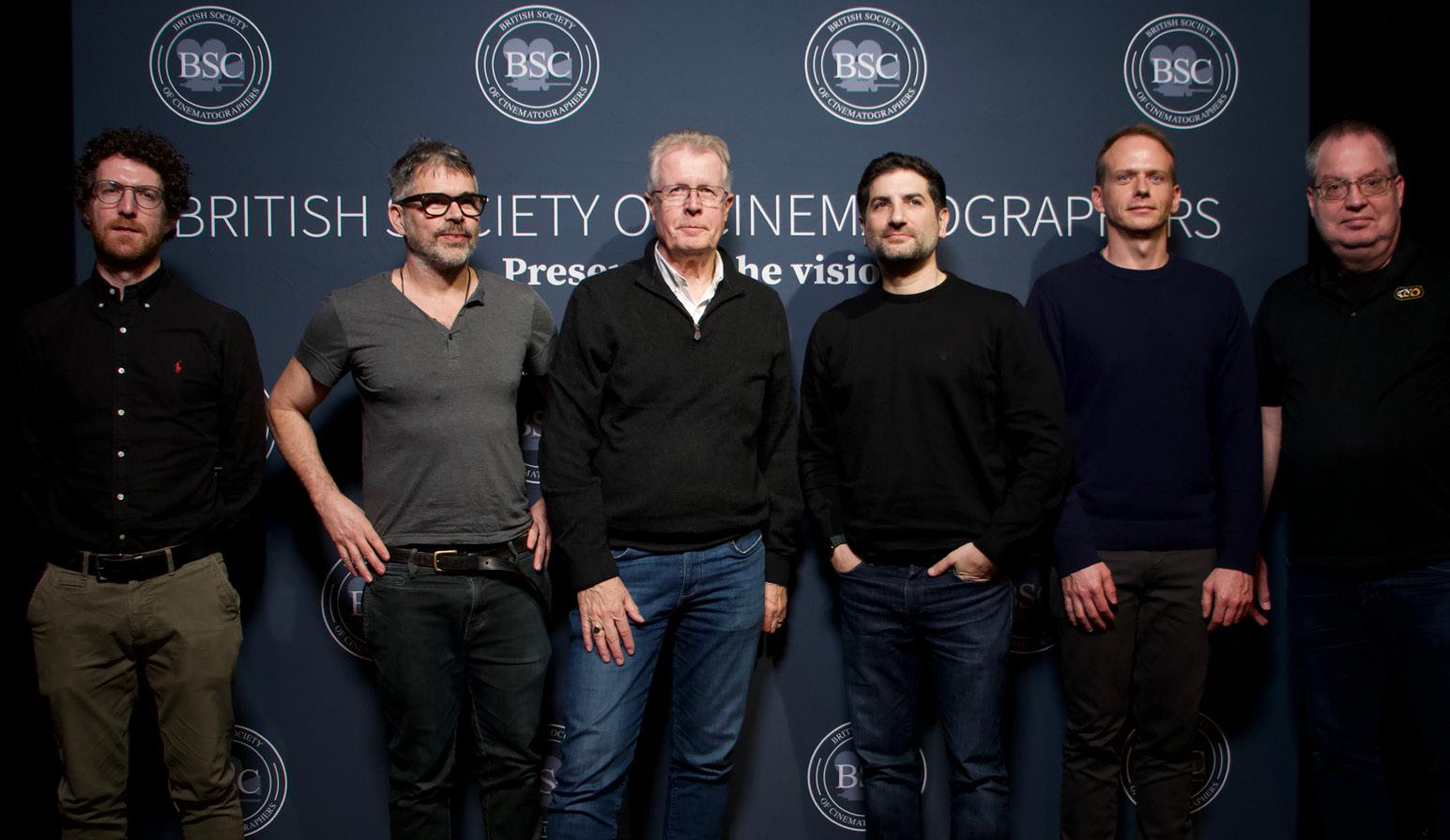
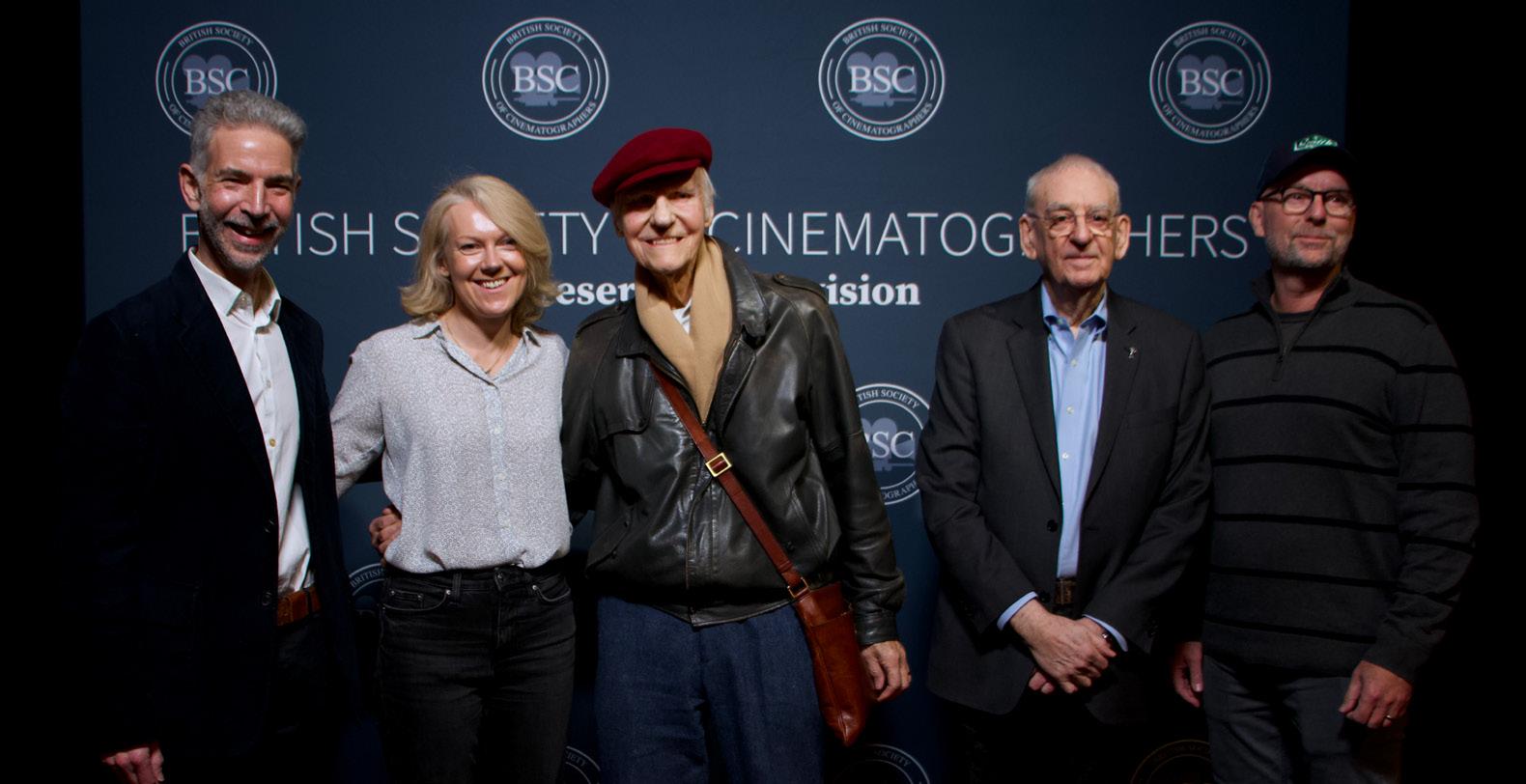

BSC EXPO 2024•ROUND-UP
CINEMATOGRAPHY WORLD MARCH/APRIL 2024 57
LIGHT & SHADOW
By Darek Kuźma
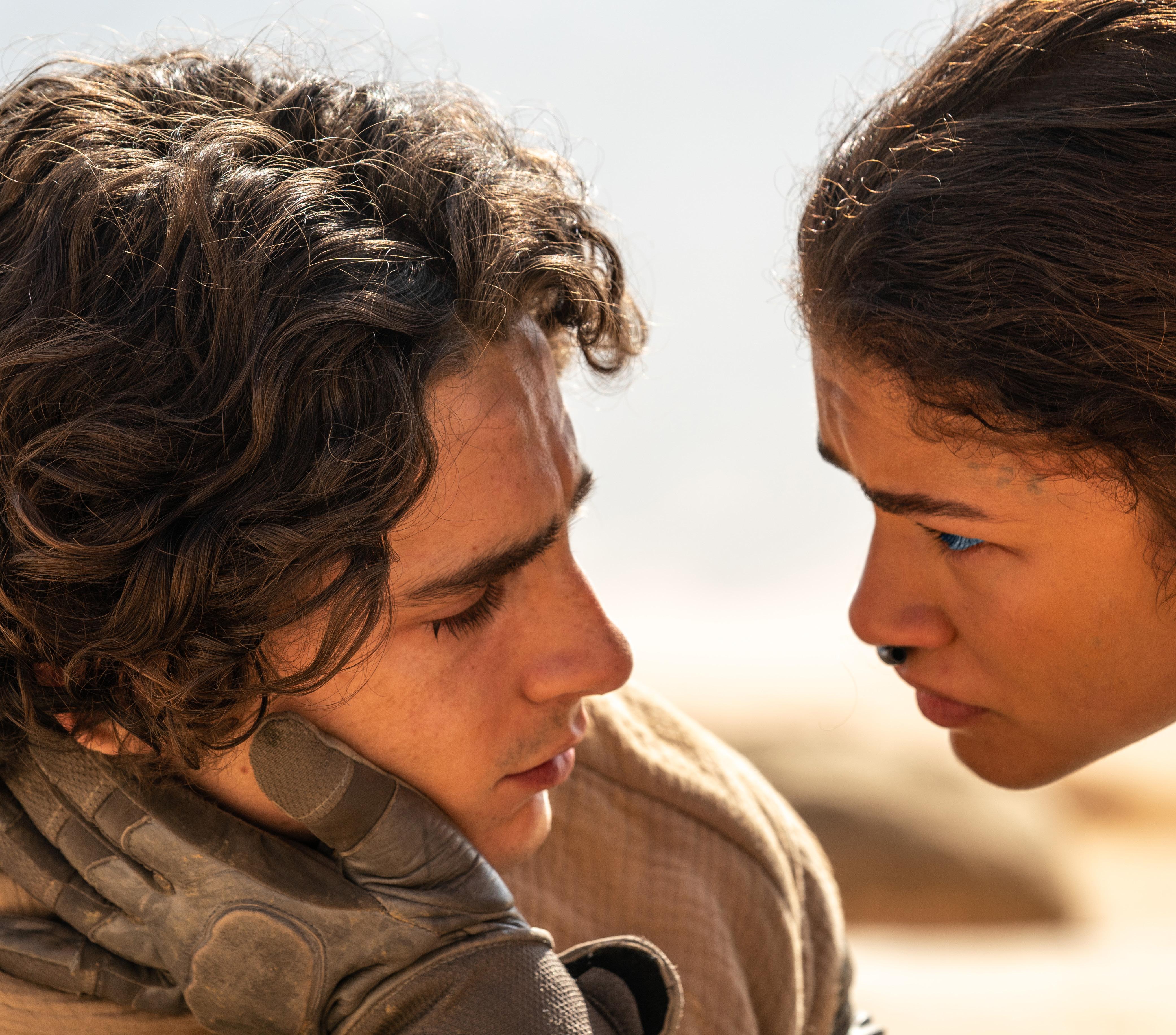
FReleased in the fall of 2021, Dune was one of the most cinematically and artistically rewarding blockbusters of the 2000s. It brought Fraser an Academy Award, a BAFTA Film Award and numerous other accolades. Although the sequel, Dune: Part Two, picks-up right where the first movie left-off, detailing the difficult path that Paul Atreides (Timothée Chalamet) follows with Chani (Zendaya) to emerge as the leader of the Fremen, and exact revenge on his father’s assailants, principal photography started three years after the original wrapped.
We tried to remain nimble and responsive… to be in the right place, at the right time, and in the right direction
Not unexpectedly, shooting a direct sequel, one that ventures into previously unseen geopolitical sides of Arrakis and expands on the Dune universe, brought a number of challenges.
“We went into prep immediately after the 2022 Academy Awards, in March of that year. We were
already in Budapest in April, started shooting in July and wrapped in December,” Fraser recalls.
Although most of the interior work was once again done on the stages of Hungary’s Origo Studios, with the crew also travelling to the modernist Brion Tomb near Treviso in Italy, approximately 50% of Dune: Part Two was shot on-location. “Everything involving sand

was shot either in Jordan’s Wadi Rum desert or in Abu Dhabi. Basically, the stuff you’d imagine was onlocation, really was on-location.”
Having the experience of bringing different aspects of the Dune universe to life under their belt, Villeneuve and Fraser decided that Dune: Part Two
should be as distinct from the its predecessor as possible.
“It’s the same story and we needed some continuity, but we didn’t want to do the same film all over again. Rather we wanted to experiment with new stuff and ways of expanding this world,” he informs. “We considered different ideas, like shooting some scenes in 16mm, but ultimately ruled that we should not get bogged down in technicalities. In terms of lenses, we chose to leave Anamorphic behind and focus on shooting spherical for the IMAX format.”
Both films were shot digitally with IMAX-certified cameras, yet Dune had around 40% of its scenes processed for IMAX 1.43:1 aspect ratio, whilst Dune: Part Two is a 100% IMAX experience.
“We had a solid selection of Alexas from ARRI Rental: the Alexa 65, the Alexa LF, and the Alexa Mini LF. ARRI cameras were great for the first film, so we figured-out that we’d only change the lenses. We mostly used spherical ARRI Moviecam lenses, which combine vintage optics with modern, highperformance housings, along with lenses I’ve been working with recently called Iron Glass, out of Ukraine. These are rehoused vintage Soviet lenses that fitted the project well.”
To expand the visual scope of Arrakis saw Fraser shoot with slightly longer lenses.
“As the scale of everything on Arrakis is so large, we learned early-on that we had to maintain intimacy with the characters, or we’d risk the film becoming

DUNE: PART TWO•GREIG FRASER ACS ASC
58 MARCH/APRIL 2024 CINEMATOGRAPHY WORLD
or DP Greig Fraser ACS ASC, expanding the visual scope of the endless desert landscapes and intricate interiors of Arrakis was only a part of the challenge of shooting Denis Villeneuve’s Dune: Part Two.


just a visual spectacle. We mostly shot Dune: Part Two with 58mm to 85mm focal lengths, instead of 55mm to 70mm on the first film,” Fraser reflects. “Many DPs argue that to become more intimate you need to put on a wider lens and have a camera close to somebody. Others prefer to go longer and separate the cast from the background. We felt that one-lens-lengthlonger approach would be appropriate, whilst also supporting the visual continuity.”
We needed some continuity, but didn’t want to do the same film all over again
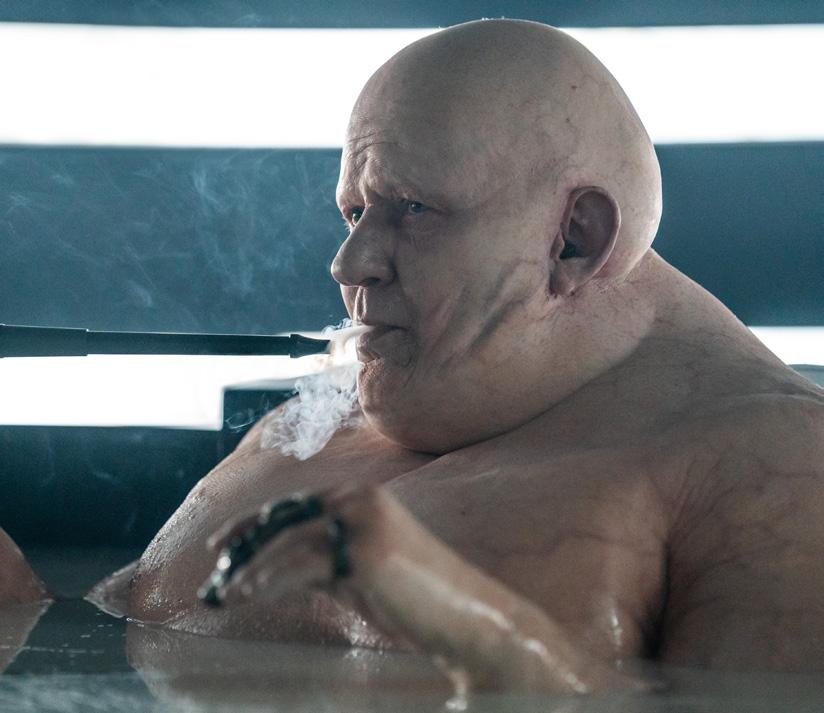

Yet they did not forget about the experimental spirit they wanted to infuse Dune: Part Two with. Thus, Fraser shot scenes at Giedi Prime, the home planet of the pale, vampirish Harkonnens, on Alexa LF with the infrared technique.
“We removed the IR-cut filter, which sits in front of the sensor and stops infrared light from hitting it, and allowed infrared to bleed into all colours. The camera now saw all the wavelengths, from blue to infrared. Then, we put a visible light cut filter in front of the camera,” he relates. “Effectively, the camera didn’t see any light that you and I would see, only infrared. It didn’t see LED light but saw infrared light coming from Tungsten bulbs. It was a really interesting technique as it got rid of a lot of information that visible light would show us.”
In the first film, all Giedi Prime scenes were at night. In Dune: Part Two we get to see the planet’s day exteriors in the most striking fashion, as we are introduced to a new antagonist, Feyd-Rautha Harkonnen, on a sunless, sand-filled gladiatorial arena where he viscously kills Atreides prisoners.
“Doing Dune, we didn’t talk about what the sunlight looked like in Giedi Prime, and for Dune: Part Two we knew we couldn’t shoot it normally. The idea was to capture it in B&W as if the sun didn’t produce any colour. Denis loved that the whole planet sees only infrared light, both for the visual effect and how it explains the Harkonnens’ evolutionary journey.”
Yet the true challenge of Dune: Part Two lay in creating the scope and shaping the mood of the Arrakis scenes with light and shadow.
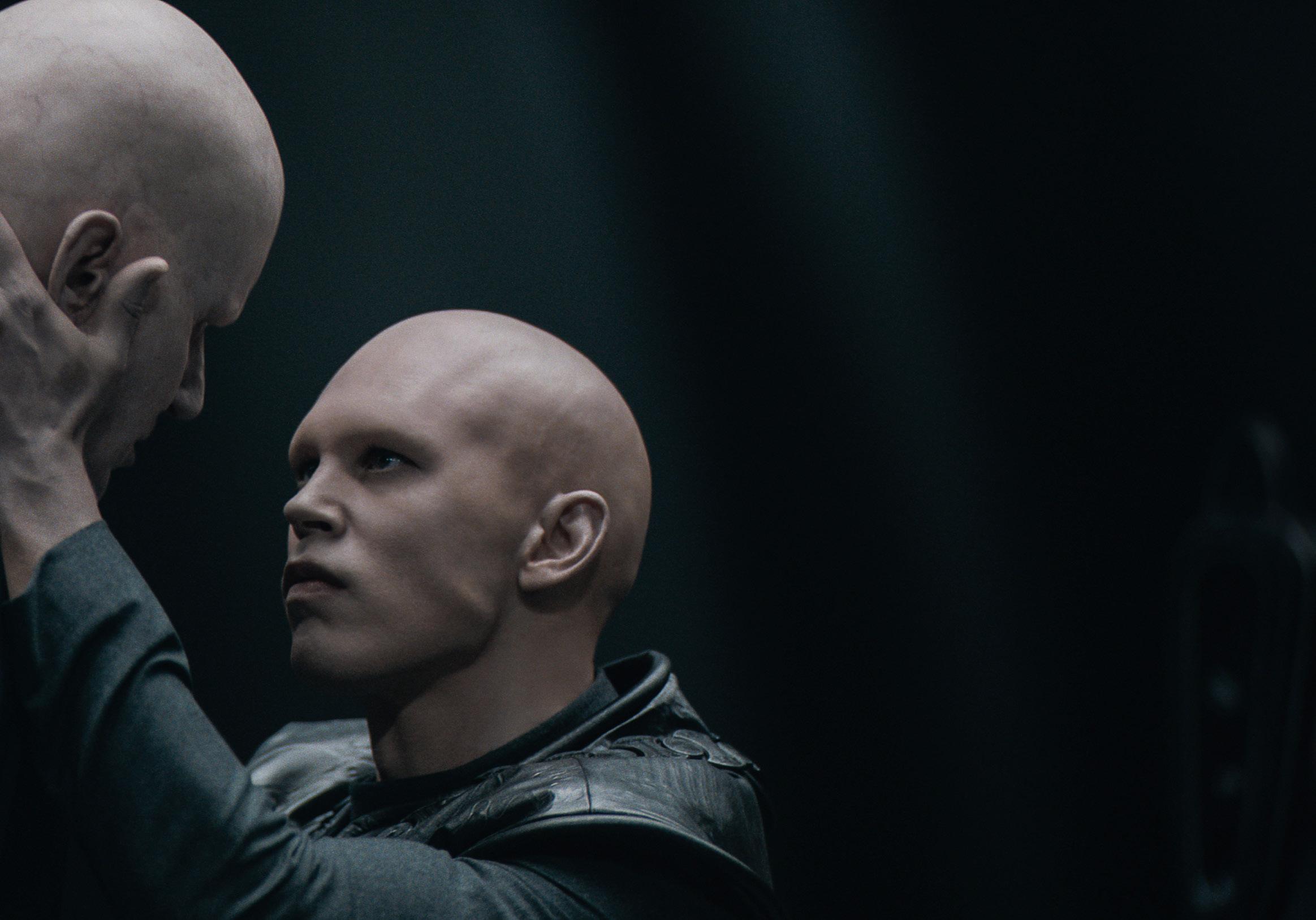

“The Fremen are cave-dwellers, they stay out of the elements by living in underground warrens, called ‘sietchs’, or in the rocks. In the book their habitats were darker and lit by floating suspensor lamps, making it feel intimate but also permanently night-time,” Fraser offers. “We considered lighting the sietches via lighting the environment, but without sunlight we’d lose ability to track the time of day and effectively our connection with nature. Instead, we chose to light them in a similar way we lit the city’s

ACS ASC•
Images: BTS photos by Niko Tavernise. Dune: Part Two images © 2024 Warner Bros. Entertainment Inc. All Rights Reserved.
GREIG FRASER
DUNE: PART TWO
CINEMATOGRAPHY WORLD MARCH/APRIL 2024 59
This film looks the way it does because of the great cameras, great lighting and the Firecrest filter

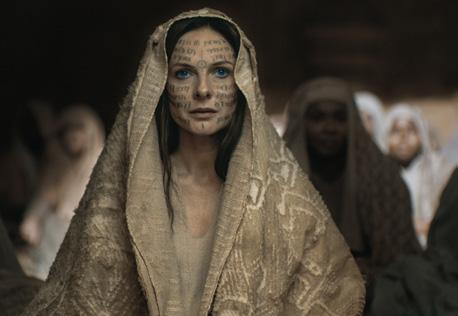
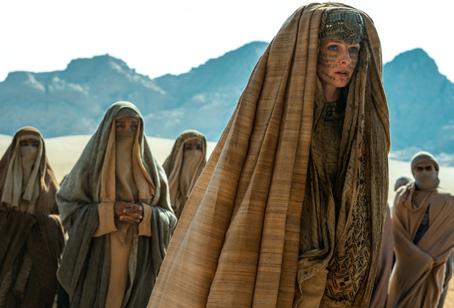

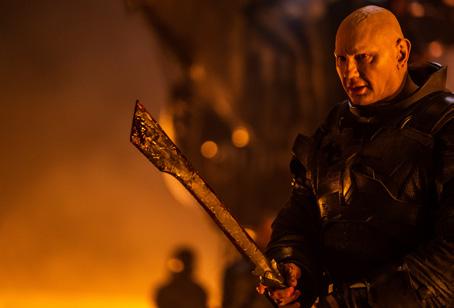

residential areas, as if there were cracks in the rocks that let light through.”
“This allowed us to have lovely hot spots of light, plus shadow areas falling-off into dark, not black, but close to that. It also forced us to have the most important pieces of information in the medium to bright areas, yet creating such light patterns and sharp shadows on stages 30-feet high was quite a head scratch to avoid multiple shadows.”
Fraser recounts that among dozens of light sources he had at his disposal, Creamsource Vortex 8s and Aputure LS 1200d Pro spotlights were the most important. “We literally had thousands of Vortexes and built big walls of light with them. Where we needed a strong, sharp, punchy light, we added the Aputures,” he explains. The lighting package was provided by MBS Lighting.
As for shooting in the desert, the key word was ‘humility’.
“One of the things I learned on Dune is that you’re not going to light the desert, the desert is going to light you,” Fraser reminisces. “As much as we, in the film business, would like to believe we have control over the elements, in the desert you quickly realise how little an 18K can do. It’s good for close-ups but beyond that, it’s powerless. And that’s humbling. On Dune: Part Two, we tried to remain nimble and
responsive. It was important to be in the right place, at the right time, and in the right direction, rather than trying to control the environment. We kept moving our sets with the sun so that they remained in the right shadow.”
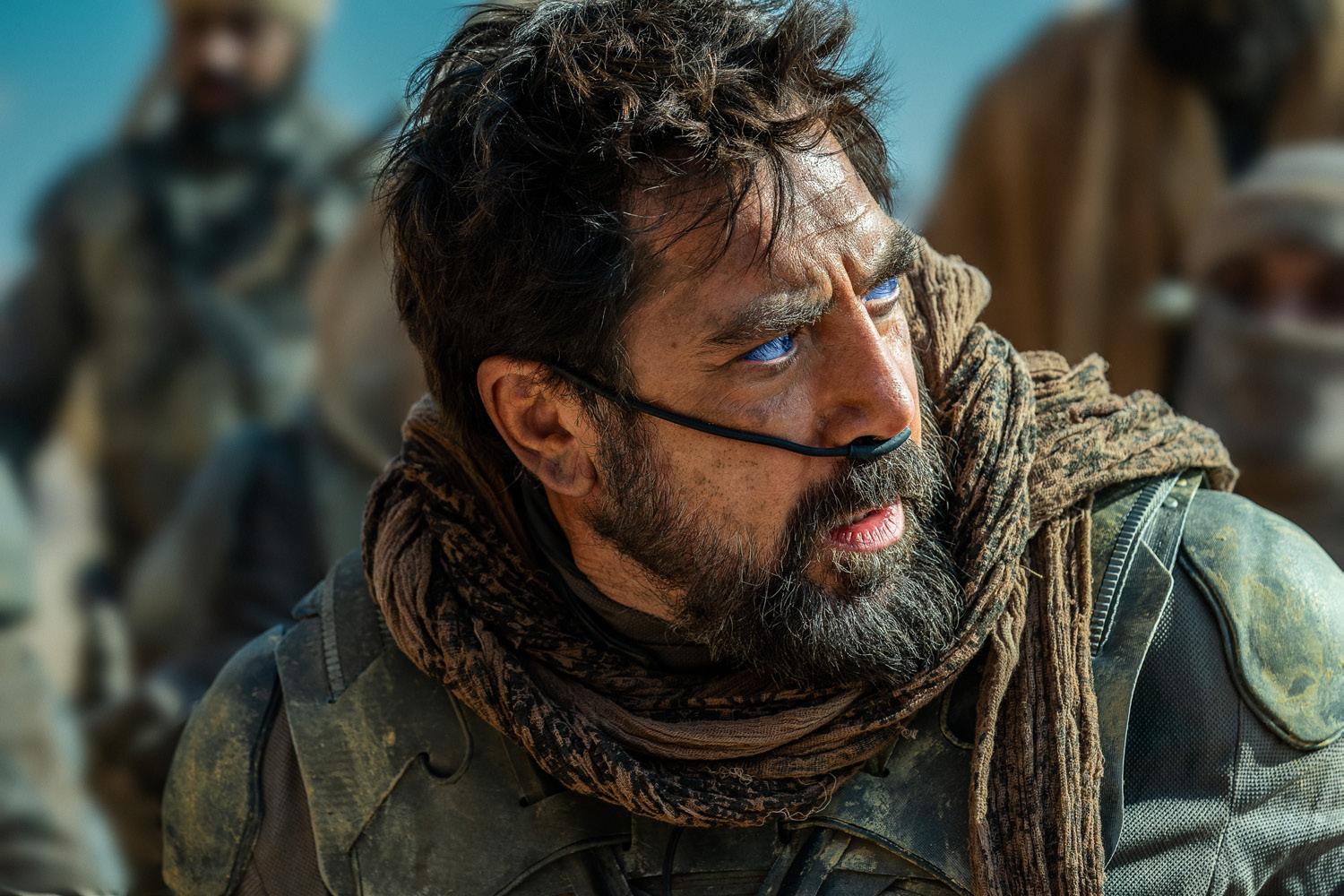
This arduous strategy gave great results, especially in the scenes where the Fremens implement a guerilla-style attack on a Harkonnen spice harvester guarded by an ornithopter. Trying to shoot the enemy down, Paul and Chani hide behind the harvester’s legs.
“It’s all about the shadows. The Fremens
explode out of the sand on the harvester’s shadow side and run under it. The scene meant we needed to always shoot with them in the shadow, so we had to keep moving every half an hour and rotated the set to suit the sun level. Rather than controlling the light with butterflies, we were able to retain control with angles and planning,” he says. “The other benefit was that we could vary the schedule. We captured beautiful drama scenes in mornings and evenings, and shot action scenes in the daytime.”
“Planning was tough as the shadows were the best between 2:30pm and 3:30pm.
If you consider those harvesters are the size of a football field and we were in the desert, we had to bring machinery like 40x40 construction cranes or Manitous. They take hours to set but we had to be mobile, so as soon as the last crane was set, we had to move the first one again.”
The whole operation had to be meticulously planned in advance as any errors would be costly.
“We used Unreal Engine for planning and scouting. We had a local production company fly a drone with photogrammetry equipment and capture the rock formations of the locations where we were going to shoot. My assistant, Tamas Papps, put all the information into Unreal Engine and in 3D built the
DUNE: PART TWO•GREIG FRASER ACS ASC 60 MARCH/APRIL 2024 CINEMATOGRAPHY WORLD
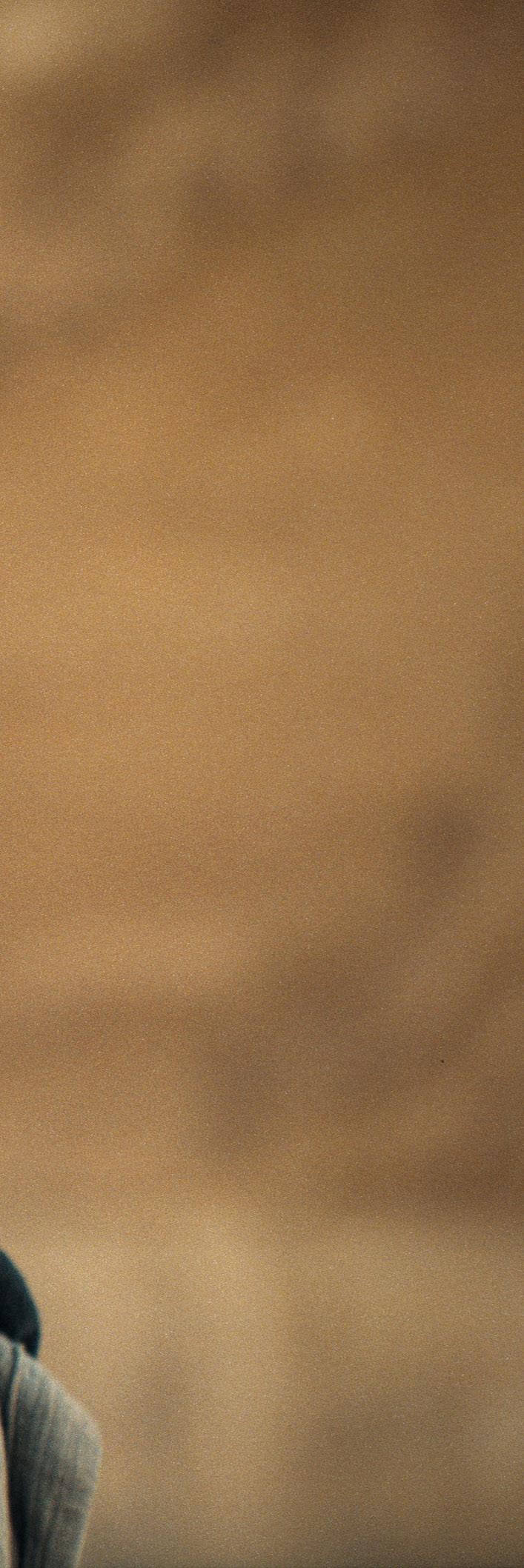
In the desert you quickly realise how little an 18K can do

scenes and the machinery at the proper location at the right time of day at the right time of year.”
Fraser admits that the entire planning for light and shadow would not have worked had it not been for one crucial element.
“Because we were dealing with such bright light outside, it was important for me to get the right ND filters. I tested them a lot on Dune, but was concerned that by the time we started getting up to 1.5, 1.8, 2.1 etc., that the colour would wash-out. Instead, I chose a filter called Firecrest, from Formatt Hitech. It enabled us to shoot in the middle of the day in bright environments and keep the colour honest and neutral. They held up to sandstorms and all physical dangers. The reason the film looks the way it does is because of the great cameras, the great lighting, and this filter. Had we not chosen the right filtration, we would have had green sand and miscoloured dunes.”
Apart from the prologue – that featured an eclipse that proved problematic because of shooting in different locations over several days and having to make the shadows gradually darker as the eclipse comes – it was the same process as
want to become elitist in filmmaking. We were very considerate about the framing and other aspects that could make the film difficult to watch in 2.40:1 aspect ratio in a traditional theatre.
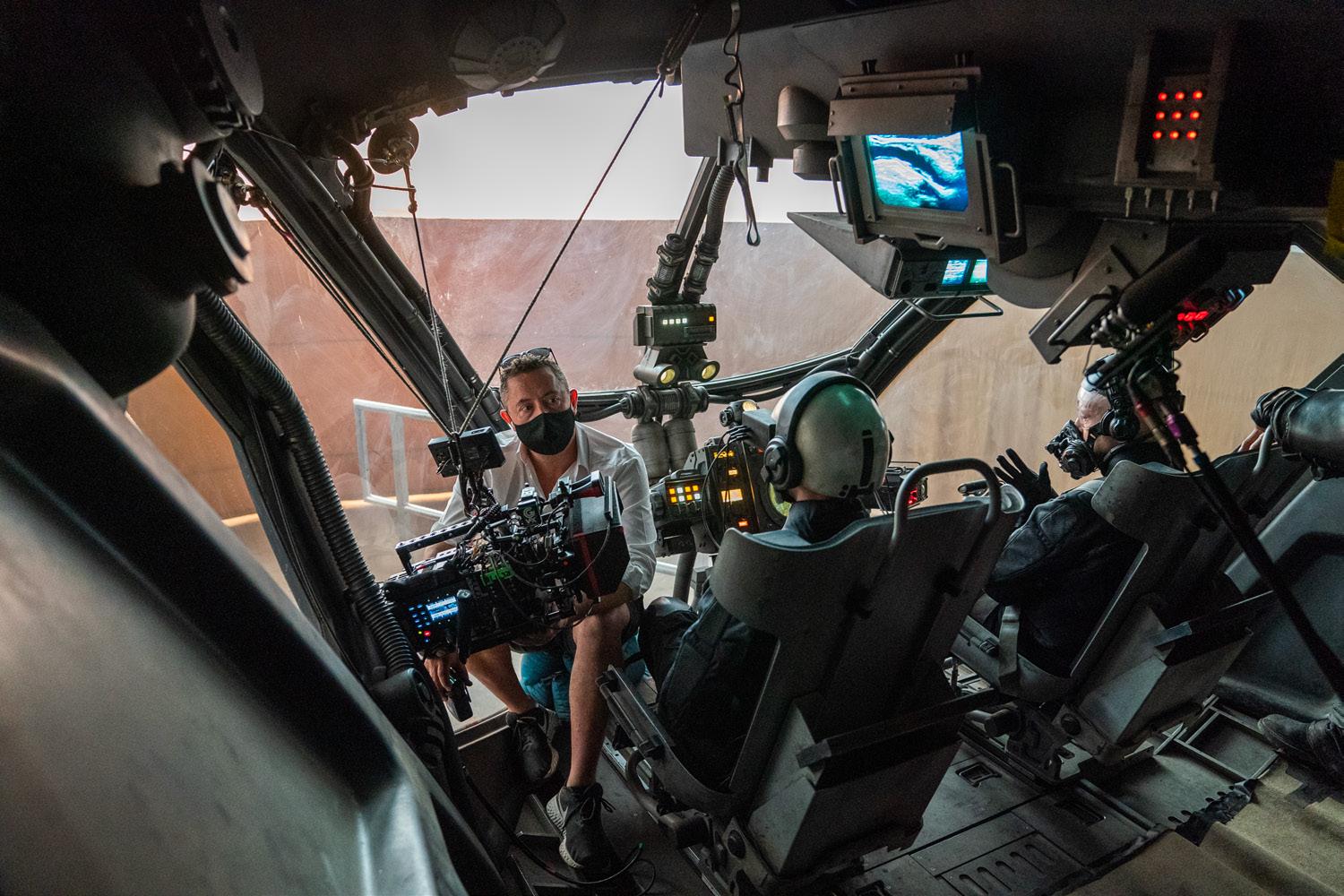
A silver-lining of this production being a sequel was that the DI was easier than expected. The DI was done at FotoKem Creative Services in Los Angeles by colourist David Cole with whom Fraser previously graded The Batman (2022) and Dune.
“We had the same team as in part one, and everybody understood what was going on.
in Dune,” he maintains.
Fraser’s priority was to make sure any viewer could watch both parts back-to-back and feel like they were watching the same film, and not to exclude anyone.
“I’d love everybody to see this film in IMAX as that’s the way we made it, but we don’t ever
“We put so much work in this production so that everyone can take joy in going to Arrakis. And by ‘we’, I mean the whole cast and especially my crew – 1st AC Jake Marcuson, A-cam/ Steadicam operator Jason Ewart, gaffer Jamie Mills and key grip Guy Micheletti.”
While Dune: Part Two has just begun its march through cinemas around the world, it seems certain to capture the hearts and minds of many millions. Fraser and Villeneuve will make a grand finale to their vision in the announced Dune: Messiah. So stay tuned!

CINEMATOGRAPHY WORLD MARCH/APRIL 2024 61 GREIG FRASER ACS ASC•DUNE: PART TWO

R ASTAMAN VIBRATIONS
By Ron Prince

In his 1981 Rolling Stone Magazine obituary about Bob Marley, biographer Timothy White wrote, “The pervasive image of Bob Marley is that of a gleeful Rasta with a croissant-sized spliff clenched in his teeth, stoned silly and without a care in the world. But, in fact, he was a man with deep religious and political sentiments, who rose from destitution to become one of the most influential music figures in the last 20 years.”
The 2024 film about the music legend, Bob Marley: One Love, starring Kingsley Ben-Adir, encompasses all of that, and audiences have flocked to cinemas worldwide to experience it. At the time of writing, the film, directed by Reinaldo Marcus Green and shot by DP Robert Elswit ASC, had pulled-in $171 million at the global box office, making it one of the most successful musical biopics of all time, and the sixth most successful movie release of 2024.
The screenplay was written by Green, in collaboration with Terence Winter, Frank E. Flowers, and Zach Baylin, with Lashana Lynch starring as Marley’s wife Rita, and James Norton as Island Records impresario Chris Blackwell. The film was made with the full cooperation and involvement of the reggae icon’s family, with Rita, and children Ziggy and Cedella, in producing roles.
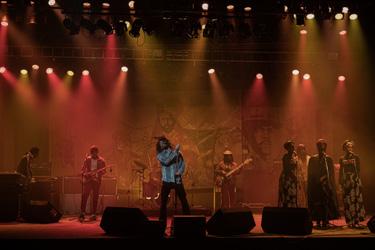
The film depicts Marley’s path from humble origins to mega-star. It encompasses a period from 1976, when political turmoil swirled in Jamaica following independence from the UK and Marley survived an assassination attempt, through to his spell in punk-era London when he and his band ‘The Wailers’ recorded the album Exodus, before his triumphant return to Jamaica in April 1978 for the ‘One Love’ peace concert. The film also goes behind the public façade, immersing the audience in jam sessions at Marley’s London flat and music-making process in the studio, plus flashbacks to childhood traumas, whilst also examining his Rastafarian beliefs along with his womanising.

“I was excited when Reinaldo told me about the film. There had been many previous attempts to make movies about Bob Marley’s life, but Reinaldo’s treatment of Bob, not as a star, but as a guy with an amazing story, resonated with the family and was given the green light by them,” says Elswit whose cinematographic credits include There Will Be Blood (2008, dir. Paul Thomas Anderson), Mission: Impossible –Rogue Nation (2015, dir. Christopher McQuarrie), Green’s Oscar-nominated King Richard (2021), and the forthcoming Netflix series Ripley (2024, dir. Steve Zaillian).
To understand Marley the man and the moments in his life more completely, Elswit undertook extensive

research during prep into the political and cultural backdrops in Jamaica and the UK during the mid1970s, reading books such as A Brief History Of Seven Killings by Jamaican author Marlon James, investigating Rastafarianism, whilst also taking stock of documentaries, live performances and behind-the-
I shot in 2:40:1 for its visual impact… and wideopen for honesty and spontaneity
scenes photographic stills.
“There’s a lot of film of Bob on the internet, especially YouTube, living in London and performing at different concerts,” Elswit notes. “It’s fascinating to

BOB MARLEY: ONE LOVE•ROBERT ELSWIT ASC
62 MARCH/APRIL 2024 CINEMATOGRAPHY WORLD
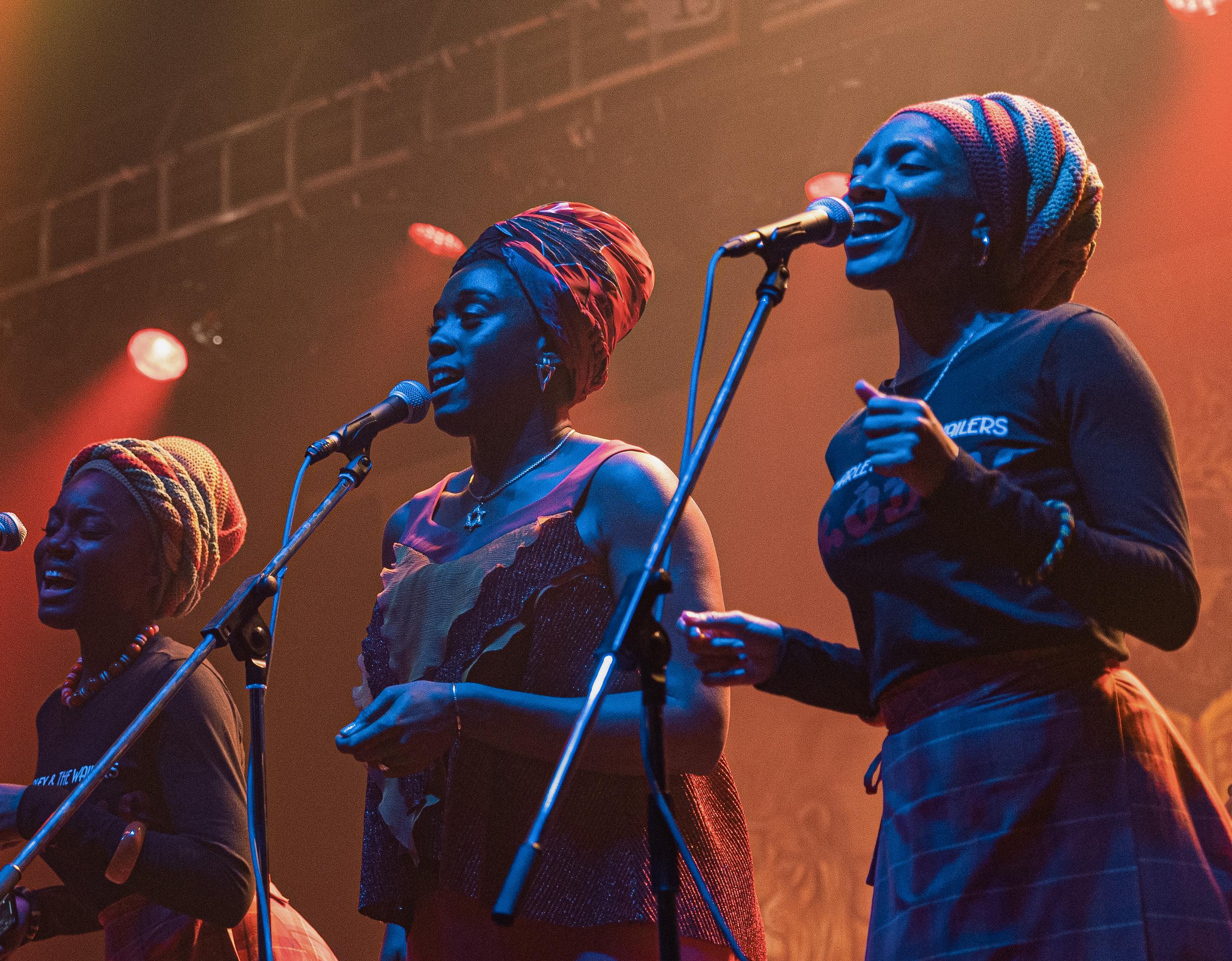
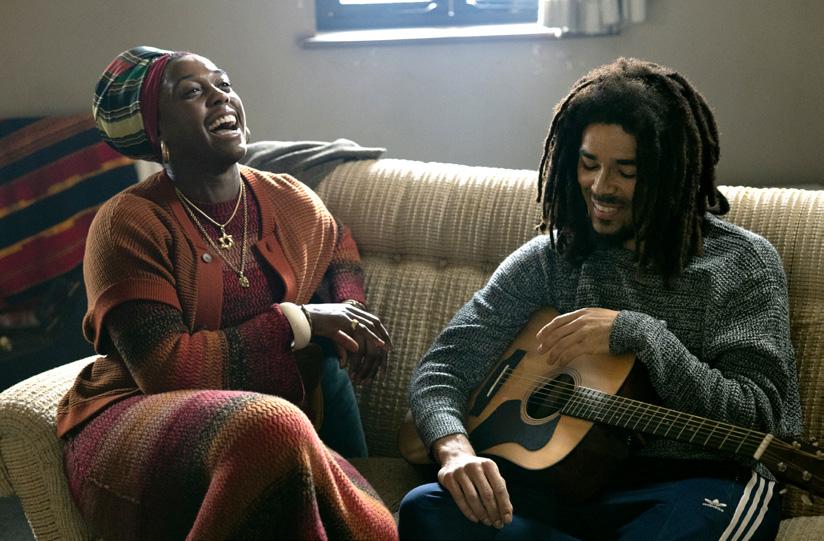
watch his commitment to those, which were spiritual experiences for him and the audience. It was this quality, and the importance of Rita in his creative and religious life, that Reinaldo wanted to capture.”
Of particular interest and influence to Elswit was Kim Gottlieb-Walker’s photographic tome, Bob Marley And The Golden Age Of Reggae: 1975-1976, a compendium of candid and intimate photographs of Marley and the musicians, artists and producers who brought the reggae sound to the international stage.
Elswit explains, “All of the photos in that book are great, but the warmth of the colour Kodachromes she took captured that world in a really wonderful way. The saturated oranges and reds and greens of Jamaica set us in a certain direction in terms of the colour palette for the movie.”
Production began in December 2022 in London, including the exterior of the house Marley lived-in in Battersea and a recreation of its interior on-stage at Longcross Studios. Many of the concert scenes were shot at Alexandra Palace in North London. Production then moved to Jamaica, where a replica of Marley’s 56 Hope Road home and compound, now The Bob Marley Museum, was built on a plot of land outside of Kingston, before production wrapped in April 2023. Set builds were overseen by production designer Chris Lowe.
Elswit shot Bob Marley: One Love in 2.40:1 widescreen aspect ratio with the then brand-new ARRI Alexa 35 camera, using Panavision Primo spherical prime lenses and Angènieux Optimo zooms assembled by lens guru Dan Sasaki at Panavision in Woodland Hills, LA. The camera package was supplied via Panavision in London, and wrangled by Elswit’s 1st AC Erik Brown.
“I like enormously the lenses that Dan built for this production,” says Elswit. “He makes lenses that I feel have just so much more character than standard offthe-shelf optics. I wanted to shoot in 2:40:1 for its visual impact, but didn’t want to get into Anamorphics as the look would have been too stylised. I also wanted to shoot wide-open as much as possible to give an overall sense of honesty and spontaneity, especially for the concert scenes, when I would really need the T1.9 that the Primos offer.
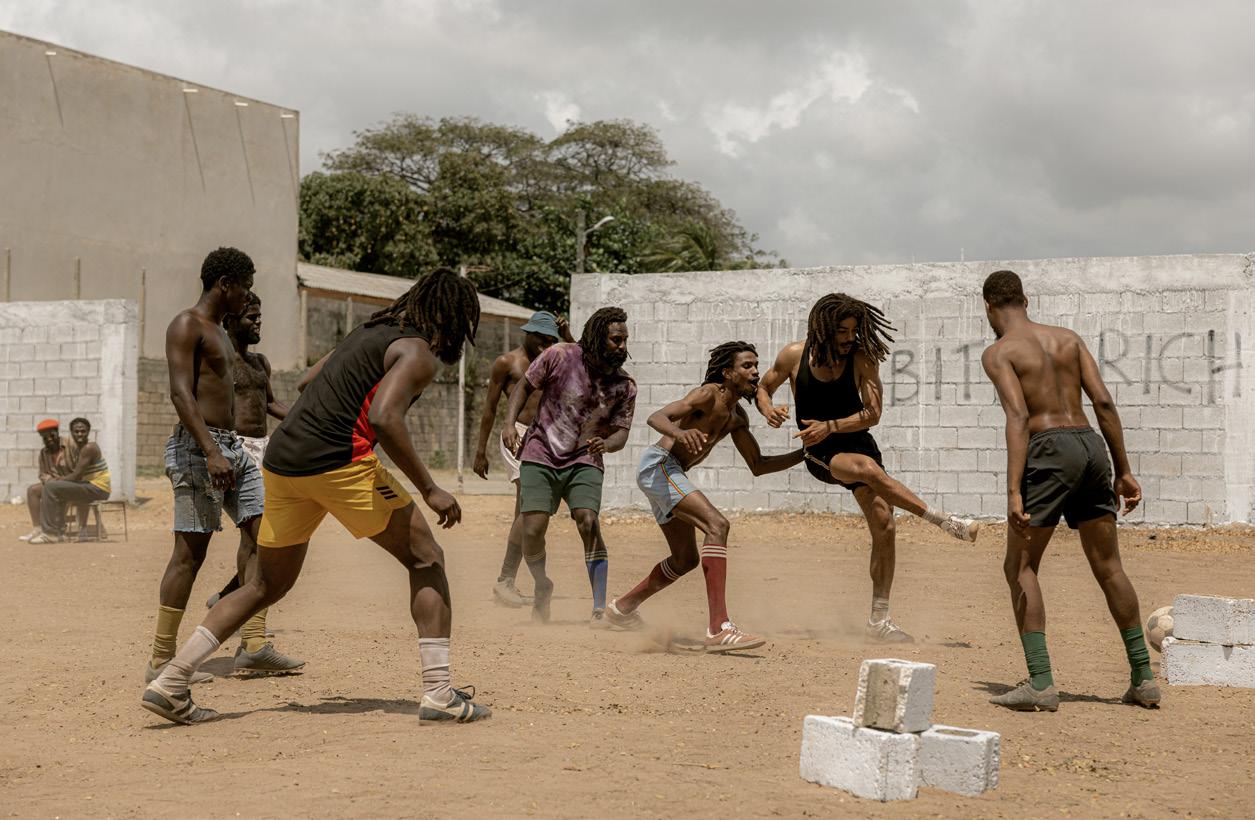
“Although I would have loved to have tested the Textures in the ARRI Alexa 35, the cameras arrived the day before our hair and make-up tests, so I wasn’t really in a position to investigate how those might add to the quality of the image. But I did sometimes rate the camera at 1600 or 1800ISO, which yields noise in the picture, as this was the kind of movie where certain things could be messy visually.”
Shooting Bob Marley:
One Love was often a two-camera affair, with Elswit operating A-camera and Sean Cobley on B-camera/Steadicam.
“We wanted the camerawork to have a sense of un-staged authenticity, a sort of documentary style, to feel like life was
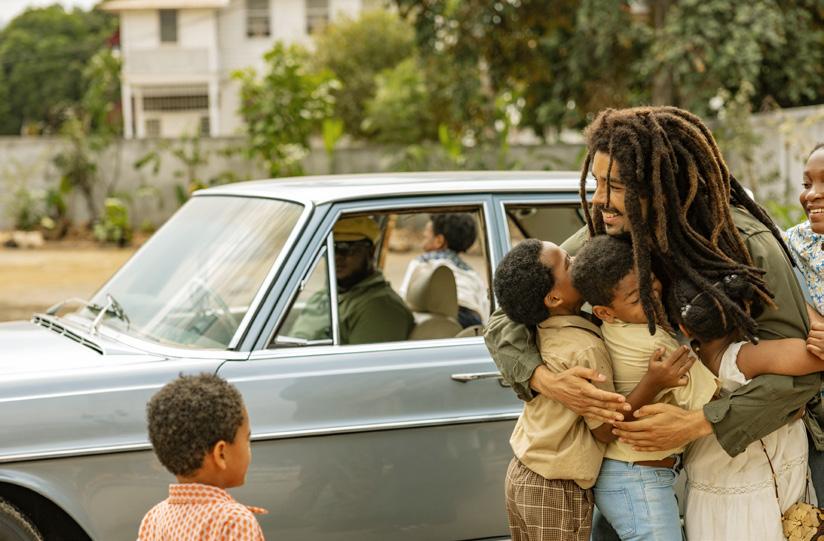

by Reinaldo Marcus
Images copyright © 2023 Paramount Pictures. All Rights Reserved. ROBERT ELSWIT ASC •BOB MARLEY: ONE LOVE CINEMATOGRAPHY WORLD MARCH/APRIL 2024 63
Images: photo of director Reinaldo Marcus Green and DP Robert Elswit ASC
Green.
We wanted the camerawork to feel like life was breaking-out in front of us
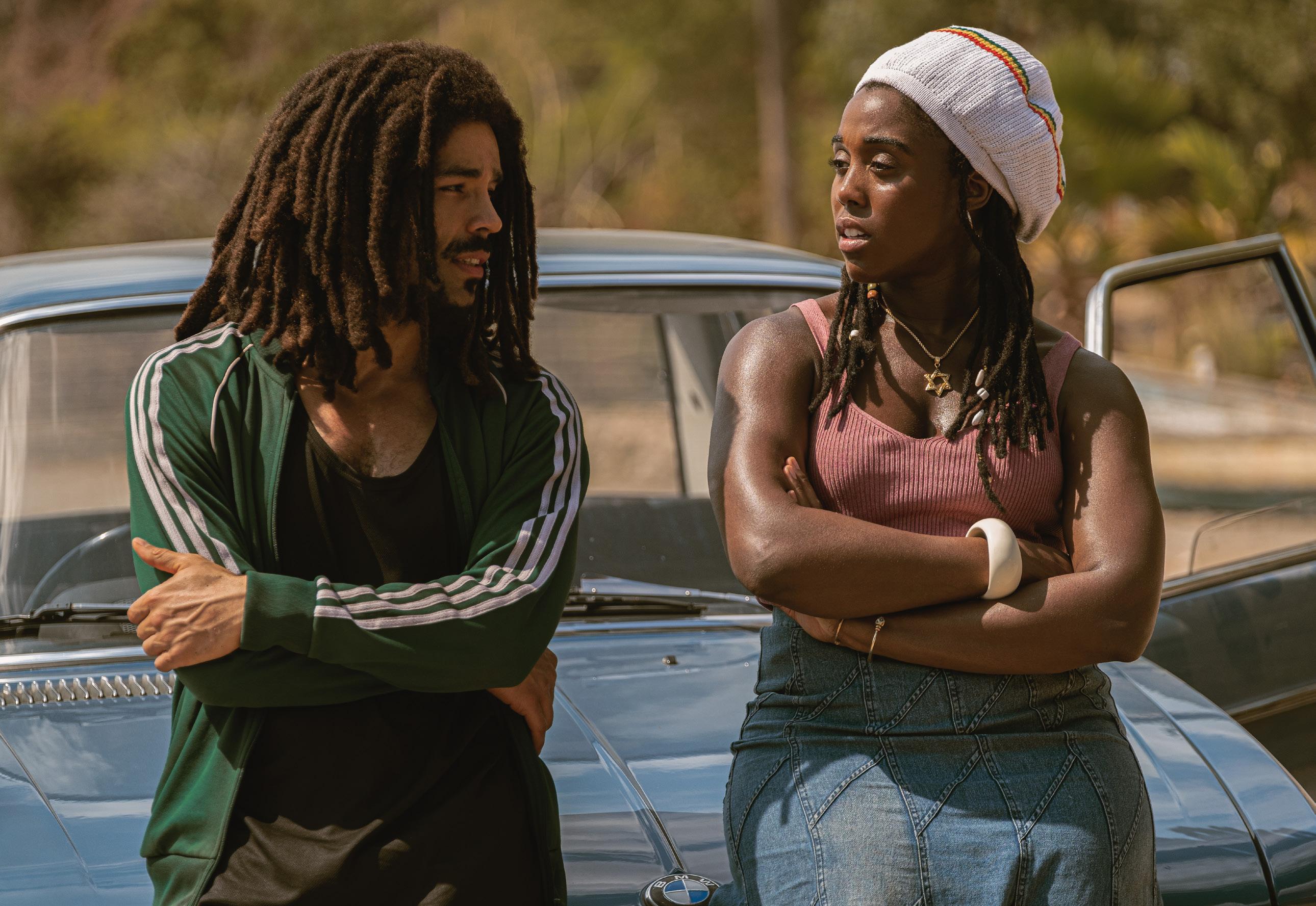
breaking-out in front of us,” says Elswit. “So a lot of that entailed working handheld, in a style that was purposefully designed to look far from slick, and it actually works really well in the final film.”
Whilst the concert scenes appear raw, real and effortlessly staged, Elswit confides that shooting them actually posed no shortage of head-scratching.
“We didn’t have the luxury of shooting at different venues, and had to shoot the concerts, including a montage of different performances that Reinaldo later cut to the song Exodus, all at Alexandra Palace over the course of a week,” he reveals.
“Making that place look like ten different concerts involved an enormous amount of painstaking thought regarding the different approaches of how we moved and angled the camera, the nature of how we lit, shooting against different backgrounds for VFX plates, along with costume changes, dance routines and crowds – all to make the audience believe Bob and the band were going from venue to venue. It was really complicated and quite incredible how we managed to cobble all of that together, but I think the result looks great.”
Elswit says he and his gaffer David Tyler were
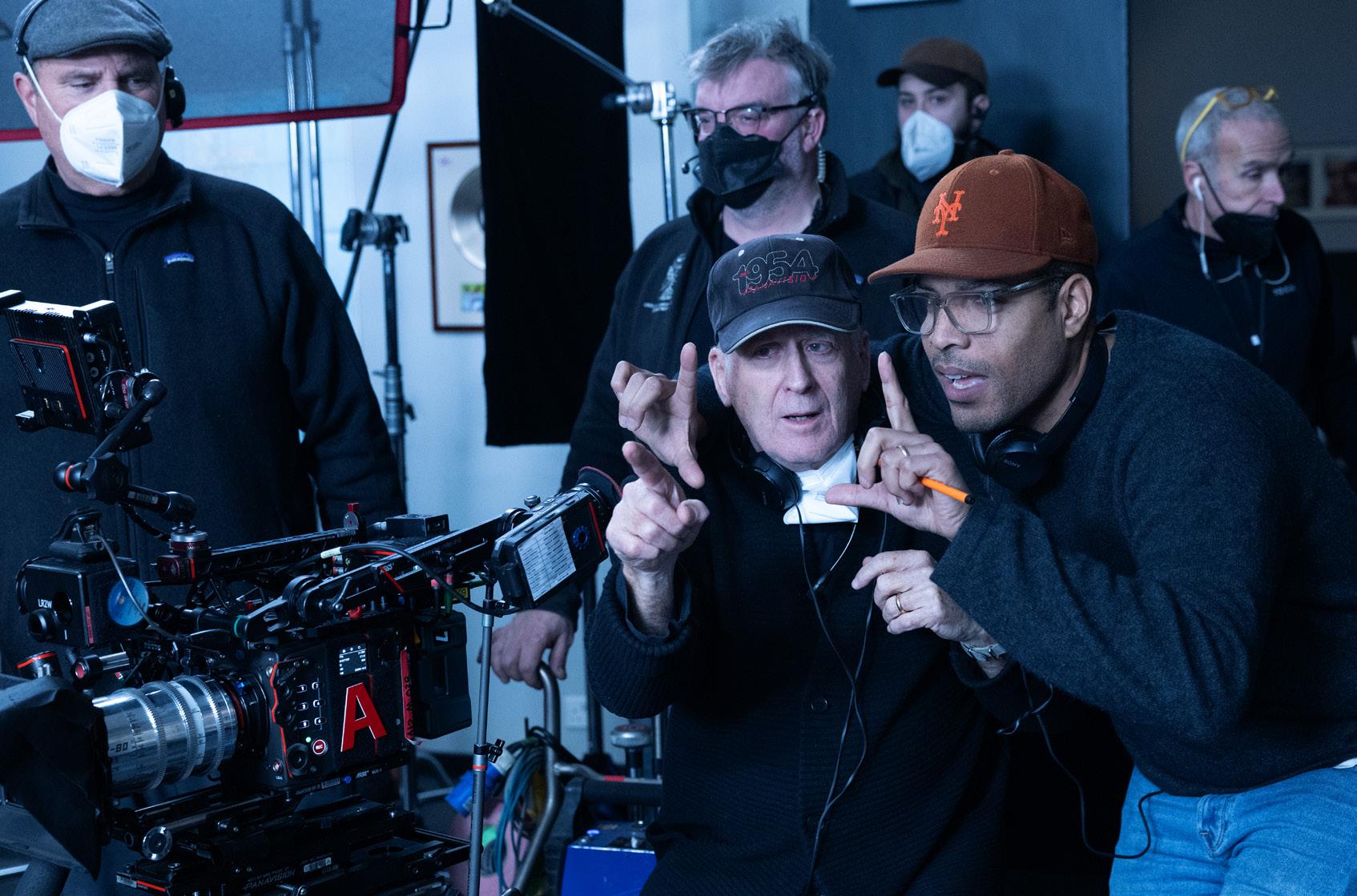
supported in their task of lighting the concerts by Neville Garrick (since deceased), the original artistic lighting designer of all Marley’s shows.
“It was amazing to have Neville on-set as a consultant, talking about the specific lights and the colours he used back then. Reinaldo and I really loved its simple, unsophisticated, lo-fi nature. Although we had modern lighting instruments at our disposal and needed things to look cinematic, we tried to stay true to the authenticity of what Neville achieved as much as we could.” The lighting package was supplied by Panalux.
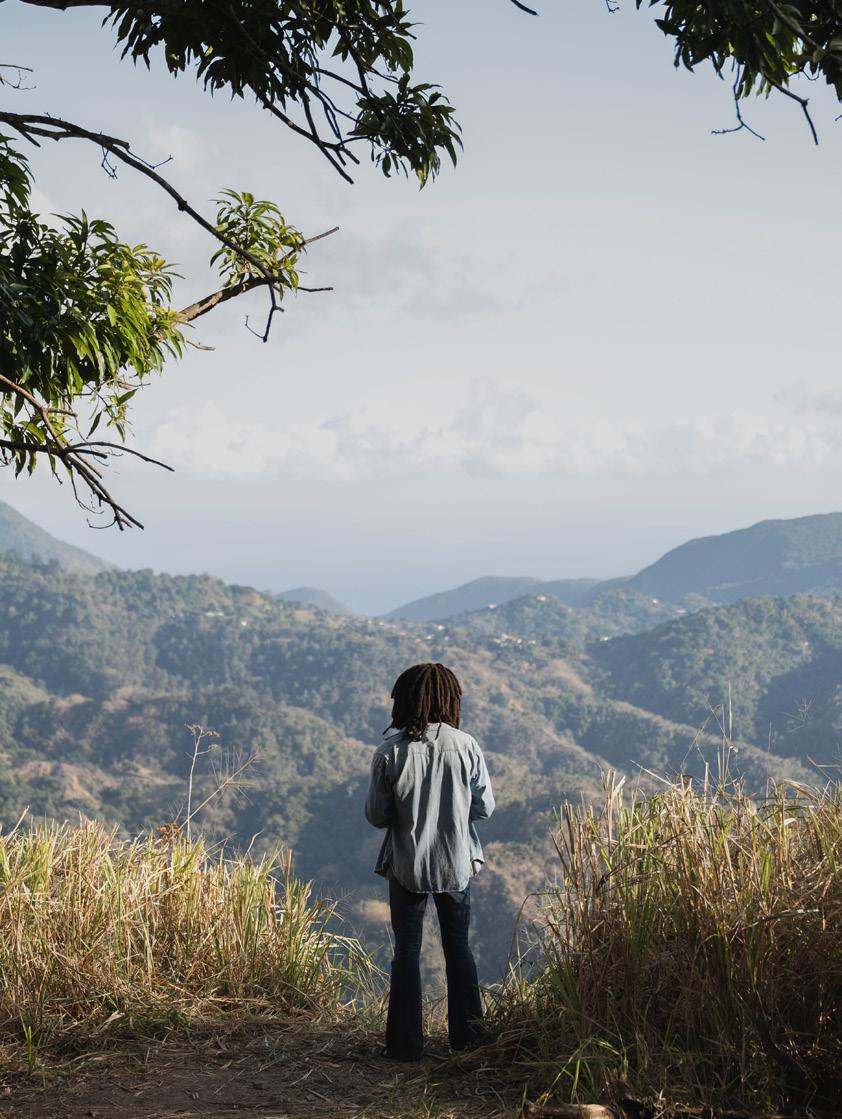
BOB MARLEY: ONE LOVE•ROBERT ELSWIT ASC 64 MARCH/APRIL 2024 CINEMATOGRAPHY WORLD

Illuminating the interiors of the movies’ London sequences was more conventional, but came with an interesting twist.
“We typically lit rooms with Tungstens and practicals, along with HMIs outside windows,” Elswit explains. “I have to say they didn’t look particularly interesting until the moment we turned-over. Bob and The Wailers smoked dope constantly, and the rooms were always full of smoke. So when we filled ours with atmos, the transformation was magical and we got some extraordinary looks.”
Elswit concludes, “It was a real privilege to work on this film with Reinaldo, our great cast and crew, and the members of the Marley family. Shooting in Jamaica we had the support of the prime minster and the local community and that made it a pleasure to go to work every day. That said, it was hot in Kingston –110°F in the shade – and very sweaty, but at least it made the looks real and raw.”

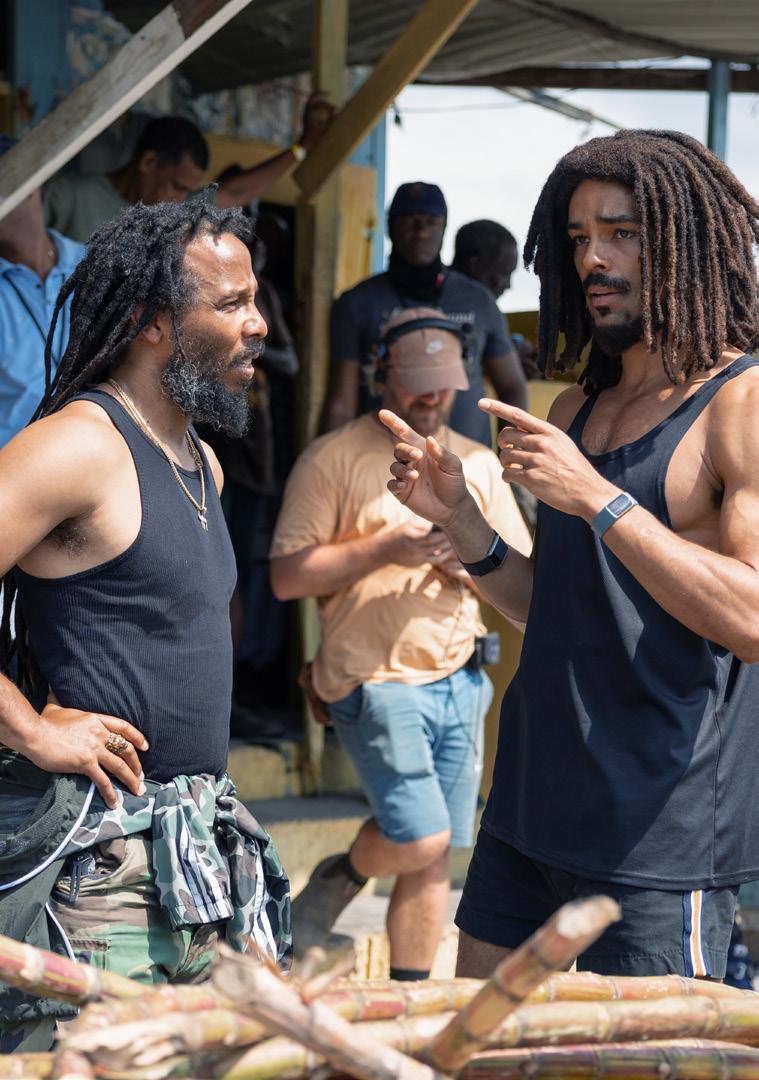
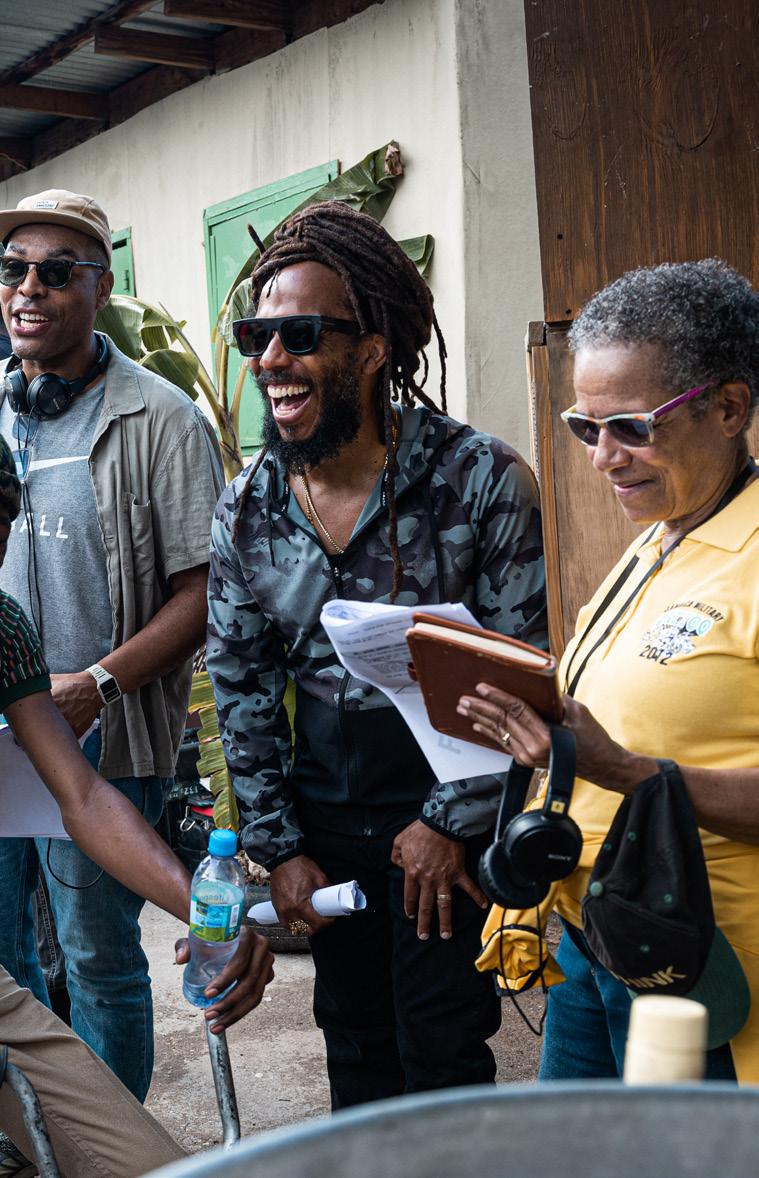
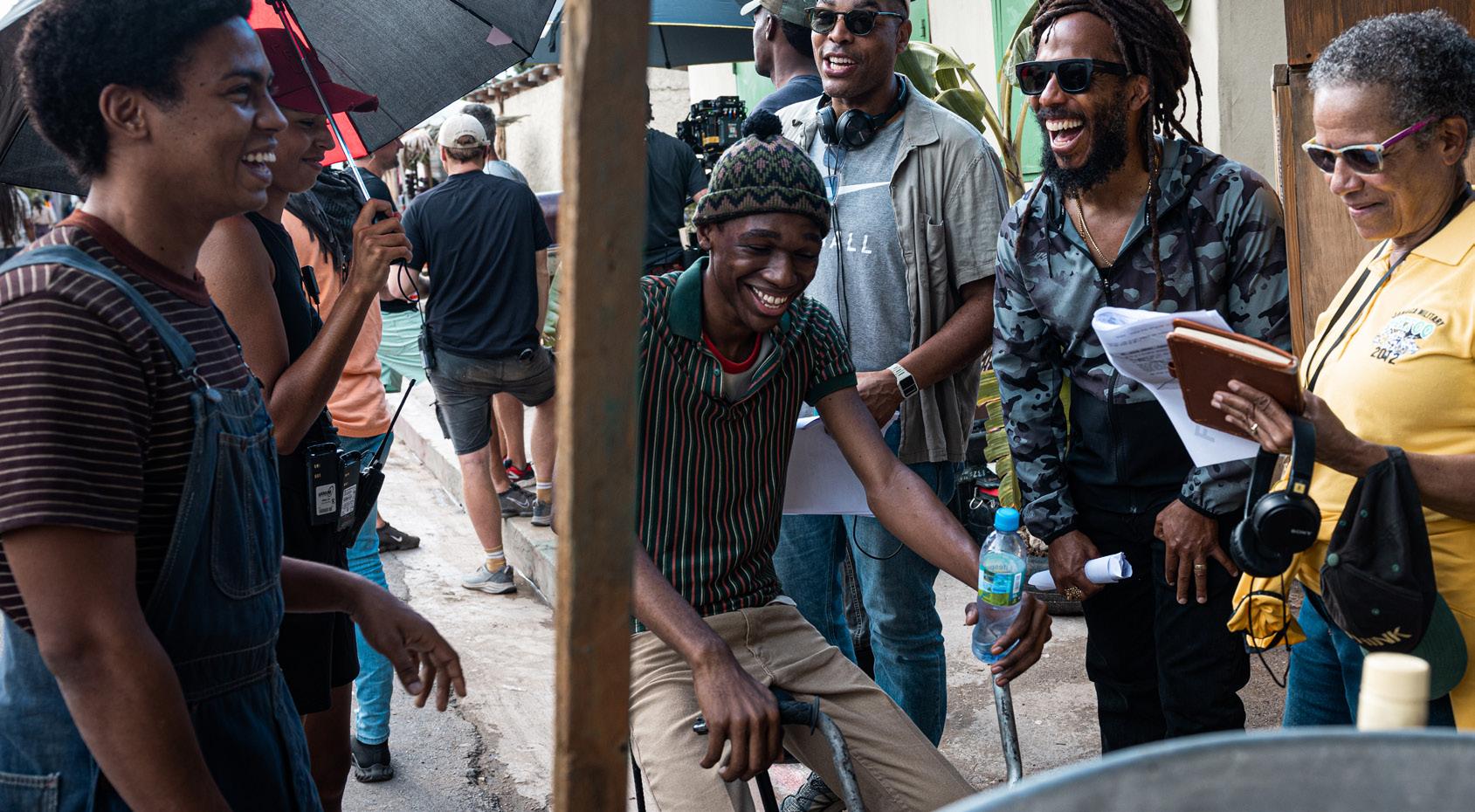
CINEMATOGRAPHY WORLD MARCH/APRIL 2024 65
ELSWIT ASC •BOB MARLEY: ONE LOVE
Images: Photos by Carole Bethuel.
ROBERT
PAST, PRESENT & FUTURE . . . TENSE!
By Ron Prince
DSet in three distinct time periods, 1910, 2014 and 2044, but told in non-linear fashion, the romantic sci-fi thriller deals with the quest for love and the elimination of emotion via DNA purification, as human existence becomes dominated by artificial intelligence (AI).
35mm film played a perfect part in the arc of the visual storytelling
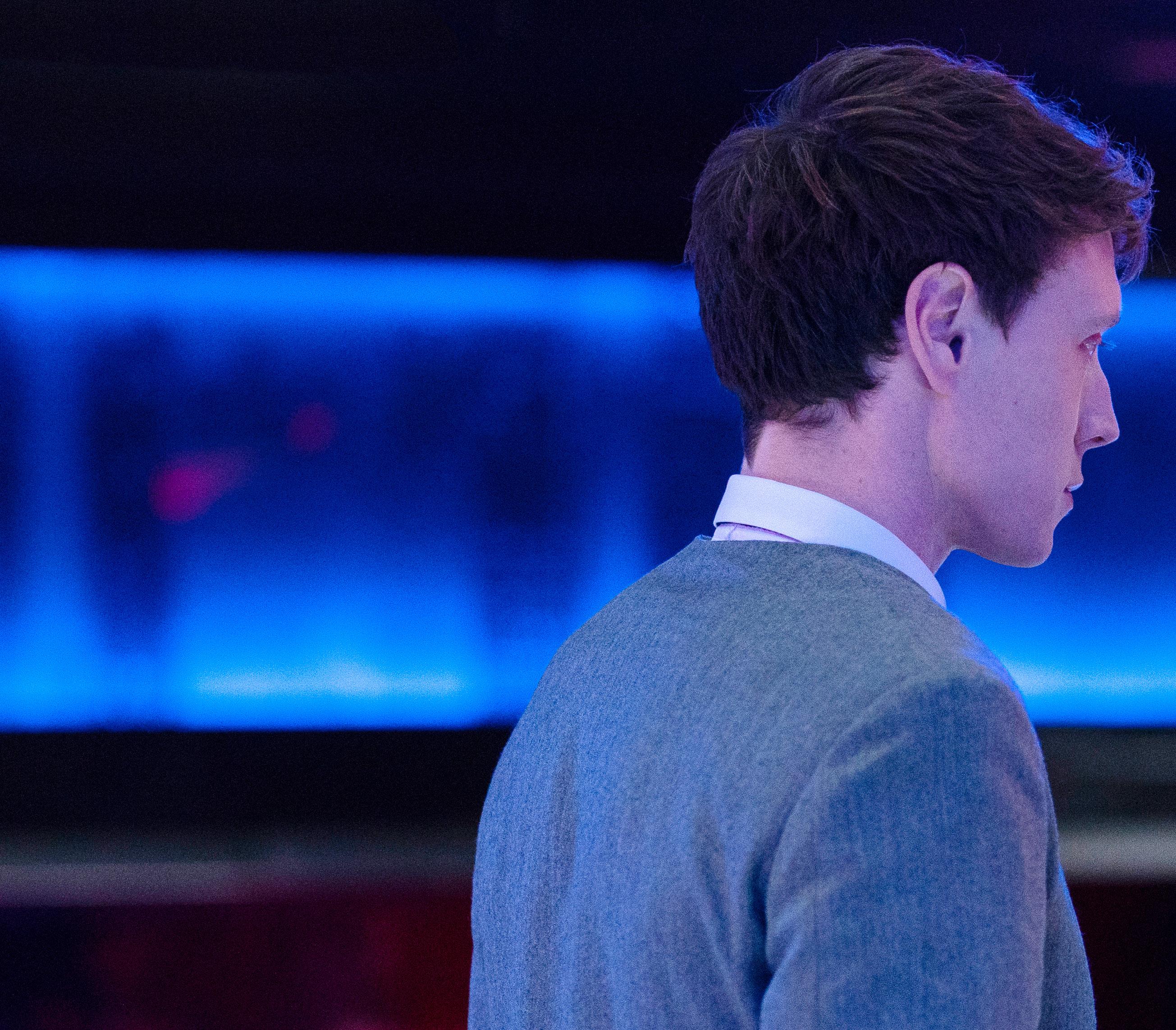
In 1910, the protagonists, married Gabrielle and Louis, a suave singleton, flirt with one another during a party at a belle epoque art salon in Paris. Yet, despite their mutual attraction, Gabrielle reveals she cannot be involved in a relationship due to a catastrophic premonition that threatens her own annihilation. This, and a mass flooding event with explosive moments, curtails their romantic inclinations.
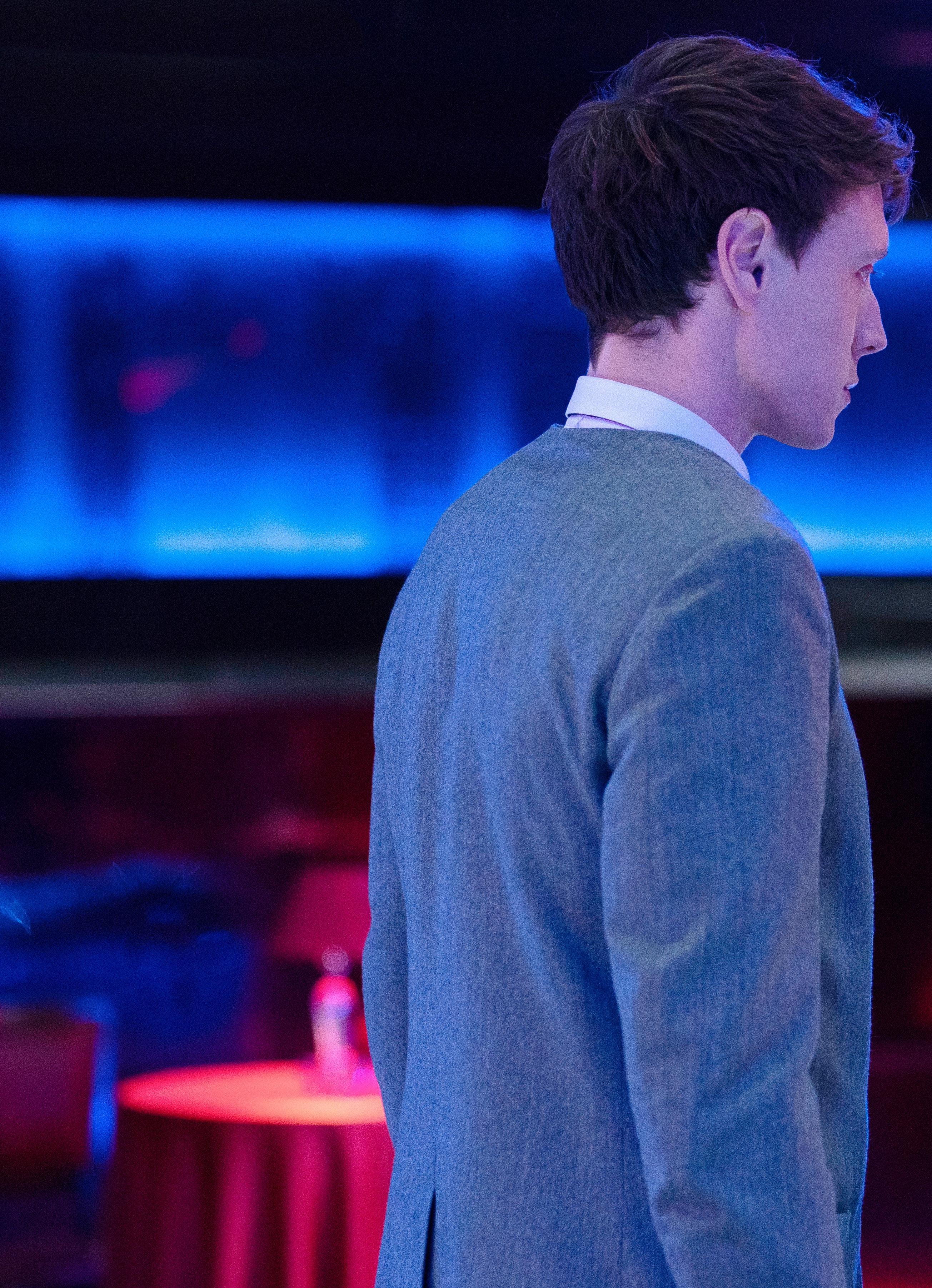
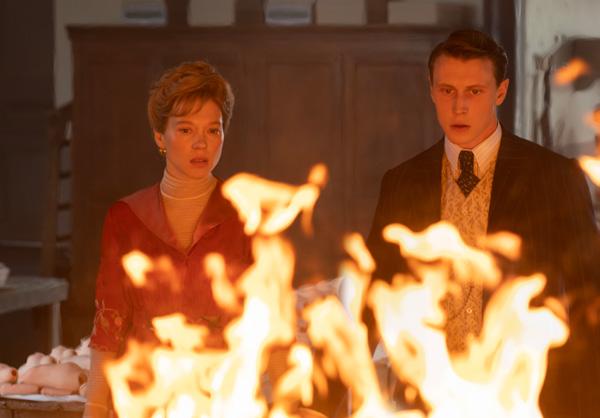
Over 100 years later, in Los Angeles 2014, the story finds Gabrielle as an aspiring model/actress and Louis an angry incel on the verge of violence, as he stalks Gabrielle from a Downtown nightclub to her home in the Hollywood hills. In 2044, Gabrielle has become a menial worker in a world where AI reigns over society and personal isolation is the norm. She meets Louis again at a DNA purification centre, where they are both about to undergo a process that cleanses humans of distracting emotions.
Co-written by Bonello with Guillaume Bréaud and Benjamin Charbit, La Bête is loosely-based around American-British author Henry James’s 1903 novella The Beast In The Jungle, concerning a man who is seized with the belief that his life will be defined by some sort of catastrophic event, that is lying in wait for him as if it were a beast in the jungle.
The film stars Léa Seydoux as Gabrielle and George MacKay as Louis, with Guslagie Malanda and Dasha Nekrasova in supporting roles.
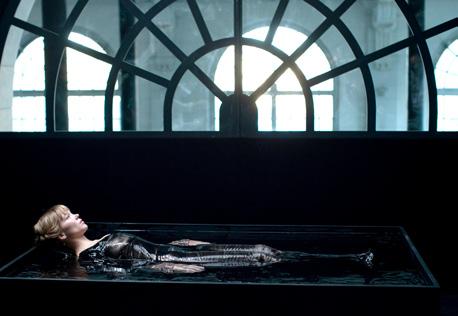
La Bête had its world premiere at the 2023 Venice International Film Festival, where critics praised Bonello’s first outing in the sci-fi genre, the nuanced performances of the cast, and Deshaies’s atmospheric cinematography.
Deshaies is a regular collaborator with Bonello, with credits including The Pornographer (2001), On War (2008), House Of Tolerance (2011) and St Laurent (2016), which were all shot on 35mm film.
“I have known Bertrand since 1996, and over the years we have collaborated on at least a dozen shorts, longform and experimental films together,” says Deshaies. “I was familiar with Henry James and his work, and had fantasised about a director calling me about one of his other short stories, The Figure In The Carpet (1896), for many years. So I was thrilled when Bertrand told me about his adaptation of The Beast In The Jungle.
“Whilst La Bête is a sci-fi movie, that’s a genre that neither of us had shot before. Bertand’s pitch to me was that it was essentially about the history of human sentiments – loneliness, fate and especially love between people – and how feelings change over the course of time.
“I thought this was wonderful, as we live in an age where we don’t speak enough about those things. I really liked the narrative scale, how the story was spread across 124 years of the past, present and the future, and took on-board Bertrand’s desire for it to be sober and low-key in its visual storytelling.
“Sci-fi movies tend to be super-technological, super-slick and sophisticated, or post-apocalyptic, and

ours was neither of these. This film was more about understanding sentiments, the emotional engagement and the disconnection between the characters after AI takes everything away.”
Deshaies adds, “Bertrand’s films always reflect his love of cinema and its history. So with this in mind, I decided to shoot using old and new technologies – film, digital and mixed media sources, like smart phones an surveillance cameras – and to switch between aspect ratios for the different eras, but keeping the transitions as subtle as possible.”
For the story that occurs in 1910, a third of the movie’s running length, Deshaies says, “shooting on 35mm film in classic 1.85:1 aspect ratio was the obvious choice.”
As the 2014-based story deals with humans being observed through new media – cell phones, computer screens and security cameras – she switched to digital and mixed media sources, framing in 16:9 to echo the typical screen size of modern TV and digital devices.
The 2044 section, dealing with a dystopia in which humans and their feelings have been crushed by AI, she opted to stay using digital cameras, but with image size constrained to 1.33:1.
With regards to visual references for the 1910 story, Deshaies points to director Max Ophüls La Ronde (1950) and The Earrings Of Madame De... (1953) (both shot by DP Christian Matras), plus The Age Of Innocence (1993, dir. Martin Scorsese, DP Michael Ballhaus ASC), as being melodramatic
LA BÊTE•JOSÉE DESHAIES 66 MARCH/APRIL 2024 CINEMATOGRAPHY WORLD
P Josée Deshaies factored analogue film into the hybrid/ mixed-media production of Bertrand Bonello’s timetravelling dystopian drama La Bête, notably using KODAK 35mm to infuse the historic portion of the storytelling with sumptuous elegance and brooding emotional atmosphere.
We lit the film with all sorts of sources – Tungstens, fluorescents, neons, HMIs and LEDs
the gaffer.
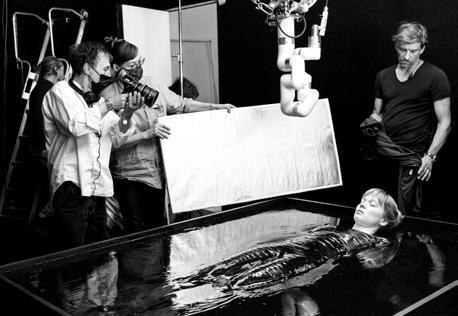
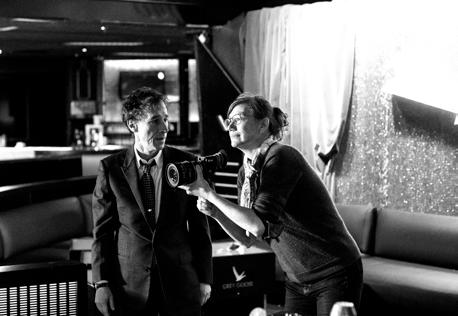
“We lit the film with all sorts of sources – Tungstens, fluorescents, neons, HMIs and LEDs,” she remarks. “LEDs are very useful, but when I shoot on film, I find they have bad colour rendition on the actors. So I tend to use LEDs in the background, and light skin or faces with with Tungsten, as that always look good.

masterpieces and close to her heart for their elegant and expressive depictions of seduction, passion and affection, through colour and smooth crane, dolly and tracking camera movements.
She reveals that the 2014 section was inspired by ‘slasher’ films, selffilmed footage posted online by a notorious incel (now no longer available). Feeling that towns, cities and people will probably look the same in 2044, she shot just digital and went with her own visual intuitions using a closeddown, more claustrophobic frame.
Filming on La Bête took place around Paris in late August 2022, and at a villa in the south of France dressed to appear as Los Angeles in 2014. Production also took place over two nights in Downtown Los Angeles, where the car work was shot, before production wrapped in October.
Deshaies shot the 1910 segment with an ARRICAM LT 35mm film, using Leitz Summilux-C and an Angènieux zoom lenses. She used an ARRI Alexa 35 with the same lenses for the 2014 and 2044 portions. The camera and lens package was supplied by TSF in Paris.
“I shot with the ARRICAM LT 35mm film camera as it is a great workhorse – compact and lightweight, and ideal for sync-sound. The ARRI Alexa 35 has more subtlety in the colour palette than previous cameras,” says Deshaies.
“Bertrand does not like weird cinematographic
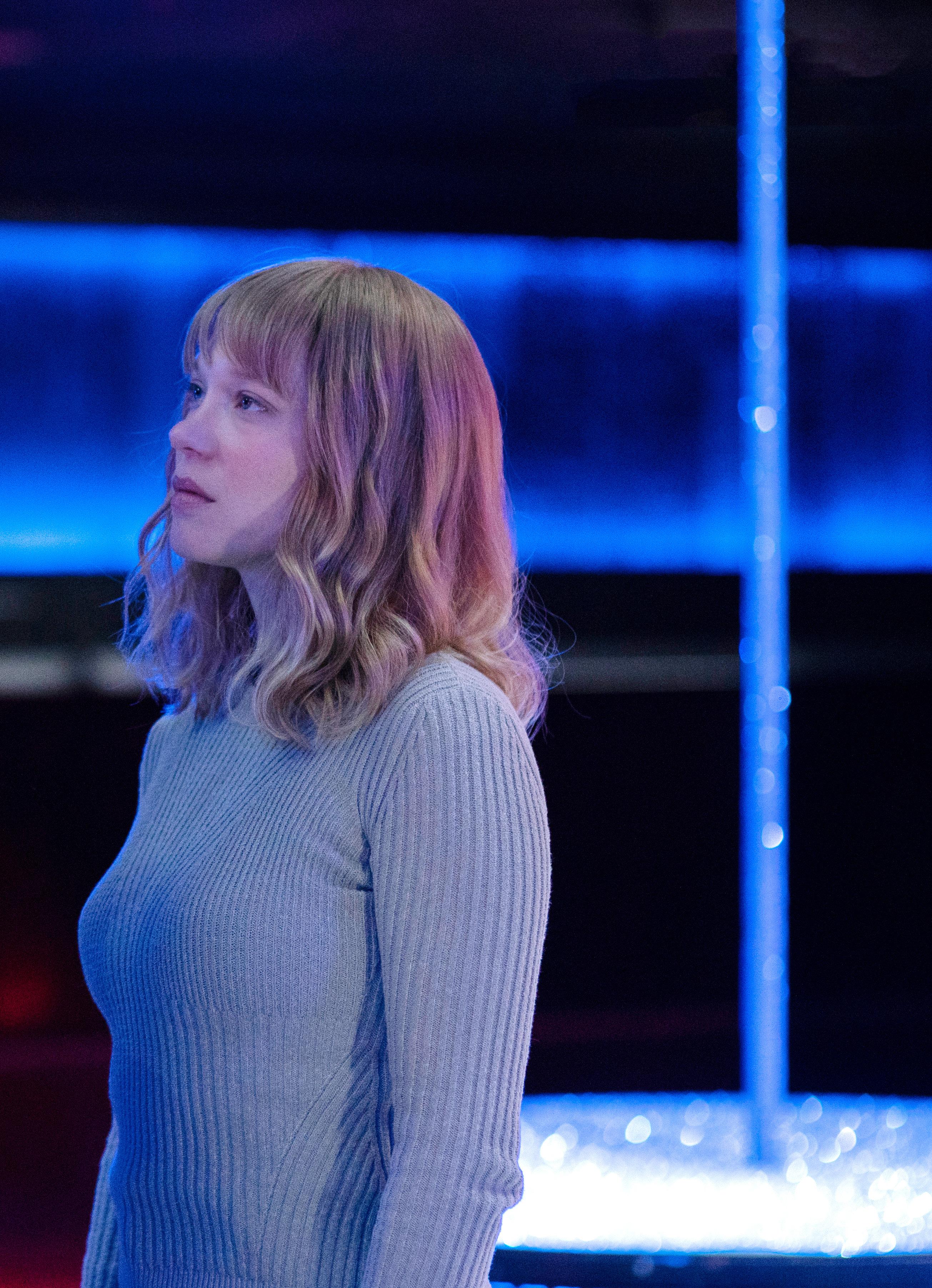

images, and I never shoot anything strange for him in-camera. I really like the Summilux-Cs as they don’t cheat on you or add too much character to the image – they are faithful to what I see with my eyes, whether I’m shooting film or digital. Colours and skin tones retain their natural look-and-feel, and the pictures feel human, but without being too sharp or flat. Also, the Summilux-Cs are fast and compact in size, which helps efficiency.
Deshaies used just KODAK VISION3 500T 5219 to capture the 1910 portion of the film, exclaiming, “With its 500ASA rating I knew I could use the 500T for everything. I could shoot brightly-lit scenes by using NDs and rating at 320ASA, and knew the 500T would have enough exposure latitude to capture darker scenes, such as during the flood. The rendition of the overall colour palette and details in the blacks are quite amazing, and it gave us a suitably soft, sensuous and sumptuous look.
“It’s much more economic and easier to manage the logistics on a daily basis when you just use one emulsion. When you have different types of film stock, it’s harder to use-up the short-ends before you wrap.”
Film processing was done by Hiventy in Paris, with the 4K scanning and final colour grade done by Jérôme Cloutier at Mels in Monreal, Canada.
Deshaies operated during shoot, supported by 1st AC Anthony Huneault, shooting from the dolly or tripod, and performing simple pans or locked-off shots in-keeping with the sober and restrained approach. Loïc Andrieu operated Steadicam, with Gaston Grandin working as key grip, and Marianne Lamour as
“The approach was to use light, shade and colour to heighten the emotion of the drama, whilst generally showing restraint. However, there were multiple nightclub scenes, and reflecting the energy, music and psychological atmosphere for each of those different settings, through blue, green, magenta, yellow and black light, was a huge challenge that we spent months
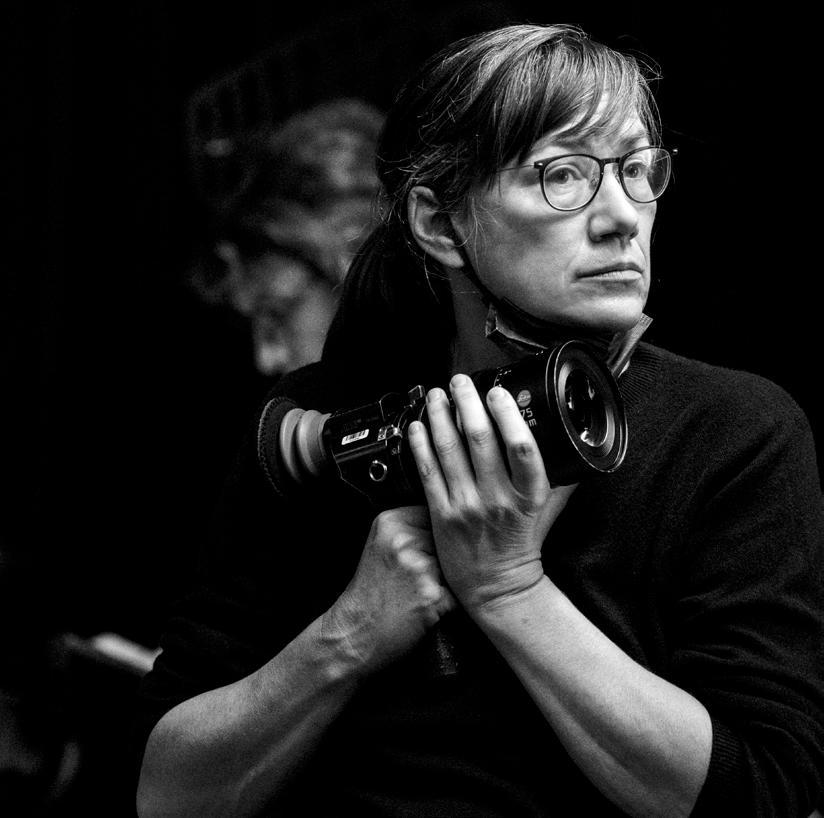
preparing for. I have to thank Marianne, my ‘rainbow’ gaffer, and her team for pulling those off.”
Deshaies concludes, “I love shooting with Bertrand. He works hard and trusts my eyes and judgements. He is always calm and gently-spoken, which creates a lovely atmosphere amongst the cast and crew. It was great to include 35mm film into a production that was technically like a history of the different image-making devices you can use, and it played a perfect part in the arc of the visual storytelling.”
CINEMATOGRAPHY WORLD MARCH/APRIL 2024 67 JOSÉE DESHAIES•LA BÊTE
Images: Photos by Devin Yalkin. All Rights Managed. Courtesy of A24.

IT’S A KNOCKOUT!
By Ron Prince
Captured on Kodak 35mm film, and written/directed by Sean Durkin, The Iron Claw depicts the real-life triumphs and heart-breaking tragedies that befell promoter Fritz Von Erich and his sons after achieving success in the professional wrestling ring during the late 1970s and throughout the 1980s. The feature saw Durkin reunite with Hungarian DP Mátyás Erdély HCA and the chance to make a hard-hitting sports movie with profound emotional resonance.
Taking its title from a signature hand-on-head grip used by the Von Erichs, The Iron Claw depicts the lives and times of the Texas-born brothers under tutelage of their domineering, dynasty-building father, a former champion wrestler turned promoter. Raised to be the toughest, strongest and most successful warriors out there, Kevin, David, Kerry and Mike became huge stars on the Texas wrestling circuit, fighting at the Dallas Sportatorium, until the physical and psychological pressures of the family business saw three of them die through suicide or self-harm.
The film, hailed for the contrast between its compassionate exploration of family connections and depiction of macho physicality, stars Zac Efron, alongside Harris Dickinson, Jeremy Allen White and Stanley Simons as the Von Erich brothers, with Holt McCallany as their domineering father Fritz, Maura Tierney, their mother Doris, and Lily James as Kevin’s girlfriend and later wife, Pam.
Principal photography on The Iron Claw took place at locations around Baton Rouge, Louisiana, over 34 shooting days during October and November 2022. The exterior and interior of a voluminous former furniture store were converted to resemble the site of the original Dallas Sportatorium, where the cast were filmed performing a variety of full-length wrestling matches, in front of live audiences, rather than selected scenes. Other nearby venues were also used to film additional wrestling contests that also feature in the film.
Erdély is highly-regarded for his outstanding cinematography on Laszlo Nemes’ multi-awardwinning Holocaust drama, Son Of Saul (2015), and the acclaimed pre-WW1 drama Sunset (2018), both of which were shot on Kodak 35mm film. The Iron Claw represents his third collaboration with Durkin, the pair having previously worked together on the BAFTA-winning British TV drama series Southcliffe, followed by Durkin’s 35mm-originated psychological drama, The Nest (2020).
“Sean first told me about The Iron Claw when we were shooting The Nest, and I started laughing because I thought he was joking. I didn’t know anything about wrestling, nor his interest in the sport, and nothing about the Von Erich family,” Erdély reveals.
“But I was deeply moved when he told me the heart-breaking story of the family’s tragic demise, and
THE IRON CLAW•MÁTYÁS ERDÉLY HCA
68 MARCH/APRIL 2024 CINEMATOGRAPHY WORLD
I loved how his script showed understanding empathy and love towards the characters. I thought it would be a fascinating production that could address very difficult, universally-human subjects about love, trauma and loss, in a beautiful way.
Although I spent a considerable amount time familiarising myself with the Von Erich’s and watching their wrestling matches, I was not particularly influenced by the way sports like this are usually covered.
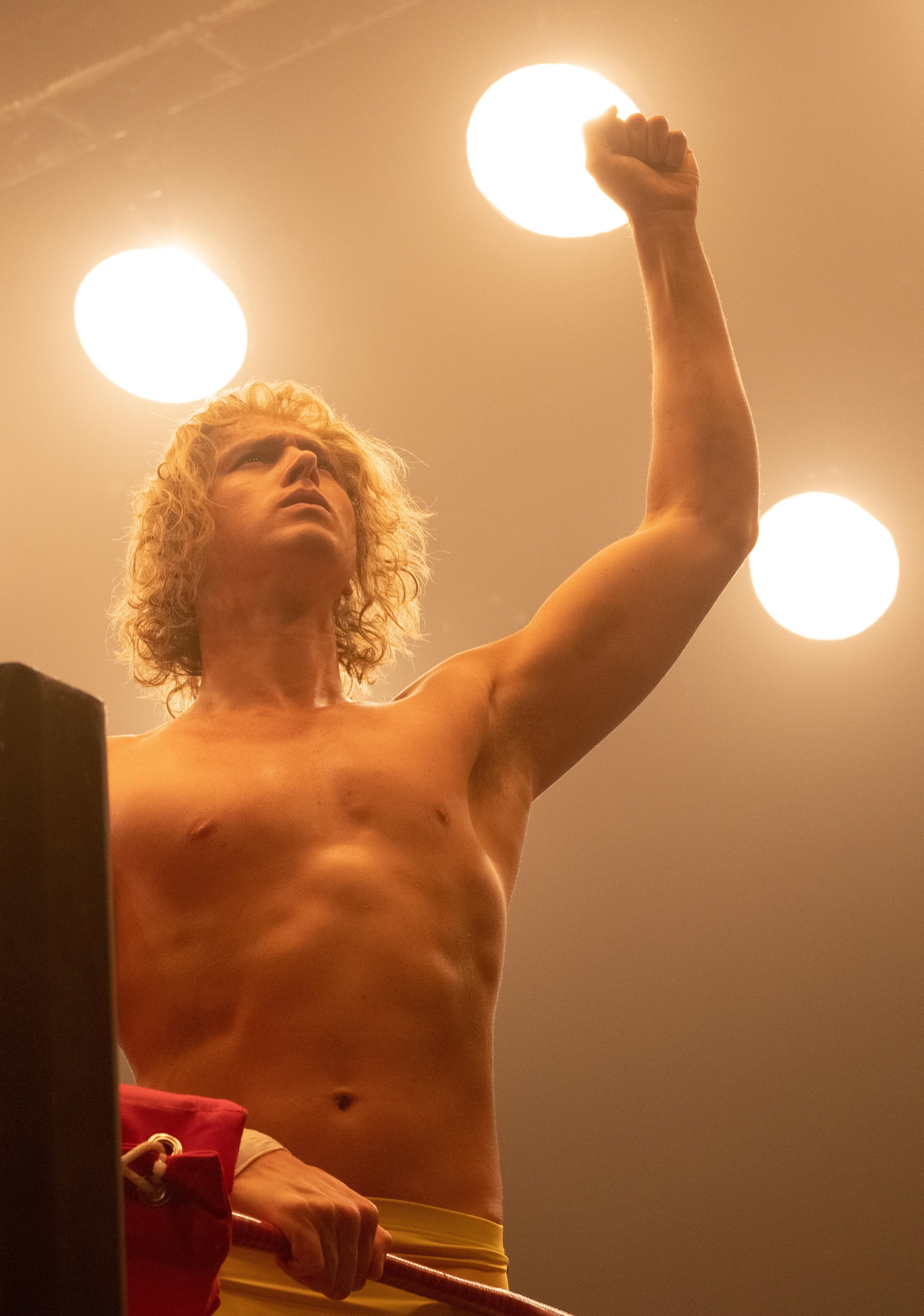
I actually based all of my decisions on Sean’s script and the emotional sensibilities of the characters at any given moment.”
In terms of the aesthetic look of the film, Erdély says, “Sean and I innately share the same taste, style and understanding of how different scenes need to be shot, and our rapport is a good as it gets. As with The Nest, this was another period piece, and we agreed early-on that we would not do anything technically to impose a particular look – no filters, no look development, no vintage lenses, no visual clichés. We would simply let the locations, props, wardrobe, hair and make-up carry us to that era, using mainly Tungsten lighting and via the medium of 35mm film. The filmed image always feels so much more powerful than anything on digital.
The filmed image always feels so much more powerful
“However, we did talk about the necessity for this film to feel ‘American’ – sunny, colourful and dynamic – as well as being masculine, muscular and sweaty, all of the things that you would typically associate with the wrestling world.”
Translating this into framing and equipment choices, especially optics, led Erdély to select what he describes as “classic American tools”, namely Panavision Primo spherical lenses which combine high contrast, even field illumination with negligible veiling glare, ghosting or distortion.
“The Primos are classic, old-school workhorses that have been used on so many amazing movies,
MÁTYÁS ERDÉLY HCA•THE IRON CLAW
CINEMATOGRAPHY WORLD MARCH/APRIL 2024 69


and deliver an elegant look, but without vintage character. Sean and I did not want to go widescreen with Anamorphic, as that would have made too strong a statement in itself. After testing, we felt in our bones that shooting spherical in the more classic rectangular 1.85:1 cinema format, with quintessential American and romantic-looking Primos, was the way to go.”
The Primo lens-set, a Panaflex Millennium XL2 35mm camera, plus a specially-adapted ARRIFLEX 235 35mm camera, which was used as an actioncam for the fight scenes, were provided by Panavision New Orleans.
“I went with the Millennium XL2 as it has flexible configurations and would be quiet-enough when recording sync-sound,” says the DP. “In order to keep me safe from accidental injury when filming the fights, at my request, Panavision modified the ARRIFLEX 235 by substituting the eyepiece for an SD tap and a monitor, which I used to compose shots. They also removed the batteries, so that the camera would be lighter and allow me to move quickly and easily when I was the ring with the actors.”
As to his choice for filmstocks, Erdély remarks, “Apart from the opening sequence in B&W, when I used KODAK DOUBLE-X 5222, there was only one choice for me – KODAK VISION3 500T 5219.
“I used just the 500T on Son Of Saul, Sunset and The Nest, and decided to do exactly the same on The Iron Claw. For me the 500T is Kodak’s most filmic
stock. I love the way it looks, especially how it renders skin and facial tones, and there was going to be a lot of skin in this film.
“From my previous experiences, I knew I could shoot with the 500T in every scenario – night and ultra-low light situations, or with ND filters on bright day interiors/exteriors. It never ceases to amaze me how much detail the 500T captures in the image – in the darkest shadows and brightest sunlight.
I don’t like pretence or anything fake
“Also, shooting with just one stock gives a visual consistency of colour, texture and contrast, and it’s very fast and economical during production too, as you don’t have to deal with the logistics of loading multiple filmstocks and working out what to do with the leftovers.”
Recalling the opening sequence, Erdély notes, “Although I could have shot the scenes at the start of movie on colour negative and then drained picture to monochrome in post, I don’t like pretence or anything fake. Real B&W filmstock looks much better. The DOUBLE-X 5222 has a different grain structure, a superb scale of tonal contrast, and the way highlights tend to have a little halation around them brings an authentic sense of character to the image.”
Film processing of the 500T and DOUBLE-X 5222
was done at FotoKem. 4K scanning and dailies were supervised by Company3, in Los Angeles, where colourist Sofie Friis Borup later completed the final colour grade.
As with his previous productions, Erdély says the style of illumination was all about keeping things straightforward, minimalistic and naturalistic.
“I generally like to create the emotional mood of a scene with the simplest and fewest number of lighting fixtures as possible, and this way of lighting supports working quickly,” he says. “Many of the exterior day scenes were shot in available light. I lit day interiors with HMIs through the widows, and used practicals, along with a very few traditional Tungstens or LiteGear LED Lite Mats overhead, for ambience. We lit the scene at the dinner table just from the chandelier.
“Lighting the fight scenes in the Sportatorium, however, was a little more conceptual, as I followed an arc in the way wrestling contests were lit over the years. To explain, wrestling was initially very lowbudget and very low-tech in terms of lighting. As it became more popular and more-broadly televised, the arenas became far brighter and much more colourful. But when audiences and TV revenue dwindled, it went back to that low-tech, small-town kind-of-feel. So we mirrored that journey of light using Tungstens, and moved from scenes that were darker, less colourful and less contrasty, to ones where the look was far more vivid and vibrant, before toning things down again.”
Erdély operated the camera throughout production, supported by 1st AC Glenn Kaplan, along with the combined talents of gaffer Allen Parks and key grip Nick Leon on the lighting, whom he describes as his “biggest allies” in the distribution, rigging and shaping of the lighting.
70 MARCH/APRIL 2024 CINEMATOGRAPHY WORLD
THE IRON CLAW•MÁTYÁS ERDÉLY HCA
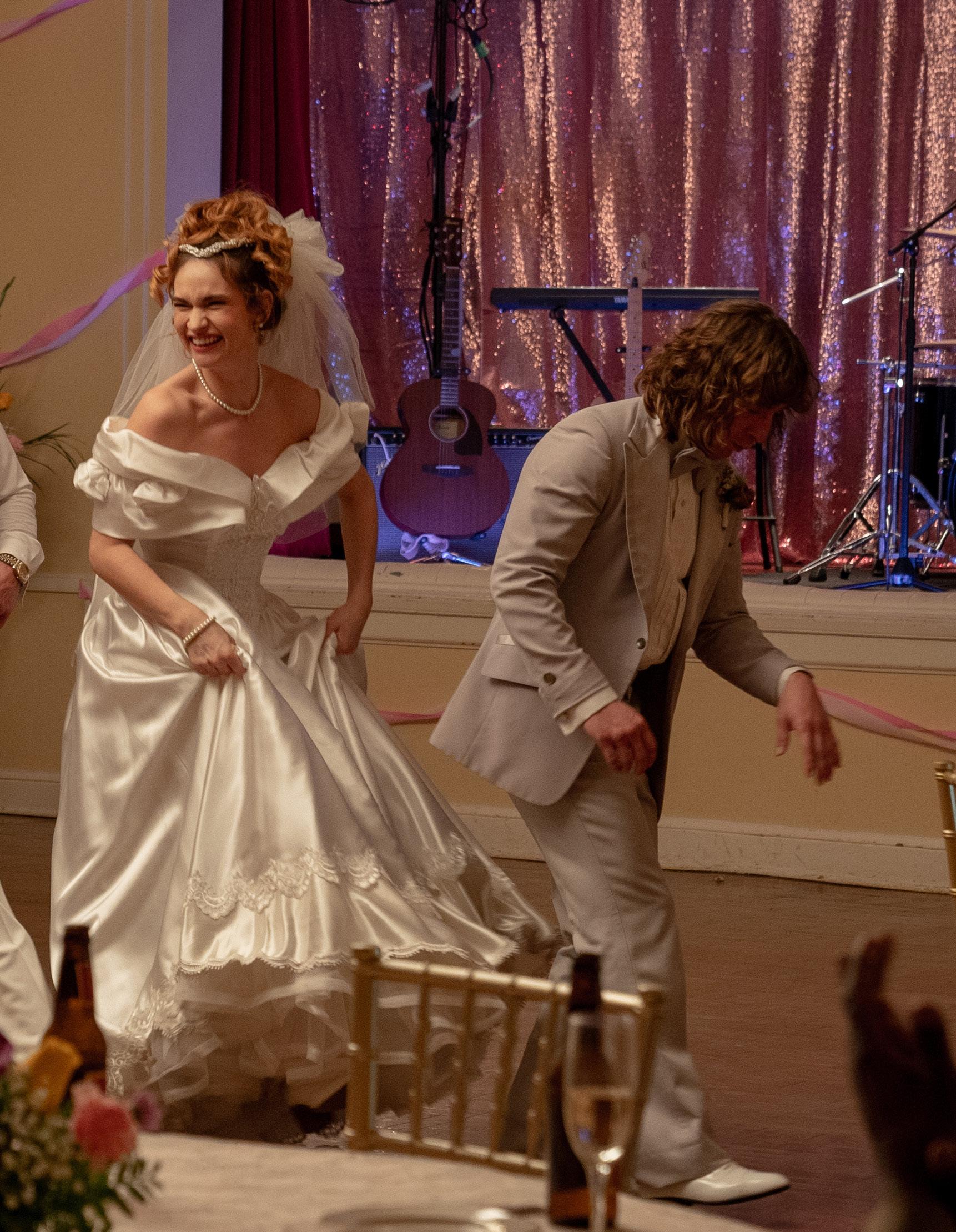
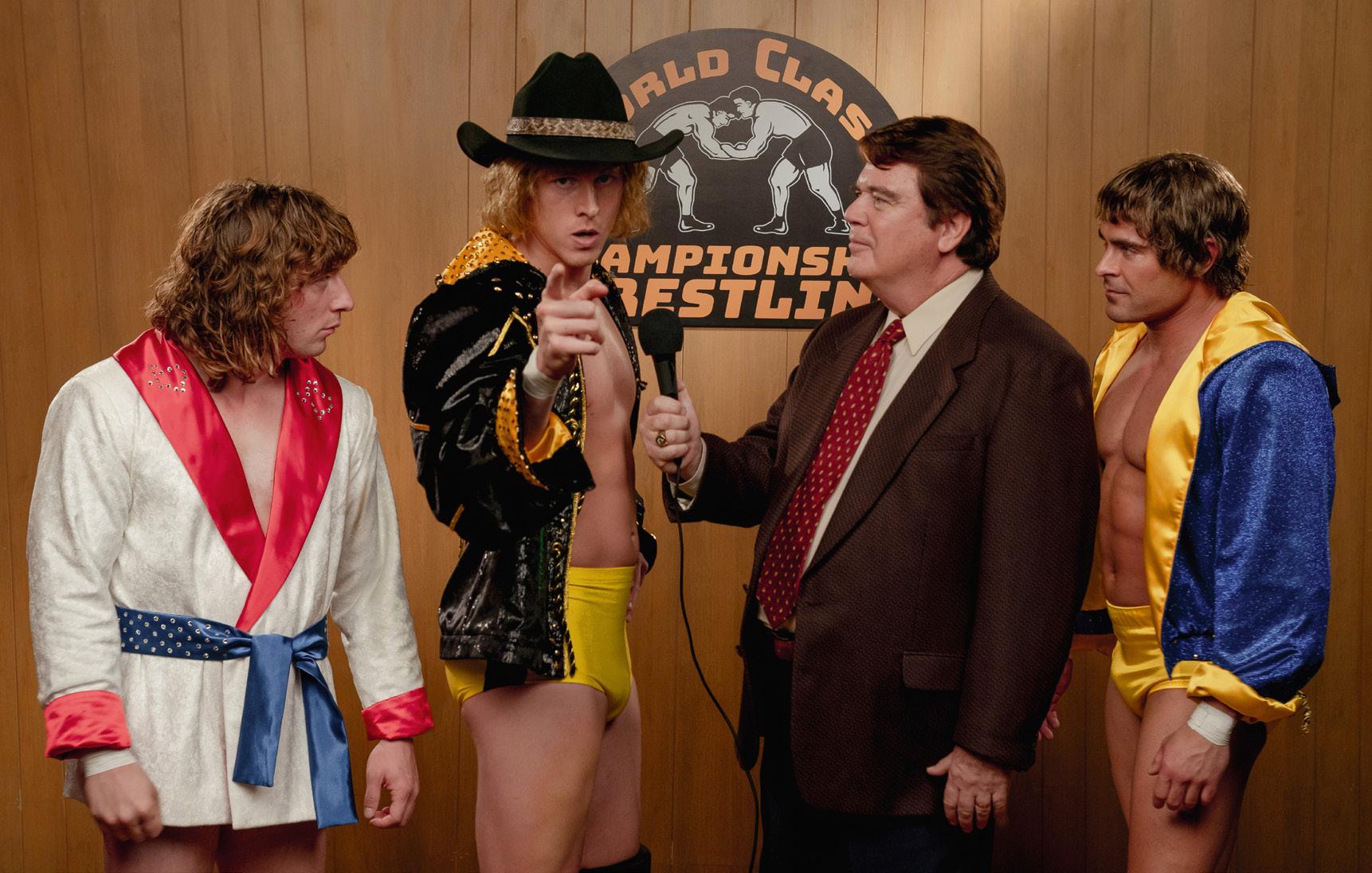
“The pace of production was super-quick, because we used simple camera, grip and lighting equipment – no techno cranes or remote heads, just 35mm cameras, operated handheld or on simple dolly and tracks, with old-school lights, and very little by the way of LEDs on dimmer boards.”
Looking back at his experience of shooting The Iron Claw, Erdély concludes, “It was amazing to watch the sheer athleticism of the actors flying around the ring, although I really had to control

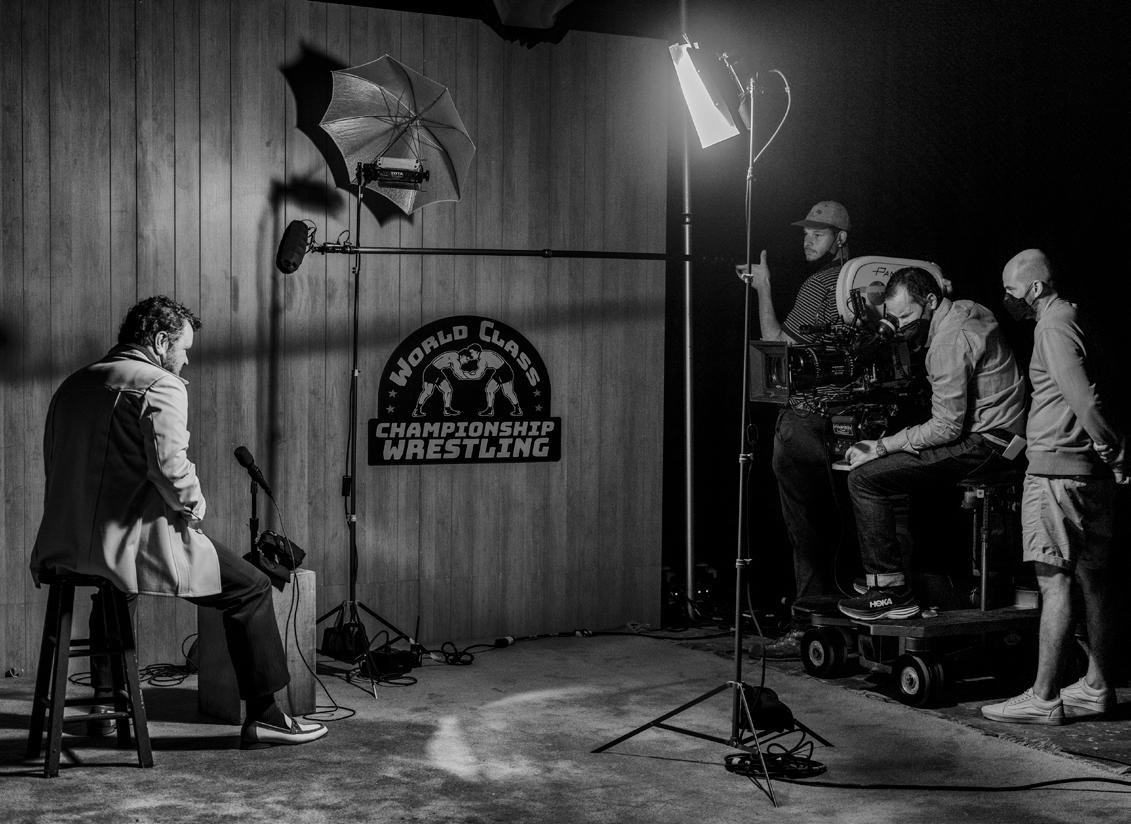
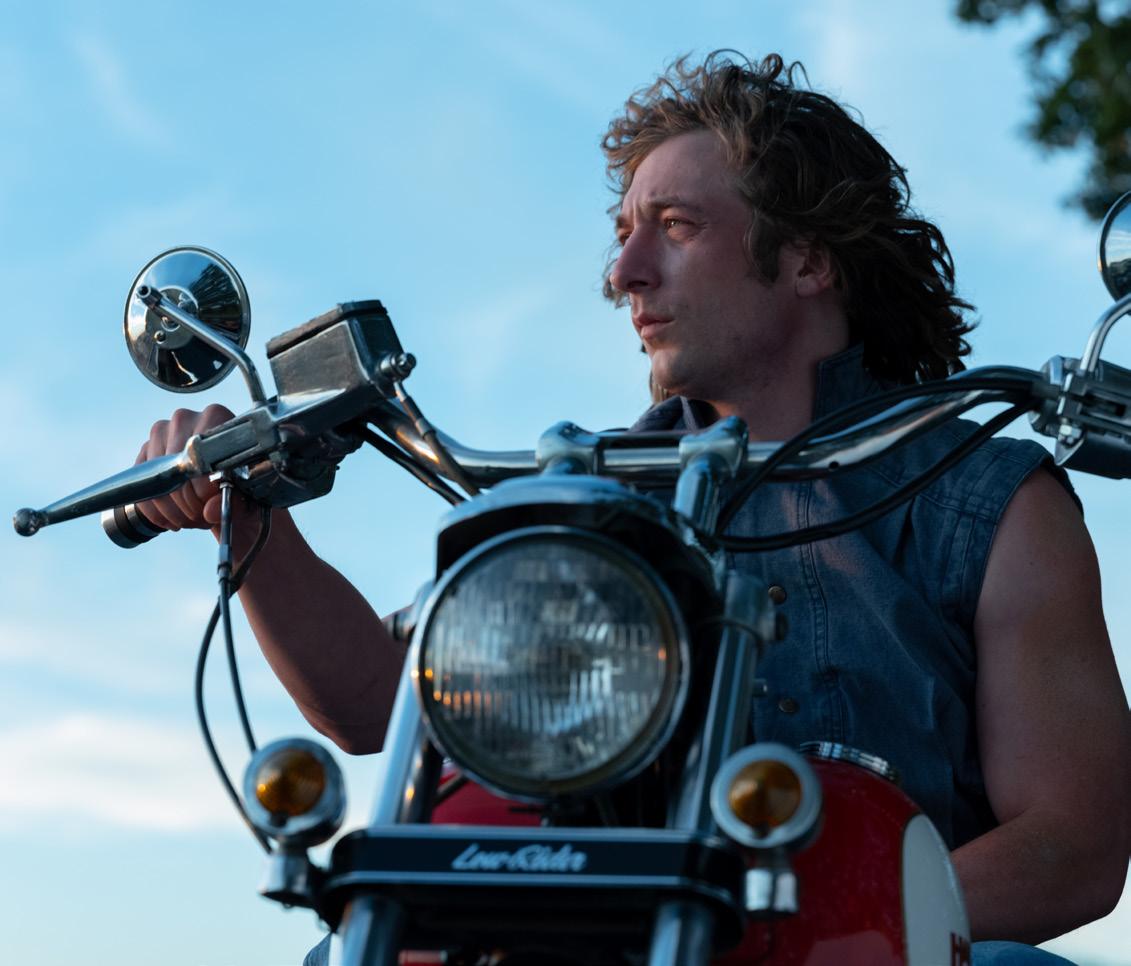
my own emotions, and stay calm, during the more tender and moving moments in the film.
“I also enjoyed working with Sean again, who is so good-natured and a supremely talented filmmaker. And I absolutely loved the experience of shooting on film again. I think we’ll shoot film as long as there is a lab that can develop it and a manufacturer producing it. It just looks so good, especially on important and existential stories like this.”

MÁTYÁ S ERDÉLY HCA•THE IRON CLAW CINEMATOGRAPHY WORLD MARCH/APRIL 2024 71 Copyright: Photos by Greta De Lazzaris.
A JOURNEY OUTWARD
By Darek Kuźma
Paolo Carnera CSC’s evocative and empathetic lensing underscores the agonising adventure of two young boys as they leave Dakar to reach Europe, in director Matteo Garrone’s Oscar-nominated migrant drama Io Capitano.
As Europe will soon enter the second decade of the migrant crisis that changed the continent in more ways than one could imagine, its filmmakers approach the byzantine issue from a variety of standpoints.
not making a social drama.
“If you think about migrants from a Eurocentric perspective, everything has already been said. We wanted to show the journey through the eyes of boys who don’t have to escape war or famine. They want to discover the world, its promises, its opportunities, but young Africans are typically not allowed to travel across countries. They can’t go hitchhiking to get to know themselves, like many Europeans do. Seydou and Moussa do it illegally, which is dangerous and expensive, and they also get to confront their dream with how the real world works.”
only slightly enhance what I saw with my own eyes. Not to create a cinematic illusion but to show the truth of all the places we shot at.”
“We captured all the Sahara scenes in a real desert in Morocco with its windstorms and sandstorms and temperature drops. Then went to Casablanca which stood-in for Tripoli and the Libyan prison, and we wrapped near Sicily where we recreated the characters’ passage through the Mediterranean Sea on a small ship full of other people,” he reminisces.
As Io Capitano’s number one priority was emotional and visual honesty, they decided to shoot the entire film chronologically on-location.
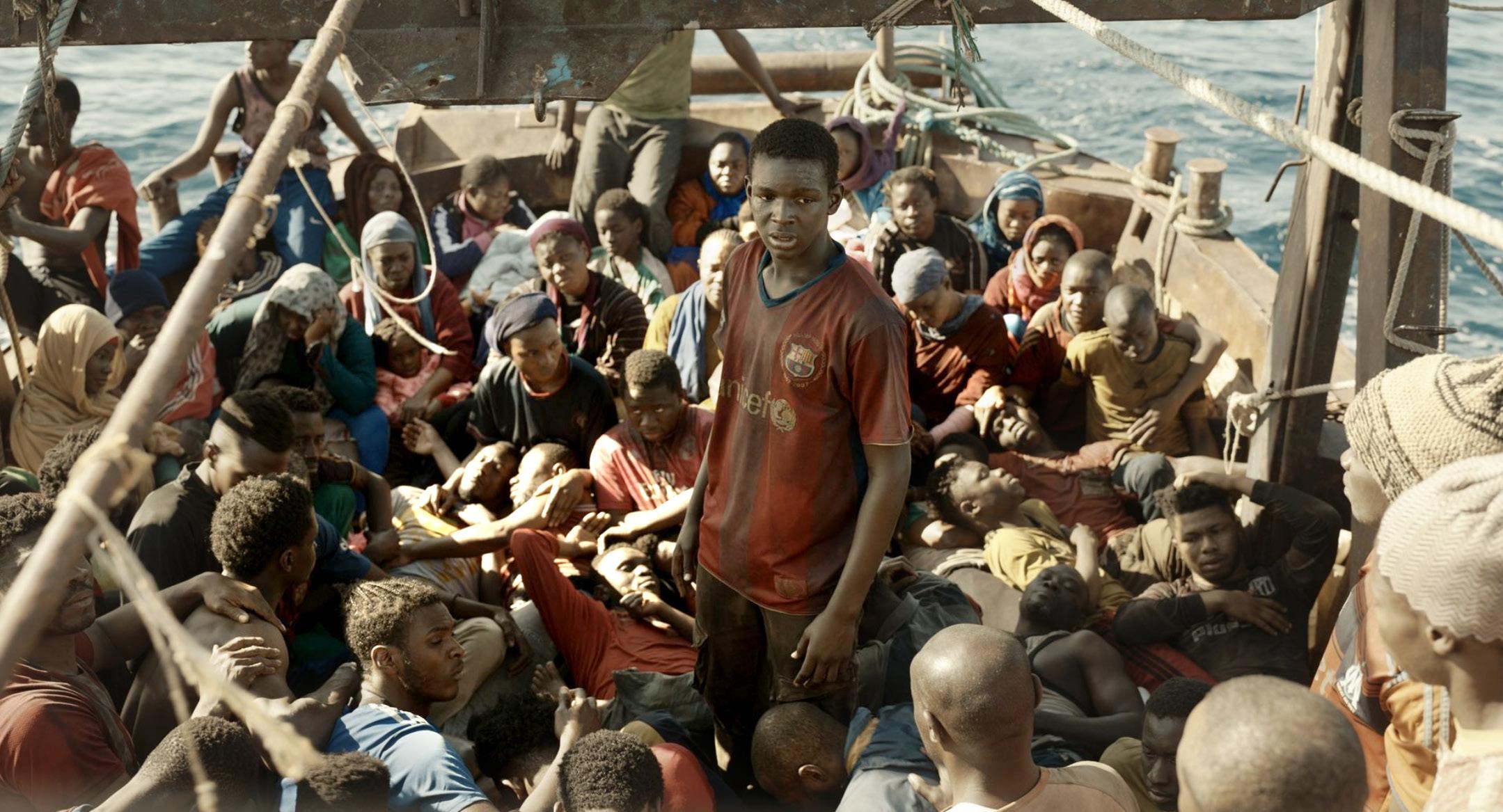

In Io Capitano, Italian director Matteo Garrone takes the road-less-travelled and adopts the perspective of Seydou and Moussa, two boys who leave Senegal to chase their European Dream only to face a series of ordeals, including the merciless Sahara desert, the danger of migrant traders, and an atrocious Libyan prison.

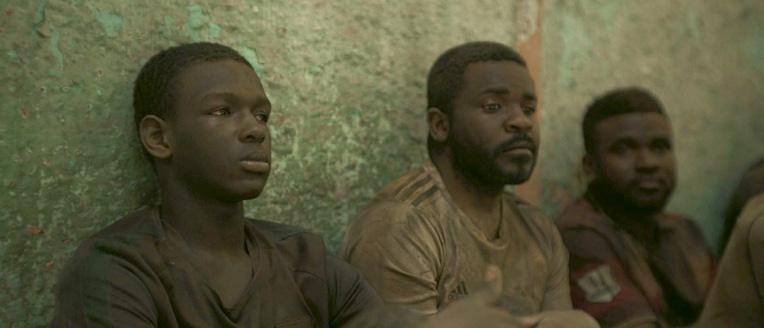
As we accompany Seydou and Moussa on their harrowing journey, Garrone and his DP Paolo Carnera occasionally infuse the film with fairytale tropes or magical realism, but above all they go out of their way to cast-out the European point-of-view and be culturally and emotionally-respectful to the characters themselves and their aspirations.
One would presume such an ambitious film might have required the rapport from a longstanding DP-director relationship, yet this was Garrone and Carnera’s first collaboration.
“Matteo knew my work and I have always thought his films are great, so we had an interesting conversation when he called me and instantly felt a connection. It was enough for me to join him on this project,” recalls Carnera who related to the idea of
“We started in Senegal and travelled extensively for ten weeks of shooting. It was the first time Seydou Sarr and Moustapha Fall, who play the boys, went out of their country,” relates Carnera. “They didn’t know the script, and each day Matteo told them what they had to do to maintain authenticity in their performance and reactions.”
The film was shot from March to June 2022. Principal photography would have started earlier, but because Garrone was adamant about shooting in chronological order, they had to wait for Morocco to loosen its Covid restrictions.
“It gave us more time for planning and locationscouting which wasn’t such a bad thing,” he laughs. “I took many photos which I then used during conversations with the costume and production designers. I didn’t want to make my version of Africa. Senegal was so beautiful that I tried to reproduce and
“We initially thought of doing the sea part in a studio as it’s difficult to shoot on open water, but ultimately decided not to do that for the sake of realism. The actors wouldn’t react the same on a stage as when they’re on a real boat with a hundred extras, many of whom crossed the Mediterranean for real and even advised us during the shoot.”
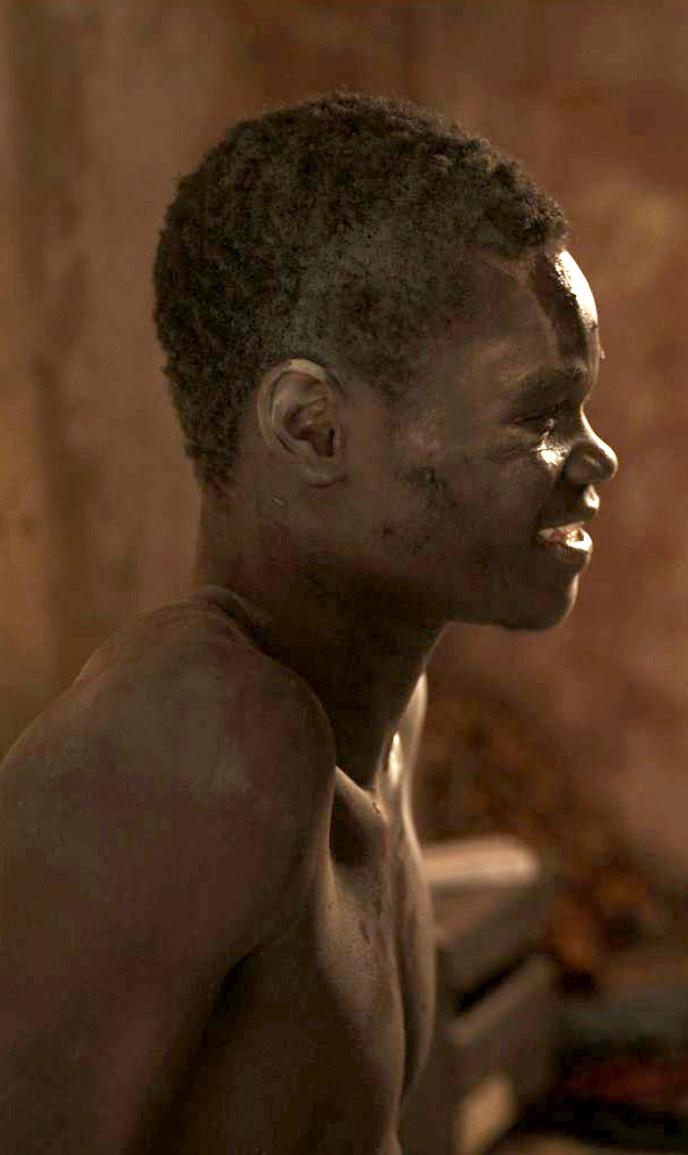


Carnera remembers this part as stressful and at the same time oddly-beautiful. “We had a second boat floating near with back-up equipment, just in case, but my small crew and I were on the ship with the people, shooting handheld and reacting to the energy of the moment, to the strength and beauty of the people’s faces, their emotions.”
His Io Capitano trusted team included A-cam/ Steadicam operator Matteo Carlesimo, 1st AC Tiziano Saraca, DIT Andrea Cuomo, gaffer Gabriele Gorga and key grip Fabrizio Diamanti.
“We all knew that, being white Europeans, we had to watch ourselves. We couldn’t allow ourselves to project our visions of reality onto the film, but rather we had to focus on reproducing the feelings of people who did these kinds of journeys. They call it ‘The Trip’.”
IO CAPITANO•PAOLO CARNERA CCS
72 MARCH/APRIL 2024 CINEMATOGRAPHY WORLD
The entire crew worked for the authenticity that clearly shines through everything we see on the screen. This includes Carnera’s striking compositions and visual contrasts between the vastness of the landscapes and Seydou and Moussa’s internal and external journeys.
“To complement our depiction of the characters and their environments, I referenced the work of brilliant photographers: how Steve McCurry uses colours to extract the feeling of a place, and how Sebastião Salgado looks deep into the soul of the people he photographs.”
To achieve all of this, Carnera decided to shoot on a combo of ARRI equipment: Alexa Mini LF and Signature Primes. D-Vision Movie People in Rome provided the camera and lens package.
“We did consider shooting on analogue film or on Alexa 65, but they were far too expensive for our budget. And besides, I knew the Alexa Mini LF would give me the quality of images that I needed. So the real question was what kind of lenses to go with,” he recalls. “I personally prefer vintage lenses
interiors and the car in which the characters cross the desert,” he relates.
“For interiors, I mainly used Dino lights to reproduce the strength of the beautiful sunlight. In the desert, I just reflected the natural light with boards and
I tried to reproduce what I saw with my own eyes… to show the truth of all the places
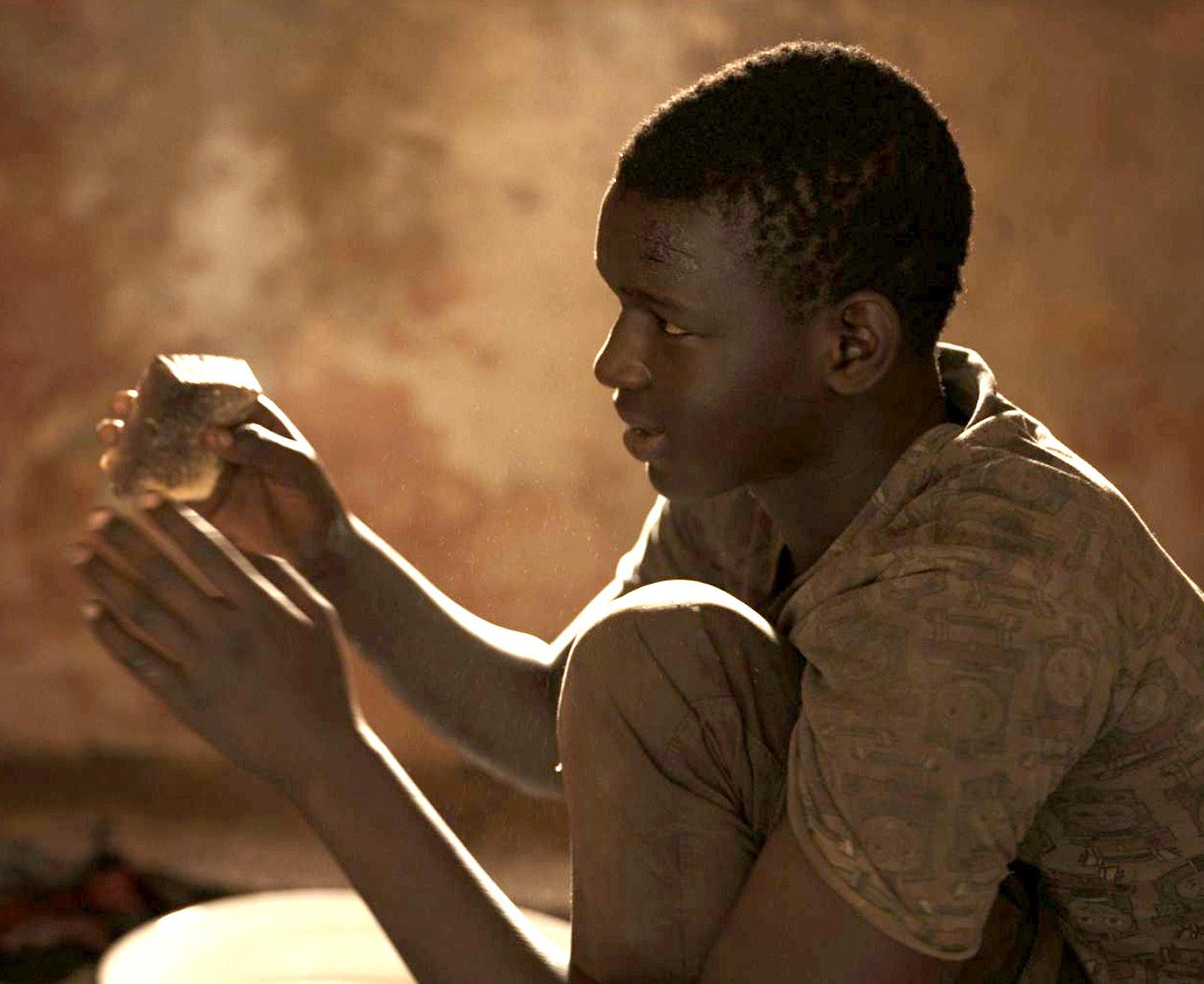
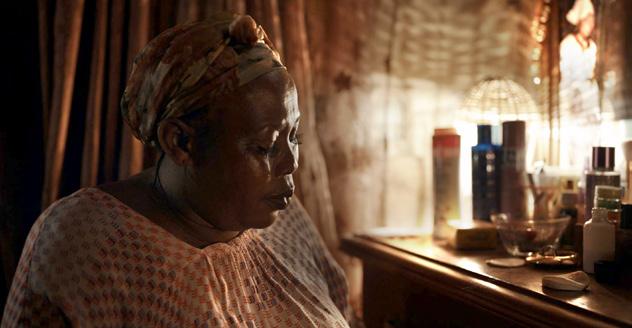
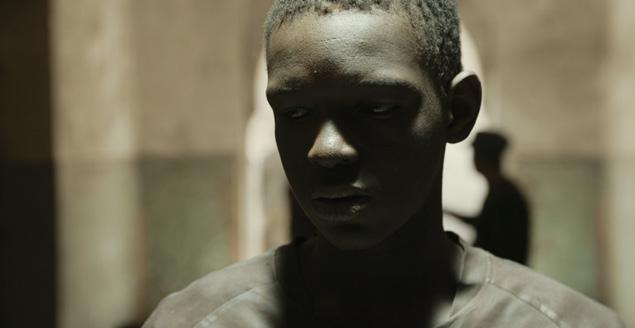
for the character they bring to storytelling but they didn’t fit this project. I knew we’d shoot most of the film on a Steadicam or handheld camera, so I went for Signature Primes which work really well with Alexa.”
“Their soft sharpness and lightness were perfect for the authenticity we were striving for. We also shot a lot in difficult conditions, so the Primes’ physical aspects really helped. We shot mostly with 40mm and 58mm, sometimes with 25mm and 29mm, but mainly in the medium range. No long telephoto lenses, no zooms, no tricks,” Carnera reveals.
“The idea was, again, to capture the power of African landscapes mostly as is it, just slightly enhanced with costumes and production design. Because of this, I tried to use natural light whenever possible. If I used any lights, they were mostly LEDs to assist me in my efforts to reproduce the colourful African worlds, especially with night
butterflies. We needed to be flexible. So I tried not to bring any heavy equipment and to allow the actors to feel free and discover the scenes together with Matteo. Also, Matteo needed to feel free to change his mind as to where to put the camera and how to frame a scene, and I wanted to be able to catch the sudden, powerful beauty of any unexpected events.”
140ft condors standing on a port pier. Each had 2 Dino lights gelled with sodium gel or fluorescent gel to reproduce the industrial illumination.”
After they wrapped, Carnera did the DI with longtime Garrone colourist Angelo Francavilla at Rome’s Grande Mela facility.
“I only knew Angelo by his reputation before, but the collaboration was excellent. I hate saying ‘We’ll fix it in post’ while I’m shooting, and I always try to have the in-camera images as close to the final ones as possible. That’s why, with Angelo, we only enhanced what we shot on-set and did some necessary tweaks. Then, we said we couldn’t do anything further and finished the grade after one week, although we were supposed to work for three.”
Carnera is proud of how the film looks but above all how it tells its beautiful, frustrating, poignant story through dialogue, images, gestures and sounds.
“We tried to provide the audience with the emotions of people who travel thousands of miles across harsh deserts and environments, and to come closer to what they believe Europe is. Each day of
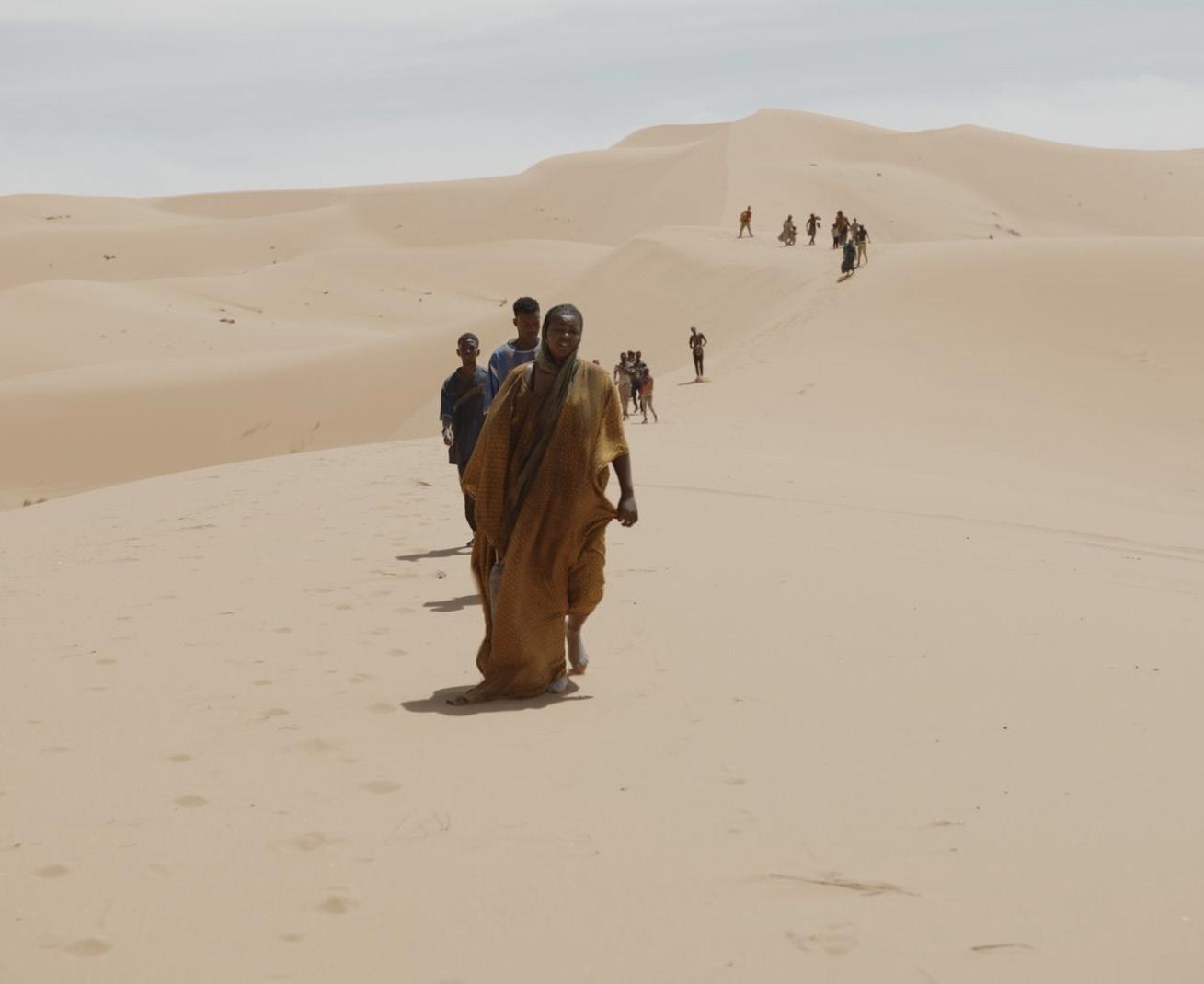


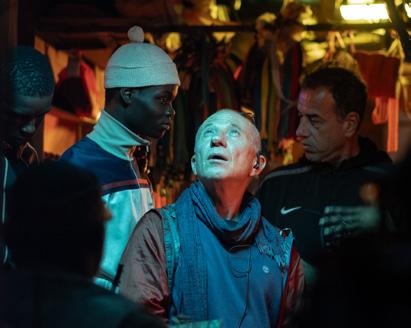
prep, each day of shooting, I reminded myself to be as close as possible to our characters as real human beings. To see the world with their eyes and leave the viewers to form their own opinions,” he reflects.
Along with the Dinos, Carnera also had HMI, ARRI M-Series’ M90, M40 and M8, SkyPanels 60s and 30s, plus Asteras in his lighting kit, provided together with grip equipment by D-Vision Movie People.
The only sequence that needed bigger sources was when the small boat of migrants passes a gloriously illuminated oil platform on their way to Europe.
“The platform itself is fully digital but the light on the boat and the lights lighting the people on the boat had to be real,” Carnera explains. “We shot it with a drone flying over the sea at night, and also inside the boat with the migrants. We had our sources on three
“We wanted young Europeans to experience Io Capitano like a coming-of-age adventure of two boys like them, to feel close to them. I don’t know if our film is different from other migrant dramas, but I certainly hope it will help people to see the other side of what is happening.”
CARNERA CCS•IO CAPITANO
PAOLO
CINEMATOGRAPHY WORLD MARCH/APRIL 2024 73
THE THINGS WE DO FOR LOVE!
By Ron Prince
Your cuticles can tell you a lot about your health. However, in director Christos Nikou’s romantic sci-fi drama Fingernails, shot with a speciallymanicured look on Kodak 35mm film by DP Marcell Rév HCA ASC, they offer an altogether different reading.
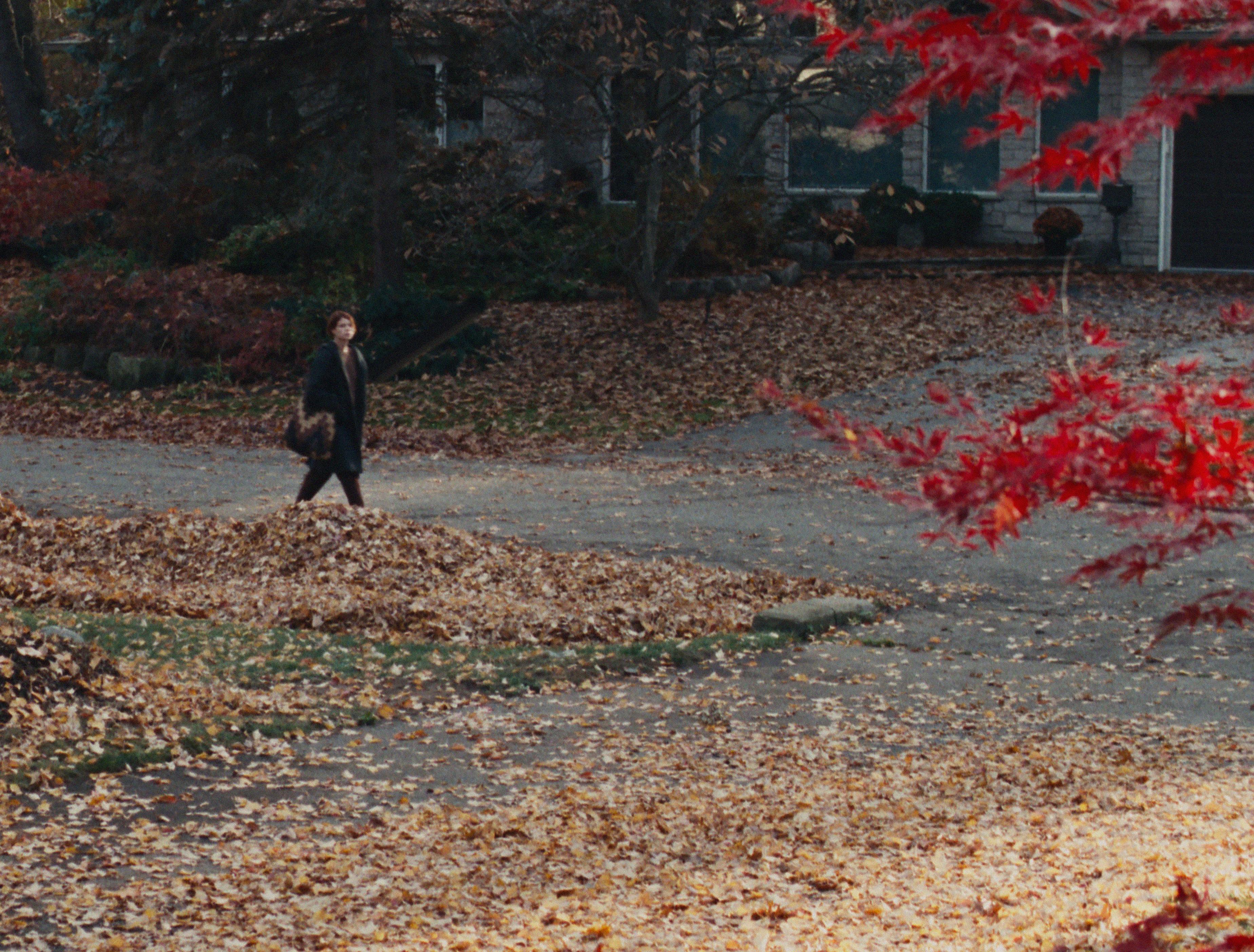
The film, streaming now on Apple TV+, follows Anna, an unemployed school teacher who starts working as an intern at The Love Institute, where a special test, involving the yanking of a fingernail, will reveal whether the love between two people in a couple is truly real.
Anna initially keeps her new job a secret from her boyfriend Ryan, with whom she has previously passed the test with success. However, as she shadows Amir, a fellow instructor, Anna develops a rapport with him that could be more than just professional, and there’s only going to be one way to work out who-loves-who in this love triangle.
The film stars Jessie Buckley, Riz Ahmed and Jeremy Allen White. It premiered at the 2023 Telluride Film Festival, and was released in limited theatres prior to streaming on Apple TV+. Principal photography on 35mm film commenced at locations around Toronto and Hamilton, Ontario in late October 2022 and wrapped some 30 shooting days later in December.
“Christos and I hit it off together on our very first call,” says Rév, who shot his previous features Jupiter’s Moon (2017), The Story Of My Wife (2021) and Malcolm & Marie 2021) all on 35mm film.
“We both shared the same sensibilities as to how this production should look and the key elements to make it work aesthetically. Science fiction gives you the visual opportunity to do something that’s out-ofthe-ordinary. But, as this was a film with an absurd premise, we didn’t want to go with anything unusual and weird. Quite the opposite, we wanted to heighten the strangeness of the story by creating a world where things felt grounded and real.
“So it was really about reducing and simplifying the style, along the lines of a romantic movie, by using a simple camera package, simple framing and simple lighting. I was glad that the decision to shoot on 35mm film had already been made before I got hired,

because when you want to depict the real world then film is the real deal, it’s just better.”
Rév says he and Nikou considered a range of photographic stills and feature films to help them rule-in and rule-out appropriate looks for the film, adding that, “It would be impossible to make a move like this without considering the sci-fi treatment of Eternal Sunshine Of The Spotless Mind (2004 dir. Michel Gondry, DP Ellen Kuras ASC), but it would be misleading to think our production bears a distinct visual resemblance to that film.”

Keeping the camera package straightforward, DP Rév went with a classical set-up for the film – an ARRICAM LT, shooting 3-perf 35mm film, using compact Zeiss T1.3 Super Speed spherical lenses. While Rév framed in 1.85:1, the film was later reformatted slightly to 2:1. The camera and lens package was supplied by ARRI Rental in Toronto.
Just as he had with Jupiter’s Moon and The Story

Of My Wife, Rév opted to shoot Fingernails entirely on KODAK VISION3 500T 5219 35mm film.
He explains, “I wanted to maintain a consistency of grain and texture by just having one filmstock, and I absolutely love the 500T because you can use it for everything – from the brightest sunshine to the darkest scenarios. A lot of the action in Fingernails takes place in low-lit interiors or at night, and I knew the 500T would help with the exposure. I prefer to shoot the 500T uncorrected in daylight situations, without a filter on the lens, and to do the correction later in the DI grade, as it gives the faces and skin tones something special.
“Along with its versatility and image quality, one of the other great things about the 500T is how you can use it with different combinations of under/over exposure in-camera and pull/push processes at the lab to create so many different looks – all from one stock. That’s truly amazing.
“On this production I under-exposed the 500T by half a stop on-set, and push-processed at the lab by a stop, to give the image a little more grit and life through an added level of granular texture that is fundamental to the look. Doing this also provided more detail in the dark areas of the image that helped create a softer, more-velvety black with the help of the colourist.”
Film processing and scanning was done at FotoKem in Los Angeles. The final grade was done by Tom Poole at Company3.
FINGERNAILS•MARCELL RÉV HCA ASC
74 MARCH/APRIL 2024 CINEMATOGRAPHY WORLD
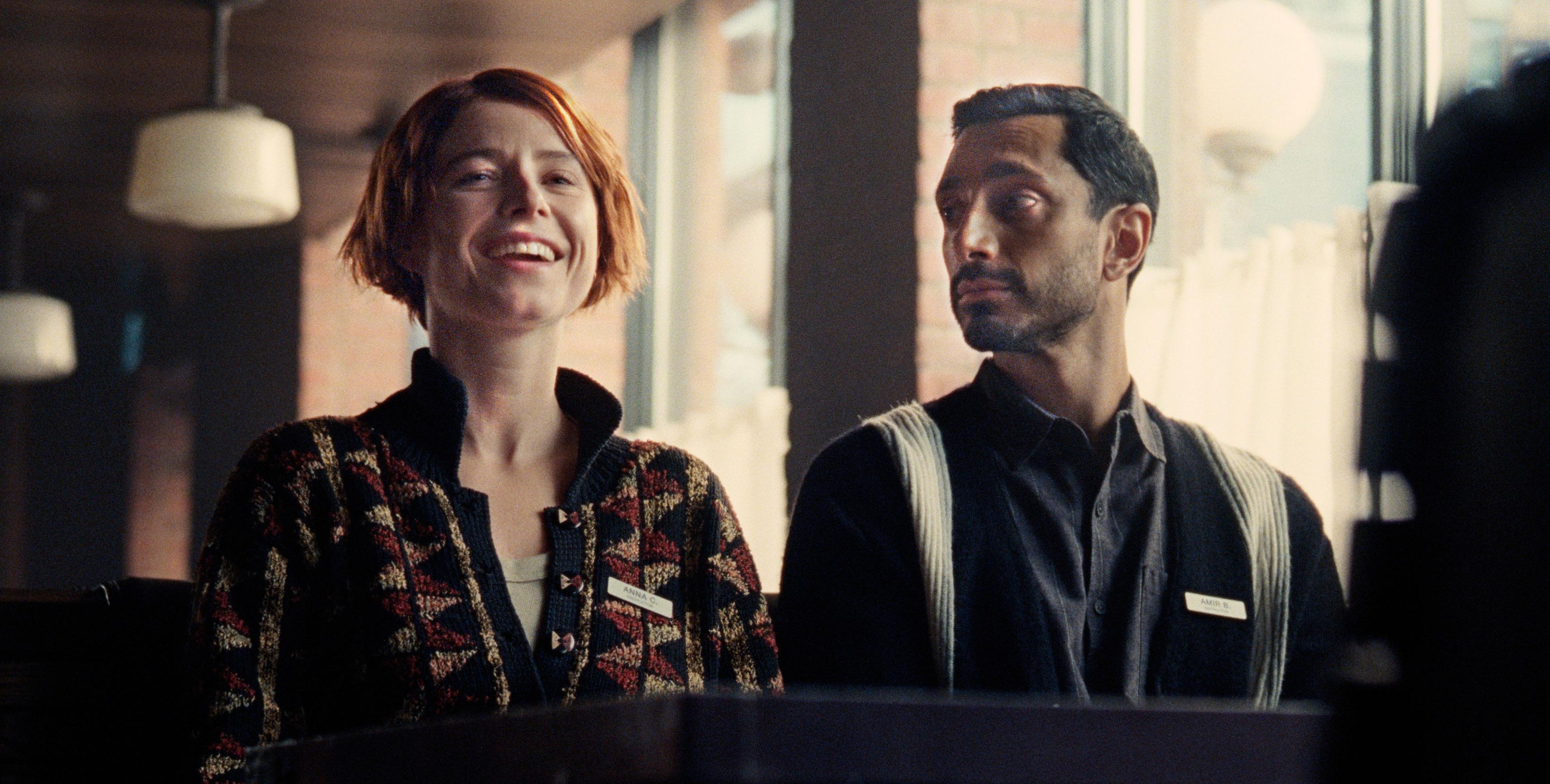
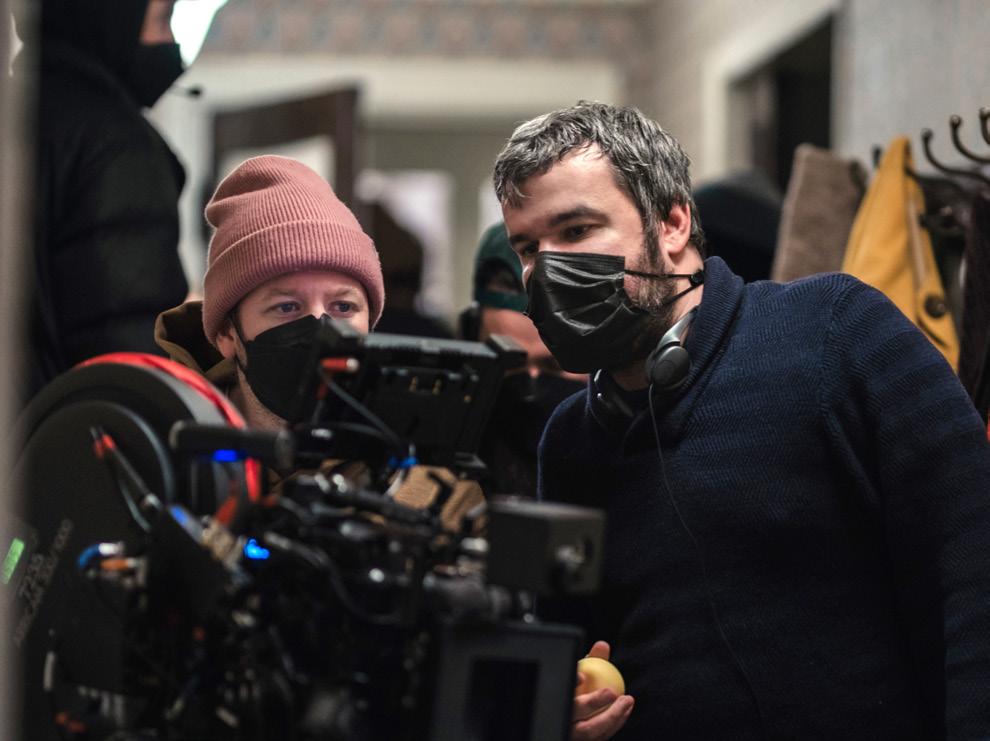

Rév operated the camera during production, assisted by Barrett Axford a 1st AC.
“In keeping with the plan for things to be real and grounded, we kept the mise-en-scène simple, often relating a scene in two or three shots, with the camera on the dolly or sticks, performing simple pans between characters,” Rév remarks. “We went handheld for some moments when things get emotionally-charged, but it was always with a soft and subtle style, to subliminally support an expression or some other aspect of the physical performance.”
Working with gaffer Scott Phillips and key grip Robert ‘RJ’ Johnson, Rév kept the lighting naturalistic using Tungstens and HMIs for most set-ups, only resorting to LEDs for some of the tighter shooting situations.
“I love using the full-colour spectrum of Tungstens, HMIs and natural sunlight with film, as I find it more


truthful and compelling on people’s faces. Sometimes I used modern LED technology to get light into places when we couldn’t fit in a big Tungsten unit. The lighting style was more about nuances, about depicting the emotion on the faces of Jessie, Riz and Jeremy, the people in our love triangle, and emphasising their performances.”
Rév’s biggest challenge on the production? “I think the biggest challenge for me was reducing things, keeping things really simple at all times to maintain the extraordinary premise of the film. Visually, my previous projects have been very expressive, expressionistic, out-
When you want to depict the real world… film is the real deal
there. This one was the opposite. I had to dig deep into tiny details – lighting a close-up to elicit the emotion, subtle framing with the camera, and depicting a scene in a few easy shots. It was a totally different kind of
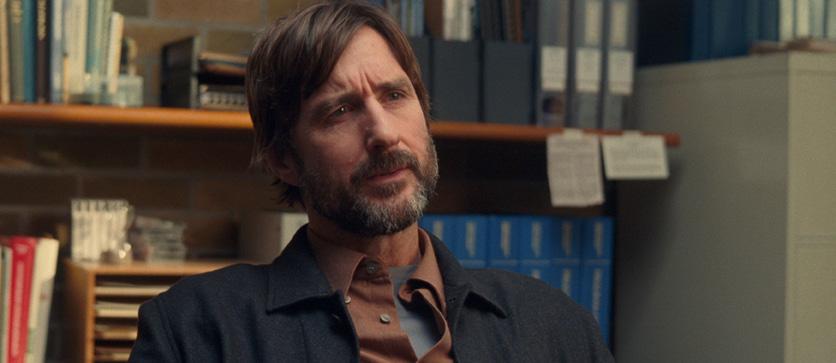

storytelling and I really enjoyed that.
“I didn’t enjoy the bitter cold in Toronto. But the amazing warmth and enthusiasm of Christos, my crew and the actors, were a blessing. Although I’m familiar with, and open to, shooting on any formats, it was a great pleasure to shoot Fingernails on film. It has a special magic that is not easily replicated in digital, and gives an aesthetic quality that adds value to the project from the start. It’s closer to the reality of what is in front of the camera and, best of all, it is closer to your imagination.”
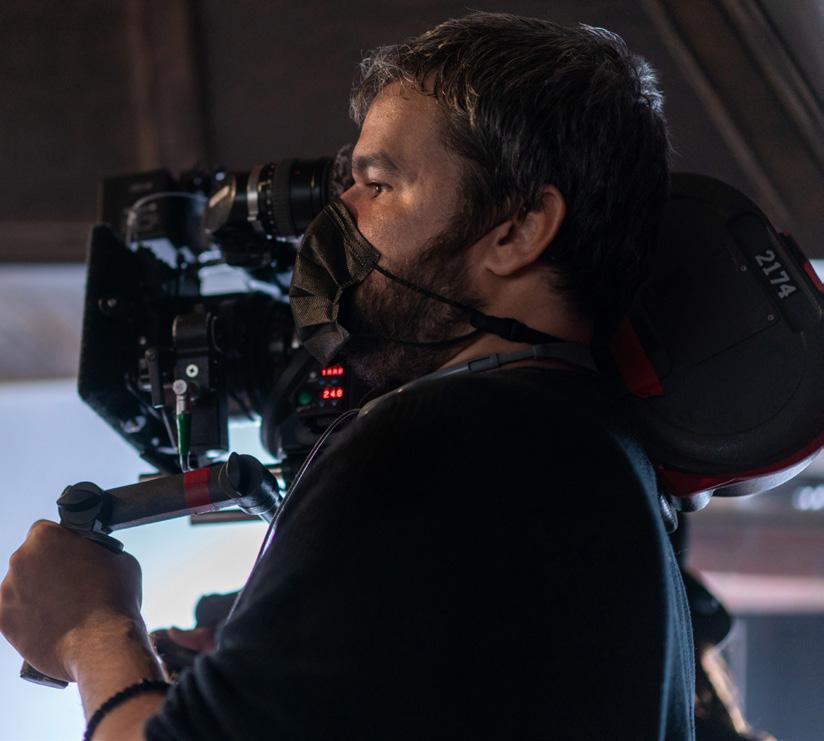
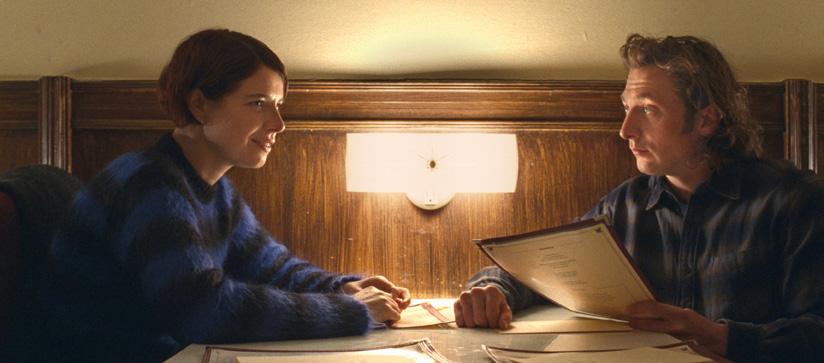
Images: all images courtesy of Apple
CINEMATOGRAPHY WORLD MARCH/APRIL 2024 75
MARCELL RÉV HCA ASC•FINGERNAILS
SHINING A LIGHT ON...
Selected Filmography (so far) as gaffer (unless otherwise stated):
Just Passing (short) (2023)
Gorka (short) (2023)
Footprints On Water (2023)
Up On The Roof (lighting technician) (2022)
Peeler (short) (2022)
Mars (short) (2022)
Mammals (lighting technician) (2022)
Kill Them With Kindness (short) (2022)
Heartstopper (dailies electrician) (2022)
How To Be A Person (TV mini-series) (2022)
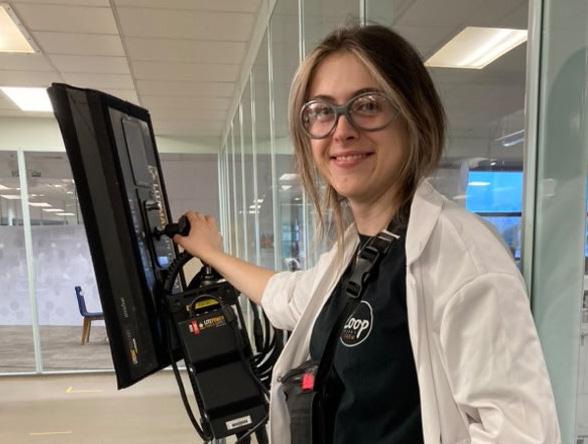

ELENA ARMELLINI ASSOCIATE ICLS By David
Wood

Why does lighting interest you?
Light is relevant in most of the art forms where I have some experience. In paintings, photography and filmmaking, it’s always the lighting that serves multiple purposes.

At a very basic level light gives you vision, in that it allows you to see a subject. But light can then be shaped to give the subject meaning, to illuminate the metaphysical and the abstract, allowing you to focus on something and understand it more deeply.
As an artist, light becomes a tool. Light can be hard, it can be soft. It can be diffused or reflected. Light is a language that we can all relate to because of our experience of the world and the cultures we were raised in.
I love that light can be ambiguous, and how you can use it to say something, or leave something unsaid or unseen. It can leave a subject in the shadow or provide revelation. And… light is colour and colour is meaning. Colour means something intrinsic to a culture.
When did you realise you wanted to become a gaffer?
I realised I had to be a gaffer when I was studying at ESRA in Nice, and saw what the gaffer does on-set. I found myself naturally going into the kit room and just setting-up lighting. Instinctively I was more confident
Age// Born// Lives// Education// Passions hobbies// 32 Cuneo, Italy
Hastings, East Sussex, UK
ESRA – École Supérieure De Réalisation Audiovisuelle, Nice Masterclass at Centro Sperimentale Di Cinematografia, Rome City & Guilds BS7909 & 2365 Level 2 Electrical, London
Running, preferably with my dog or at the gym, photography, drawing or painting, especially caricatures, crochet, watching films and TV psychology, neuroscience & evolutionary psychology – subjects I studied before deciding to become a filmmaker
and just drawn to that. After that I worked in the lighting department on my fellow students’ films.
Big break?
I don’t think I have had my big break just yet. But in terms of my career so far, I would say the great helping hand I’ve had was from my friend, DP Natalja Safronova, who trusted me to lead the lighting team on E4/BBC’s BAFTA-winning How To Be A Person. It was just amazing, and showed me that I’m on the right path.
Best advice?
I was talking to gaffer Julian White ICLS at Camerimage 2023 in Poland. We were discussing life and work. He talked about how important it is to cultivate passions and hobbies outside work. That really resonated with me, because working on-set and in film, we do a job that is already our passion, but it asks a lot from us – incredibly long hours on-set, days and weeks away from home.
We love what we do, we care and we give ourselves to a project. I think it’s true and great advice from Julian, because you need to keep feeding your mind with the things you enjoy doing that aren’t work, because those things can then randomly spark your inspiration and reignite joy in your work.
What are your inspirations?
How long do you have? The Cabinet Of Dr Caligari (1920, dir. Robert Wiene, DP Willy Hameister) is a touchpoint of mine. I discovered it whilst at university and it made me first realise the importance and impact of lighting and set design. I’m a huge fan of German expressionism. As a movement it pioneered a language of light that translated emotions into film through lighting and set design.
DPs like Henri Alekan, and his work on La Belle Et La Bête /Beauty And The Beast (1946, dirs. Jean Cocteau/René Clément) in particular, are where you
see the manifestation of what I think genius is in our industry – special effects crafted in the lens through the cunning mastery of light.
Favourite examples of lighting in films?
Chinatown (1974, dir. Roman Polanski, DP John A Alonzo ASC) is an incredible example of the emergence of neo-noir, something totally new back when it was first released. Lady From Shanghai (1947, dir. Orson Welles, DPs Charles Lawton Jr/Rudolph Maté/Joseph Walker) used chiaroscuro to create the feeling of dread and fear.
Learn how to transmit calmness on-set… and be kind
In The Neon Demon (2016, dir. Nicolas Winding Refn, DP Natasha Braier ADF ASC) colour is used to tell the story beat by beat. If the scene is toxic, the light elevates that to a whole new level. Seeing this film at the Cannes Film Festival in the Grand Auditorium Louis Lumière added to my experience.
On the one hand, using practical lights to create the psychedelic maelstrom in Enter The Void (2009, dir. Gaspar Noé, DP Benoît Debie SBC) was perfect, but it was actually an incredible technical achievement. To Catch A Thief (1955, dir. Alfred Hitchcock, DP Robert Burks ASC) has colour at the forefront and is deeply referential to German expressionism.
Who are your lighting role models?
76 MARCH/APRIL 2024 CINEMATOGRAPHY WORLD GAFFERS CAFÉ•ELENA ARMELLINI ASSOCIATE ICLS
Photo by Mohammed Ragahmed
Photo by Atikah Zainidi
Photo by Stanislaw Proszowski
Photo by Inès Hachou

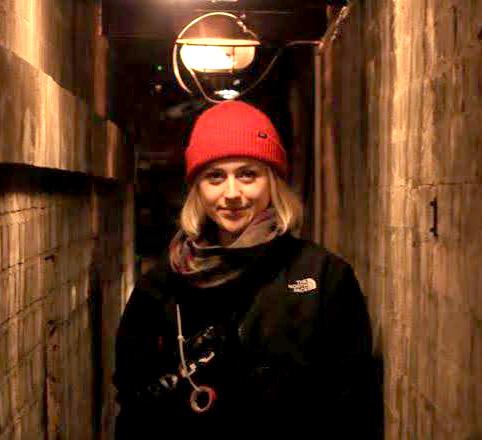

Role models are, for me, all about seeing how other people do what you do, and realising they are just amazing. John Higgins (Biggles)
ICLS is so kind when you work with him, and just being kind is something to emulate.
Martin Smith ICLS is a very kind person too, who knows how to facilitate working well on-set and always makes it fun to be around. Alongside those qualities, they are artists, crafty and creative, something I hope to be.
Best job so far?
On a technical level, it was working recently on a commercial for Wise, where every scene was meant to reflect being in a totally different country – ten scenes, ranging from a carnival in Rio, to a Hong Kong café, to a Moroccan restaurant – although they were all actually shot in a farmhouse in Tunbridge Wells over a stormy weekend.
On an emotional level, it was working on a commercial for a lighting brand with Biggles and DP Rodney Charters CSC ASC. They say never meet your heroes, but these guys just confirmed why they are heroes. Technical skills aside, they’re heroes because they are people who embody good communication skills and fantastic on-set vibes.
Why did you join the ICLS and how does it help you?
As
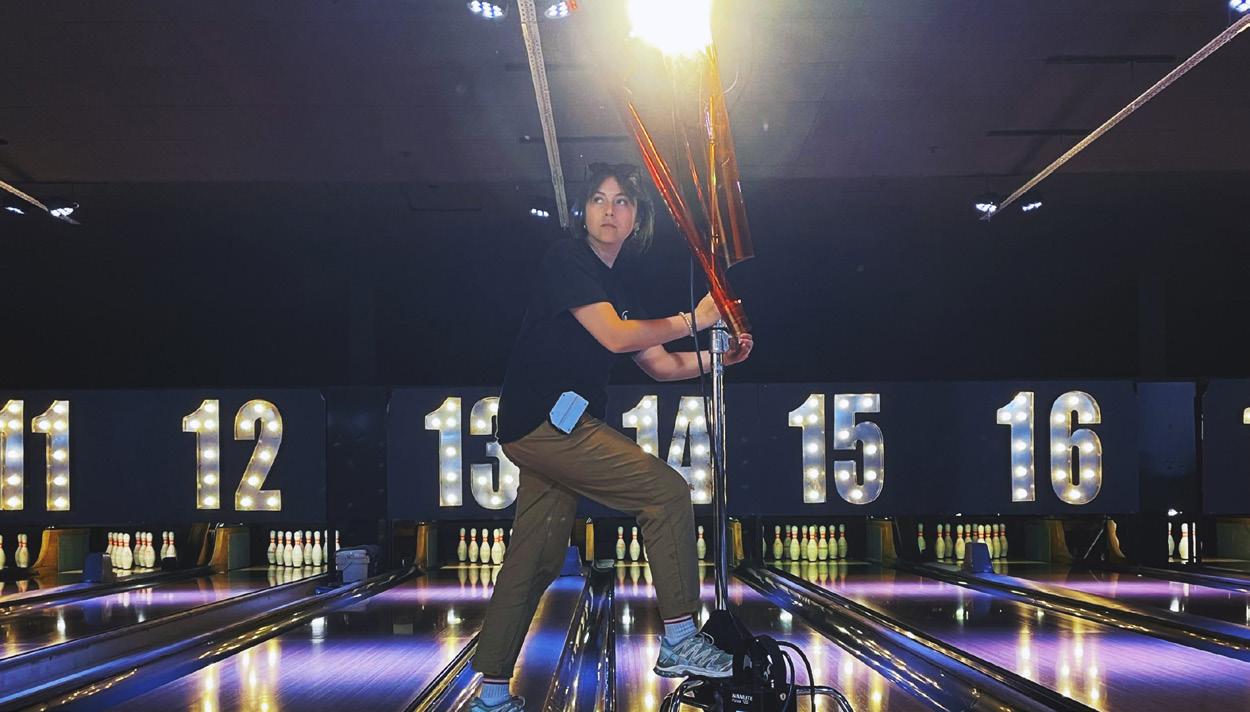
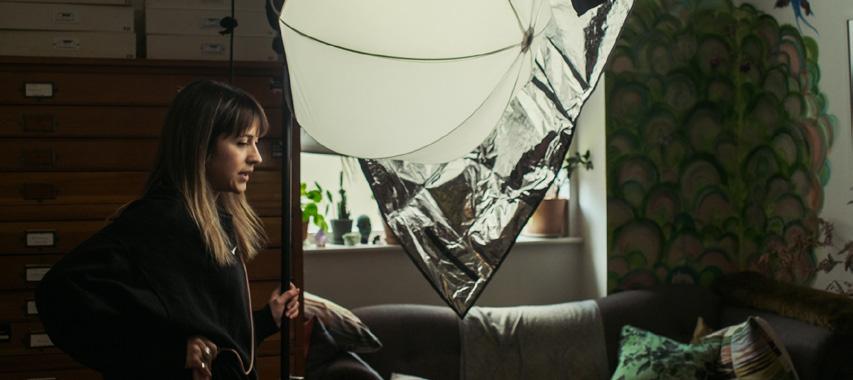
The ICLS (International Cinema Lighting Society) is filled with like-minded colleagues who have so much experience and insight, and they share that readily with others. Being part of a community like that is amazing.
For example, I had an upcoming project where I had to deal with sodium vapour street lights. When I opened-up the ICLS Discord channel and asked the question, within a few hours I had three different approaches to solve this problem based on others’ experiences.
How do you keep up with technology?
I go to trade shows like the BSC Expo, the ICLS obviously, plus my relationships with lighting manufacturers and rental companies. It may be old school, but I love reading magazines too.
Light is a language we can all relate to
Favourite piece of equipment?
That’s like asking a parent who their favourite child is! I love lights that come with a projection lens, because you can precisely shape it for an effect. Shake a tree branch in front of it, put a nicely de-focussed gobo on it,
reflect it on a mirror – it’s a highly versatile piece of kit to have in your van.
What does 2024 hold for you?
I’m about to do a big project with a lot of travel so I’m gearing up for that which is fun and exciting. 2024 is still a bit of a question mark for lots of us though. Unions have done great work in the last couple of years and, whilst none of us has a crystal ball, I feel really positive about the impact of that work, and how it will help our industry to grow in a time of change.
Advice for anyone else wanting to be a gaffer?
Learn how to transmit calmness on-set, even when you’re dealing with many challenges and difficult tasks. Don’t hold your ideas or suggestions back – talk to your DP and give them options they might not have had the time to consider. But above all, be kind, always.



CINEMATOGRAPHY WORLD MARCH/APRIL 2024 77
ASSOCIATE ICLS•GAFFERS CAFÉ STUDIO LOCATION FEATURES COMMERCIALS DRAMA TELEVISION EQUIPMENT GENERATORS TRANSPORT SUPPORT INNOVATION SAFETY SUSTAINABILITY
ELENA ARMELLINI
one of the industry’s premier rental resources, we are extremely proud to support crews around the world with an unrivalled collection of production solutions which embrace both the conventional and the very latest in advanced lighting technology.
your production type, wherever you are, when it comes to lighting - we’ve got the lot. MBS Equipment Company Lakeside Road, Colnbrook, Slough, Berkshire SL3 0EL +44 (0) 1753 987 888 mbseco.uk PMBS generic quarter.indd 1 12/01/2022 11:18
Photo ©MBS me VizeVerza
Whatever
Photo by Sanjoli Malani
Photo by Natalja Safronova
Photo by Nik Trzcinowicz

Gaffer Kevin Gibb
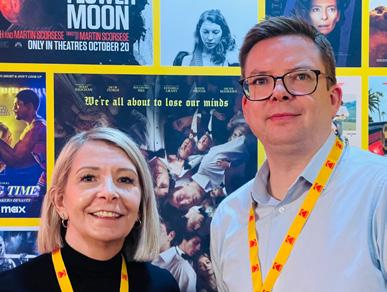
Julie Taylor-Butt and Sam Clark at Kodak
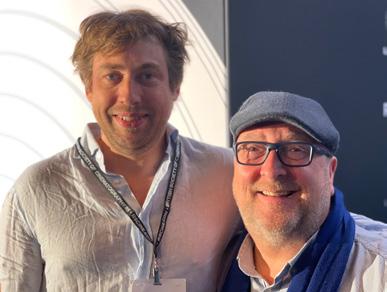
Tama Berkeljon from Creamsource and Nick Shapley of LCA

LCA Nick Shapley peeking behind a Rosco Lion LED Fresnel
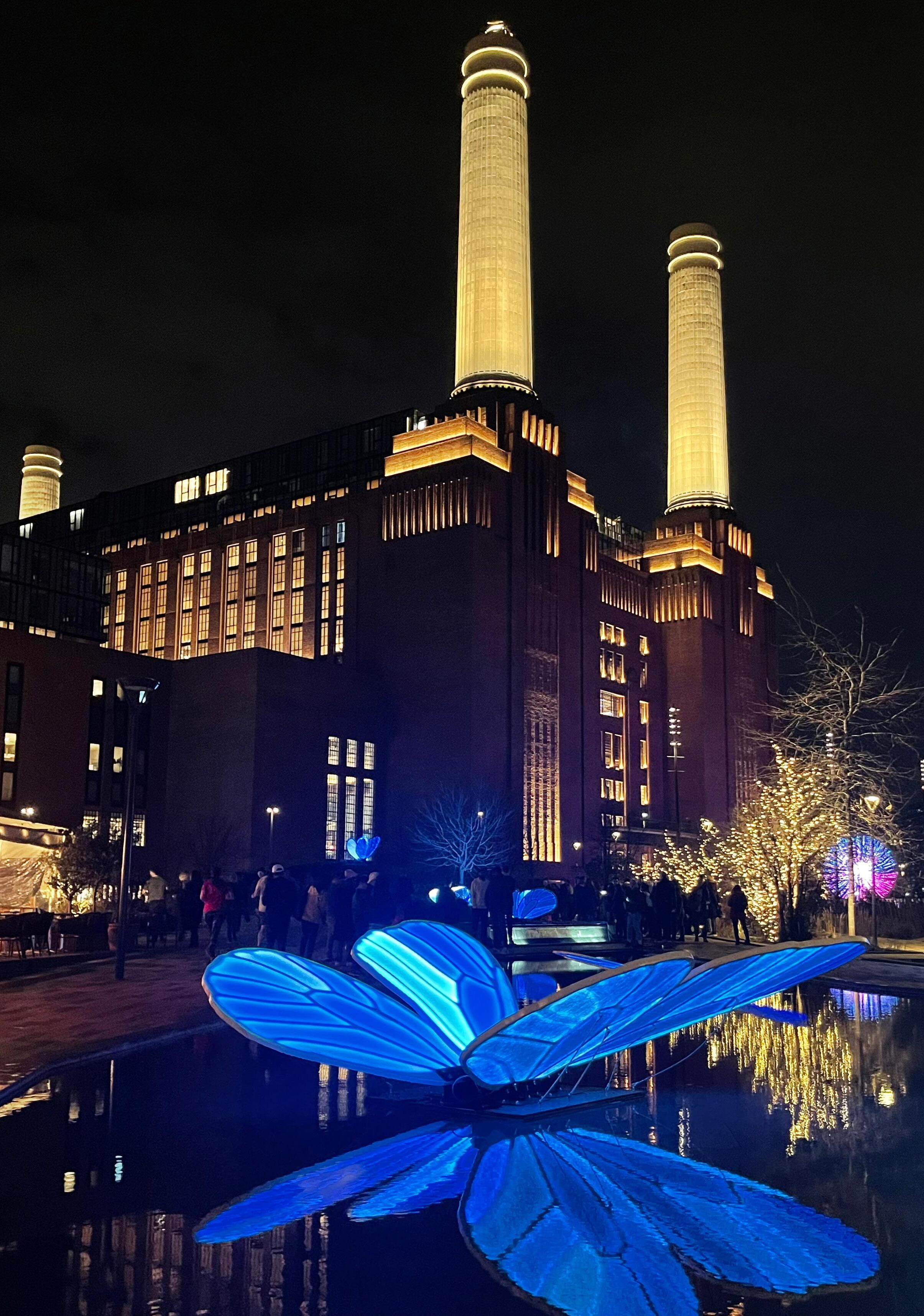
Andra Milsome, Lily Coney, Stephanie Chao and Catrin Lewis Defis at the Mark Milsome Foundation stand

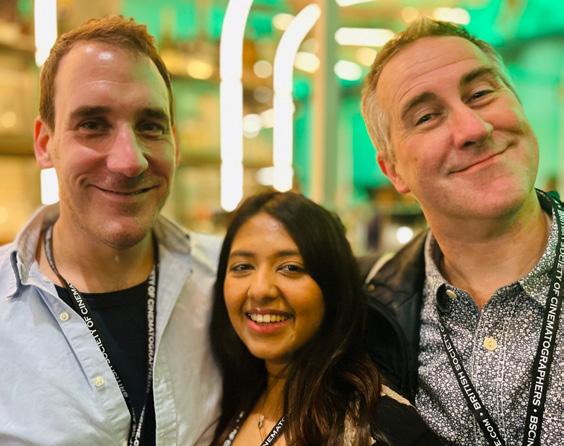
DP James Friend BSC ASC with mentee DP Nizah Elias and Cinematography World scribe Michael Burns

Micro Salon Madrid team – Juan A Fernandez AEC, Nuria Roldós AEC and Raquel Fernandez Nunez AEC, plus Ron Prince, editor-in-chief, Cinematography World
Cristian Arroyo of Rosco with Lion LED Fresnel
Dariusz Wyczółkowski marketing director at Camerimage



DP Birgit Bebe Dierken at Dolby’s HDR seminar about Sexy Beast
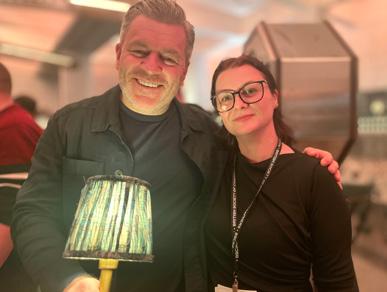
Gaffer Martin Smith ICLS and Ediola Pashollari ICLS executive director
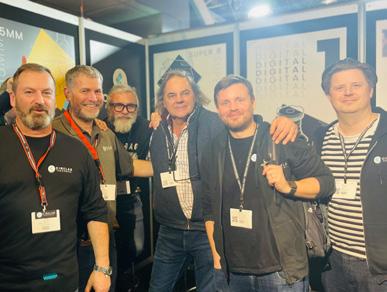
Cinelab team –Roger Harlow, Adrian Bull, Darren Rae, Steve Milne, Josh Callis-Smith and Thom Trigger
DP Harvey Harrison BSC and DP Nic Knowland BSC
DP Alex Linden FSF and DP Matti Eerikainen FSC at the show after IMAGO’s 2024 IAGA
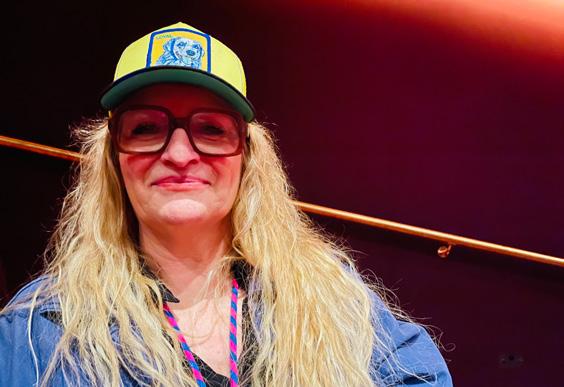

DP Veronica Keszthelyi sponsored by The Unit Bag, DP Alister Malcolm and DP Shreya Jha, recipients of the Aspiring Cinematography Fund

Gaffer Julian White
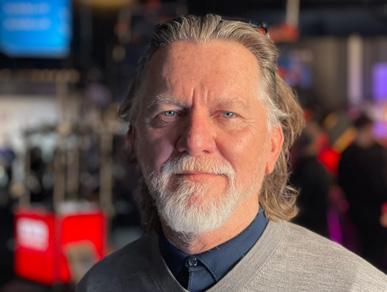
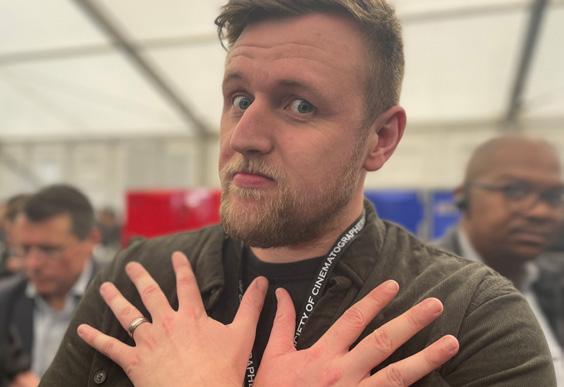
DP James Oldham
DP Keith Pendred and DP Eleanor Bowman


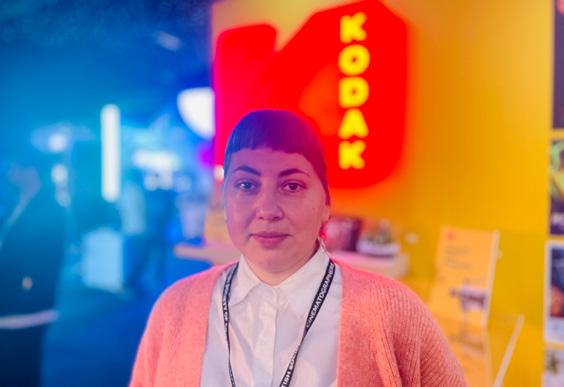
DP Peter Hannan BSC and Frances Russell
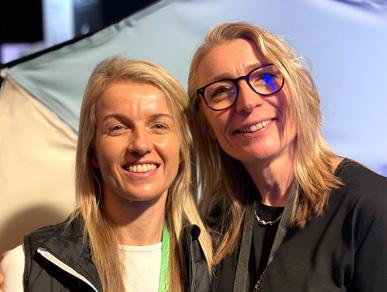
Jenny Clark marketing director at Sunbelt Rentals with Vicci Clayton marketing/events manager at LC
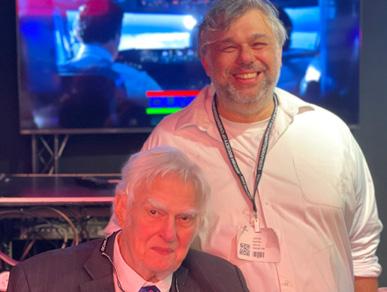
Joe Dunton BSC and Lester Dunton

Judit Romwalter from Sparks in Hungary
DP Simona Susnea
and
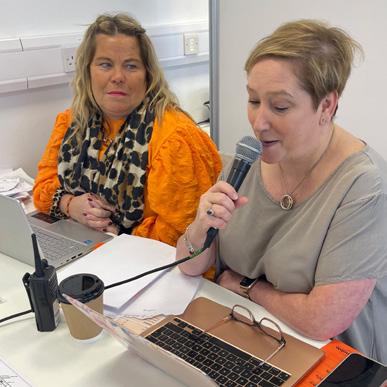

Gaffer Elena Armellini ICLS Associate, Claire Saunders and Ediola Pashollari ICLS executive director
SHOOTING GALLERY•BSC EXPO 2024 78 MARCH/APRIL 2024 CINEMATOGRAPHY WORLD
C M Y CM MY CY CMY K
Shelly
Claire in the office



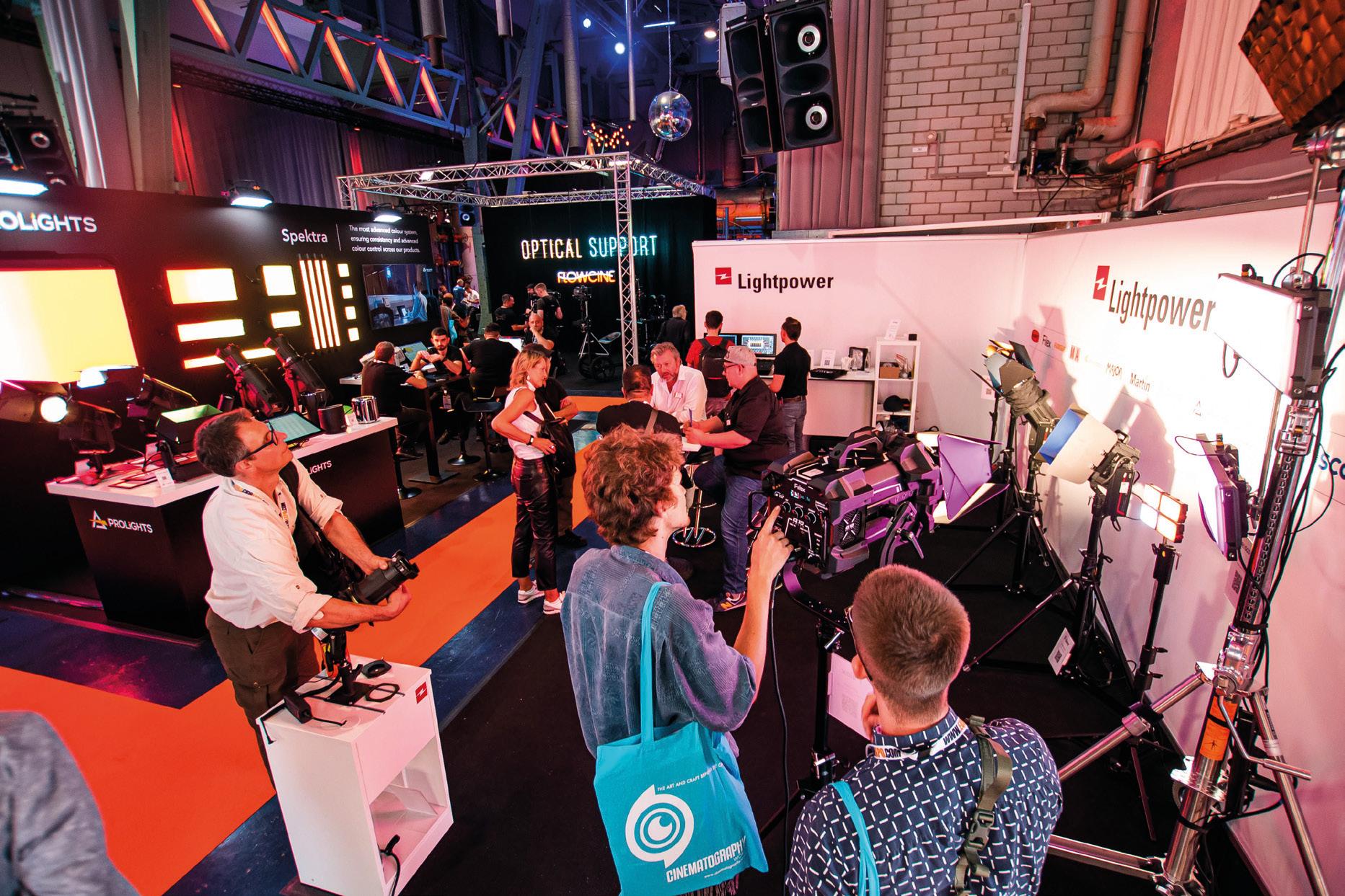
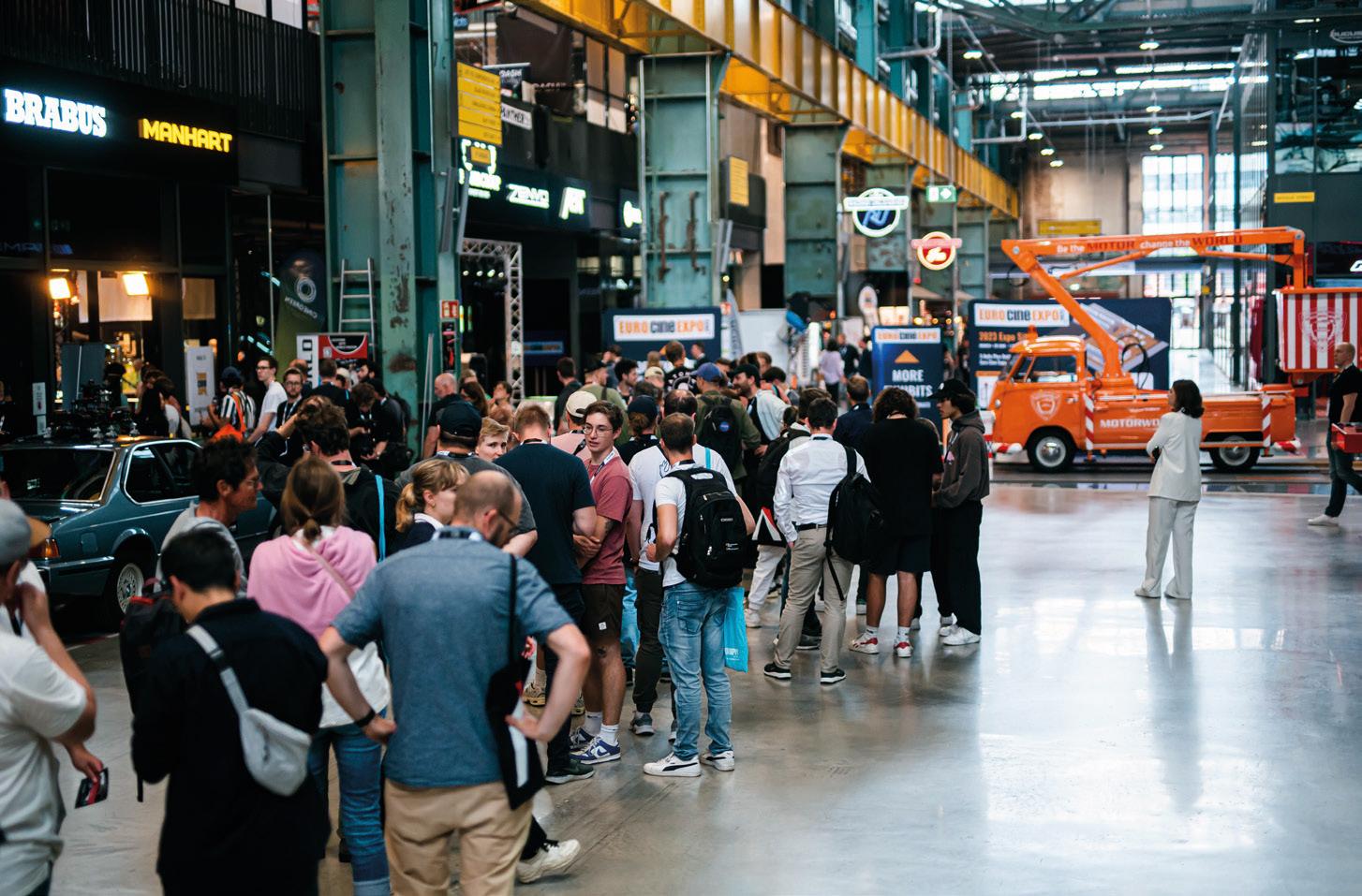
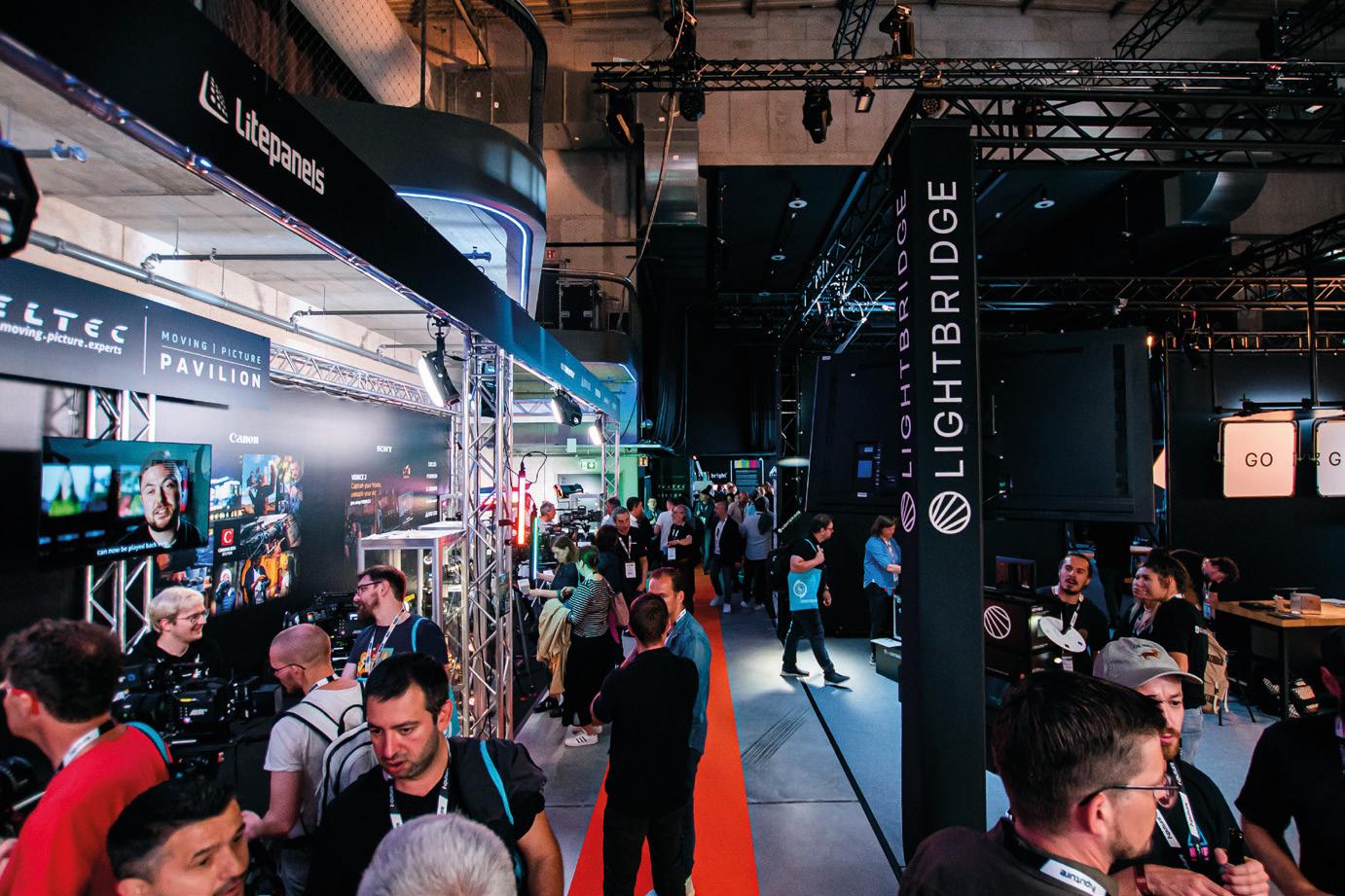



+44 1428 609 382 info@eurocineexpo.com 2024 EUROCINEEXPO.COM THE MUST ATTEND EVENT IN 2024! MAINLAND EUROPE'S LARGEST AND MOST EXCITING EVENT FOR THE FILM & TV PRODUCTION INDUSTRY 27-29 JUNE 2024 EXPO AND SYMPOSIUM Expo and Symposium FREE to attend...Register Now...Expo and Symposium FREE to attend...Register Now...Expo and REGISTER TODAY - ENTRY IS FREE









































































































































 Photos: Warwick Thornton ACS sporting a straw kat.
All photos © Ben King.
Photos: Warwick Thornton ACS sporting a straw kat.
All photos © Ben King.





































































































































































































































































